
Annual Report 2023 1 ANNUAL REPORT 2023

Annual Report 2023 2 Every day at Comtech, we are building connections that set ideas free Terrestrial and satellite communications have long existed as independent domains, with distinct products, capabilities, and infrastructures We envision a future beyond those boundaries – a future of hybridized connectivity

Annual Report 2023 3 $93.5 $77.8 $76.5 $39.3 $53.5 2019 2020 2021 2022 2023 Adjusted EBITDA* $724.1 $584.4 $623.1 $445.5 $594.1 2019 2020 2021 2022 2023 Bookings $683.0 $620.9 $658.9 $618.1 $662.2 2019 2020 2021 2022 2023 Backlog $671.8 $616.7 $581.7 $486.2 $550.0 2019 2020 2021 2022 2023 Net Sales FISCAL 2023 SELECTED FINANCIAL DATA $ in millions $ in millions Comtech’s fiscal year end is July 31 *For a definition and explanation of how “Adjusted EBITDA” (a Non-GAAP financial measure) is calculated as disclosed above, see page 63 of our Fiscal 2023 Annual Report on Form 10-K

Annual Report 2023 4 FOREWORD Ken Peterman, Chairman, President & CEO Fellow Shareholders, For everyone at Comtech, and certainly for me personally, the close of fiscal year 2023 represents a profound inflection point. When I first took on the role as the company’s CEO roughly a year ago, I made a commitment to our investors: to act with a deep sense of urgency and purpose to make certain that even as Comtech transforms to better align with our growth markets (becoming a forward-looking, agile, and invaluable solutions partner), we would remain focused on the crucial work of improving our operations, balance sheet, and financial performance every day. As I take stock of where we are one year into our transformation, I’m greatly encouraged. The hard work of continuous, daily performance improvement has meant not only expanding margins, but also a path forward to address strategic questions about the composition of our business and the strength of our balance sheet. Importantly, following a careful review of our current business and product lines and considering the kind of software-defined and solutions-based enterprise our customers need us to be in the future, we identified opportunities to rebalance our segments and ultimately chose to divest our solid state power amplifier product line. Upon completing this transaction, in the short term, we used a meaningful portion of the net proceeds from this divestiture to reduce our outstanding debt, leverage ratio and interest payments. We are also simultaneously addressing the need to refinance our Credit Facility, which expires in October 2024. This process is moving forward and we believe we’re headed toward a solution. We have engaged in productive discussions with various potential sources of capital, including our existing preferred shareholders, regarding alternative investment structures. While subject to existing lender approval, we are also pursuing a potential short-term amendment and extension of our Credit Facility, if needed in the interim while we move toward completion of a longer-term solution. ____________________ Overall, I am pleased with the significant progress being made with respect to strengthening our balance sheet. Such efforts, combined with optimizing our cost structure and improving business operations, provide a solid foundation as we look ahead to our ongoing transformation in fiscal 2024.
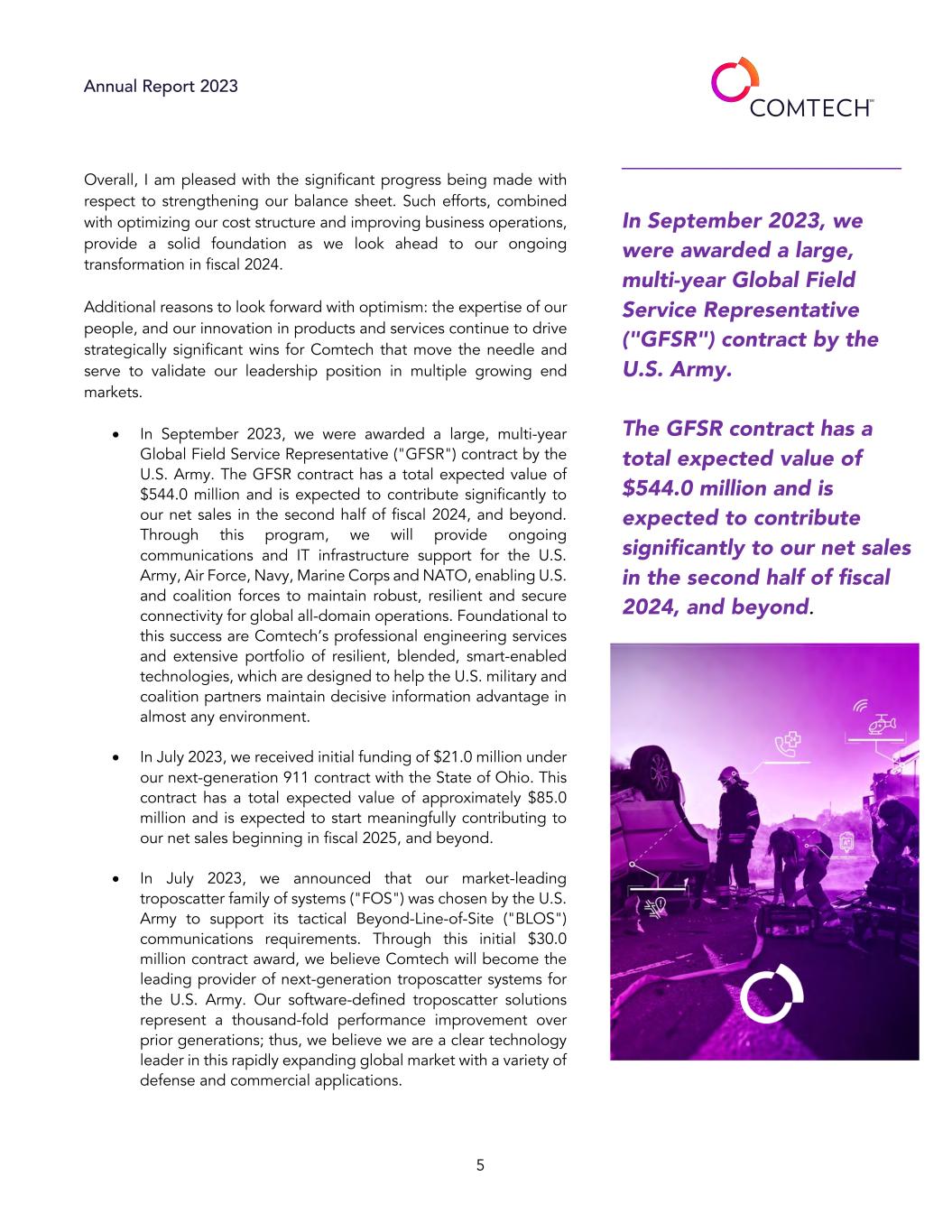
Annual Report 2023 5 Overall, I am pleased with the significant progress being made with respect to strengthening our balance sheet. Such efforts, combined with optimizing our cost structure and improving business operations, provide a solid foundation as we look ahead to our ongoing transformation in fiscal 2024. Additional reasons to look forward with optimism: the expertise of our people, and our innovation in products and services continue to drive strategically significant wins for Comtech that move the needle and serve to validate our leadership position in multiple growing end markets. • In September 2023, we were awarded a large, multi-year Global Field Service Representative ("GFSR") contract by the U.S. Army. The GFSR contract has a total expected value of $544.0 million and is expected to contribute significantly to our net sales in the second half of fiscal 2024, and beyond. Through this program, we will provide ongoing communications and IT infrastructure support for the U.S. Army, Air Force, Navy, Marine Corps and NATO, enabling U.S. and coalition forces to maintain robust, resilient and secure connectivity for global all-domain operations. Foundational to this success are Comtech’s professional engineering services and extensive portfolio of resilient, blended, smart-enabled technologies, which are designed to help the U.S. military and coalition partners maintain decisive information advantage in almost any environment. • In July 2023, we received initial funding of $21.0 million under our next-generation 911 contract with the State of Ohio. This contract has a total expected value of approximately $85.0 million and is expected to start meaningfully contributing to our net sales beginning in fiscal 2025, and beyond. • In July 2023, we announced that our market-leading troposcatter family of systems ("FOS") was chosen by the U.S. Army to support its tactical Beyond-Line-of-Site ("BLOS") communications requirements. Through this initial $30.0 million contract award, we believe Comtech will become the leading provider of next-generation troposcatter systems for the U.S. Army. Our software-defined troposcatter solutions represent a thousand-fold performance improvement over prior generations; thus, we believe we are a clear technology leader in this rapidly expanding global market with a variety of defense and commercial applications. ____________________ In September 2023, we were awarded a large, multi-year Global Field Service Representative ("GFSR") contract by the U.S. Army. The GFSR contract has a total expected value of $544.0 million and is expected to contribute significantly to our net sales in the second half of fiscal 2024, and beyond.
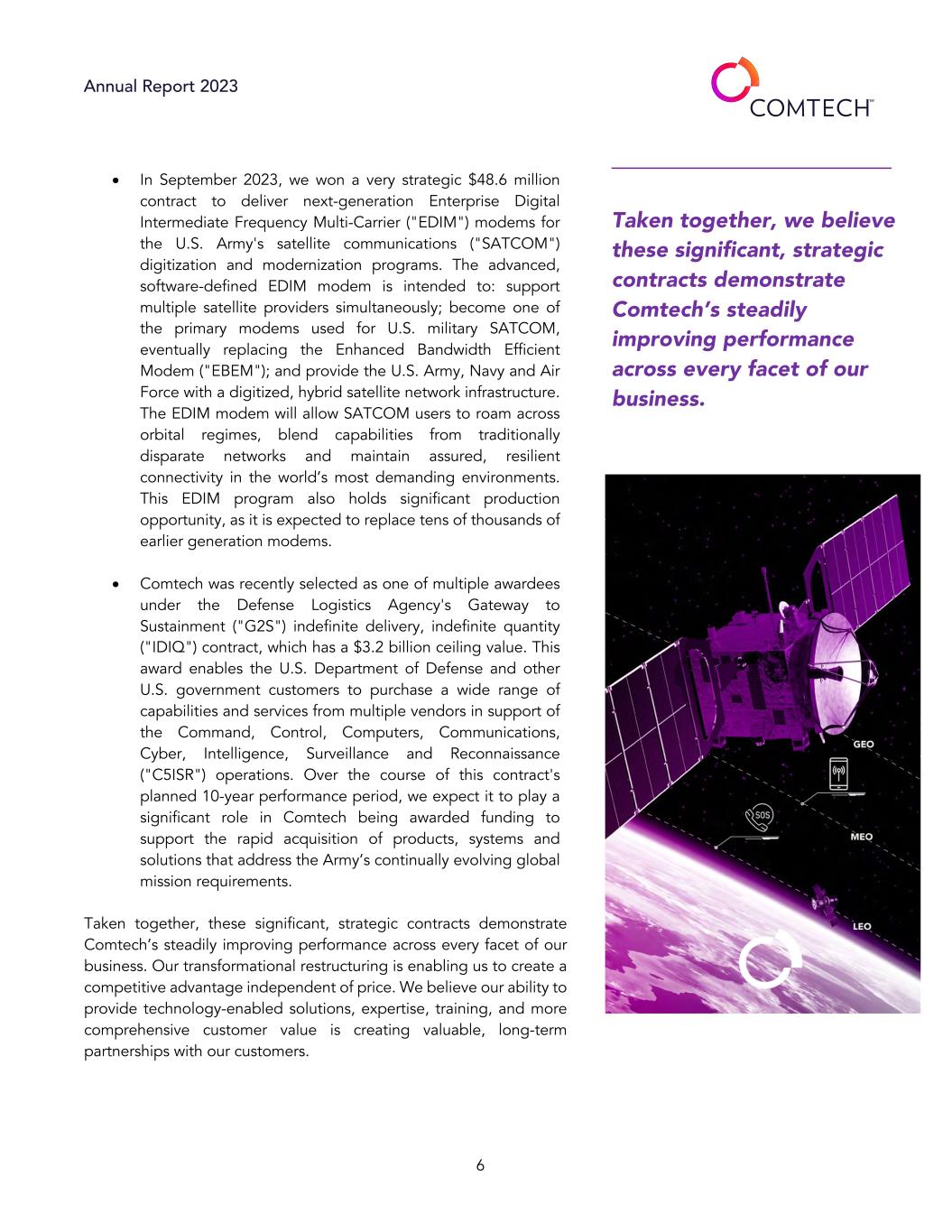
Annual Report 2023 6 • In September 2023, we won a very strategic $48.6 million contract to deliver next-generation Enterprise Digital Intermediate Frequency Multi-Carrier ("EDIM") modems for the U.S. Army's satellite communications ("SATCOM") digitization and modernization programs. The advanced, software-defined EDIM modem is intended to: support multiple satellite providers simultaneously; become one of the primary modems used for U.S. military SATCOM, eventually replacing the Enhanced Bandwidth Efficient Modem ("EBEM"); and provide the U.S. Army, Navy and Air Force with a digitized, hybrid satellite network infrastructure. The EDIM modem will allow SATCOM users to roam across orbital regimes, blend capabilities from traditionally disparate networks and maintain assured, resilient connectivity in the world’s most demanding environments. This EDIM program also holds significant production opportunity, as it is expected to replace tens of thousands of earlier generation modems. • Comtech was recently selected as one of multiple awardees under the Defense Logistics Agency's Gateway to Sustainment ("G2S") indefinite delivery, indefinite quantity ("IDIQ") contract, which has a $3.2 billion ceiling value. This award enables the U.S. Department of Defense and other U.S. government customers to purchase a wide range of capabilities and services from multiple vendors in support of the Command, Control, Computers, Communications, Cyber, Intelligence, Surveillance and Reconnaissance ("C5ISR") operations. Over the course of this contract's planned 10-year performance period, we expect it to play a significant role in Comtech being awarded funding to support the rapid acquisition of products, systems and solutions that address the Army’s continually evolving global mission requirements. Taken together, these significant, strategic contracts demonstrate Comtech’s steadily improving performance across every facet of our business. Our transformational restructuring is enabling us to create a competitive advantage independent of price. We believe our ability to provide technology-enabled solutions, expertise, training, and more comprehensive customer value is creating valuable, long-term partnerships with our customers. ____________________ Taken together, we believe these significant, strategic contracts demonstrate Comtech’s steadily improving performance across every facet of our business.

Annual Report 2023 7 Notably, the U.S. Army’s rigorous evaluation criteria frequently places exceptional demands on the people, equipment, and solutions that it deploys, and Comtech’s selection as a key partner to provide innovative, technology-enabled capabilities, equipment, systems, solutions, insights, and training represents a meaningful validation of our transformational initiatives and restructuring. * * * Stepping back, during our investor day in June 2023, I made the case that it wasn’t just some, or even many, things that were changing for our business. I argued that nearly everything has changed — and I meant it. Over the past fiscal year, we took a careful look at our siloed business units, the technology and platforms serving these units and our people. The work undertaken was to assess areas of our business that were no longer serving our needs. We improved those areas that provided us the springboard needed to pursue meaningful change across the company, and importantly, create the conditions necessary to grow both our top and bottom line. The result of this enormous effort has been consistently improving financial performance. As you can see from the results reported over the course of the year, we are reducing costs while sequentially improving revenues and Adjusted EBITDA margins. And while there is a lot of hard work left to do, especially through our fiscal year 2024, I am confident we are on the right track to deliver on our commitments. During our investor day, both Maria Hedden, our COO, and Mike Bondi, our CFO, detailed multiple initiatives that we are implementing to drive operational efficiencies in every aspect of our business operations. We identified additional opportunities ahead of us that would benefit our topline and help to drive sustainable margin improvement across our two segments. We believe that, over time, while sales will grow, our Adjusted EBITDA margins will grow faster. What does this mean for shareholders? Structurally, thanks to the work we’ve done over the past year, Comtech has undergone a series of changes that are beginning to manifest in long-term margin improvement. These encompass all aspects of our business from eliminating redundancies within the organization to installing global supply chain management and implementing additional KPIs that track our customer commitments. ____________________ During our investor day in June, I made the case that it wasn’t just some, or even many, things that were changing for our business. I argued that nearly everything has changed - and I meant it.
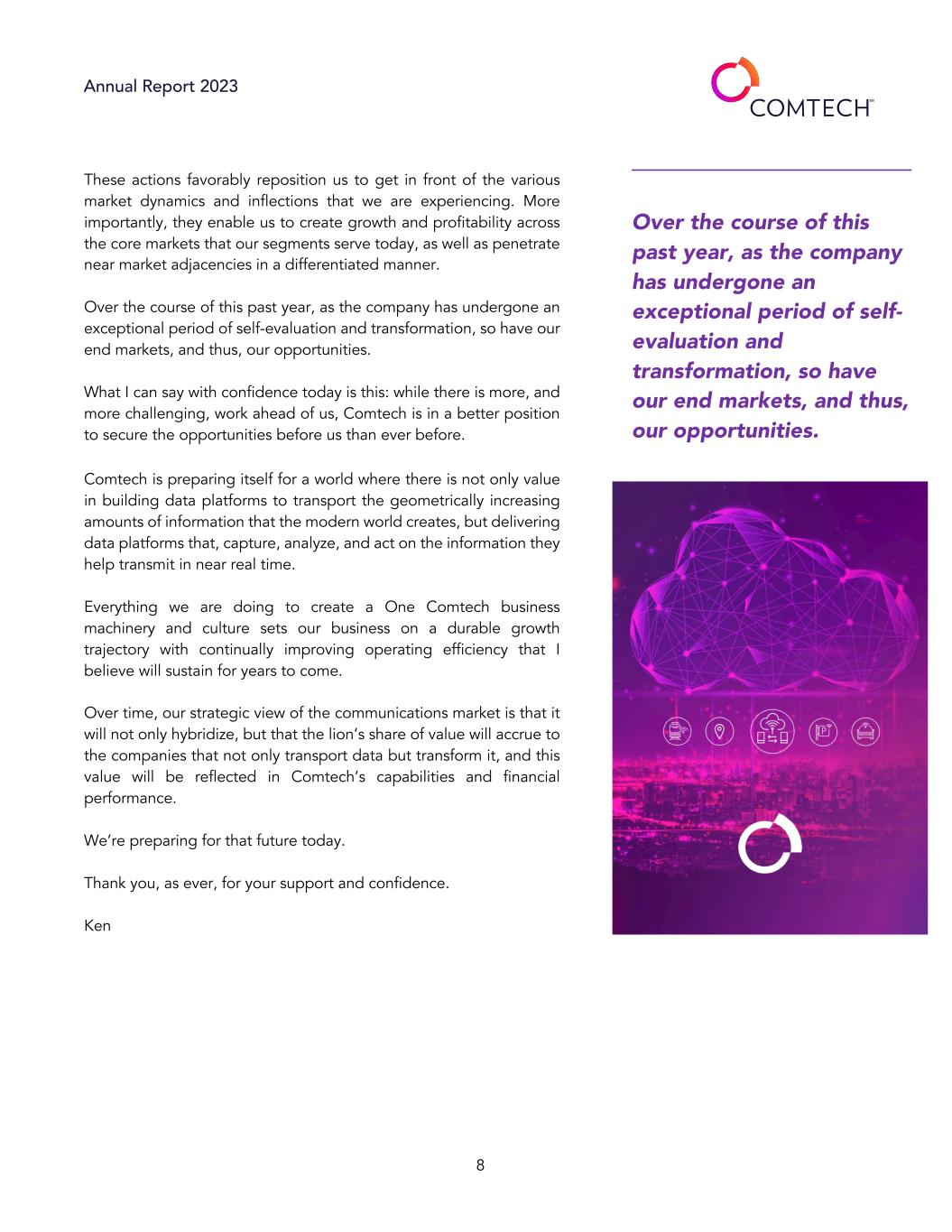
Annual Report 2023 8 These actions favorably reposition us to get in front of the various market dynamics and inflections that we are experiencing. More importantly, they enable us to create growth and profitability across the core markets that our segments serve today, as well as penetrate near market adjacencies in a differentiated manner. Over the course of this past year, as the company has undergone an exceptional period of self-evaluation and transformation, so have our end markets, and thus, our opportunities. What I can say with confidence today is this: while there is more, and more challenging, work ahead of us, Comtech is in a better position to secure the opportunities before us than ever before. Comtech is preparing itself for a world where there is not only value in building data platforms to transport the geometrically increasing amounts of information that the modern world creates, but delivering data platforms that, capture, analyze, and act on the information they help transmit in near real time. Everything we are doing to create a One Comtech business machinery and culture sets our business on a durable growth trajectory with continually improving operating efficiency that I believe will sustain for years to come. Over time, our strategic view of the communications market is that it will not only hybridize, but that the lion’s share of value will accrue to the companies that not only transport data but transform it, and this value will be reflected in Comtech’s capabilities and financial performance. We’re preparing for that future today. Thank you, as ever, for your support and confidence. Ken ____________________ Over the course of this past year, as the company has undergone an exceptional period of self- evaluation and transformation, so have our end markets, and thus, our opportunities.

Annual Report 2023 9 FISCAL 2023: Year in Review
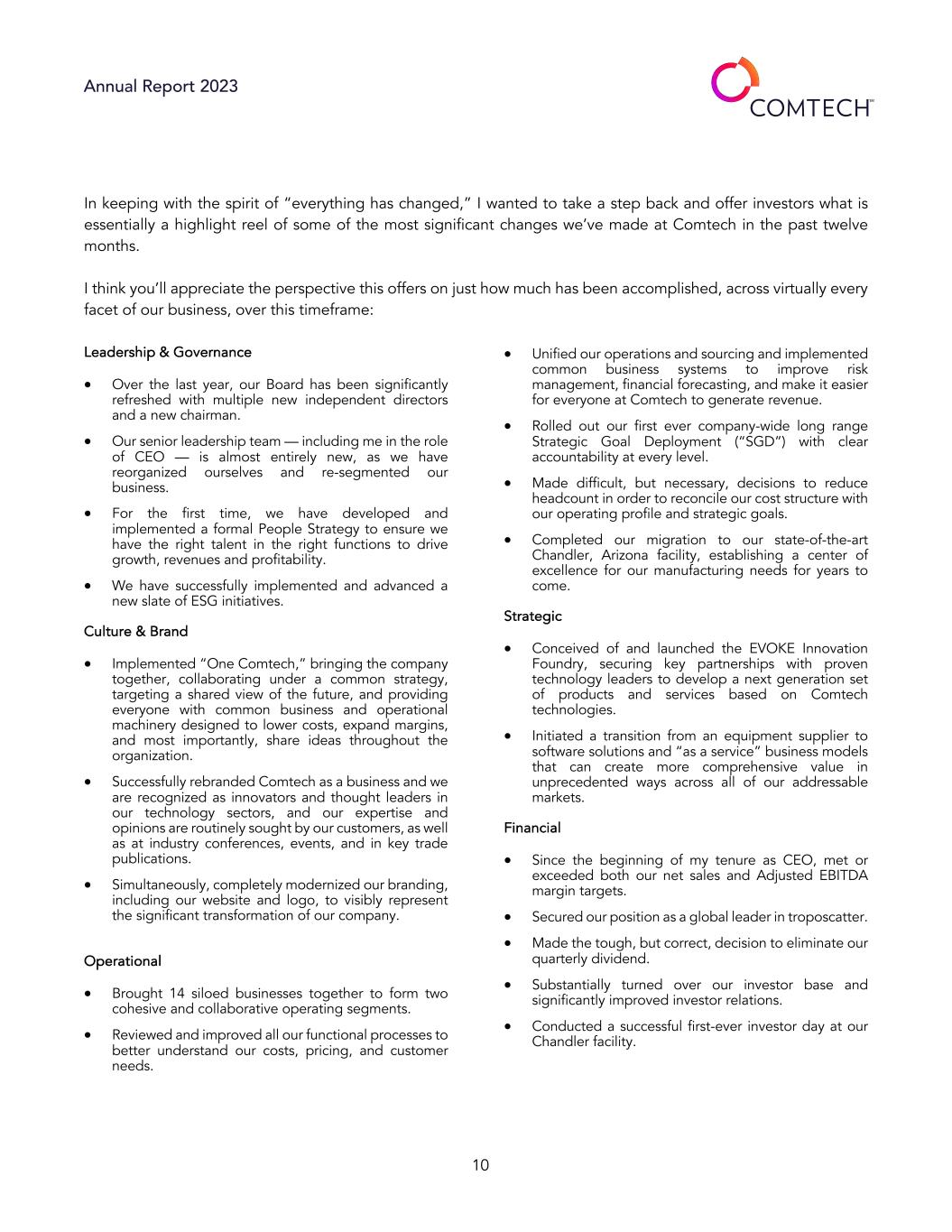
Annual Report 2023 10 In keeping with the spirit of “everything has changed,” I wanted to take a step back and offer investors what is essentially a highlight reel of some of the most significant changes we’ve made at Comtech in the past twelve months. I think you’ll appreciate the perspective this offers on just how much has been accomplished, across virtually every facet of our business, over this timeframe: Leadership & Governance • Over the last year, our Board has been significantly refreshed with multiple new independent directors and a new chairman. • Our senior leadership team — including me in the role of CEO — is almost entirely new, as we have reorganized ourselves and re-segmented our business. • For the first time, we have developed and implemented a formal People Strategy to ensure we have the right talent in the right functions to drive growth, revenues and profitability. • We have successfully implemented and advanced a new slate of ESG initiatives. Culture & Brand • Implemented “One Comtech,” bringing the company together, collaborating under a common strategy, targeting a shared view of the future, and providing everyone with common business and operational machinery designed to lower costs, expand margins, and most importantly, share ideas throughout the organization. • Successfully rebranded Comtech as a business and we are recognized as innovators and thought leaders in our technology sectors, and our expertise and opinions are routinely sought by our customers, as well as at industry conferences, events, and in key trade publications. • Simultaneously, completely modernized our branding, including our website and logo, to visibly represent the significant transformation of our company. Operational • Brought 14 siloed businesses together to form two cohesive and collaborative operating segments. • Reviewed and improved all our functional processes to better understand our costs, pricing, and customer needs. • Unified our operations and sourcing and implemented common business systems to improve risk management, financial forecasting, and make it easier for everyone at Comtech to generate revenue. • Rolled out our first ever company-wide long range Strategic Goal Deployment (“SGD”) with clear accountability at every level. • Made difficult, but necessary, decisions to reduce headcount in order to reconcile our cost structure with our operating profile and strategic goals. • Completed our migration to our state-of-the-art Chandler, Arizona facility, establishing a center of excellence for our manufacturing needs for years to come. Strategic • Conceived of and launched the EVOKE Innovation Foundry, securing key partnerships with proven technology leaders to develop a next generation set of products and services based on Comtech technologies. • Initiated a transition from an equipment supplier to software solutions and “as a service” business models that can create more comprehensive value in unprecedented ways across all of our addressable markets. Financial • Since the beginning of my tenure as CEO, met or exceeded both our net sales and Adjusted EBITDA margin targets. • Secured our position as a global leader in troposcatter. • Made the tough, but correct, decision to eliminate our quarterly dividend. • Substantially turned over our investor base and significantly improved investor relations. • Conducted a successful first-ever investor day at our Chandler facility.

UNITED STATES SECURITIES AND EXCHANGE COMMISSION Washington, D.C. 20549 FORM 10-K (Mark One) ☒ Annual Report Pursuant to Section 13 or 15(d) of the Securities Exchange Act of 1934 For the fiscal year ended July 31, 2023 ☐ Transition Report Pursuant to Section 13 or 15(d) of the Securities Exchange Act of 1934 Commission File Number: 0-7928 (Exact name of registrant as specified in its charter) Delaware 11-2139466 (State or other jurisdiction of incorporation /organization) (I.R.S. Employer Identification Number) 68 South Service Road, Suite 230, Melville, NY 11747 (Address of principal executive offices) (Zip Code) (631) 962-7000 (Registrant's telephone number, including area code) Securities registered pursuant to Section 12(b) of the Act: Title of each class Trading Symbol(s) Name of each exchange on which registered Common Stock, par value $.10 per share CMTL Nasdaq Stock Market LLC Securities registered pursuant to Section 12(g) of the Act: None (Title of class) Indicate by check mark if the registrant is a well-known seasoned issuer, as defined in Rule 405 of the Securities Act. ☐ Yes ☒ No Indicate by check mark if the registrant is not required to file reports pursuant to Section 13 of Section 15(d) of the Act. ☐ Yes ☒ No Indicate by check mark whether the registrant (1) has filed all reports required to be filed by Section 13 or 15(d) of the Securities Exchange Act of 1934 during the preceding 12 months (or for such shorter period that the registrant was required to file such reports), and (2) has been subject to such filing requirements for the past 90 days. ☒ Yes ☐ No Indicate by check mark whether the registrant has submitted electronically every Interactive Data file required to be submitted pursuant to Rule 405 of Regulation S-T (§ 232.405 of this chapter) during the preceding 12 months (or for such shorter period that the registrant was required to submit such files). ☒ Yes ☐ No

Indicate by check mark whether the registrant is a large accelerated filer, an accelerated filer, a non-accelerated filer, a smaller reporting company, or an emerging growth company. See the definitions of "large accelerated filer," "accelerated filer," "smaller reporting company," and "emerging growth company" in Rule 12b-2 of the Exchange Act. Large accelerated filer ☐ Accelerated filer ☒ Non-accelerated filer ☐ Smaller reporting company ☐ Emerging growth company ☐ If an emerging growth company, indicate by check mark if the registrant has elected not to use the extended transition period for complying with any new or revised financial accounting standards provided pursuant to Section 13(a) of the Exchange Act. ☐ Indicate by check mark whether the registrant has filed a report on and attestation to its management’s assessment of the effectiveness of its internal control over financial reporting under Section 404(b) of the Sarbanes-Oxley Act (15 U.S.C. 7262(b)) by the registered public accounting firm that prepared or issued its audit report. ☒ Indicate by check mark whether registrant is a shell company (as defined in Rule 12b-2 of the Exchange Act). ☐ Yes ☒ No The aggregate market value of the registrant’s voting stock held by non-affiliates of the registrant, computed by reference to the closing sales price as quoted on the Nasdaq Global Select Market on January 31, 2023 was approximately $438,634,000. The number of shares of the registrant’s common stock outstanding on October 6, 2023 was 28,127,498. DOCUMENTS INCORPORATED BY REFERENCE. Certain portions of the document listed below have been incorporated by reference into the indicated Part of this Annual Report on Form 10-K: Proxy Statement for 2023 Annual Meeting of Stockholders - Part III
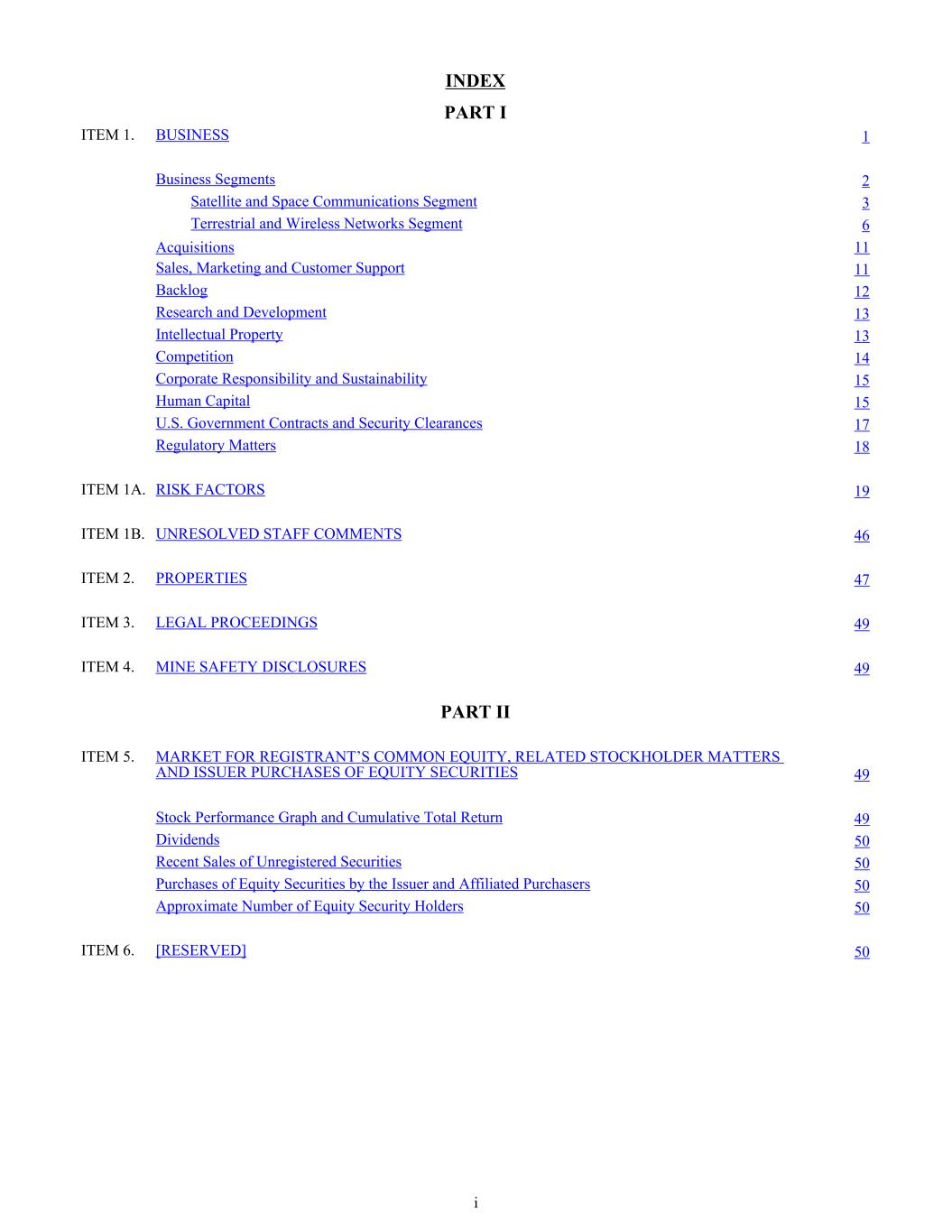
INDEX PART I ITEM 1. BUSINESS 1 Business Segments 2 Satellite and Space Communications Segment 3 Terrestrial and Wireless Networks Segment 6 Acquisitions 11 Sales, Marketing and Customer Support 11 Backlog 12 Research and Development 13 Intellectual Property 13 Competition 14 Corporate Responsibility and Sustainability 15 Human Capital 15 U.S. Government Contracts and Security Clearances 17 Regulatory Matters 18 ITEM 1A. RISK FACTORS 19 ITEM 1B. UNRESOLVED STAFF COMMENTS 46 ITEM 2. PROPERTIES 47 ITEM 3. LEGAL PROCEEDINGS 49 ITEM 4. MINE SAFETY DISCLOSURES 49 PART II ITEM 5. MARKET FOR REGISTRANT’S COMMON EQUITY, RELATED STOCKHOLDER MATTERS AND ISSUER PURCHASES OF EQUITY SECURITIES 49 Stock Performance Graph and Cumulative Total Return 49 Dividends 50 Recent Sales of Unregistered Securities 50 Purchases of Equity Securities by the Issuer and Affiliated Purchasers 50 Approximate Number of Equity Security Holders 50 ITEM 6. [RESERVED] 50 i
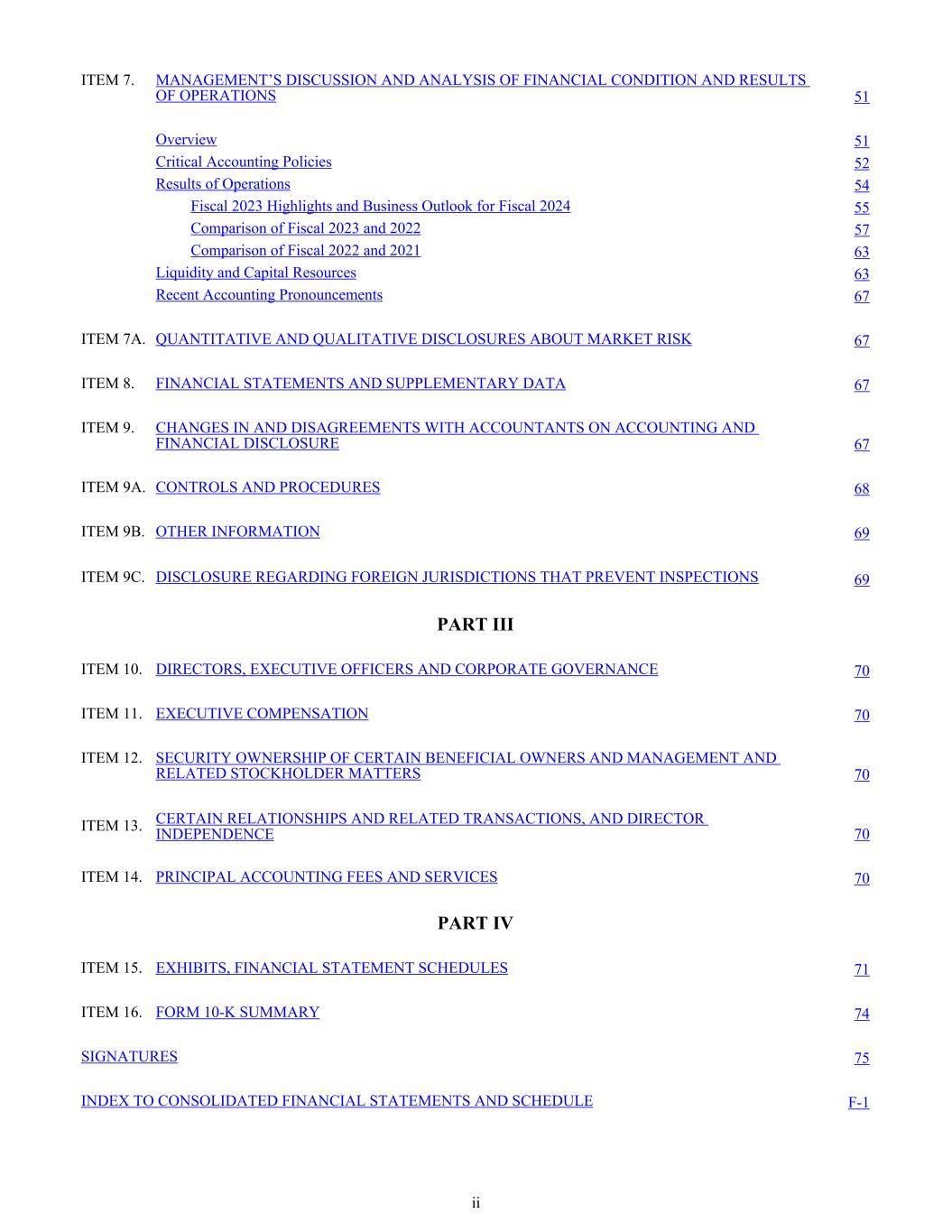
ITEM 7. MANAGEMENT’S DISCUSSION AND ANALYSIS OF FINANCIAL CONDITION AND RESULTS OF OPERATIONS 51 Overview 51 Critical Accounting Policies 52 Results of Operations 54 Fiscal 2023 Highlights and Business Outlook for Fiscal 2024 55 Comparison of Fiscal 2023 and 2022 57 Comparison of Fiscal 2022 and 2021 63 Liquidity and Capital Resources 63 Recent Accounting Pronouncements 67 ITEM 7A. QUANTITATIVE AND QUALITATIVE DISCLOSURES ABOUT MARKET RISK 67 ITEM 8. FINANCIAL STATEMENTS AND SUPPLEMENTARY DATA 67 ITEM 9. CHANGES IN AND DISAGREEMENTS WITH ACCOUNTANTS ON ACCOUNTING AND FINANCIAL DISCLOSURE 67 ITEM 9A. CONTROLS AND PROCEDURES 68 ITEM 9B. OTHER INFORMATION 69 ITEM 9C. DISCLOSURE REGARDING FOREIGN JURISDICTIONS THAT PREVENT INSPECTIONS 69 PART III ITEM 10. DIRECTORS, EXECUTIVE OFFICERS AND CORPORATE GOVERNANCE 70 ITEM 11. EXECUTIVE COMPENSATION 70 ITEM 12. SECURITY OWNERSHIP OF CERTAIN BENEFICIAL OWNERS AND MANAGEMENT AND RELATED STOCKHOLDER MATTERS 70 ITEM 13. CERTAIN RELATIONSHIPS AND RELATED TRANSACTIONS, AND DIRECTOR INDEPENDENCE 70 ITEM 14. PRINCIPAL ACCOUNTING FEES AND SERVICES 70 PART IV ITEM 15. EXHIBITS, FINANCIAL STATEMENT SCHEDULES 71 ITEM 16. FORM 10-K SUMMARY 74 SIGNATURES 75 INDEX TO CONSOLIDATED FINANCIAL STATEMENTS AND SCHEDULE F-1 ii

Note: As used in this Annual Report on Form 10-K ("Form 10-K"), the terms "Comtech," "we," "us," "our" and "our Company" mean Comtech Telecommunications Corp. and its subsidiaries. Note About Forward-Looking Statements Certain information in this Form 10-K contains forward-looking statements. Forward-looking statements can be identified by words such as: "anticipate," "believe," "continue," "could," "estimate," "expect," "future," "goal," "intend," "likely," "may," "plan," "potential," "predict," "project," "seek," "should," "strategy," "target," "will," "would," and similar references to future periods. Examples of forward-looking statements include, among others, statements we make regarding our future performance and financial condition, plans and objectives of our management and our assumptions regarding such future performance, financial condition, and plans and objectives that involve certain significant known and unknown risks and uncertainties and other factors not under our control which may cause our actual results, future performance and financial condition, and achievement of our plans and objectives of our management to be materially different from the results, performance or other expectations implied by these forward-looking statements. These factors include, among other things: the possibility that the expected synergies and benefits from acquisitions will not be fully realized, or will not be realized within the anticipated time periods; the risk that the acquired businesses will not be integrated successfully; the possibility of disruption from acquisitions, making it more difficult to maintain business and operational relationships or retain key personnel; the risk that we will be unsuccessful in implementing our "One Comtech" transformation and integration of individual businesses into two segments; the risk that we will be unsuccessful in implementing a tactical shift in our Satellite and Space Communications segment away from bidding on large commodity service contracts and toward pursuing contracts for our niche products and solutions with higher margins; the nature and timing of our receipt of, and our performance on, new or existing orders that can cause significant fluctuations in net sales and operating results; the timing and funding of government contracts; adjustments to gross profits on long-term contracts; risks associated with international sales; rapid technological change; evolving industry standards; new product announcements and enhancements; changing customer demands and or procurement strategies; changes in prevailing economic and political conditions, including as a result of Russia's military incursion into Ukraine; changes in the price of oil in global markets; changes in prevailing interest rates and foreign currency exchange rates; risks associated with our legal proceedings, customer claims for indemnification, and other similar matters; risks associated with our obligations under our credit facility; risks associated with our large contracts; risks associated with the COVID-19 pandemic and related supply chain disruptions; and other factors described in this and our other filings with the Securities and Exchange Commission ("SEC"). However, the risks described in this Form 10-K are not the only risks that we face. Additional risks and uncertainties, not currently known to us or that do not currently appear to be material, may also materially adversely affect our business, financial condition and/or operating results in the future. We describe risks and uncertainties that could cause actual results and events to differ materially in "Risk Factors" (Part I, Item 1A of this Form 10-K), "Management’s Discussion and Analysis of Financial Condition and Results of Operations" (Part II, Item 7 of this Form 10-K) and "Quantitative and Qualitative Disclosures about Market Risk" (Part II, Item 7A of this Form 10-K). We do not intend to update or revise publicly any forward-looking statements, whether because of new information, future events, or otherwise, except as required by law. PART I ITEM 1. BUSINESS Founded in 1967, we are a leading global provider of next-generation 911 emergency systems ("NG-911") and secure wireless and satellite communications technologies. This includes the critical communications infrastructure that people, businesses, and governments rely on when durable, trusted connectivity is required, no matter where they are – on land, at sea, or in the air – and no matter what the circumstances – from armed conflict to a natural disaster. Our solutions are designed to fulfill our customers’ needs for secure wireless communications in the most demanding environments, including those where traditional communications are unavailable or cost-prohibitive, and in mission-critical and other scenarios where performance is crucial. We anticipate future growth in our business due to a trend of increasing demand for global voice, video and data usage in recent years, upgraded ground stations and related services resulting from the large quantities of satellites anticipated to be launched for new LEO and MEO constellations, digitization and virtualization of modems, the resurgence of troposcatter as a viable form of primary or backup communications, enhanced location positioning combined with data-rich geospatial intelligence, and the growth of 988 networks. We provide our solutions to both commercial and governmental customers within the converging satellite and space communications and terrestrial and wireless networking markets. In August 2022, we announced that Ken Peterman was appointed President and CEO. Mr. Peterman’s significant experience in satellite technology and decades of experience with U.S. government contracting is expected to enhance our efforts to continually improve commercial success and shareholder value. To advance our CEO’s initiatives to further strengthen and grow our business, we continue to move forward on the operational and cultural transformation that we call "One Comtech." 1

Since being appointed President and CEO, Mr. Peterman, along with his senior leadership team, has been driving transformational changes at Comtech to, among other things, integrate our individual businesses into two segments and improve operational performance. This transformation has provided insight into opportunities to manage costs, streamline operations, improve efficiency, and accelerate decision making by eliminating management layers and other redundancies. As part of our “One Comtech” initiative, we also celebrated the rebranding and launch of Comtech’s new logo and website, representing our commitment to delivering software-centric, cloud native communications solutions. In fiscal 2023, we established EVOKE as Comtech’s innovation foundry, which is dedicated to creating and accelerating transformational changes in global technologies. We believe that EVOKE will enhance our existing technologies and service offerings (e.g., cloud-native satellite ecosystems, 5G advanced services and “as-a-service” business models) as well as allow us to pioneer entirely new ideas and opportunities with the benefit of multiple perspectives, industry backgrounds and areas of expertise. Since our launch of EVOKE, we have announced several technology partners, including Aarna Networks, Descartes Labs, Inc., Sirqul, Inc. and WishKnish Corp. By combining Aarna Networks’ technologies with Comtech’s Dynamic Cloud Platform, the companies anticipate enabling customers to easily add and manage a variety of open architecture cloud-based applications across private, hybrid and public networks, in both terrestrial and non-terrestrial environments. We are working with Descartes Labs to infuse the power of artificial intelligence, machine learning, predictive intelligence and insight monitoring across Comtech’s product offerings. Comtech and Sirqul are working on “Smart Operations,” where enterprises will be able to make business decisions with real time Internet of Things ("IoT") data. Through our collective efforts, we are working to bring robust mobile, web, social, voice, IoT, and other technologies to a variety of global markets. We are working in collaboration with WishKnish on integrating highly secure, flexible distributed ledger (blockchain) technologies across diverse commercial and government applications. Business Segments We offer advanced secure wireless communications technologies founded on decades of expertise in the satellite communications and cellular markets. We believe these markets are undergoing a period of long-term growth, reinvestment, and rapid technological change. We manage our business through two reportable operating segments: Satellite and Space Communications and Terrestrial and Wireless Networks. Our senior management team supports these business segments by, among other things, actively seeking to identify and leverage synergies that exist between the segments, including in areas such as manufacturing, technology, sales, marketing, customer support and finance. The diagram below summarizes our key products, systems, and services by our two reportable operating segments: Satellite and Space Communications Segment (Approximately 61% of fiscal 2023 net sales) Terrestrial and Wireless Networks Segment (Approximately 39% of fiscal 2023 net sales) • Satellite ground station technologies, services and system integration that facilitate the transmission of voice, video and data over GEO, MEO and LEO satellite constellations, including solid- state and traveling wave tube power amplifiers, modems, VSAT platforms and frequency converters • Satellite communications and tracking antenna systems, including high precision full motion fixed and mobile X/Y tracking antennas, RF feeds, reflectors, and radomes • Over-the-horizon microwave equipment that can transmit digitized voice, video, and data over distances up to 200 miles using the troposphere and diffraction, including the Comtech COMETTM • Solid-state, RF microwave high-power amplifiers and control components designed for radar, electronic warfare, data link, medical and aviation applications • Procurement and supply chain management of high reliability EEE parts for satellite, launch vehicle and manned space applications • Field support sustainment services and technology insertion services primarily supporting tactical VSAT systems, Blue Force Tracking Systems and cybersecurity training services • Wireless/VolP 911 location and routing services to connect emergency calls to Public Safety Answering Points • SMS Text to 911 services, providing alternate paths for individuals who need to request assistance (via text messaging) a method to reach Public Safety Answering Points • Next Generation 911 solutions, providing emergency call routing, location validation, policy-based routing rules, logging, and security functionality • Emergency Services IP Network transport infrastructure for emergency services communications and support of Next Generation 911 services • Call handling applications for Public Safety Answering Points • Wireless emergency alerts solutions for network operators • Software and equipment for location-based and text messaging services for various applications, including for public safety, commercial and government services • Cybersecurity training, skills labs, and competency assessments for both technical and non-technical applications Financial information about our business segments, including net sales, operating income, Adjusted EBITDA (a Non-GAAP financial measure), total assets, and our operations outside the United States, is provided in "Notes to Consolidated Financial Statements - Note (11) Segment Information" included in "Part II - Item 8. Financial Statements and Supplementary Data." 2
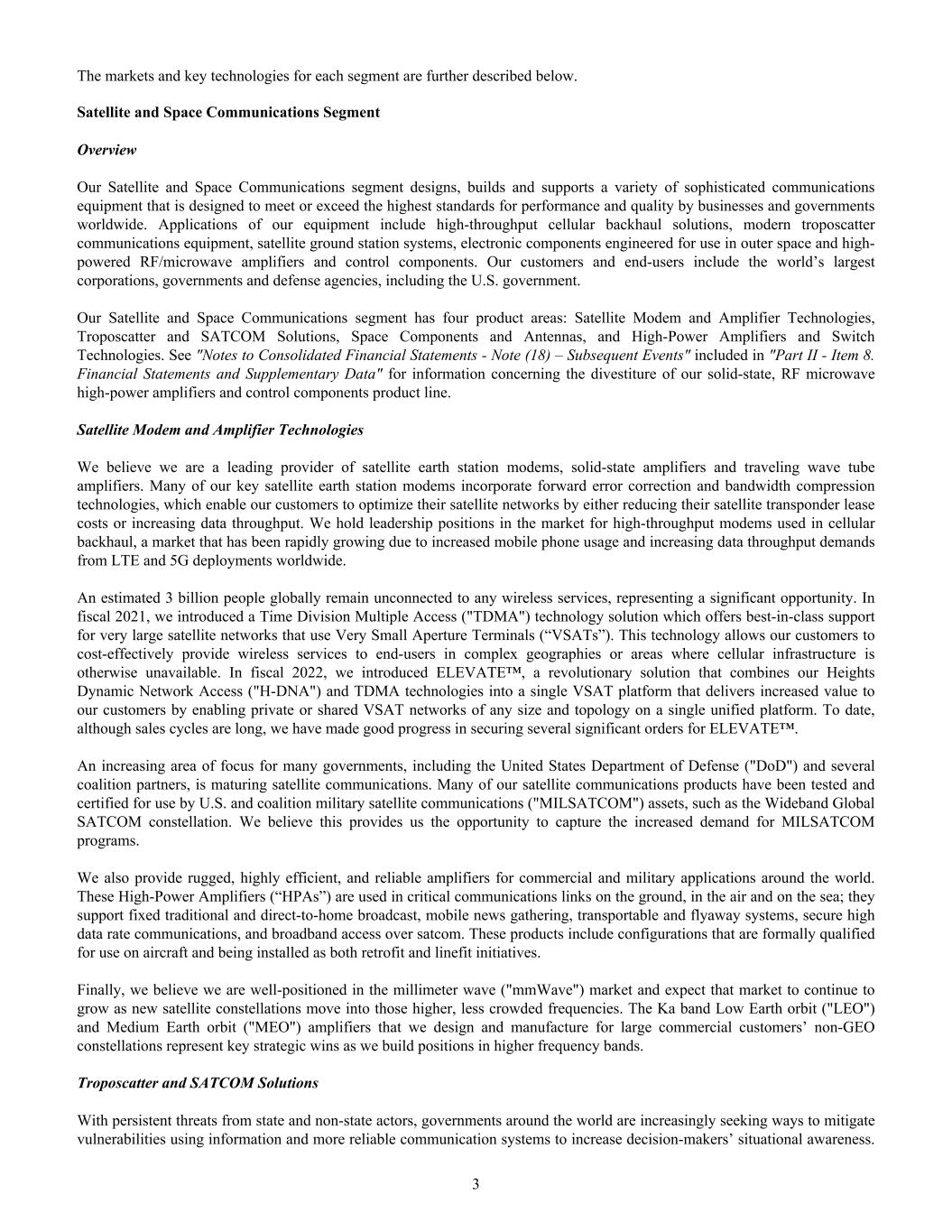
The markets and key technologies for each segment are further described below. Satellite and Space Communications Segment Overview Our Satellite and Space Communications segment designs, builds and supports a variety of sophisticated communications equipment that is designed to meet or exceed the highest standards for performance and quality by businesses and governments worldwide. Applications of our equipment include high-throughput cellular backhaul solutions, modern troposcatter communications equipment, satellite ground station systems, electronic components engineered for use in outer space and high- powered RF/microwave amplifiers and control components. Our customers and end-users include the world’s largest corporations, governments and defense agencies, including the U.S. government. Our Satellite and Space Communications segment has four product areas: Satellite Modem and Amplifier Technologies, Troposcatter and SATCOM Solutions, Space Components and Antennas, and High-Power Amplifiers and Switch Technologies. See "Notes to Consolidated Financial Statements - Note (18) – Subsequent Events" included in "Part II - Item 8. Financial Statements and Supplementary Data" for information concerning the divestiture of our solid-state, RF microwave high-power amplifiers and control components product line. Satellite Modem and Amplifier Technologies We believe we are a leading provider of satellite earth station modems, solid-state amplifiers and traveling wave tube amplifiers. Many of our key satellite earth station modems incorporate forward error correction and bandwidth compression technologies, which enable our customers to optimize their satellite networks by either reducing their satellite transponder lease costs or increasing data throughput. We hold leadership positions in the market for high-throughput modems used in cellular backhaul, a market that has been rapidly growing due to increased mobile phone usage and increasing data throughput demands from LTE and 5G deployments worldwide. An estimated 3 billion people globally remain unconnected to any wireless services, representing a significant opportunity. In fiscal 2021, we introduced a Time Division Multiple Access ("TDMA") technology solution which offers best-in-class support for very large satellite networks that use Very Small Aperture Terminals (“VSATs”). This technology allows our customers to cost-effectively provide wireless services to end-users in complex geographies or areas where cellular infrastructure is otherwise unavailable. In fiscal 2022, we introduced ELEVATE™, a revolutionary solution that combines our Heights Dynamic Network Access ("H-DNA") and TDMA technologies into a single VSAT platform that delivers increased value to our customers by enabling private or shared VSAT networks of any size and topology on a single unified platform. To date, although sales cycles are long, we have made good progress in securing several significant orders for ELEVATE™. An increasing area of focus for many governments, including the United States Department of Defense ("DoD") and several coalition partners, is maturing satellite communications. Many of our satellite communications products have been tested and certified for use by U.S. and coalition military satellite communications ("MILSATCOM") assets, such as the Wideband Global SATCOM constellation. We believe this provides us the opportunity to capture the increased demand for MILSATCOM programs. We also provide rugged, highly efficient, and reliable amplifiers for commercial and military applications around the world. These High-Power Amplifiers (“HPAs”) are used in critical communications links on the ground, in the air and on the sea; they support fixed traditional and direct-to-home broadcast, mobile news gathering, transportable and flyaway systems, secure high data rate communications, and broadband access over satcom. These products include configurations that are formally qualified for use on aircraft and being installed as both retrofit and linefit initiatives. Finally, we believe we are well-positioned in the millimeter wave ("mmWave") market and expect that market to continue to grow as new satellite constellations move into those higher, less crowded frequencies. The Ka band Low Earth orbit ("LEO") and Medium Earth orbit ("MEO") amplifiers that we design and manufacture for large commercial customers’ non-GEO constellations represent key strategic wins as we build positions in higher frequency bands. Troposcatter and SATCOM Solutions With persistent threats from state and non-state actors, governments around the world are increasingly seeking ways to mitigate vulnerabilities using information and more reliable communication systems to increase decision-makers’ situational awareness. 3

Many of our mission-critical technologies are part of integrated communication infrastructure systems such as the U.S. military's Command, Control, Communications, Computers, Cyber Intelligence, Surveillance and Reconnaissance (also known as "C5ISR") systems and similarly complex networks for international governments. We believe we are a world leader in the design and supply of troposcatter equipment. We have designed, manufactured, and delivered troposcatter systems (sometimes referred to as over-the-horizon ("OTH") microwave products and systems) for well over fifty years. Our OTH systems, which include our patented forward error correction technology, can transmit video and other broadband applications at high throughputs in the most demanding environments: U.S. and foreign governments use our over-the-horizon microwave systems to, among other things, transmit radar tracking, run C5ISR applications and connect to remote border locations. Additionally, energy companies use our systems to enable communication links for offshore oil rigs and other remote locations, as well as for exploration activities. The Comtech COMET™ is a rapidly deployable OTH microwave system that directly addresses a void in capabilities that have long been desired by tactical communications planners: low probability of intercept and low probability of detection (“LPI/LPD”), while providing high reliability, mission essential communications. The COMET™ is capable of being transported in a carrying case by a single individual and set up in under fifteen minutes, extending critical services into areas where there is no communications infrastructure, or the infrastructure has been destroyed. U.S. Special Forces, as well as non-U.S. NATO forces, have already begun procuring and deploying the COMET™ for high reliability, mission essential communications. We provide field support sustainment services, centralized and deployed depot services, and technology insertion services to the U.S. Army’s AN/TSC-198 family of communication systems that are commonly referred to as "SNAP" (Secret Internet Protocol Router ("SIPR") and Non-secure Internet Protocol Router ("NIPR") Access Point) VSATs, support for the Army “SCOUT” (Scalable Class of Unified Terminals), and Army T2C2 (Tactical Command Communication). Our field support services include providing DoD personnel with curriculum development and training services to support cybersecurity workforce development. Space Components and Antennas For over 45 years, we have been recognized as an industry leader and global supplier of high-reliability products and supply chain management and engineering services, supporting selection of space-qualified parts for satellite and launch vehicle tracking solutions geared for critical U.S. National Aeronautics and Space Administration ("NASA") programs as well as several international space and defense agencies. Our engineers are not only involved in the design of products, but our technical team is heavily involved with the customer development of electronic parts and testing specifications to assure capability, reliability and radiation tolerance to specific mission/project requirements both as an individual service and for Electrical, Electronic, and Electromechanical (“EEE”) parts supplied to our customers. We also lead and conduct failure analysis investigations and assist with manufacturing and test problems at the source and support reporting and selloff with the customer and its prime (such as the Japanese Space Exploration Agency (“JAXA”) and NASA). Our quality engineering team assures that the product received from our suppliers and test facilities are compliant to their respective specifications prior to shipment to our end customers. Most recently, our service offerings have been expanded to include kitting to customer Bill of Materials with direct shipments to customer designated contract manufacturers. Within the satellite communications market, we are a leading provider of X/Y terminal solutions that fully support the mission requirements of LEO, MEO and GEO satellite communication and tracking requirements, offering a host of high-performance single-band and multi-band feed solutions. We also supply maritime antenna solutions that are fielded by foreign governments. High Power Amplifiers and Switches We offer several unique high-performance transmit and receive technologies used in sophisticated communication systems, including electronic warfare, radar, data link, medical and identification friend or foe ("IFF"). As our customers push the envelope for mobility, speed and frequency, we believe that demand for high-performance transmission products will increase over time. 4

Our solid-state, high-power RF microwave amplifiers and related switching control technologies are utilized in many critical applications, including electronic warfare, communications, radar, data link, IFF and medical applications (such as oncology treatment systems). In the electronic warfare marketplace, we support a variety of legacy systems and are participating in the ongoing migration to platforms that require smaller and lighter amplifiers integrated with additional signal processing functionality, providing more complete transmit and receive functionality. Our solutions are designed to increase the flexibility of systems by providing wider bandwidth capabilities to address increased data transmission needs in challenging environments. We also believe the desire for increased airspace situational awareness will create increased opportunities for our radar and IFF products, which are used by government and commercial customers around the world. Our high power and highly reliable Gallium Nitride ("GaN") amplifier technology is increasingly used both to update existing radar systems for improved sensitivity and range, as well as for new radar applications and installations. In addition to technologies that enhance performance of primary radars, we also supply solutions for IFF systems that provide positive identification of radar targets for secondary surveillance systems. Satellite and Space Communications: Key Markets and Growth Drivers Combined, our Satellite and Space Communications segment offers our customers one-stop-shopping for sophisticated satellite ground station technologies and solutions, including SCPC and TDMA modems, amplifiers, antennas, frequency converters and network software for customers who utilize satellite communications. Our products are used to modulate, demodulate and amplify signals, carry voice, video and/or data over networks and are vital to satellite communication applications, including air-to-ground communications, video broadcasting and the backhaul of cellular traffic. Our Satellite and Space Communications segment manufactures most of the satellite ground station equipment we sell to our customers. We believe that the overall satellite ground station equipment industry will grow from current levels and will be increasingly combined with existing and new cellular networks. This growth is expected to occur because of widespread deployment of, and upgrades to, 4G and 5G ground-based systems, including satellite earth stations, as well as the integration of high-performance amplifiers necessary to meet long-term demand for high-performance satellite communications applications, such as satellite- based wireless backhaul, DTH, HD and 4K broadcasting, and in-flight connectivity. We believe that Comtech is well- positioned to capitalize on this demand through sales of our market-leading satellite ground station technologies, including new next-generation satellite earth station technologies that can be used with the thousands of new LEO, MEO and large HTS satellite constellations that are expected to be deployed over the next several years. Examples of end-market applications that are driving long-term demand for our satellite-based communication technologies include: • New LEO, MEO and HTS Satellites: Thousands of new satellites are reportedly being launched over the next several years, according to announcements by companies including Telesat Lightspeed, OneWeb, SpaceX Starlink, Amazon Kuiper and Viasat, which we believe will lead to increasingly complex satellite networks. As service providers work to offer connectivity to these high-speed, high-bandwidth satellites and expand their networks to handle the demand for new LEO, MEO and HTS applications, we believe our ELEVATETM, HeightsTM and UHP networking platforms, our solid-state amplifiers and our X/Y antennas will ultimately be incorporated into many new installations and equipment upgrades. We continue to provide modems and amplifiers to existing LEO and MEO communications satellite providers and expect to see growth in imaging satellites alongside commercial imaging constellations, including conventional, thermal, and hyperspectral. • Satellite-Based Cellular Backhaul: Demand for satellite-based cellular backhaul services is anticipated to grow rapidly as a result of the increased penetration of smart cellular phones and network upgrades to 4G and 5G in developing regions of the world. Ultimately, as 5G services continue to be deployed, we expect that mobile data services will become more critical. As mobile data penetration expands and mobile data consumption increases, wireless carriers must invest in their mobile network infrastructures, and we believe businesses will require back- up communications. In developing regions of the world, and in remote areas where terrestrial network infrastructure is lacking (or where challenging geography prohibits it), wireless network operators often backhaul, or transport, their wireless data traffic using satellite-based networking technologies. Comtech is well positioned to serve the high-performance, high availability needs of satellite-based cellular backhaul through sales of our SCPC and TDMA satellite modems as well as our HeightsTM, ELEVATETM and UHP networking platforms. 5

• Government and Military Satellite Communications: Government users rely on high-speed connectivity in a variety of conditions throughout the world to provide real time information sharing, including Situational Awareness (“SA”), dissemination of Intelligence, Surveillance, and Reconnaissance (“ISR”) information, and communications. Our communications solutions provide command and control and satellite networking capabilities that support U.S. and allied government initiatives for assured and resilient communications capabilities, as well as supporting interoperability objectives, including the Joint All Domain Command and Control (“JADC2”) efforts. • Enterprise Networks and Internet of Things (“IoT”): Satellite services are increasingly used for Machine-to- Machine data connectivity for both critical infrastructure applications such as utility companies (electrical grid, oil rigs, gas pipelines, water companies) as well as IoT networks. Comtech TDMA equipment is widely used in these applications, where it delivers superior network availability (by making use of geographical hub redundancy and other technologies), and high Quality of Service (“QoS”). • Geospatial and Earth Observation: led by the need to deliver near real time insights to government and commercial customers globally, the LEO operated Geospatial and Earth Observation satellite constellations have a driving need to gain access to their data at speed, and via trusted U.S. providers. We believe Comtech is uniquely positioned to stand our Geospatial and Earth Observation services on the shoulders of our globally proven technologies to connect critical services for LEO based satellite communications operators. In this way, we are able to position fixed ground services, transportable kits and, by leveraging our partners in EVOKE, data processing and analytics at the edge to support our Geospatial and Earth Observation customers going forward. Terrestrial and Wireless Networks Segment Overview Our Terrestrial and Wireless Networks segment is a leading provider of the hardware, software, and solutions critical to any modern 911 public safety and mobile network operator (“MNO”) infrastructure, as well as for applications services requiring the specific location of a mobile user's geospatial position. From the moment a 911 call is made, Comtech provides highly reliable solutions that contribute to emergency calls being processed instantly, with proper routing to first responders. Our solutions include feature-rich data sets (such as: precise location information, route optimization, text messaging, photos and real-time video), putting first responders in the best possible position to make decisions when every second counts. Our customers are the businesses, communities and governments that need to implement and improve 911 infrastructure in the U.S., as well as MNOs in the U.S. and abroad that have a need to determine subscriber location within a network or to facilitate messaging services. According to Frost & Sullivan, a leading third-party research firm, we were the second leading NG-911 primary contract holder at year-end 2022 with an estimated market share of 22.3%. Our direct NG-911 contracts covered a population of over 56 million at the end of 2022. As such, we believe that we are a leader in public safety communication and location technologies. The Terrestrial and Wireless Networks segment is organized into three product areas: Next Generation 911 & Call Delivery, Solacom Call Handling Solutions, and Trusted Location and Messaging Solutions. Next Generation 911 & Call Delivery In addition to 911 call routing, we provide systems integration, geospatial location information, satellite and location infrastructure terminals, and linkage to NG-911 Emergency Services IP Networks ("ESInet"). We also offer what we believe are best-in-class 911 call handling solutions under the Solacom brand name. We believe state and local governments need to upgrade existing legacy networks, location technologies, and call handling systems to modern NG-911 systems infrastructure, including 911 text messaging services, advanced data, real-time photos, and other types of information sharing over IP networks. 6
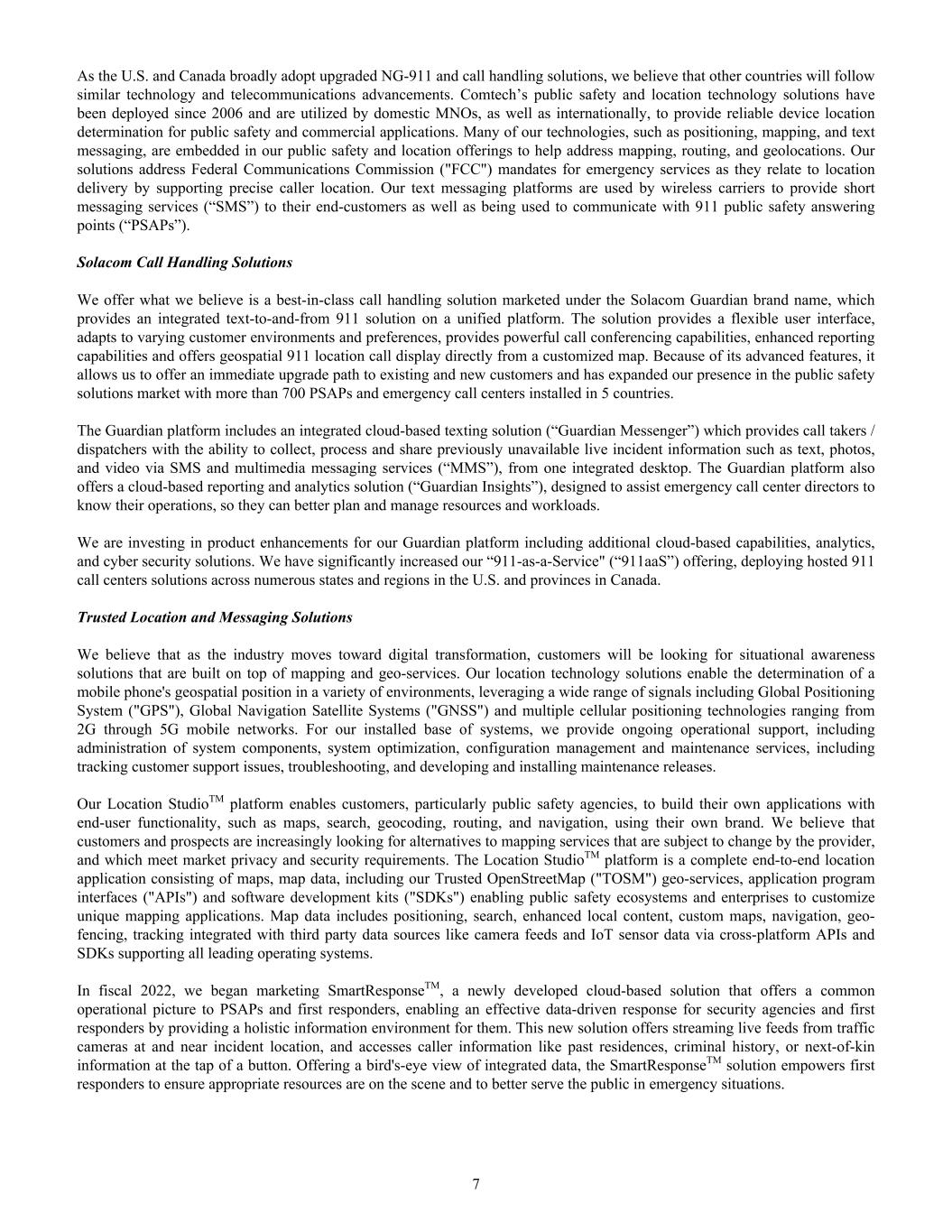
As the U.S. and Canada broadly adopt upgraded NG-911 and call handling solutions, we believe that other countries will follow similar technology and telecommunications advancements. Comtech’s public safety and location technology solutions have been deployed since 2006 and are utilized by domestic MNOs, as well as internationally, to provide reliable device location determination for public safety and commercial applications. Many of our technologies, such as positioning, mapping, and text messaging, are embedded in our public safety and location offerings to help address mapping, routing, and geolocations. Our solutions address Federal Communications Commission ("FCC") mandates for emergency services as they relate to location delivery by supporting precise caller location. Our text messaging platforms are used by wireless carriers to provide short messaging services (“SMS”) to their end-customers as well as being used to communicate with 911 public safety answering points (“PSAPs”). Solacom Call Handling Solutions We offer what we believe is a best-in-class call handling solution marketed under the Solacom Guardian brand name, which provides an integrated text-to-and-from 911 solution on a unified platform. The solution provides a flexible user interface, adapts to varying customer environments and preferences, provides powerful call conferencing capabilities, enhanced reporting capabilities and offers geospatial 911 location call display directly from a customized map. Because of its advanced features, it allows us to offer an immediate upgrade path to existing and new customers and has expanded our presence in the public safety solutions market with more than 700 PSAPs and emergency call centers installed in 5 countries. The Guardian platform includes an integrated cloud-based texting solution (“Guardian Messenger”) which provides call takers / dispatchers with the ability to collect, process and share previously unavailable live incident information such as text, photos, and video via SMS and multimedia messaging services (“MMS”), from one integrated desktop. The Guardian platform also offers a cloud-based reporting and analytics solution (“Guardian Insights”), designed to assist emergency call center directors to know their operations, so they can better plan and manage resources and workloads. We are investing in product enhancements for our Guardian platform including additional cloud-based capabilities, analytics, and cyber security solutions. We have significantly increased our “911-as-a-Service" (“911aaS”) offering, deploying hosted 911 call centers solutions across numerous states and regions in the U.S. and provinces in Canada. Trusted Location and Messaging Solutions We believe that as the industry moves toward digital transformation, customers will be looking for situational awareness solutions that are built on top of mapping and geo-services. Our location technology solutions enable the determination of a mobile phone's geospatial position in a variety of environments, leveraging a wide range of signals including Global Positioning System ("GPS"), Global Navigation Satellite Systems ("GNSS") and multiple cellular positioning technologies ranging from 2G through 5G mobile networks. For our installed base of systems, we provide ongoing operational support, including administration of system components, system optimization, configuration management and maintenance services, including tracking customer support issues, troubleshooting, and developing and installing maintenance releases. Our Location StudioTM platform enables customers, particularly public safety agencies, to build their own applications with end-user functionality, such as maps, search, geocoding, routing, and navigation, using their own brand. We believe that customers and prospects are increasingly looking for alternatives to mapping services that are subject to change by the provider, and which meet market privacy and security requirements. The Location StudioTM platform is a complete end-to-end location application consisting of maps, map data, including our Trusted OpenStreetMap ("TOSM") geo-services, application program interfaces ("APIs") and software development kits ("SDKs") enabling public safety ecosystems and enterprises to customize unique mapping applications. Map data includes positioning, search, enhanced local content, custom maps, navigation, geo- fencing, tracking integrated with third party data sources like camera feeds and IoT sensor data via cross-platform APIs and SDKs supporting all leading operating systems. In fiscal 2022, we began marketing SmartResponseTM, a newly developed cloud-based solution that offers a common operational picture to PSAPs and first responders, enabling an effective data-driven response for security agencies and first responders by providing a holistic information environment for them. This new solution offers streaming live feeds from traffic cameras at and near incident location, and accesses caller information like past residences, criminal history, or next-of-kin information at the tap of a button. Offering a bird's-eye view of integrated data, the SmartResponseTM solution empowers first responders to ensure appropriate resources are on the scene and to better serve the public in emergency situations. 7
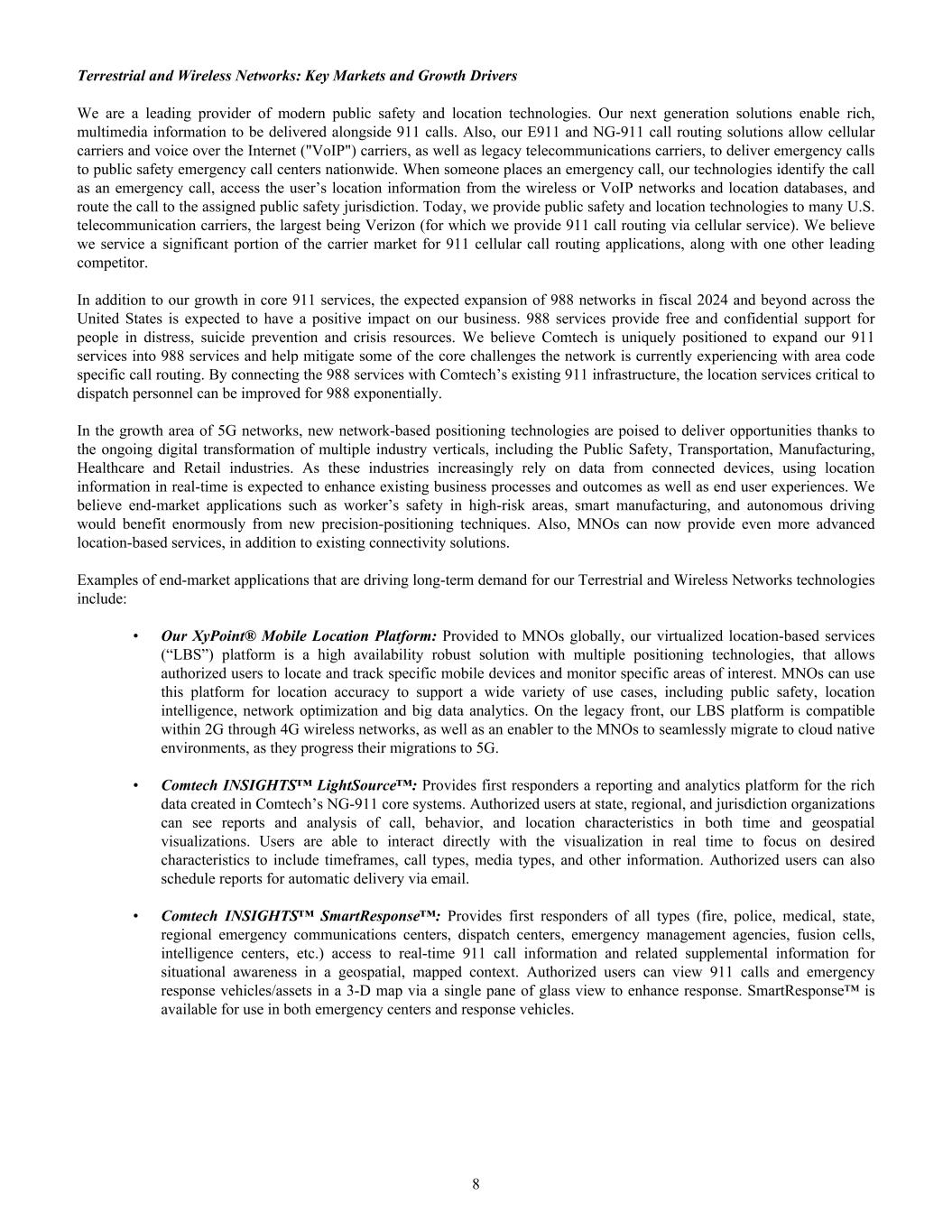
Terrestrial and Wireless Networks: Key Markets and Growth Drivers We are a leading provider of modern public safety and location technologies. Our next generation solutions enable rich, multimedia information to be delivered alongside 911 calls. Also, our E911 and NG-911 call routing solutions allow cellular carriers and voice over the Internet ("VoIP") carriers, as well as legacy telecommunications carriers, to deliver emergency calls to public safety emergency call centers nationwide. When someone places an emergency call, our technologies identify the call as an emergency call, access the user’s location information from the wireless or VoIP networks and location databases, and route the call to the assigned public safety jurisdiction. Today, we provide public safety and location technologies to many U.S. telecommunication carriers, the largest being Verizon (for which we provide 911 call routing via cellular service). We believe we service a significant portion of the carrier market for 911 cellular call routing applications, along with one other leading competitor. In addition to our growth in core 911 services, the expected expansion of 988 networks in fiscal 2024 and beyond across the United States is expected to have a positive impact on our business. 988 services provide free and confidential support for people in distress, suicide prevention and crisis resources. We believe Comtech is uniquely positioned to expand our 911 services into 988 services and help mitigate some of the core challenges the network is currently experiencing with area code specific call routing. By connecting the 988 services with Comtech’s existing 911 infrastructure, the location services critical to dispatch personnel can be improved for 988 exponentially. In the growth area of 5G networks, new network-based positioning technologies are poised to deliver opportunities thanks to the ongoing digital transformation of multiple industry verticals, including the Public Safety, Transportation, Manufacturing, Healthcare and Retail industries. As these industries increasingly rely on data from connected devices, using location information in real-time is expected to enhance existing business processes and outcomes as well as end user experiences. We believe end-market applications such as worker’s safety in high-risk areas, smart manufacturing, and autonomous driving would benefit enormously from new precision-positioning techniques. Also, MNOs can now provide even more advanced location-based services, in addition to existing connectivity solutions. Examples of end-market applications that are driving long-term demand for our Terrestrial and Wireless Networks technologies include: • Our XyPoint® Mobile Location Platform: Provided to MNOs globally, our virtualized location-based services (“LBS”) platform is a high availability robust solution with multiple positioning technologies, that allows authorized users to locate and track specific mobile devices and monitor specific areas of interest. MNOs can use this platform for location accuracy to support a wide variety of use cases, including public safety, location intelligence, network optimization and big data analytics. On the legacy front, our LBS platform is compatible within 2G through 4G wireless networks, as well as an enabler to the MNOs to seamlessly migrate to cloud native environments, as they progress their migrations to 5G. • Comtech INSIGHTS™ LightSource™: Provides first responders a reporting and analytics platform for the rich data created in Comtech’s NG-911 core systems. Authorized users at state, regional, and jurisdiction organizations can see reports and analysis of call, behavior, and location characteristics in both time and geospatial visualizations. Users are able to interact directly with the visualization in real time to focus on desired characteristics to include timeframes, call types, media types, and other information. Authorized users can also schedule reports for automatic delivery via email. • Comtech INSIGHTS™ SmartResponse™: Provides first responders of all types (fire, police, medical, state, regional emergency communications centers, dispatch centers, emergency management agencies, fusion cells, intelligence centers, etc.) access to real-time 911 call information and related supplemental information for situational awareness in a geospatial, mapped context. Authorized users can view 911 calls and emergency response vehicles/assets in a 3-D map via a single pane of glass view to enhance response. SmartResponse™ is available for use in both emergency centers and response vehicles. 8

• Wireless Emergency Alerts (“WEA”): WEA, also known as Commercial Mobile Alerts System (“CMAS”) in the U.S., enable authorized officials to inform the public about life-threatening events by automatically delivering emergency alerts to mobile devices (including roaming users) via the government alert gateway. Using standardized infrastructure, ensuring compliance with government regulations globally, our patented technology facilitates the origination and accurate delivery of geo-targeted emergency alerts, empowering emergency services providers to better serve the public. Using this technology, for example, MNOs can quickly broadcast emergency communications, such as severe weather alerts, to all devices in a specific geographical area. Synergies: Opportunities in Convergence We believe that significant advances in technology have been driving a convergence across multiple aspects of the Terrestrial and Wireless Networks market and the Satellite and Space Communications market. We believe we have an advantage in having identified this convergence, and in combining our native expertise in both to develop innovative new products and solutions to meet growing customer demands. Broadly, the increasing digitalization of people and businesses, and the ongoing migration to the cloud, means a growing reliance on communications and connectivity, and a corresponding increase in the volumes of data transmission. We believe this is a long-term secular opportunity for Comtech given our market-leading positions in, and understanding of, these fast-evolving markets. We are watching in real-time as the once clear line separating terrestrial and non-terrestrial communications networks is dissolving. The need for connectivity (more precisely: constant, reliable connectivity) is growing on a worldwide basis. People, devices, and machines need constant connectivity, regardless of whether they are proximate to a cellular tower. Because of this, satellite communications are increasingly bridging gaps created by challenging geographies, failure of a terrestrial infrastructure due to natural disasters, or a lack of terrestrial infrastructure altogether. Comtech is increasingly delivering solutions to companies and countries seeking to bridge these gaps, whether across legacy 4G networks, or through the introduction of 5G networks, as operators seek ways to optimize implementation, control costs, and mitigate security risks. We expect the convergence of terrestrial and non-terrestrial networks to continue, leveraging the increasing numbers and density of satellite constellations to meet the growing terrestrial demand to connect and move more data, more quickly, reliably, and efficiently than ever. For critical networks such as those for first responders, defense or intelligence users having the resiliency and redundancy of both a terrestrial/wireless backbone and a satellite communications layer increases the opportunity for always- on, always-available connectivity. Comtech is uniquely positioned to expand into this area. Our Diverse Global Customer Base We have established long-standing relationships with thousands of customers worldwide, including leading system and network suppliers in the global satellite, mobile cellular, defense, broadcast and aerospace industries, as well as the U.S. federal government (including the U.S. Army, Air Force, Marine Corps, and Navy), U.S. state and local governments, and foreign governments. Our global Satellite and Space Communications and Terrestrial and Wireless Networks customers are increasingly seeking integrated solutions to meet their operational needs. We believe that our customers recognize our ability to develop improved technologies and to meet stringent program requirements. We hold prime positions on several key contracts and have had a long history of servicing key programs. A table illustrating representative customers is provided below. 9

Satellite and Space Communications Segment Representative Customers Terrestrial and Wireless Networks Segment Representative Customers Satellite systems integrators, wireless and other communication service providers, and broadcasters, such as DIRECTTV Group U.S. Army, the U.S. Marine Corps, the U.S. Navy, prime contractors to the U.S. Armed Forces, NATO and foreign governments (i.e., ministries of defense) Domestic and international defense customers, as well as prime contractors and system suppliers such as General Dynamics Corporation, Lockheed Martin Corporation, L3Harris Technologies, Inc., Northrop Grumman Corporation, Raytheon Technologies Corporation, Telephonics Corporation, The Boeing Company and ViaSat Inc. Medical equipment companies, such as Varian Medical Systems, Inc., and aviation industry system integrators such as Collins Aerospace (a subsidiary of Raytheon Technologies Corporation) End-customers also include China Mobile Limited, Claro Argentina, Intelsat S.A., JAXA, NASA, SED Systems (a division of Calian Ltd.), SES S.A. and Speedcast International Limited Oil companies such as Shell Oil Company and PETRONAS U.S. state and local governments, such as the Commonwealth of Massachusetts, the Commonwealth of Pennsylvania and the states of Arizona, Iowa, Maine, Ohio, New Hampshire, South Carolina, Vermont and Washington End-customers also include AT&T Inc., Lumen Technologies, Inc. (formerly CenturyLink, Inc.), Comcast Corporation, Nokia Corporation, T-Mobile USA, Inc. and Verizon Communications Inc. Different solutions deployed with telephone companies and federal, provincial, and local governments in Australia, Canada, Cayman Islands and New Zealand Business Results and Challenges: Overview In fiscal 2023, we achieved consolidated net sales of $550.0 million and Adjusted EBITDA of $53.5 million. As more fully described elsewhere in this Form 10-K, in fiscal 2023 we navigated the challenges of operating our global business during a period where business conditions continue to be challenging, and the operating environment is largely unpredictable, including factors such as inflation, rising interest rates, the repercussions of the military conflict between Russia and Ukraine and a potential global recession. Order and production delays, disruptions in component availability, increased pricing both for labor and parts, lower levels of factory utilization and higher logistics and operational costs are also continuing to impact our business. Nevertheless, despite these business conditions and resulting challenges and although we anticipate some variability from time to time as we move through our One Comtech transformational change, we believe as the global economy continues to recover, our business performance in future periods will continue to improve from current levels. Our Business Outlook for Fiscal 2024 is discussed further in Part II – “Item 7. Management’s Discussion and Analysis of Financial Condition and Results of Operations – Business Outlook for Fiscal 2024.” For a definition and explanation of Adjusted EBITDA, see Part II – “Item 7. Management’s Discussion and Analysis of Financial Condition and Results of Operations – Comparison of Fiscal 2023 and 2022 – Adjusted EBITDA.” More Information and Where to Find It Our Internet website is www.comtech.com, at which you can find our filings with the Securities and Exchange Commission ("SEC"), including investor letters, press releases, annual reports, quarterly reports, current reports, and any amendments to those filings. We also make announcements regarding company developments and financial and operating performance through our blog, Signals, at www.comtech.com/signals. We also use our website to disseminate other material information to our investors (on the Home Page and in the "Investor Relations" section). Among other things, we post on our website our press releases and information about our public conference calls (including the scheduled dates, times and the methods by which investors and others can listen to those calls), and we make available for replay webcasts of those calls and other presentations for a limited time. We also use social media channels to communicate with customers and the public about our Company, our products, services, and other issues, and we use social media and the Internet to communicate with investors, including information about our stockholder meetings. Information and updates about our Annual Meetings will continue to be posted on our website at www.comtech.com in the "Investors" section. None of the information on our website, blog or any other website identified herein is incorporated by reference in this annual report and such information should not be considered a part of this annual report. 10

Acquisitions In order to position ourselves to take advantage of additional growth opportunities and meet our strategic objectives, we have followed, and will continue to follow, a disciplined approach in identifying, executing and capitalizing on acquisitions of businesses and enabling technologies. Material acquisitions in the past several years include: On March 2, 2021, we completed our acquisition of UHP Networks Inc. ("UHP"), a leading provider of innovative and disruptive satellite ground station technology solutions. With end-markets for high-speed satellite-based networks anticipated to significantly grow, our acquisition allows us to enhance our offerings with TDMA satellite modems. The aggregate purchase price for accounting purposes for the acquisition of UHP was $37.5 million and UHP was fully integrated into our Satellite and Space Communications segment. Sales, Marketing and Customer Support Sales and marketing strategies include direct sales through sales, marketing and engineering personnel, indirect sales through independent representatives, value-added resellers, and sales through a combination of the foregoing. We devote resources to evaluating and responding to requests for proposals by governmental agencies around the world and, as needed, we employ the use of specialized consultants to develop our proposals and bids. We intend to continue to expand international marketing efforts by engaging additional independent sales representatives, distributors and value-added resellers and by establishing foreign sales offices. In addition, we expect to leverage our relationships with larger companies (such as prime contractors to the U.S. government and large mobile wireless operators) to market our technology solutions. In fiscal 2024, we expect to continue expanding our social media and Internet presence and further developing an updated marketing and branding strategy. We are pre-qualified as an approved vendor for certain government contracts. We collaborate in sales efforts under various arrangements with integrators. Our marketing efforts also include advertising, public relations, speaking engagements and attending and sponsoring industry conferences. Our management, technical and marketing personnel establish and maintain relationships with customers. Our sales strategies include a commitment to providing ongoing customer support for our systems and equipment. This support involves providing direct access to engineering staff or trained technical representatives to resolve technical or operational issues. Our products and services in many of our product lines have long sales cycles. Once a product is designed into a system, customers may be reluctant to change the incumbent supplier due to the extensive qualification process and potential redesign required in using alternative sources. In addition, in recent years, we have found that overall sales cycles for each of our product lines have significantly increased. Sales by geography and customer type, as a percentage of related net sales, are as follows: Fiscal Years Ended July 31, 2023 2022 2021 2023 2022 2021 2023 2022 2021 Satellite and Space Communications Terrestrial and Wireless Networks Consolidated U.S. government 49.9 % 45.6 % 52.8 % 1.7 % 2.4 % 1.4 % 31.3 % 27.2 % 34.6 % Domestic 16.7 % 18.0 % 15.3 % 89.2 % 88.1 % 89.2 % 44.7 % 47.8 % 41.5 % Total U.S. 66.6 % 63.6 % 68.1 % 90.9 % 90.5 % 90.6 % 76.0 % 75.0 % 76.1 % International 33.4 % 36.4 % 31.9 % 9.1 % 9.5 % 9.4 % 24.0 % 25.0 % 23.9 % Total 100.0 % 100.0 % 100.0 % 100.0 % 100.0 % 100.0 % 100.0 % 100.0 % 100.0 % Sales to U.S. government customers include sales to the DoD, intelligence and civilian agencies, as well as sales directly to or through prime contractors. 11
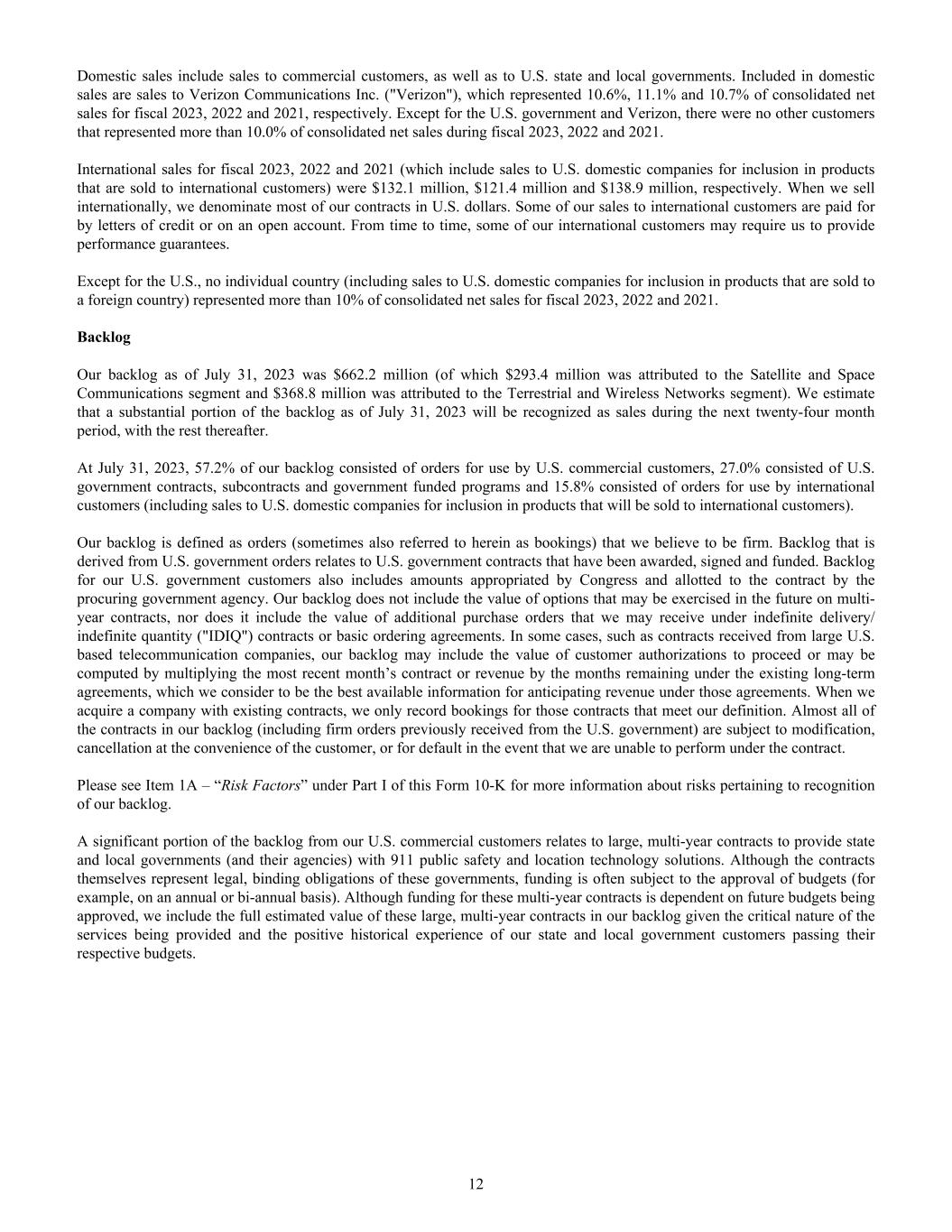
Domestic sales include sales to commercial customers, as well as to U.S. state and local governments. Included in domestic sales are sales to Verizon Communications Inc. ("Verizon"), which represented 10.6%, 11.1% and 10.7% of consolidated net sales for fiscal 2023, 2022 and 2021, respectively. Except for the U.S. government and Verizon, there were no other customers that represented more than 10.0% of consolidated net sales during fiscal 2023, 2022 and 2021. International sales for fiscal 2023, 2022 and 2021 (which include sales to U.S. domestic companies for inclusion in products that are sold to international customers) were $132.1 million, $121.4 million and $138.9 million, respectively. When we sell internationally, we denominate most of our contracts in U.S. dollars. Some of our sales to international customers are paid for by letters of credit or on an open account. From time to time, some of our international customers may require us to provide performance guarantees. Except for the U.S., no individual country (including sales to U.S. domestic companies for inclusion in products that are sold to a foreign country) represented more than 10% of consolidated net sales for fiscal 2023, 2022 and 2021. Backlog Our backlog as of July 31, 2023 was $662.2 million (of which $293.4 million was attributed to the Satellite and Space Communications segment and $368.8 million was attributed to the Terrestrial and Wireless Networks segment). We estimate that a substantial portion of the backlog as of July 31, 2023 will be recognized as sales during the next twenty-four month period, with the rest thereafter. At July 31, 2023, 57.2% of our backlog consisted of orders for use by U.S. commercial customers, 27.0% consisted of U.S. government contracts, subcontracts and government funded programs and 15.8% consisted of orders for use by international customers (including sales to U.S. domestic companies for inclusion in products that will be sold to international customers). Our backlog is defined as orders (sometimes also referred to herein as bookings) that we believe to be firm. Backlog that is derived from U.S. government orders relates to U.S. government contracts that have been awarded, signed and funded. Backlog for our U.S. government customers also includes amounts appropriated by Congress and allotted to the contract by the procuring government agency. Our backlog does not include the value of options that may be exercised in the future on multi- year contracts, nor does it include the value of additional purchase orders that we may receive under indefinite delivery/ indefinite quantity ("IDIQ") contracts or basic ordering agreements. In some cases, such as contracts received from large U.S. based telecommunication companies, our backlog may include the value of customer authorizations to proceed or may be computed by multiplying the most recent month’s contract or revenue by the months remaining under the existing long-term agreements, which we consider to be the best available information for anticipating revenue under those agreements. When we acquire a company with existing contracts, we only record bookings for those contracts that meet our definition. Almost all of the contracts in our backlog (including firm orders previously received from the U.S. government) are subject to modification, cancellation at the convenience of the customer, or for default in the event that we are unable to perform under the contract. Please see Item 1A – “Risk Factors” under Part I of this Form 10-K for more information about risks pertaining to recognition of our backlog. A significant portion of the backlog from our U.S. commercial customers relates to large, multi-year contracts to provide state and local governments (and their agencies) with 911 public safety and location technology solutions. Although the contracts themselves represent legal, binding obligations of these governments, funding is often subject to the approval of budgets (for example, on an annual or bi-annual basis). Although funding for these multi-year contracts is dependent on future budgets being approved, we include the full estimated value of these large, multi-year contracts in our backlog given the critical nature of the services being provided and the positive historical experience of our state and local government customers passing their respective budgets. 12
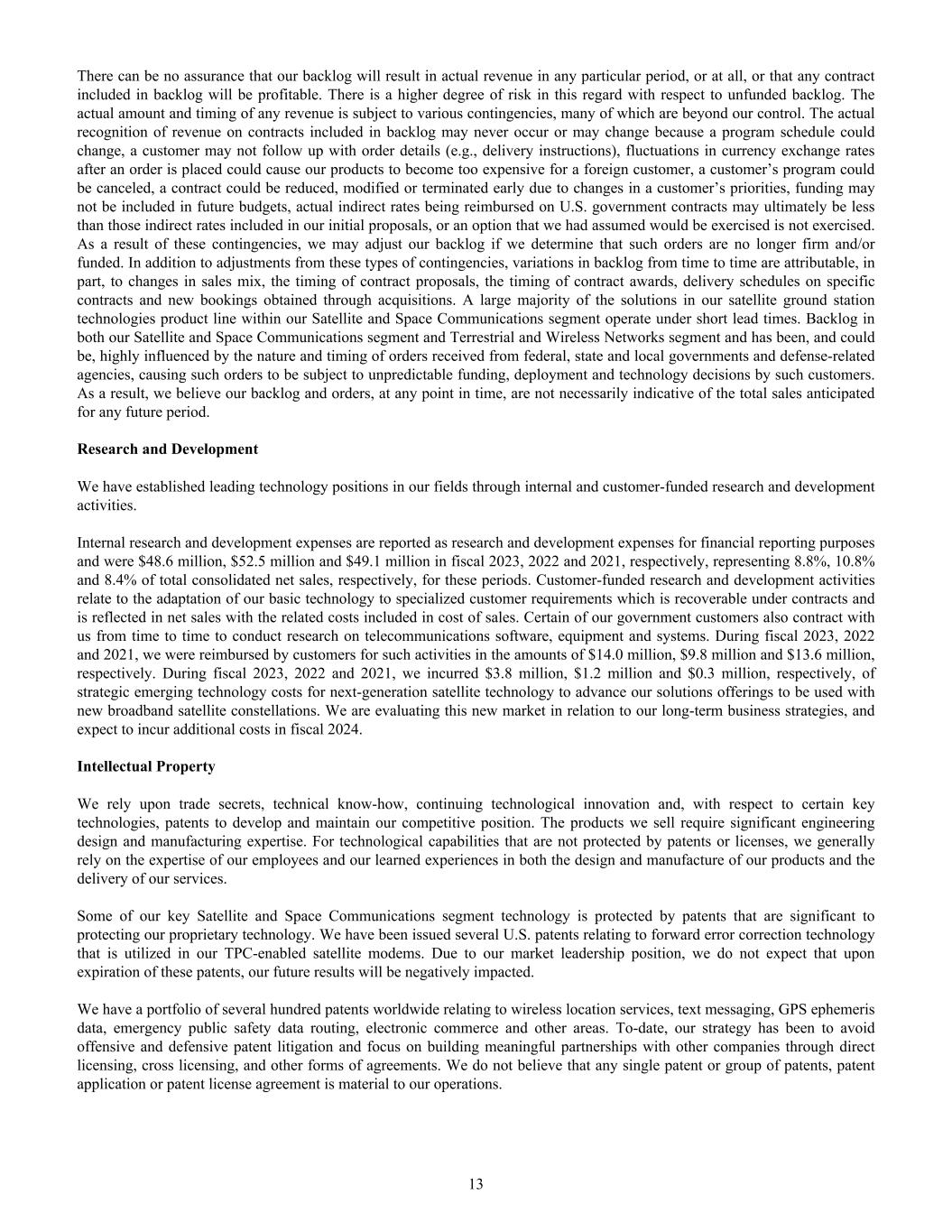
There can be no assurance that our backlog will result in actual revenue in any particular period, or at all, or that any contract included in backlog will be profitable. There is a higher degree of risk in this regard with respect to unfunded backlog. The actual amount and timing of any revenue is subject to various contingencies, many of which are beyond our control. The actual recognition of revenue on contracts included in backlog may never occur or may change because a program schedule could change, a customer may not follow up with order details (e.g., delivery instructions), fluctuations in currency exchange rates after an order is placed could cause our products to become too expensive for a foreign customer, a customer’s program could be canceled, a contract could be reduced, modified or terminated early due to changes in a customer’s priorities, funding may not be included in future budgets, actual indirect rates being reimbursed on U.S. government contracts may ultimately be less than those indirect rates included in our initial proposals, or an option that we had assumed would be exercised is not exercised. As a result of these contingencies, we may adjust our backlog if we determine that such orders are no longer firm and/or funded. In addition to adjustments from these types of contingencies, variations in backlog from time to time are attributable, in part, to changes in sales mix, the timing of contract proposals, the timing of contract awards, delivery schedules on specific contracts and new bookings obtained through acquisitions. A large majority of the solutions in our satellite ground station technologies product line within our Satellite and Space Communications segment operate under short lead times. Backlog in both our Satellite and Space Communications segment and Terrestrial and Wireless Networks segment and has been, and could be, highly influenced by the nature and timing of orders received from federal, state and local governments and defense-related agencies, causing such orders to be subject to unpredictable funding, deployment and technology decisions by such customers. As a result, we believe our backlog and orders, at any point in time, are not necessarily indicative of the total sales anticipated for any future period. Research and Development We have established leading technology positions in our fields through internal and customer-funded research and development activities. Internal research and development expenses are reported as research and development expenses for financial reporting purposes and were $48.6 million, $52.5 million and $49.1 million in fiscal 2023, 2022 and 2021, respectively, representing 8.8%, 10.8% and 8.4% of total consolidated net sales, respectively, for these periods. Customer-funded research and development activities relate to the adaptation of our basic technology to specialized customer requirements which is recoverable under contracts and is reflected in net sales with the related costs included in cost of sales. Certain of our government customers also contract with us from time to time to conduct research on telecommunications software, equipment and systems. During fiscal 2023, 2022 and 2021, we were reimbursed by customers for such activities in the amounts of $14.0 million, $9.8 million and $13.6 million, respectively. During fiscal 2023, 2022 and 2021, we incurred $3.8 million, $1.2 million and $0.3 million, respectively, of strategic emerging technology costs for next-generation satellite technology to advance our solutions offerings to be used with new broadband satellite constellations. We are evaluating this new market in relation to our long-term business strategies, and expect to incur additional costs in fiscal 2024. Intellectual Property We rely upon trade secrets, technical know-how, continuing technological innovation and, with respect to certain key technologies, patents to develop and maintain our competitive position. The products we sell require significant engineering design and manufacturing expertise. For technological capabilities that are not protected by patents or licenses, we generally rely on the expertise of our employees and our learned experiences in both the design and manufacture of our products and the delivery of our services. Some of our key Satellite and Space Communications segment technology is protected by patents that are significant to protecting our proprietary technology. We have been issued several U.S. patents relating to forward error correction technology that is utilized in our TPC-enabled satellite modems. Due to our market leadership position, we do not expect that upon expiration of these patents, our future results will be negatively impacted. We have a portfolio of several hundred patents worldwide relating to wireless location services, text messaging, GPS ephemeris data, emergency public safety data routing, electronic commerce and other areas. To-date, our strategy has been to avoid offensive and defensive patent litigation and focus on building meaningful partnerships with other companies through direct licensing, cross licensing, and other forms of agreements. We do not believe that any single patent or group of patents, patent application or patent license agreement is material to our operations. 13
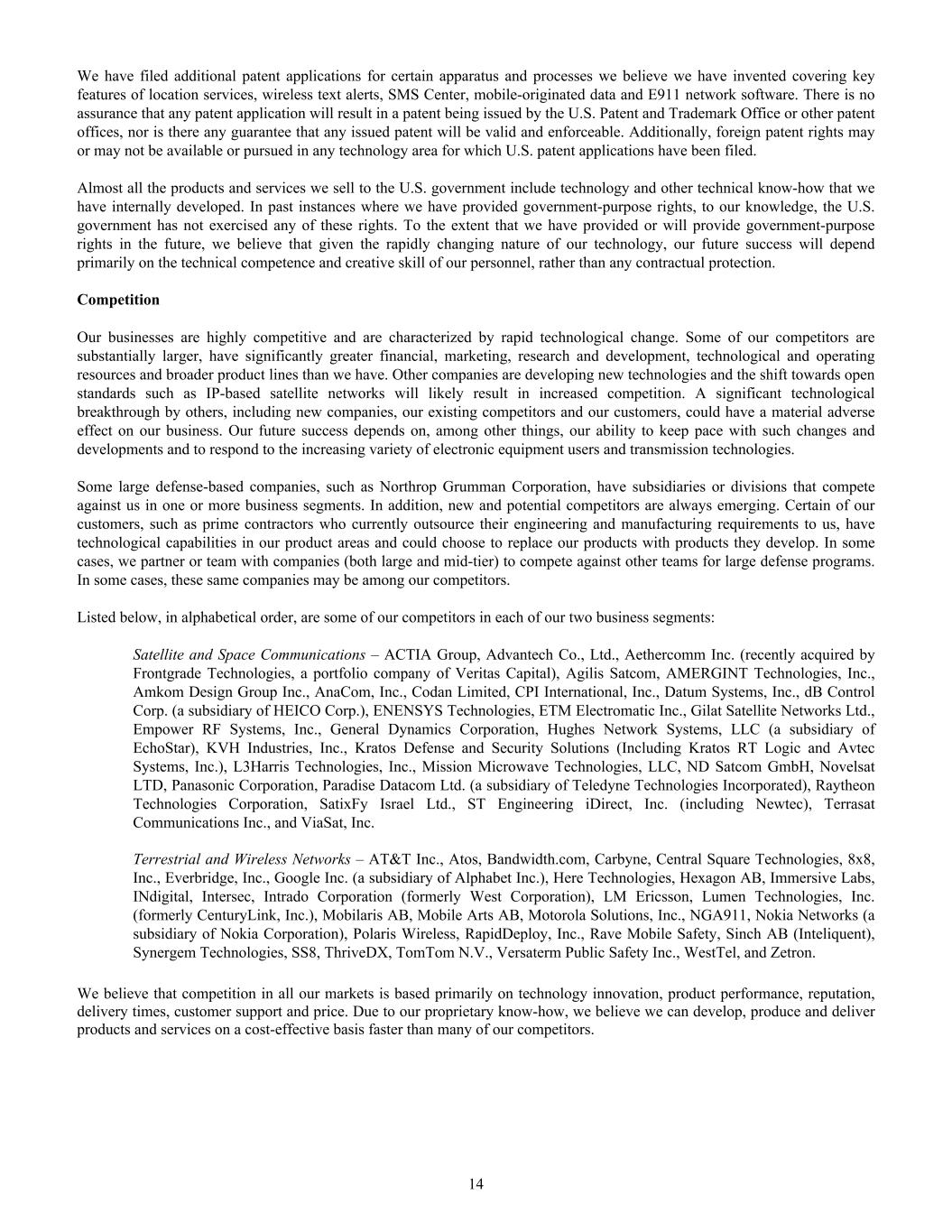
We have filed additional patent applications for certain apparatus and processes we believe we have invented covering key features of location services, wireless text alerts, SMS Center, mobile-originated data and E911 network software. There is no assurance that any patent application will result in a patent being issued by the U.S. Patent and Trademark Office or other patent offices, nor is there any guarantee that any issued patent will be valid and enforceable. Additionally, foreign patent rights may or may not be available or pursued in any technology area for which U.S. patent applications have been filed. Almost all the products and services we sell to the U.S. government include technology and other technical know-how that we have internally developed. In past instances where we have provided government-purpose rights, to our knowledge, the U.S. government has not exercised any of these rights. To the extent that we have provided or will provide government-purpose rights in the future, we believe that given the rapidly changing nature of our technology, our future success will depend primarily on the technical competence and creative skill of our personnel, rather than any contractual protection. Competition Our businesses are highly competitive and are characterized by rapid technological change. Some of our competitors are substantially larger, have significantly greater financial, marketing, research and development, technological and operating resources and broader product lines than we have. Other companies are developing new technologies and the shift towards open standards such as IP-based satellite networks will likely result in increased competition. A significant technological breakthrough by others, including new companies, our existing competitors and our customers, could have a material adverse effect on our business. Our future success depends on, among other things, our ability to keep pace with such changes and developments and to respond to the increasing variety of electronic equipment users and transmission technologies. Some large defense-based companies, such as Northrop Grumman Corporation, have subsidiaries or divisions that compete against us in one or more business segments. In addition, new and potential competitors are always emerging. Certain of our customers, such as prime contractors who currently outsource their engineering and manufacturing requirements to us, have technological capabilities in our product areas and could choose to replace our products with products they develop. In some cases, we partner or team with companies (both large and mid-tier) to compete against other teams for large defense programs. In some cases, these same companies may be among our competitors. Listed below, in alphabetical order, are some of our competitors in each of our two business segments: Satellite and Space Communications – ACTIA Group, Advantech Co., Ltd., Aethercomm Inc. (recently acquired by Frontgrade Technologies, a portfolio company of Veritas Capital), Agilis Satcom, AMERGINT Technologies, Inc., Amkom Design Group Inc., AnaCom, Inc., Codan Limited, CPI International, Inc., Datum Systems, Inc., dB Control Corp. (a subsidiary of HEICO Corp.), ENENSYS Technologies, ETM Electromatic Inc., Gilat Satellite Networks Ltd., Empower RF Systems, Inc., General Dynamics Corporation, Hughes Network Systems, LLC (a subsidiary of EchoStar), KVH Industries, Inc., Kratos Defense and Security Solutions (Including Kratos RT Logic and Avtec Systems, Inc.), L3Harris Technologies, Inc., Mission Microwave Technologies, LLC, ND Satcom GmbH, Novelsat LTD, Panasonic Corporation, Paradise Datacom Ltd. (a subsidiary of Teledyne Technologies Incorporated), Raytheon Technologies Corporation, SatixFy Israel Ltd., ST Engineering iDirect, Inc. (including Newtec), Terrasat Communications Inc., and ViaSat, Inc. Terrestrial and Wireless Networks – AT&T Inc., Atos, Bandwidth.com, Carbyne, Central Square Technologies, 8x8, Inc., Everbridge, Inc., Google Inc. (a subsidiary of Alphabet Inc.), Here Technologies, Hexagon AB, Immersive Labs, INdigital, Intersec, Intrado Corporation (formerly West Corporation), LM Ericsson, Lumen Technologies, Inc. (formerly CenturyLink, Inc.), Mobilaris AB, Mobile Arts AB, Motorola Solutions, Inc., NGA911, Nokia Networks (a subsidiary of Nokia Corporation), Polaris Wireless, RapidDeploy, Inc., Rave Mobile Safety, Sinch AB (Inteliquent), Synergem Technologies, SS8, ThriveDX, TomTom N.V., Versaterm Public Safety Inc., WestTel, and Zetron. We believe that competition in all our markets is based primarily on technology innovation, product performance, reputation, delivery times, customer support and price. Due to our proprietary know-how, we believe we can develop, produce and deliver products and services on a cost-effective basis faster than many of our competitors. 14

Corporate Responsibility and Sustainability We recognize the need for driving corporate responsibility within our organization, throughout our supplier network and in our communities. To drive this responsibility, we will continue to target effective corporate governance, ethical behavior in the workplace and social responsibility, while also updating and enhancing this focus with initiatives, such as: • refreshing the roles and responsibilities of the committees of our Board of Directors, including with the establishment of an Environment, Social and Governance ("ESG") task force supervised by our Board of Directors, • developing a company-wide People Strategy to foster and promote workplace talent and diversity, and • organizing a company-wide strategic sourcing group that will be accountable for tracking and driving resource reduction targets, such as resource-efficient manufacturing, reduction of hazardous substances, and take-back, recycling and reuse of products. Human Capital Our employees are one of our most valuable assets and we believe our success depends on the talent we attract and retain, which is why we make our People Strategy one of our top priorities. We are passionate about building meaningful employee engagement and happiness through a variety of programs, initiatives, and other opportunities that are addressed in our People Strategy. As part of this strategy, we are providing a foundation for a diverse, inclusive and equitable workplace where employees feel they belong, their views are valued, and they are empowered to pursue opportunities they are passionate about. Our People Strategy is also focused on developing and promoting talent; supporting a competitive benefits program; and emphasizing the importance of our employees’ health, safety and wellness. Diversity, Equity, Inclusion and Belonging We believe a diverse, equitable, inclusive workplace is central to our ability to innovate and deliver substantial value for our customers as well as contribute to our future growth and continued success. We encourage employees to be inspired and strive for them to feel like they belong which is communicated through blogs, internal messages, activities, engagement opportunities, and other employee participation initiatives featured on our redesigned company-wide Intranet. We focus on expanding our diverse workforce by reaching out to institutions promoting the employment of minorities; attending recruiting events aimed at attracting talent of diverse heritage and veteran backgrounds; and considering diversity of our workforce during our talent, promotion, and succession planning. Through these and other efforts, during fiscal 2023, we successfully launched The Exchange program, which brings women of all ages together to spark new ideas, inspire the next generation of women leaders, and create opportunities for current leaders to learn from future leaders. Our leadership team also identified several company-wide diversity initiatives such as celebrating Black History Month. One of our key efforts during Black History Month was implementing the first annual Black History Month webinar series, which featured discussions from a diverse set of renowned African American leaders. In addition, we have placed an emphasis on celebrating and recognizing other diversity observances including Asian American Pacific Islander Heritage Month, International Women’s Day, Breast Cancer Awareness Month and Pride Month, among others. Beyond our internal messages and educational efforts, we encouraged employees and their families to participate, celebrate, and showcase their views, culture, and history by sharing their stories and inspirations on our social media channels and our company-wide Intranet. For our Veterans, we celebrated “Honor Week” by recognizing each of the armed forces through various engagement activities. Among other fiscal 2023 highlights, we launched an annual employee recognition program, which included our “Above and Beyond” award. This employee recognition program aims to showcase and celebrate our employees’ volunteerism within their communities and award them for their outstanding efforts. To unify the enterprise and showcase our diverse cultures, we also created a company-wide cookbook highlighting family recipes from employees around the globe. Ultimately, when unique stories are celebrated, employees feel connected in meaningful ways and support each other, which can help enhance our company culture and encourage employees to reach their full potential. Employee Workforce as of July 31, 2023 Women People of Color Veterans People with Disabilities 22% 38%* 10% 5% *People of Color include employees who identify with any race other than white. 15
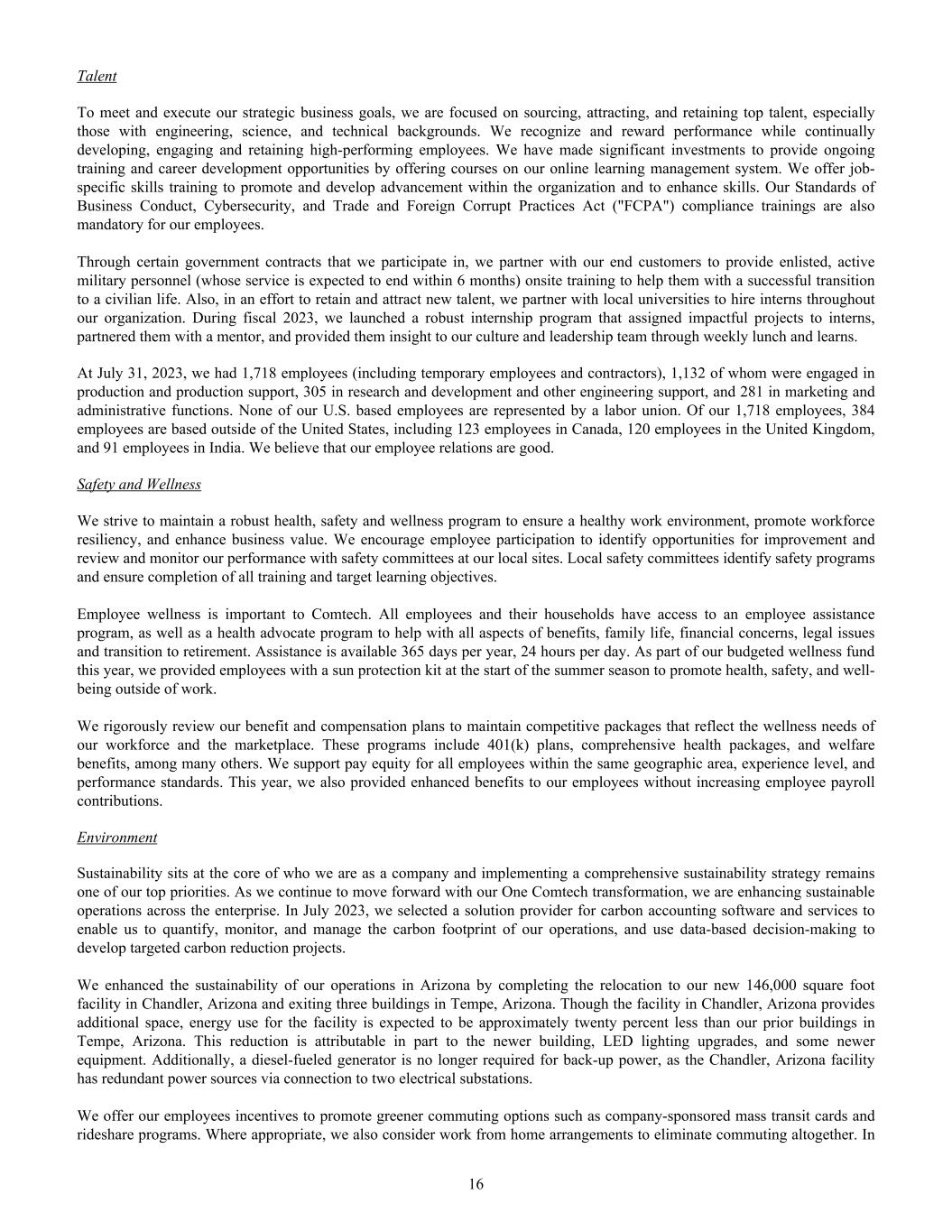
Talent To meet and execute our strategic business goals, we are focused on sourcing, attracting, and retaining top talent, especially those with engineering, science, and technical backgrounds. We recognize and reward performance while continually developing, engaging and retaining high-performing employees. We have made significant investments to provide ongoing training and career development opportunities by offering courses on our online learning management system. We offer job- specific skills training to promote and develop advancement within the organization and to enhance skills. Our Standards of Business Conduct, Cybersecurity, and Trade and Foreign Corrupt Practices Act ("FCPA") compliance trainings are also mandatory for our employees. Through certain government contracts that we participate in, we partner with our end customers to provide enlisted, active military personnel (whose service is expected to end within 6 months) onsite training to help them with a successful transition to a civilian life. Also, in an effort to retain and attract new talent, we partner with local universities to hire interns throughout our organization. During fiscal 2023, we launched a robust internship program that assigned impactful projects to interns, partnered them with a mentor, and provided them insight to our culture and leadership team through weekly lunch and learns. At July 31, 2023, we had 1,718 employees (including temporary employees and contractors), 1,132 of whom were engaged in production and production support, 305 in research and development and other engineering support, and 281 in marketing and administrative functions. None of our U.S. based employees are represented by a labor union. Of our 1,718 employees, 384 employees are based outside of the United States, including 123 employees in Canada, 120 employees in the United Kingdom, and 91 employees in India. We believe that our employee relations are good. Safety and Wellness We strive to maintain a robust health, safety and wellness program to ensure a healthy work environment, promote workforce resiliency, and enhance business value. We encourage employee participation to identify opportunities for improvement and review and monitor our performance with safety committees at our local sites. Local safety committees identify safety programs and ensure completion of all training and target learning objectives. Employee wellness is important to Comtech. All employees and their households have access to an employee assistance program, as well as a health advocate program to help with all aspects of benefits, family life, financial concerns, legal issues and transition to retirement. Assistance is available 365 days per year, 24 hours per day. As part of our budgeted wellness fund this year, we provided employees with a sun protection kit at the start of the summer season to promote health, safety, and well- being outside of work. We rigorously review our benefit and compensation plans to maintain competitive packages that reflect the wellness needs of our workforce and the marketplace. These programs include 401(k) plans, comprehensive health packages, and welfare benefits, among many others. We support pay equity for all employees within the same geographic area, experience level, and performance standards. This year, we also provided enhanced benefits to our employees without increasing employee payroll contributions. Environment Sustainability sits at the core of who we are as a company and implementing a comprehensive sustainability strategy remains one of our top priorities. As we continue to move forward with our One Comtech transformation, we are enhancing sustainable operations across the enterprise. In July 2023, we selected a solution provider for carbon accounting software and services to enable us to quantify, monitor, and manage the carbon footprint of our operations, and use data-based decision-making to develop targeted carbon reduction projects. We enhanced the sustainability of our operations in Arizona by completing the relocation to our new 146,000 square foot facility in Chandler, Arizona and exiting three buildings in Tempe, Arizona. Though the facility in Chandler, Arizona provides additional space, energy use for the facility is expected to be approximately twenty percent less than our prior buildings in Tempe, Arizona. This reduction is attributable in part to the newer building, LED lighting upgrades, and some newer equipment. Additionally, a diesel-fueled generator is no longer required for back-up power, as the Chandler, Arizona facility has redundant power sources via connection to two electrical substations. We offer our employees incentives to promote greener commuting options such as company-sponsored mass transit cards and rideshare programs. Where appropriate, we also consider work from home arrangements to eliminate commuting altogether. In 16

fiscal 2023, we celebrated Earth Day in our company by encouraging our global employees to participate in environmentally- focused initiatives and then share their activities on social media. We are developing a company-wide Environmental, Health, and Safety ("EHS") Management System to foster a culture of continuous improvement and to engage employees at all levels of the organization in the prevention of work-related injuries and illnesses, and minimization of environmental impacts. We are committed to providing a workplace which values the health, safety, and well-being of our employees, contractors, and visitors to our facilities. U.S. Government Contracts and Security Clearances The U.S. government operates on an October-to-September fiscal year. Generally, in February of each year, the President of the United States presents to the U.S. Congress ("Congress") the proposed budget for the upcoming fiscal year and from February through September of each year, the appropriations and authorization committees of Congress review the President’s budget proposals and establish the funding levels for the upcoming fiscal year. Once these levels are enacted into law, the Executive Office of the President administers the funds to the agencies. Thereafter, we can receive orders pursuant to sole-source or competitively awarded contracts, which we describe below. The U.S. government may be unable to complete its budget process before the end of any given government fiscal year and when the fiscal budget is not approved in a timely manner, the U.S. government is required either to shut down or be funded pursuant to a "continuing resolution" that authorizes agencies of the U.S. government to continue operations but does not authorize new spending initiatives, either of which could result in reduced or delayed orders or payments for products and services we provide. Sole-source contracts are generally awarded to a single contractor without a formal competition when a single contractor is deemed to have an expertise or technology superior to that of competing contractors or when there is an urgent need by the U.S. government that cannot wait for a full competitive process. Potential suppliers compete informally through research and development and marketing efforts. Competitively-bid contracts are awarded based on a formal proposal evaluation established by the procuring agency and interested contractors prepare bids. Competitively-bid contracts are awarded after a formal bid and proposal competition among suppliers. The U.S. government has a stated policy direction to reduce the number of sole-source contract awards across all procuring agencies. In addition, the U.S. government is increasing the use of multiple-award IDIQ contracts to increase its procurement options. IDIQ contracts allow the U.S. government to select a group of eligible contractors for the same program. When the government awards IDIQ contracts to multiple bidders under the same program, a company that has already competed to be selected as a participant in the program must subsequently compete for individual delivery orders. As a result of this U.S. government shift toward multiple award IDIQ contracts, we expect to face greater competition for future U.S. government contracts and, at the same time, greater opportunities for us to participate in program areas that we do not currently participate in. As a U.S. government contractor and subcontractor, we are subject to a variety of rules and regulations, such as the Federal Acquisition Regulations ("FAR"). Individual agencies can also have acquisition regulations. For example, the DoD implements the FAR through the Defense Federal Acquisition Regulation supplement (commonly known as "DFARs"). For all Federal government entities, the FAR regulates the phases of any product or service acquisition, including: acquisition planning, competition requirements, contractor qualifications, protection of source selection and vendor information, and acquisition procedures. In addition, the FAR addresses the allowability of supplier costs, while Cost Accounting Standards address how those costs can be allocated to contracts. The FAR also subjects suppliers to audits and other government reviews. These reviews cover issues such as cost, performance and accounting practices relating to our contracts. The government may challenge a supplier's costs and fees. Suppliers are also required to comply with the National Industrial Security Program Operating Manual which relates to the handling of classified materials and programs and is administered by the Defense Counterintelligence and Security Agency (“DCSA”). Suppliers who do not comply with these various regulations may lose and/ or become ineligible for facility security clearances and/or participation in classified programs. Under firm fixed-price contracts, we perform for an agreed-upon price and we can derive benefits from cost savings, but bear the risk of cost overruns. Our cost-reimbursable type contracts typically provide for reimbursement of allowable costs incurred plus a negotiated fee. Cost-plus-incentive-fee orders typically provide for sharing with the U.S. government savings accrued from orders performed for less than the target costs and costs incurred in excess of targets up to a negotiated ceiling price (which is higher than the target cost), and for the supplier to carry the entire burden of costs exceeding the negotiated ceiling price. 17

In fiscal 2023, $172.0 million or 31.3% of our consolidated net sales were to the U.S. government (including sales to prime contractors to the U.S. government). Of this amount, firm fixed-price and cost-reimbursable type contracts (including fixed-fee, incentive-fee and time and material type contracts) accounted for approximately $126.0 million and $46.0 million, respectively. Regulatory Matters In addition to the rules and regulations that pertain to us as a U.S. government contractor and subcontractor, we are also subject to a variety of local, state and federal governmental regulations. Our products that are incorporated into wireless communications systems must comply with various government regulations, including those of the FCC. Our manufacturing facilities, which may store, handle, emit, generate and dispose of hazardous substances that are used in the manufacture of our products, are subject to a variety of local, state and federal regulations, including those issued by the Environmental Protection Agency. Our products are also subject to European Union directives related to the recycling of electrical and electronic equipment. Our international sales are subject to U.S. and foreign regulations such as the Arms Export Control Act, the International Emergency Economic Powers Act ("IEEPA"), the International Traffic in Arms Regulations ("ITAR"), the Export Administration Regulations ("EAR") and the trade sanctions laws and regulations administered by the U.S. Department of the Treasury’s Office of Foreign Assets Control ("OFAC"), the Department of Commerce ("DoC") as well as other applicable laws relating to trade, export controls and foreign corrupt practices, the violation of which could adversely affect our operations. We must comply with all applicable export control laws and regulations of the U.S. and other countries. Certain of our products and systems may require licenses from U.S. government agencies for export from the U.S., and some of our products are not permitted to be exported. We cannot be certain that we will be able to obtain necessary export licenses, and such failure would materially adversely affect our operations. If we are unable to receive appropriate export authorizations in the future, we may be prohibited from selling our products and services internationally, which may limit our sales and have a material adverse effect on our business, results of operations and financial condition. In addition, in certain cases, U.S. export controls also severely limit unlicensed technical discussions, such as discussions with any persons who are not U.S. citizens or permanent residents. As a result, in cases where we may need an export license, our ability to compete against a non-U.S. domiciled foreign company that may not be subject to the same U.S. laws may be materially adversely affected. In addition, we are subject to the FCPA and other local laws that generally bar bribes or unreasonable gifts to foreign governments or officials. Violations of these laws or regulations could result in significant sanctions, including disgorgement of profits, fines, and criminal sanctions against us, our officers, our directors, or our employees, more onerous compliance requirements, more extensive debarments from export privileges or loss of authorizations needed to conduct aspects of our international business. A violation of any of the regulations enumerated above could materially adversely affect our business, financial condition and results of operations. Additionally, changes in regulatory requirements could further restrict our ability to deliver services to our international customers, including the addition of a country to the list of sanctioned countries under the IEEPA or similar legislation could negatively impact our business. In the past, we have self-reported violations of export control laws or regulations to the U.S. Department of State, Directorate of Defense Trade Controls ("DDTC"), DoC and OFAC. In addition, we have made various commitments to U.S. government agencies that oversee trade and export matters that we will maintain certain policies and procedures including maintaining a company-wide Office of Trade Compliance and conducting ongoing internal assessments and reporting any future violations to those agencies. Our financial reporting, corporate governance, public disclosure and compliance practices are governed by laws such as the Sarbanes-Oxley Act of 2002, Dodd-Frank Act of 2010, and rules and regulations issued by the SEC. The SEC has adopted rules which require, among other things, public companies to conduct certain inquiries to determine whether or not Conflict Minerals (as that term is defined in the SEC rules) that are necessary to the functionality of their manufactured products or their product's production processes originated in a Covered Country (as that term is defined in the SEC rules) and ultimately file a report with the SEC. Conflict Minerals are widely used in many industries, including the telecommunications industry and almost all of our products include component parts purchased from third-party suppliers and we must rely heavily on information received from suppliers to determine the origin of those materials. We have implemented a due diligence program consistent with the Organization for Economic Co-operation and Development guidelines to collect information concerning the country of origin of Conflict Minerals and in that regard, have adopted a policy that requires our suppliers (both public and private) to commit to a code of conduct relating to the responsible sourcing of minerals and to establish a policy to reasonably assure that the products they manufacture do not contain Conflict Minerals that originated in a Covered Country. Efforts to comply with this SEC rule have resulted in additional costs to us and, we believe, to our suppliers. As such, the availability of raw materials used 18
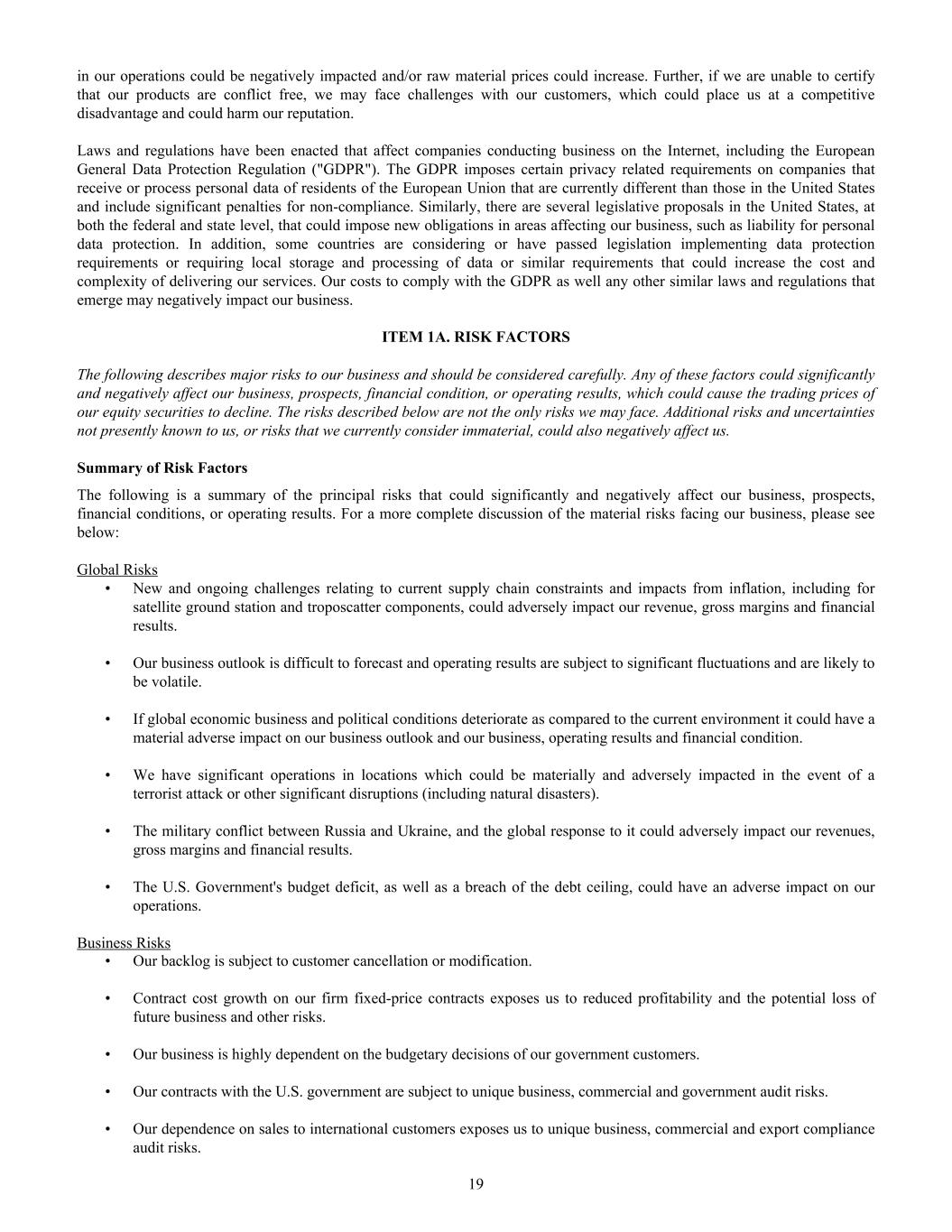
in our operations could be negatively impacted and/or raw material prices could increase. Further, if we are unable to certify that our products are conflict free, we may face challenges with our customers, which could place us at a competitive disadvantage and could harm our reputation. Laws and regulations have been enacted that affect companies conducting business on the Internet, including the European General Data Protection Regulation ("GDPR"). The GDPR imposes certain privacy related requirements on companies that receive or process personal data of residents of the European Union that are currently different than those in the United States and include significant penalties for non-compliance. Similarly, there are several legislative proposals in the United States, at both the federal and state level, that could impose new obligations in areas affecting our business, such as liability for personal data protection. In addition, some countries are considering or have passed legislation implementing data protection requirements or requiring local storage and processing of data or similar requirements that could increase the cost and complexity of delivering our services. Our costs to comply with the GDPR as well any other similar laws and regulations that emerge may negatively impact our business. ITEM 1A. RISK FACTORS The following describes major risks to our business and should be considered carefully. Any of these factors could significantly and negatively affect our business, prospects, financial condition, or operating results, which could cause the trading prices of our equity securities to decline. The risks described below are not the only risks we may face. Additional risks and uncertainties not presently known to us, or risks that we currently consider immaterial, could also negatively affect us. Summary of Risk Factors The following is a summary of the principal risks that could significantly and negatively affect our business, prospects, financial conditions, or operating results. For a more complete discussion of the material risks facing our business, please see below: Global Risks • New and ongoing challenges relating to current supply chain constraints and impacts from inflation, including for satellite ground station and troposcatter components, could adversely impact our revenue, gross margins and financial results. • Our business outlook is difficult to forecast and operating results are subject to significant fluctuations and are likely to be volatile. • If global economic business and political conditions deteriorate as compared to the current environment it could have a material adverse impact on our business outlook and our business, operating results and financial condition. • We have significant operations in locations which could be materially and adversely impacted in the event of a terrorist attack or other significant disruptions (including natural disasters). • The military conflict between Russia and Ukraine, and the global response to it could adversely impact our revenues, gross margins and financial results. • The U.S. Government's budget deficit, as well as a breach of the debt ceiling, could have an adverse impact on our operations. Business Risks • Our backlog is subject to customer cancellation or modification. • Contract cost growth on our firm fixed-price contracts exposes us to reduced profitability and the potential loss of future business and other risks. • Our business is highly dependent on the budgetary decisions of our government customers. • Our contracts with the U.S. government are subject to unique business, commercial and government audit risks. • Our dependence on sales to international customers exposes us to unique business, commercial and export compliance audit risks. 19
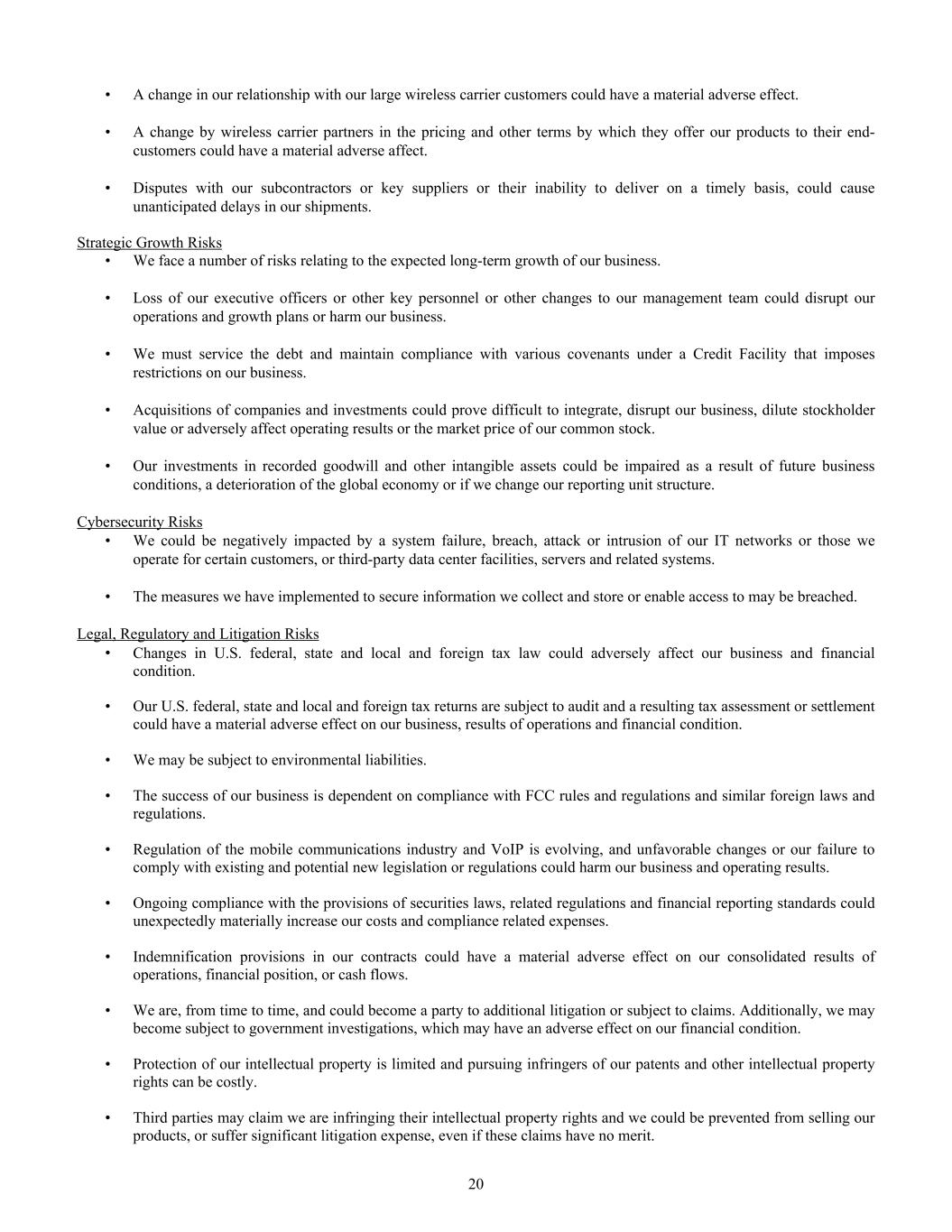
• A change in our relationship with our large wireless carrier customers could have a material adverse effect. • A change by wireless carrier partners in the pricing and other terms by which they offer our products to their end- customers could have a material adverse affect. • Disputes with our subcontractors or key suppliers or their inability to deliver on a timely basis, could cause unanticipated delays in our shipments. Strategic Growth Risks • We face a number of risks relating to the expected long-term growth of our business. • Loss of our executive officers or other key personnel or other changes to our management team could disrupt our operations and growth plans or harm our business. • We must service the debt and maintain compliance with various covenants under a Credit Facility that imposes restrictions on our business. • Acquisitions of companies and investments could prove difficult to integrate, disrupt our business, dilute stockholder value or adversely affect operating results or the market price of our common stock. • Our investments in recorded goodwill and other intangible assets could be impaired as a result of future business conditions, a deterioration of the global economy or if we change our reporting unit structure. Cybersecurity Risks • We could be negatively impacted by a system failure, breach, attack or intrusion of our IT networks or those we operate for certain customers, or third-party data center facilities, servers and related systems. • The measures we have implemented to secure information we collect and store or enable access to may be breached. Legal, Regulatory and Litigation Risks • Changes in U.S. federal, state and local and foreign tax law could adversely affect our business and financial condition. • Our U.S. federal, state and local and foreign tax returns are subject to audit and a resulting tax assessment or settlement could have a material adverse effect on our business, results of operations and financial condition. • We may be subject to environmental liabilities. • The success of our business is dependent on compliance with FCC rules and regulations and similar foreign laws and regulations. • Regulation of the mobile communications industry and VoIP is evolving, and unfavorable changes or our failure to comply with existing and potential new legislation or regulations could harm our business and operating results. • Ongoing compliance with the provisions of securities laws, related regulations and financial reporting standards could unexpectedly materially increase our costs and compliance related expenses. • Indemnification provisions in our contracts could have a material adverse effect on our consolidated results of operations, financial position, or cash flows. • We are, from time to time, and could become a party to additional litigation or subject to claims. Additionally, we may become subject to government investigations, which may have an adverse effect on our financial condition. • Protection of our intellectual property is limited and pursuing infringers of our patents and other intellectual property rights can be costly. • Third parties may claim we are infringing their intellectual property rights and we could be prevented from selling our products, or suffer significant litigation expense, even if these claims have no merit. 20
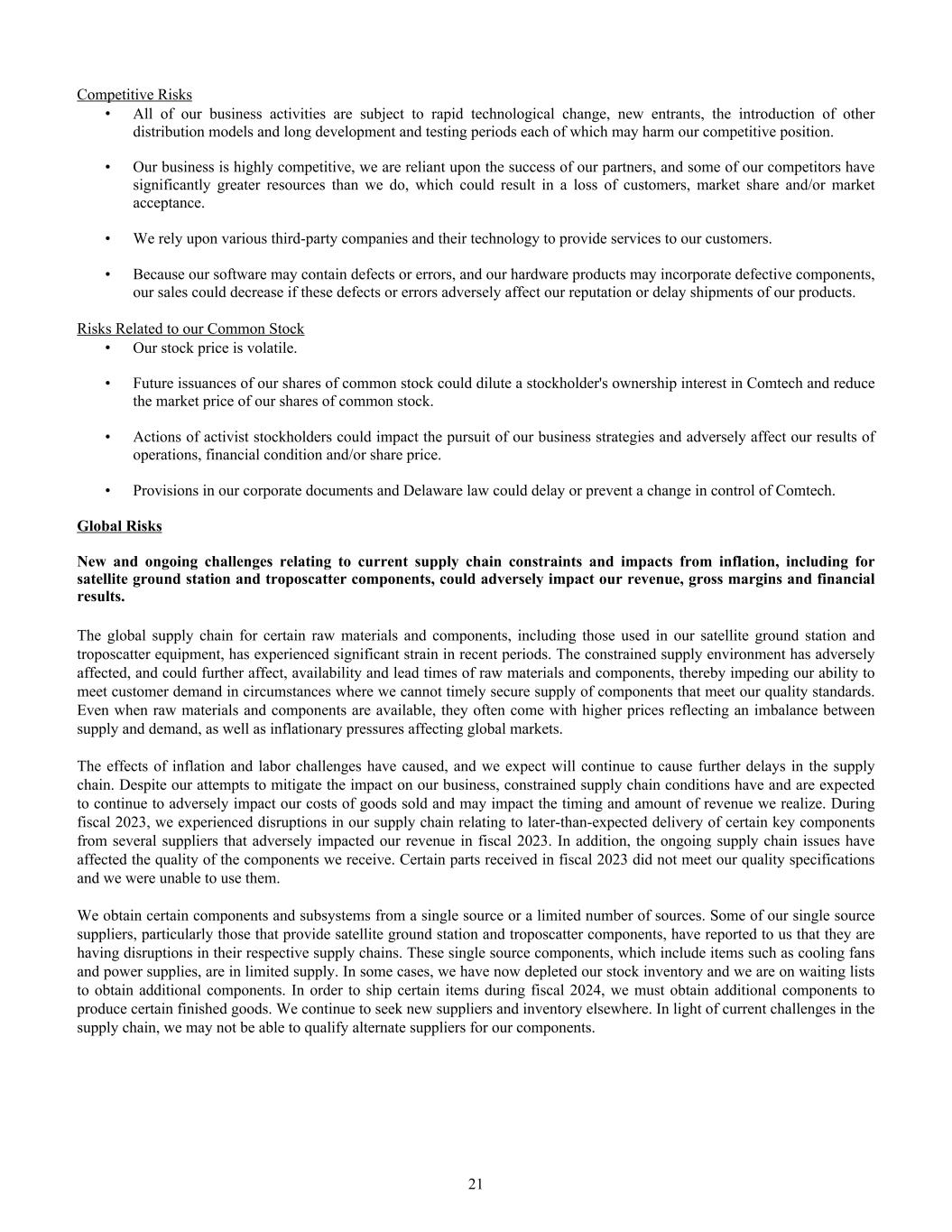
Competitive Risks • All of our business activities are subject to rapid technological change, new entrants, the introduction of other distribution models and long development and testing periods each of which may harm our competitive position. • Our business is highly competitive, we are reliant upon the success of our partners, and some of our competitors have significantly greater resources than we do, which could result in a loss of customers, market share and/or market acceptance. • We rely upon various third-party companies and their technology to provide services to our customers. • Because our software may contain defects or errors, and our hardware products may incorporate defective components, our sales could decrease if these defects or errors adversely affect our reputation or delay shipments of our products. Risks Related to our Common Stock • Our stock price is volatile. • Future issuances of our shares of common stock could dilute a stockholder's ownership interest in Comtech and reduce the market price of our shares of common stock. • Actions of activist stockholders could impact the pursuit of our business strategies and adversely affect our results of operations, financial condition and/or share price. • Provisions in our corporate documents and Delaware law could delay or prevent a change in control of Comtech. Global Risks New and ongoing challenges relating to current supply chain constraints and impacts from inflation, including for satellite ground station and troposcatter components, could adversely impact our revenue, gross margins and financial results. The global supply chain for certain raw materials and components, including those used in our satellite ground station and troposcatter equipment, has experienced significant strain in recent periods. The constrained supply environment has adversely affected, and could further affect, availability and lead times of raw materials and components, thereby impeding our ability to meet customer demand in circumstances where we cannot timely secure supply of components that meet our quality standards. Even when raw materials and components are available, they often come with higher prices reflecting an imbalance between supply and demand, as well as inflationary pressures affecting global markets. The effects of inflation and labor challenges have caused, and we expect will continue to cause further delays in the supply chain. Despite our attempts to mitigate the impact on our business, constrained supply chain conditions have and are expected to continue to adversely impact our costs of goods sold and may impact the timing and amount of revenue we realize. During fiscal 2023, we experienced disruptions in our supply chain relating to later-than-expected delivery of certain key components from several suppliers that adversely impacted our revenue in fiscal 2023. In addition, the ongoing supply chain issues have affected the quality of the components we receive. Certain parts received in fiscal 2023 did not meet our quality specifications and we were unable to use them. We obtain certain components and subsystems from a single source or a limited number of sources. Some of our single source suppliers, particularly those that provide satellite ground station and troposcatter components, have reported to us that they are having disruptions in their respective supply chains. These single source components, which include items such as cooling fans and power supplies, are in limited supply. In some cases, we have now depleted our stock inventory and we are on waiting lists to obtain additional components. In order to ship certain items during fiscal 2024, we must obtain additional components to produce certain finished goods. We continue to seek new suppliers and inventory elsewhere. In light of current challenges in the supply chain, we may not be able to qualify alternate suppliers for our components. 21

Heading into our fiscal 2024, we have a significant portion of our targeted revenues in our backlog. However, if shipments from our backlog are delayed or we are unable to obtain expected orders or components, our business outlook will prove to be inaccurate. These aforementioned supply chain constraints, and their related challenges could result in future shortages, increased material costs or use of cash, engineering design changes, and delays in new product introductions, each of which could adversely impact our revenue, gross margins and financial results. There can be no assurance that the impacts of all the aforementioned conditions will not continue, or worsen, in the future. Our business outlook is difficult to forecast and operating results are subject to significant fluctuations and are likely to be volatile. Historically, our business outlook is difficult to forecast and backlog (sometimes referred to herein as orders or bookings), net sales and operating results may vary significantly from period to period due to a number of factors including: sales mix; fluctuating market demand; start-up costs associated with the opening of our two new high-volume technology manufacturing centers; price competition; new product introductions by us or our competitors; customer bankruptcies; changing customer partnering procurement strategies; fluctuations in foreign currency exchange rates; unexpected changes in the timing of delivery of components or subsystems; the financial performance and impact of acquisitions; new accounting standards; political instability; regulatory developments; changes in income tax rates or tax credits; the price and expected volatility of our stock (which will impact, among other items, the amount of stock-based compensation expense we may record); general global economic conditions, and the impact of natural disasters or global pandemics, such as the COVID-19 pandemic. We have experienced, and will experience in the future, significant fluctuations in bookings, net sales and operating results from period to period. For example, a sudden change in global economic or political conditions could have an immediate impact on a large portion of our net sales, a large amount of which are derived from products such as satellite ground station technologies, amplifier products and mission-critical technologies that generally have short order and lead times. Similarly, sales of certain of our public safety and location technologies are subject to sudden changes in wireless carrier procurement strategies, including decisions to sole-source such solutions or to perform such solutions internally. As a result, bookings and backlog related to these solutions are extremely sensitive to short-term fluctuations in customer demand. In addition, a large portion of our consolidated net sales are derived in part from large U.S. federal and state government programs or large foreign government opportunities that are subject to lengthy sales cycles (including funding requirements) and are therefore difficult to predict. If global economic business and political conditions deteriorate as compared to the current environment it could have an adverse impact on our business outlook and our business, operating results and financial condition. Many of the end-markets for our products and services may be significantly impacted for other issues that result in adverse global economic conditions. For example, many of our international end-customers are in emerging and developing countries that are subject to sweeping economic and political changes. Many governments around the world are under pressure to reduce their spending. In recent years, global oil and natural gas prices have been volatile and have significantly impaired the ability of certain of our government customers in the oil and gas producing regions of the world to invest in telecommunications products and infrastructure. Additionally, from time to time, the relative strength of the U.S. dollar against many international currencies has negatively impacted the purchasing power for many of our international end-customers because most of our sales are denominated in U.S. dollars. We generate significant sales from many emerging and developing countries and any such reduced purchasing power of our customers could adversely impact our sales and backlog. If credit in financial markets outside of the U.S. remains difficult to obtain, our international customers and suppliers may find it difficult to obtain financing, which could result in a decrease in or cancellation of orders for our products and increased transaction costs (e.g., insurance, performance bonds). Volatility of financing conditions may cause our customers to be reluctant to spend funds required to purchase our equipment and could cause their projects to be postponed or canceled. In addition, if an adverse economic environment and lack of financing results in insolvencies for our customers, it would adversely impact the recoverability of our accounts receivable and/or inventories which would, in turn, adversely impact our results of operations. 22
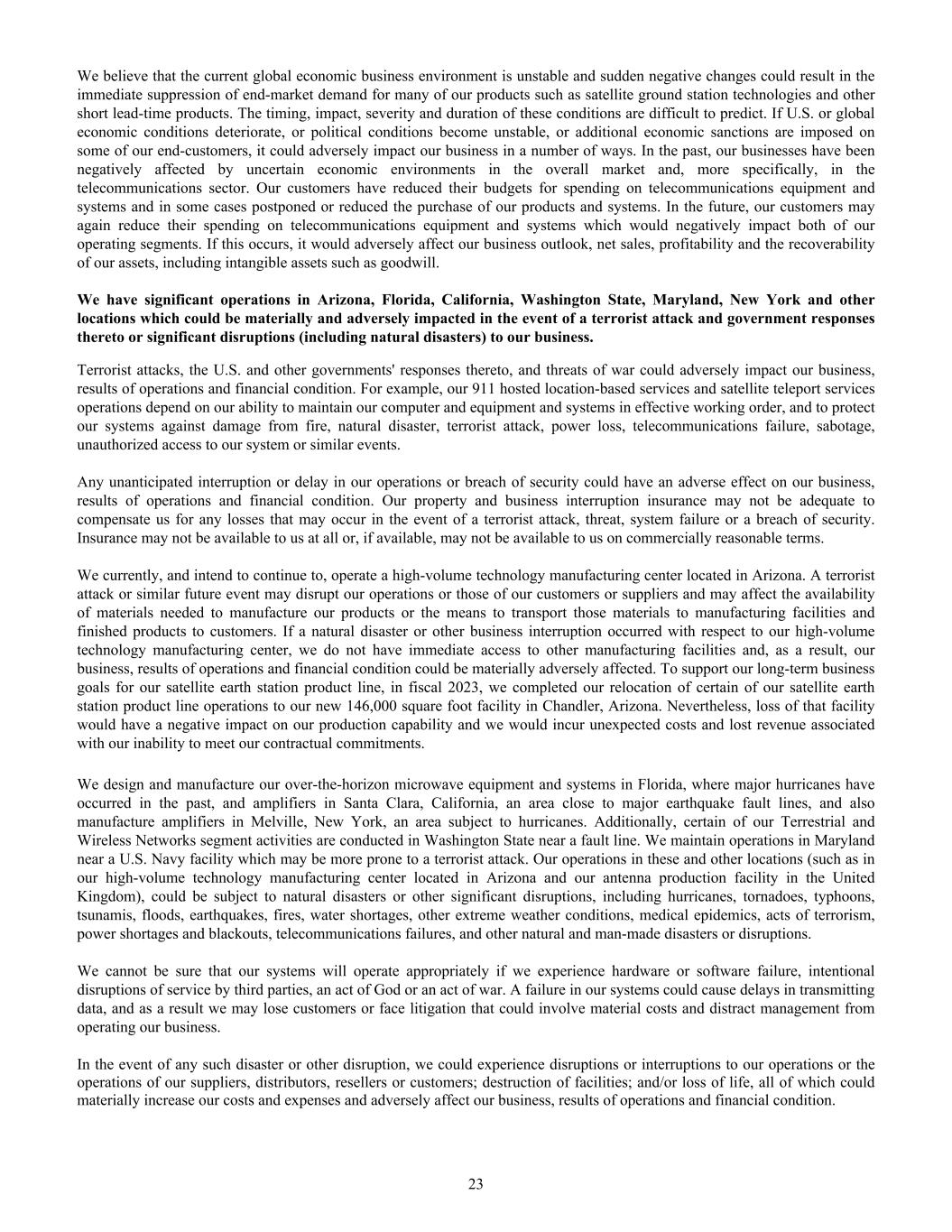
We believe that the current global economic business environment is unstable and sudden negative changes could result in the immediate suppression of end-market demand for many of our products such as satellite ground station technologies and other short lead-time products. The timing, impact, severity and duration of these conditions are difficult to predict. If U.S. or global economic conditions deteriorate, or political conditions become unstable, or additional economic sanctions are imposed on some of our end-customers, it could adversely impact our business in a number of ways. In the past, our businesses have been negatively affected by uncertain economic environments in the overall market and, more specifically, in the telecommunications sector. Our customers have reduced their budgets for spending on telecommunications equipment and systems and in some cases postponed or reduced the purchase of our products and systems. In the future, our customers may again reduce their spending on telecommunications equipment and systems which would negatively impact both of our operating segments. If this occurs, it would adversely affect our business outlook, net sales, profitability and the recoverability of our assets, including intangible assets such as goodwill. We have significant operations in Arizona, Florida, California, Washington State, Maryland, New York and other locations which could be materially and adversely impacted in the event of a terrorist attack and government responses thereto or significant disruptions (including natural disasters) to our business. Terrorist attacks, the U.S. and other governments' responses thereto, and threats of war could adversely impact our business, results of operations and financial condition. For example, our 911 hosted location-based services and satellite teleport services operations depend on our ability to maintain our computer and equipment and systems in effective working order, and to protect our systems against damage from fire, natural disaster, terrorist attack, power loss, telecommunications failure, sabotage, unauthorized access to our system or similar events. Any unanticipated interruption or delay in our operations or breach of security could have an adverse effect on our business, results of operations and financial condition. Our property and business interruption insurance may not be adequate to compensate us for any losses that may occur in the event of a terrorist attack, threat, system failure or a breach of security. Insurance may not be available to us at all or, if available, may not be available to us on commercially reasonable terms. We currently, and intend to continue to, operate a high-volume technology manufacturing center located in Arizona. A terrorist attack or similar future event may disrupt our operations or those of our customers or suppliers and may affect the availability of materials needed to manufacture our products or the means to transport those materials to manufacturing facilities and finished products to customers. If a natural disaster or other business interruption occurred with respect to our high-volume technology manufacturing center, we do not have immediate access to other manufacturing facilities and, as a result, our business, results of operations and financial condition could be materially adversely affected. To support our long-term business goals for our satellite earth station product line, in fiscal 2023, we completed our relocation of certain of our satellite earth station product line operations to our new 146,000 square foot facility in Chandler, Arizona. Nevertheless, loss of that facility would have a negative impact on our production capability and we would incur unexpected costs and lost revenue associated with our inability to meet our contractual commitments. We design and manufacture our over-the-horizon microwave equipment and systems in Florida, where major hurricanes have occurred in the past, and amplifiers in Santa Clara, California, an area close to major earthquake fault lines, and also manufacture amplifiers in Melville, New York, an area subject to hurricanes. Additionally, certain of our Terrestrial and Wireless Networks segment activities are conducted in Washington State near a fault line. We maintain operations in Maryland near a U.S. Navy facility which may be more prone to a terrorist attack. Our operations in these and other locations (such as in our high-volume technology manufacturing center located in Arizona and our antenna production facility in the United Kingdom), could be subject to natural disasters or other significant disruptions, including hurricanes, tornadoes, typhoons, tsunamis, floods, earthquakes, fires, water shortages, other extreme weather conditions, medical epidemics, acts of terrorism, power shortages and blackouts, telecommunications failures, and other natural and man-made disasters or disruptions. We cannot be sure that our systems will operate appropriately if we experience hardware or software failure, intentional disruptions of service by third parties, an act of God or an act of war. A failure in our systems could cause delays in transmitting data, and as a result we may lose customers or face litigation that could involve material costs and distract management from operating our business. In the event of any such disaster or other disruption, we could experience disruptions or interruptions to our operations or the operations of our suppliers, distributors, resellers or customers; destruction of facilities; and/or loss of life, all of which could materially increase our costs and expenses and adversely affect our business, results of operations and financial condition. 23

The military conflict between Russia and Ukraine, and the global response to it could adversely impact our revenues, gross margins and financial results. The U.S. government and other nations have imposed significant restrictions on most companies’ ability to do business in Russia. It is not possible to predict the broader or longer-term consequences of this conflict, which could include further sanctions, embargoes, regional instability, geopolitical shifts, adverse effects on macroeconomic conditions, security conditions, currency exchange rates and financial markets. Such geo-political instability and uncertainty could have a negative impact on our ability to sell to, ship products to, collect payments from, and support customers in certain regions based on trade restrictions, embargoes, export control law restrictions, and logistics restrictions including closures of air space, and could increase the costs, risks and adverse impacts from these new challenges. We may also be the subject of increased cyber-attacks as a result of the conflict. The military conflict between Russia and Ukraine has impacted our sales pipeline and continues to have significant repercussions for our business. Although sales into Russia represented approximately 1% of our consolidated net sales in fiscal 2023 and 2022, consolidated net sales into Russia in fiscal 2024 and beyond were expected to significantly grow. As a result of the economic sanctions against Russia, however, we have stopped accepting new orders in Russia and plan to wind down operations in fiscal 2024. Accordingly, we are completing the production of backlog for approved in-country customers and repatriating cash proceeds as permitted by both U.S. and Russian law. As a result of this conflict, in fiscal 2022 and 2023, certain customers (including the U.S. and Ukrainian government) paused procurement and deployment of satellite and troposcatter communication systems, and instead began purchasing war-fighting equipment. It has become difficult to predict the timing or dollar amount of our contract awards in the region. For example, we had several opportunities to provide wireless communication systems (including troposcatter systems) to Ukraine for a variety of both defense and communications uses. Funding for these systems was expected to be provided by Ukraine and by the U.S. government and these items were expected to be awarded and shipped in the second half of fiscal 2022. As result of the conflict in Ukraine, however, the award was not received and shipped until the first half of our fiscal 2023. Additionally, funding for opportunities with other customers that we expected to book and ship has also been shifted to other programs and/or temporarily delayed as a result of changes in defense spending priorities. Prior to this conflict, we maintained a small group of employees in Moscow, Russia who supported certain UHP-branded satellite communications products. In fiscal 2023, we continued to expand our Canadian operations and shifted certain commercial software development and support activities outside of Russia. However, as we are currently in an environment where software engineering talent is already in high demand and commands a premium, we expect to incur additional annual expenses in connection with this personnel shift for our UHP products. We may not be able to timely ramp up our operations in Canada or elsewhere on a sufficient scale to support anticipated growth of our UHP products, which could adversely impact future revenues, gross margins and operations. Our sales to government customers are highly dependent on the U.S. defense budget, which in turn is driven by an annual appropriation by Congress. These appropriations rarely align with the performance period of our contracts—for instance, most of our government contracts are only partially funded at inception. DoD budgets are driven by factors that are outside our control (such as economic conditions, administration policy shifts within the Executive branch and geopolitical events). Any one or combination of these factors may adversely impact our operations, resulting in a decline of sales and operating income. Business Risks Our backlog is subject to customer cancellation or modification and such cancellations could result in a decline in sales and increased provisions for excess and obsolete inventory. We currently have a backlog of orders, mostly under contracts that our customers may modify or terminate. Almost all of the contracts in our backlog (including firm orders previously received from the U.S. government) are subject to cancellation at the convenience of the customer or for default in the event that we are unable to perform under the contract. For some contracts, where we are a subcontractor (and not the prime contractor), the U.S. government could terminate the prime contractor for convenience without regard for our performance as a subcontractor. 24
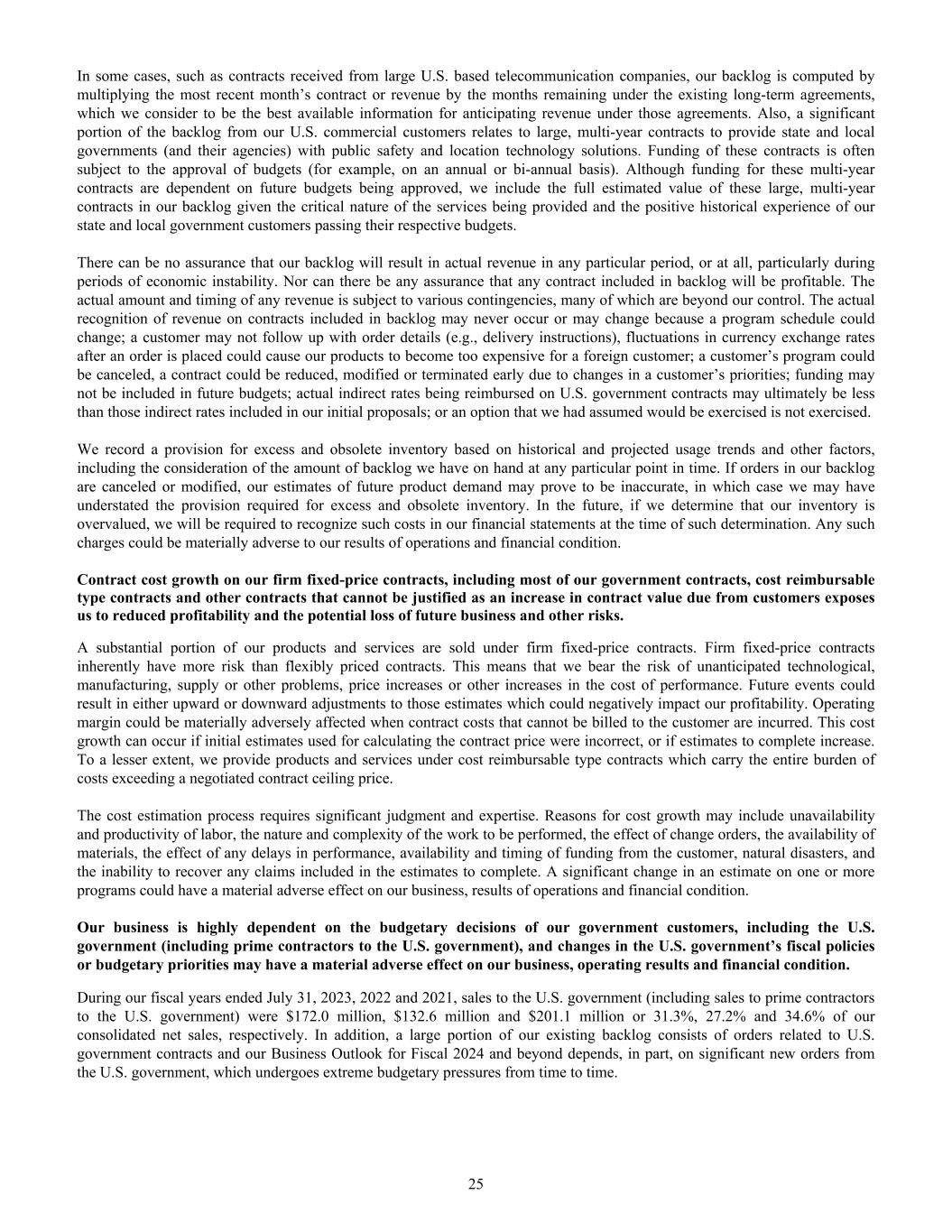
In some cases, such as contracts received from large U.S. based telecommunication companies, our backlog is computed by multiplying the most recent month’s contract or revenue by the months remaining under the existing long-term agreements, which we consider to be the best available information for anticipating revenue under those agreements. Also, a significant portion of the backlog from our U.S. commercial customers relates to large, multi-year contracts to provide state and local governments (and their agencies) with public safety and location technology solutions. Funding of these contracts is often subject to the approval of budgets (for example, on an annual or bi-annual basis). Although funding for these multi-year contracts are dependent on future budgets being approved, we include the full estimated value of these large, multi-year contracts in our backlog given the critical nature of the services being provided and the positive historical experience of our state and local government customers passing their respective budgets. There can be no assurance that our backlog will result in actual revenue in any particular period, or at all, particularly during periods of economic instability. Nor can there be any assurance that any contract included in backlog will be profitable. The actual amount and timing of any revenue is subject to various contingencies, many of which are beyond our control. The actual recognition of revenue on contracts included in backlog may never occur or may change because a program schedule could change; a customer may not follow up with order details (e.g., delivery instructions), fluctuations in currency exchange rates after an order is placed could cause our products to become too expensive for a foreign customer; a customer’s program could be canceled, a contract could be reduced, modified or terminated early due to changes in a customer’s priorities; funding may not be included in future budgets; actual indirect rates being reimbursed on U.S. government contracts may ultimately be less than those indirect rates included in our initial proposals; or an option that we had assumed would be exercised is not exercised. We record a provision for excess and obsolete inventory based on historical and projected usage trends and other factors, including the consideration of the amount of backlog we have on hand at any particular point in time. If orders in our backlog are canceled or modified, our estimates of future product demand may prove to be inaccurate, in which case we may have understated the provision required for excess and obsolete inventory. In the future, if we determine that our inventory is overvalued, we will be required to recognize such costs in our financial statements at the time of such determination. Any such charges could be materially adverse to our results of operations and financial condition. Contract cost growth on our firm fixed-price contracts, including most of our government contracts, cost reimbursable type contracts and other contracts that cannot be justified as an increase in contract value due from customers exposes us to reduced profitability and the potential loss of future business and other risks. A substantial portion of our products and services are sold under firm fixed-price contracts. Firm fixed-price contracts inherently have more risk than flexibly priced contracts. This means that we bear the risk of unanticipated technological, manufacturing, supply or other problems, price increases or other increases in the cost of performance. Future events could result in either upward or downward adjustments to those estimates which could negatively impact our profitability. Operating margin could be materially adversely affected when contract costs that cannot be billed to the customer are incurred. This cost growth can occur if initial estimates used for calculating the contract price were incorrect, or if estimates to complete increase. To a lesser extent, we provide products and services under cost reimbursable type contracts which carry the entire burden of costs exceeding a negotiated contract ceiling price. The cost estimation process requires significant judgment and expertise. Reasons for cost growth may include unavailability and productivity of labor, the nature and complexity of the work to be performed, the effect of change orders, the availability of materials, the effect of any delays in performance, availability and timing of funding from the customer, natural disasters, and the inability to recover any claims included in the estimates to complete. A significant change in an estimate on one or more programs could have a material adverse effect on our business, results of operations and financial condition. Our business is highly dependent on the budgetary decisions of our government customers, including the U.S. government (including prime contractors to the U.S. government), and changes in the U.S. government’s fiscal policies or budgetary priorities may have a material adverse effect on our business, operating results and financial condition. During our fiscal years ended July 31, 2023, 2022 and 2021, sales to the U.S. government (including sales to prime contractors to the U.S. government) were $172.0 million, $132.6 million and $201.1 million or 31.3%, 27.2% and 34.6% of our consolidated net sales, respectively. In addition, a large portion of our existing backlog consists of orders related to U.S. government contracts and our Business Outlook for Fiscal 2024 and beyond depends, in part, on significant new orders from the U.S. government, which undergoes extreme budgetary pressures from time to time. 25

We rely on U.S. government spending on our communication solutions, and our receipt of future orders depends in large part on continued funding by the U.S. government for the programs in which we participate. These spending levels are not generally correlated with any specific economic cycle, but rather follow the cycle of general public policy and political support for this type of spending. Government contracts are conditioned upon the continuing availability of congressional appropriations and Congress’s failure to appropriate funds, or Congress’s actions to reduce or delay spending on, or reprioritize its spending away from, U.S. government programs which we participate in, could negatively affect our results of operations. Because many of the items we sell to the U.S. government are included in large programs realized over a period of several years, it is difficult, if not impossible, to determine specific amounts that are or will be appropriated for our products and services. As such, our assessments relating to the impact of changes in U.S. government spending may prove to be incorrect. The federal debt limit continues to be actively debated as plans for long-term national fiscal policy are discussed. The outcome of these discussions could have a significant impact on defense spending broadly and programs we support in particular. The failure of Congress to approve future budgets and/or increase the debt ceiling of the U.S. on a timely basis could delay or result in the loss of contracts for the procurement of our products and services and we may be asked or required to continue to perform for some period of time on certain of our U.S. government contracts, even if the U.S. government is unable to make timely payments. A decrease in DoD or Department of Homeland Security expenditures, the elimination or curtailment of a material program in which we are involved, or changes in payment patterns of our customers as a result of changes in U.S. government spending could have an adverse effect on our business, results of operations and financial condition. It is possible that a shutdown of the U.S. government may occur, or interim budgets may be adopted. As such, we may experience delayed orders, delayed payments and adverse impacts on our results of operations. We may experience related supply chain delays, disruptions or other problems associated with financial constraints faced by our suppliers and subcontractors. All of the aforementioned conditions and factors could, in the aggregate, have a material adverse effect on our business, results of operations and financial condition. Additionally, cost cutting, efficiency initiatives, reprioritization, other affordability analyses, and changes in budgetary priorities by our governmental customers, including the U.S. government, could adversely impact both of our operating segments. We are unable to predict the impact these or similar events could have on our business, financial position, results of operations or cash flows. Our contracts with the U.S. government are subject to unique business, commercial and government audit risks. We depend on the U.S. government for a significant portion of our revenues. Our contracts with the U.S. government are subject to unique business and commercial risks, including: • unexpected contract or project terminations or suspensions; • unpredictable order placements, reductions, accelerations, delays or cancellations; • higher than expected final costs, particularly relating to software and hardware development, for work performed under contracts where we commit to specified deliveries for a fixed-price; and • unpredictable cash collections of unbilled receivables that may be subject to acceptance of contract deliverables by the customer and contract close out procedures, including government audit and approval of final indirect rates. Although we take steps to mitigate our risk with respect to contracts with the U.S. government, we may not be able to do so in every instance for any of the following reasons, among others: • Our U.S. government contracts can easily be terminated by the U.S. government - Our U.S. government contracts and subcontracts can be terminated by the U.S. government for its convenience or upon an event of default by us. Termination for convenience provisions provide us with little to no recourse related to: our potential recovery of costs incurred or costs committed, potential settlement expenses and hypothetical profit on work completed prior to termination. 26

• Our U.S. government contracts are subject to funding by the U.S. Congress - Our U.S. government contracts are conditioned upon the continuing approval by Congress of the necessary funding. Congress usually appropriates funds for a given program on a fiscal year basis even though contract performance may take more than one year. Consequently, at the beginning of a major program, the contract may not be fully funded, and additional monies are normally committed to the contract only if, and when, appropriations are made by Congress for future fiscal years. Delays or changes in funding can impact the timing of awards or lead to changes in program content. We obtain certain of our U.S. government contracts through a competitive bidding process. There can be no assurance that we will win additional contracts or that actual contracts that are awarded will ultimately be profitable. • We can be disqualified as a supplier to the U.S. government - As a supplier to the U.S. government, we must comply with numerous regulations, including those governing security, contracting practices and classified information. Failure to comply with these regulations and practices could result in fines being imposed against us or our suspension for a period of time from eligibility for bidding on, or for award of, new government contracts. If we are disqualified as a supplier to government agencies, we would lose most, if not all, of our U.S. government customers and revenues from sales of our products would decline significantly. • Our employees may not be able to obtain and maintain the required security clearances for the facilities in which we perform sensitive government work - Certain of our U.S. government contracts require our employees to maintain various levels of security clearances, and we are required to maintain certain facility security clearances. If we cannot maintain or obtain the required security clearances for our facilities and our employees, or obtain these clearances in a timely manner, we may be unable to perform certain U.S. government contracts. Further, loss of a facility clearance, or an employee’s failure to obtain or maintain a security clearance, could result in a U.S. government customer terminating an existing contract or choosing not to renew a contract. Lack of required clearances could also impede our ability to bid on or win new U.S. government contracts. This could damage our reputation and adversely affect our business, financial condition and results of operations. In addition, all of our U.S. government contracts can be audited by the Defense Contract Audit Agency ("DCAA") and other U.S. government agencies and we can be subject to penalties arising from post-award contract audits (sometimes referred to as a Truth in Negotiations Act or "TINA" audit) or cost audits in which the value of our contracts may be reduced. If costs are found to be improperly allocated to a specific contract, those costs will not be reimbursed, and any such costs already reimbursed would be required to be refunded. Although we record contract revenues based upon costs we expect to realize upon final audit, we cannot predict the outcome of any such future audits and adjustments, and we may be required to materially reduce our revenues or profits upon completion and final negotiation of audits. Negative audit findings could also result in termination of a contract, forfeiture of profits, suspension of payments, fines and suspension or debarment from U.S. government contracting or subcontracting for a period of time. Our dependence on sales to international customers exposes us to unique business, commercial and export compliance audit risks. Sales for use by international customers (including sales to U.S. companies for inclusion in products that will be sold to international customers) represented approximately 24.0%, 25.0% and 23.9% of our consolidated net sales for the fiscal years ended July 31, 2023, 2022 and 2021, respectively, and we expect that international sales will continue to be a significant portion of our consolidated net sales for the foreseeable future. These sales expose us to certain risks, including barriers to trade, declining trade relations, fluctuations in foreign currency exchange rates (which may make our products less price-competitive), political, legal, social and economic instability, exposure to public health epidemics, availability of suitable export financing, tariff regulations, and other U.S. and foreign regulations that may apply to the export of our products. Although we take steps to mitigate our risk with respect to international sales, we may not be able to do so in every instance for any of the following reasons, among others: • We may not be able to continue to structure our international contracts to reduce risk - We attempt to reduce the risk of doing business in foreign countries by seeking subcontracts with large systems suppliers, contracts denominated in U.S. dollars, advance or milestone payments and irrevocable letters of credit in our favor. However, we may not be able to reduce the economic risk of doing business in foreign countries in all instances. In such cases, billed and unbilled receivables relating to international sales are subject to increased collectability risk and may result in significant write-offs, which could have a material adverse effect on our business, results of operations and financial condition. In addition, foreign defense contracts generally contain provisions relating to termination at the convenience of the government. 27
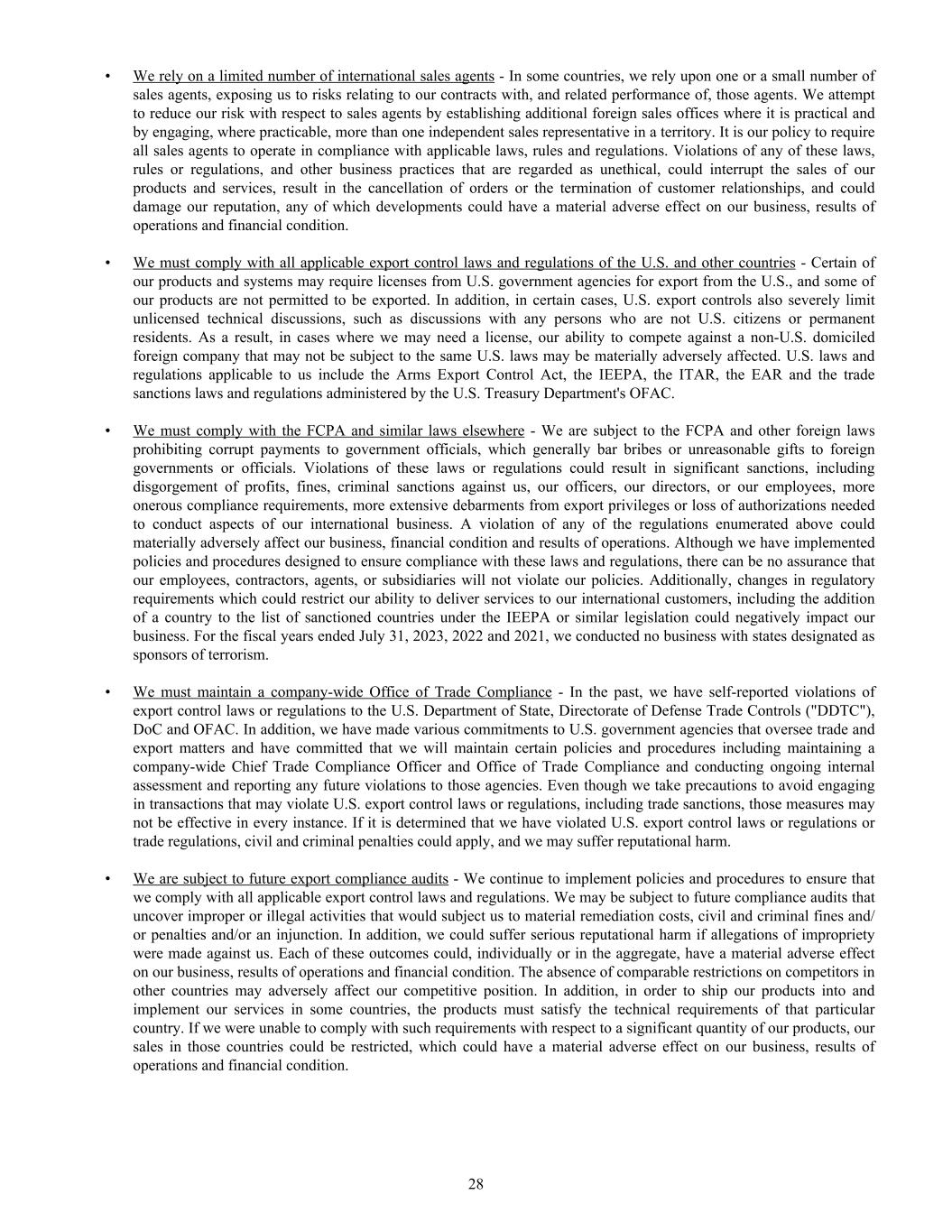
• We rely on a limited number of international sales agents - In some countries, we rely upon one or a small number of sales agents, exposing us to risks relating to our contracts with, and related performance of, those agents. We attempt to reduce our risk with respect to sales agents by establishing additional foreign sales offices where it is practical and by engaging, where practicable, more than one independent sales representative in a territory. It is our policy to require all sales agents to operate in compliance with applicable laws, rules and regulations. Violations of any of these laws, rules or regulations, and other business practices that are regarded as unethical, could interrupt the sales of our products and services, result in the cancellation of orders or the termination of customer relationships, and could damage our reputation, any of which developments could have a material adverse effect on our business, results of operations and financial condition. • We must comply with all applicable export control laws and regulations of the U.S. and other countries - Certain of our products and systems may require licenses from U.S. government agencies for export from the U.S., and some of our products are not permitted to be exported. In addition, in certain cases, U.S. export controls also severely limit unlicensed technical discussions, such as discussions with any persons who are not U.S. citizens or permanent residents. As a result, in cases where we may need a license, our ability to compete against a non-U.S. domiciled foreign company that may not be subject to the same U.S. laws may be materially adversely affected. U.S. laws and regulations applicable to us include the Arms Export Control Act, the IEEPA, the ITAR, the EAR and the trade sanctions laws and regulations administered by the U.S. Treasury Department's OFAC. • We must comply with the FCPA and similar laws elsewhere - We are subject to the FCPA and other foreign laws prohibiting corrupt payments to government officials, which generally bar bribes or unreasonable gifts to foreign governments or officials. Violations of these laws or regulations could result in significant sanctions, including disgorgement of profits, fines, criminal sanctions against us, our officers, our directors, or our employees, more onerous compliance requirements, more extensive debarments from export privileges or loss of authorizations needed to conduct aspects of our international business. A violation of any of the regulations enumerated above could materially adversely affect our business, financial condition and results of operations. Although we have implemented policies and procedures designed to ensure compliance with these laws and regulations, there can be no assurance that our employees, contractors, agents, or subsidiaries will not violate our policies. Additionally, changes in regulatory requirements which could restrict our ability to deliver services to our international customers, including the addition of a country to the list of sanctioned countries under the IEEPA or similar legislation could negatively impact our business. For the fiscal years ended July 31, 2023, 2022 and 2021, we conducted no business with states designated as sponsors of terrorism. • We must maintain a company-wide Office of Trade Compliance - In the past, we have self-reported violations of export control laws or regulations to the U.S. Department of State, Directorate of Defense Trade Controls ("DDTC"), DoC and OFAC. In addition, we have made various commitments to U.S. government agencies that oversee trade and export matters and have committed that we will maintain certain policies and procedures including maintaining a company-wide Chief Trade Compliance Officer and Office of Trade Compliance and conducting ongoing internal assessment and reporting any future violations to those agencies. Even though we take precautions to avoid engaging in transactions that may violate U.S. export control laws or regulations, including trade sanctions, those measures may not be effective in every instance. If it is determined that we have violated U.S. export control laws or regulations or trade regulations, civil and criminal penalties could apply, and we may suffer reputational harm. • We are subject to future export compliance audits - We continue to implement policies and procedures to ensure that we comply with all applicable export control laws and regulations. We may be subject to future compliance audits that uncover improper or illegal activities that would subject us to material remediation costs, civil and criminal fines and/ or penalties and/or an injunction. In addition, we could suffer serious reputational harm if allegations of impropriety were made against us. Each of these outcomes could, individually or in the aggregate, have a material adverse effect on our business, results of operations and financial condition. The absence of comparable restrictions on competitors in other countries may adversely affect our competitive position. In addition, in order to ship our products into and implement our services in some countries, the products must satisfy the technical requirements of that particular country. If we were unable to comply with such requirements with respect to a significant quantity of our products, our sales in those countries could be restricted, which could have a material adverse effect on our business, results of operations and financial condition. 28
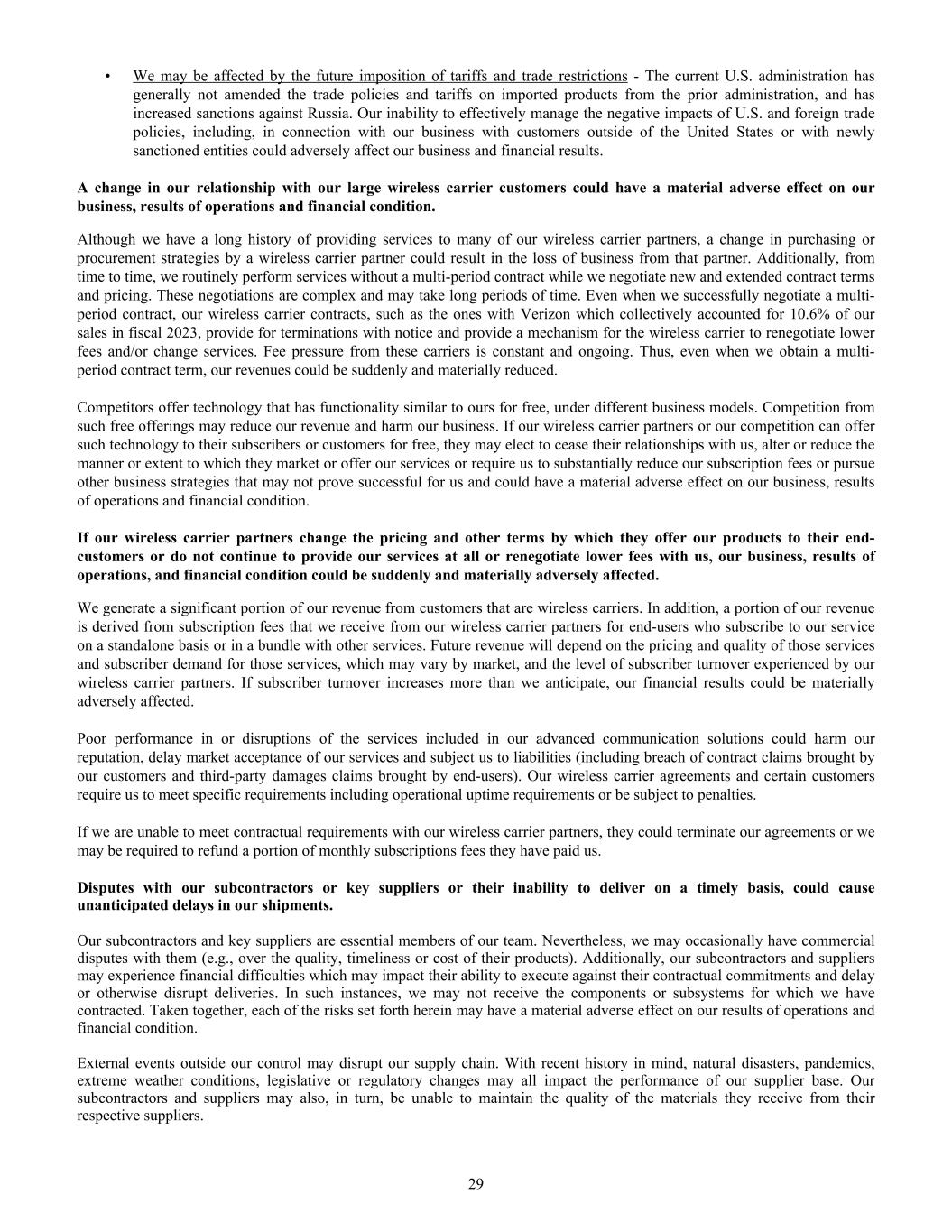
• We may be affected by the future imposition of tariffs and trade restrictions - The current U.S. administration has generally not amended the trade policies and tariffs on imported products from the prior administration, and has increased sanctions against Russia. Our inability to effectively manage the negative impacts of U.S. and foreign trade policies, including, in connection with our business with customers outside of the United States or with newly sanctioned entities could adversely affect our business and financial results. A change in our relationship with our large wireless carrier customers could have a material adverse effect on our business, results of operations and financial condition. Although we have a long history of providing services to many of our wireless carrier partners, a change in purchasing or procurement strategies by a wireless carrier partner could result in the loss of business from that partner. Additionally, from time to time, we routinely perform services without a multi-period contract while we negotiate new and extended contract terms and pricing. These negotiations are complex and may take long periods of time. Even when we successfully negotiate a multi- period contract, our wireless carrier contracts, such as the ones with Verizon which collectively accounted for 10.6% of our sales in fiscal 2023, provide for terminations with notice and provide a mechanism for the wireless carrier to renegotiate lower fees and/or change services. Fee pressure from these carriers is constant and ongoing. Thus, even when we obtain a multi- period contract term, our revenues could be suddenly and materially reduced. Competitors offer technology that has functionality similar to ours for free, under different business models. Competition from such free offerings may reduce our revenue and harm our business. If our wireless carrier partners or our competition can offer such technology to their subscribers or customers for free, they may elect to cease their relationships with us, alter or reduce the manner or extent to which they market or offer our services or require us to substantially reduce our subscription fees or pursue other business strategies that may not prove successful for us and could have a material adverse effect on our business, results of operations and financial condition. If our wireless carrier partners change the pricing and other terms by which they offer our products to their end- customers or do not continue to provide our services at all or renegotiate lower fees with us, our business, results of operations, and financial condition could be suddenly and materially adversely affected. We generate a significant portion of our revenue from customers that are wireless carriers. In addition, a portion of our revenue is derived from subscription fees that we receive from our wireless carrier partners for end-users who subscribe to our service on a standalone basis or in a bundle with other services. Future revenue will depend on the pricing and quality of those services and subscriber demand for those services, which may vary by market, and the level of subscriber turnover experienced by our wireless carrier partners. If subscriber turnover increases more than we anticipate, our financial results could be materially adversely affected. Poor performance in or disruptions of the services included in our advanced communication solutions could harm our reputation, delay market acceptance of our services and subject us to liabilities (including breach of contract claims brought by our customers and third-party damages claims brought by end-users). Our wireless carrier agreements and certain customers require us to meet specific requirements including operational uptime requirements or be subject to penalties. If we are unable to meet contractual requirements with our wireless carrier partners, they could terminate our agreements or we may be required to refund a portion of monthly subscriptions fees they have paid us. Disputes with our subcontractors or key suppliers or their inability to deliver on a timely basis, could cause unanticipated delays in our shipments. Our subcontractors and key suppliers are essential members of our team. Nevertheless, we may occasionally have commercial disputes with them (e.g., over the quality, timeliness or cost of their products). Additionally, our subcontractors and suppliers may experience financial difficulties which may impact their ability to execute against their contractual commitments and delay or otherwise disrupt deliveries. In such instances, we may not receive the components or subsystems for which we have contracted. Taken together, each of the risks set forth herein may have a material adverse effect on our results of operations and financial condition. External events outside our control may disrupt our supply chain. With recent history in mind, natural disasters, pandemics, extreme weather conditions, legislative or regulatory changes may all impact the performance of our supplier base. Our subcontractors and suppliers may also, in turn, be unable to maintain the quality of the materials they receive from their respective suppliers. 29

Our reliance on a single partner to source critical parts (i.e., where we are unable to develop a critical redundant source of supply) may impair our ability to produce and deliver our products. This negative impact could be even greater where we are required to comply with sourcing requirements within our U.S. government contracts regarding the purchase of counterfeit or otherwise non-compliant parts or materials. In some instances, where we rely on supplier certifications of compliance with these laws and regulations, an improper or incomplete certification may adversely impact our production capability. Strategic Growth Risks We face a number of risks relating to the expected long-term growth of our business. Our business and operating results may be negatively impacted if we are unable to manage this growth. Our business is uniquely subject to certain risks related to its long term growth. These risks include: • We may not be ultimately successful in implementing our "One Comtech" transformation and integration of individual businesses into two segments - The transformation of Comtech from stand-alone individual businesses toward a single “One Comtech” is a complex undertaking, requiring the consolidation of both manufacturing and back-office teams around the globe in parallel with a global re-branding effort. Managing the merger of multiple production facilities and their attending employee populations is difficult and may negatively impact business prospects in the short and long term. Similarly, our re-branding of the company as Comtech risks damaging goodwill accumulated over decades of operation as individual businesses. • The loss of key technical and/or management personnel could adversely affect our business - Our future success depends on the continued contributions of key technical and management personnel. The management skills that have been appropriate for us in the past may not continue to be appropriate if we grow and diversify. Filling new positions may be difficult in the current competitive labor market. Moreover, many of our key and technical management personnel would be difficult to replace and are not subject to employment or non-competition agreements. We currently have research and development employees in areas that are located a great distance away from our U.S. headquarters and some work out of their respective homes. Managing remote product development operations is difficult and we may not be able to manage the employees in these remote centers successfully. Our expected growth and future success will depend, in large part, upon our ability to attract and retain highly qualified engineering, sales and marketing personnel. Competition for such personnel from other companies, academic institutions, government entities and other organizations is intense. Although we believe that we have been successful to date in recruiting and retaining key personnel, we may not be successful in attracting and retaining the personnel we will need to grow and operate profitably, especially in the current competitive labor market. • We may not be able to improve our processes and systems to keep pace with anticipated growth - The future growth of our business may place significant demands on our managerial, operational, production and financial resources. In order to manage that growth, we must be prepared to improve and expand our management, operational and financial systems and controls, as well as our production capabilities. We also need to continue to recruit and retain personnel and train and manage our employee base. We must carefully manage research and development capabilities and production and inventory levels to meet product demand, new product introductions and product and technology transitions. If we are not able to timely and effectively manage our growth and maintain the quality standards required by our existing and potential customers, it could have an adverse effect on our business, results of operations and financial condition. • Our markets are highly competitive and there can be no assurance that we can continue to compete effectively - The markets for our products are highly competitive. There can be no assurance that we will be able to continue to compete successfully on price or other terms, or that our competitors will not develop new technologies and products that are more effective than our own. We expect the DoD’s increased use of commercial off-the-shelf products and components in military equipment will encourage new competitors to enter the market. Also, although the implementation of advanced telecommunications services is in its early stages in many developing countries, we believe competition will continue to intensify as businesses and foreign governments realize the market potential of telecommunications services. Many of our competitors have financial, technical, marketing, sales and distribution resources greater than ours. Recently, we have seen increased requests for proposals from large wireless carriers for sole-source solutions and have responded to several such requests. In order to induce retention of existing customer contracts and obtain business on a sole-source basis, we may ultimately agree to adjust pricing on a retroactive basis. If our sole-source proposals are rejected in favor of a competitor’s proposal, it could result in the termination of existing contracts, which could have a material adverse effect on our business, results of operations and financial condition. 30

• We may not be able to obtain sufficient components to meet expected demand - Our dependence on component availability, government furnished equipment, subcontractors and key suppliers, including the core manufacturing expertise of our high-volume technology manufacturing center located in Arizona exposes us to risk. Although we obtain certain components and subsystems from a single source or a limited number of sources, we believe that most components and subsystems are available from alternative suppliers and subcontractors. During the past four years, partly driven by the COVID-19 pandemic and as a result of overall increased industry-wide demand, lead times for many components have increased as well as freight costs. In addition, threats of or actual tariffs could limit our ability to obtain certain parts on a cost-effective basis, or at all. A significant interruption in the delivery of such items could have an adverse effect on our business, results of operations and financial condition. Similarly, if our high-volume technology manufacturing center located in Arizona is unable to produce sufficient product or maintain quality, it could have a material adverse effect on our business, results of operations and financial condition. • Our ability to maintain affordable credit insurance may become more difficult - In the normal course of our business, we purchase credit insurance to mitigate some of our domestic and international credit risk. Although credit insurance remains generally available, upon renewal, it may become more expensive to obtain or may not be available for existing or new customers in certain international markets and it might require higher deductibles than in the past. If we acquire a company with a different customer base, we may not be able to obtain credit insurance for those sales. As such, there can be no assurance that, in the future, we will be able to obtain credit insurance on a basis consistent with our past practices. Loss of our executive officers or other key personnel or other changes to our management team could disrupt our operations and growth plans or harm our business. We depend on the efforts of our executive officers and certain key personnel. Any unplanned turnover or our failure to develop an adequate succession plan or business continuity plan for one or more of our executive officers, including our Chief Executive Officer (“CEO”), or other key positions could deplete our institutional knowledge base and erode our competitive advantage. The loss or limited availability of the services of one or more of our executive officers or other key personnel, or our inability to recruit and retain qualified executive officers or other key personnel in the future, could, at least temporarily, have an adverse effect on our operating results and financial condition. Leadership transitions can be inherently difficult to manage, and an inadequate transition may cause disruption to our business an growth plans, including to our relationships with our customers and employees. We have incurred indebtedness under a Credit Facility, and may incur substantial additional indebtedness in the future, and may not be able to service that debt in the future and we must maintain compliance with various covenants that impose restrictions on our business. On October 31, 2018, we entered into a First Amended and Restated Credit Agreement (the "Credit Facility") with a syndicate of lenders. On November 30, 2022, we refinanced the amount outstanding under the Credit Facility by entering into a Second Amended and Restated Credit Agreement (also referred to herein as the “Credit Facility”) with the existing lenders. The Credit Facility provides a senior secured loan facility of up to $300.0 million consisting of: (i) a revolving loan facility (“Revolving Loan Facility”) with a borrowing limit of $150.0 million, including a $20.0 million letter of credit sublimit and a swingline loan credit sublimit of $15.0 million; (ii) a $50.0 million term loan A (“Term Loan”); and (iii) an accordion feature allowing us to make a request to borrow up to an additional $100.0 million subject to the satisfaction of specified conditions, including approval by our lenders. As of July 31, 2023, the amount outstanding under our Credit Facility was $164.4 million, of which $4.4 million and $160.0 million is reflected in the current and non-current portion of long-term debt, respectively, on our Consolidated Balance Sheet. As of July 31, 2023, we also had $1.0 million of standby letters of credit outstanding under our Credit Facility related to guarantees of future performance on certain customer contracts. Currently, the Credit Facility has a maturity date of October 31, 2024 (“Maturity Date”), which is approximately one year out from now. In anticipation of the upcoming Maturity Date, we engaged a third-party financial advisor to assist us with both the refinancing of our existing Credit Facility, as well as with our evaluation of other capital structure-related alternatives. In tandem with these activities, which we believe are nearing closure, we are also in discussions with our existing lenders to amend and extend the Maturity Date of the Credit Facility, if needed to complete these important initiatives. However, we may not be successful in securing an amendment and extension of the Credit Facility or complete such refinancing activities by October 31, 2023, when the debt outstanding under our Credit Facility would become a short-term current liability. 31

At the Maturity Date of the Credit Facility, as it currently stands or as may be extended, if we do not have sufficient funds to repay our debt when due, it may be necessary to refinance our debt through additional debt or equity financings. If, at the time of any refinancing, prevailing interest rates or other factors result in higher interest rates on such refinancing, increases in interest expense could have a material adverse effect on our business, results of operations and financial condition. In addition, if we are not able to obtain favorable terms pursuant to any such refinancing, the size of our Credit Facility could be reduced, more restrictive covenants could be imposed on our business and features of the existing Credit Facility could otherwise be altered or eliminated. Our Credit Facility contains various affirmative and negative covenants that may restrict our ability to, among other things, permit liens on our property, change the nature of our business, transact business with affiliates and/or merge or consolidate with any other person or sell or convey certain of our assets to any one person. We anticipate maintaining compliance with the terms and financial covenants in our Credit Facility for the foreseeable future, however, there can be no assurance that we will be able to meet these covenants. Further, our ability to comply with covenants, terms of and conditions on our facility may be affected by events beyond our control. Failure to comply with covenants could result in an event of default, which, if not cured or waived, could accelerate our repayment obligations. Our substantial debt obligations could impede, restrict or delay the implementation of our business strategy or prevent us from entering into transactions that would otherwise benefit our business. For example: • we may be required to dedicate a substantial portion of our cash flows from operations to payments on our indebtedness, thereby reducing the availability of our cash flows for other purposes, including but not limited to business development efforts, capital expenditures, dividends (to the extent applicable) or strategic acquisitions; • if we are not able to generate sufficient cash flows to meet our substantial debt service obligations or to fund our other liquidity needs, we may have to take actions such as selling assets or raising additional equity or reducing or delaying capital expenditures, strategic acquisitions, investments and joint ventures, restructuring our debt and other capital- intensive activities; • we may not be able to fund future working capital, capital investments and other business activities; • we may not be able to make certain other distributions; • we may become more vulnerable in the event of a downturn in our business or a worsening of general economic or industry-specific conditions; and • our flexibility in planning for, or reacting to, changes in our business and industry may be limited, thereby placing us at a competitive disadvantage compared to our competitors that have less indebtedness. Moreover, we may incur substantial additional indebtedness in the future to fund acquisitions or to fund other activities for general business purposes. If additional new debt is added to the current or planned debt levels, or if we are unable to obtain financing on favorable terms, the related risks that we now face could intensify. A substantial increase in our indebtedness could also have a negative impact on our credit ratings. In this regard, failure to maintain our credit ratings could adversely affect the interest rate available to us in future financings, as well as our liquidity, competitive position and access to capital markets. Any decision regarding future borrowings will be based on the facts and circumstances existing at the time, including market conditions and our credit ratings. 32
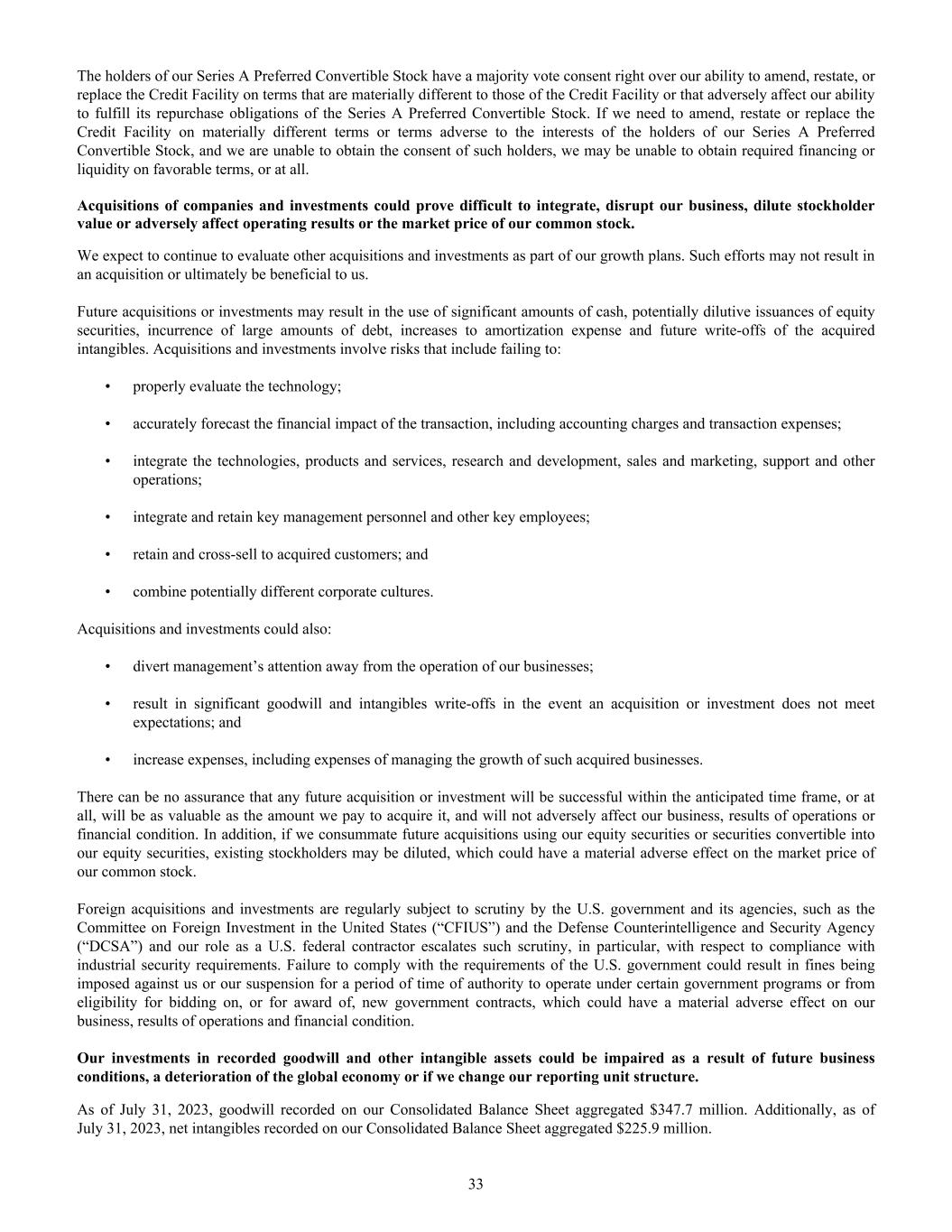
The holders of our Series A Preferred Convertible Stock have a majority vote consent right over our ability to amend, restate, or replace the Credit Facility on terms that are materially different to those of the Credit Facility or that adversely affect our ability to fulfill its repurchase obligations of the Series A Preferred Convertible Stock. If we need to amend, restate or replace the Credit Facility on materially different terms or terms adverse to the interests of the holders of our Series A Preferred Convertible Stock, and we are unable to obtain the consent of such holders, we may be unable to obtain required financing or liquidity on favorable terms, or at all. Acquisitions of companies and investments could prove difficult to integrate, disrupt our business, dilute stockholder value or adversely affect operating results or the market price of our common stock. We expect to continue to evaluate other acquisitions and investments as part of our growth plans. Such efforts may not result in an acquisition or ultimately be beneficial to us. Future acquisitions or investments may result in the use of significant amounts of cash, potentially dilutive issuances of equity securities, incurrence of large amounts of debt, increases to amortization expense and future write-offs of the acquired intangibles. Acquisitions and investments involve risks that include failing to: • properly evaluate the technology; • accurately forecast the financial impact of the transaction, including accounting charges and transaction expenses; • integrate the technologies, products and services, research and development, sales and marketing, support and other operations; • integrate and retain key management personnel and other key employees; • retain and cross-sell to acquired customers; and • combine potentially different corporate cultures. Acquisitions and investments could also: • divert management’s attention away from the operation of our businesses; • result in significant goodwill and intangibles write-offs in the event an acquisition or investment does not meet expectations; and • increase expenses, including expenses of managing the growth of such acquired businesses. There can be no assurance that any future acquisition or investment will be successful within the anticipated time frame, or at all, will be as valuable as the amount we pay to acquire it, and will not adversely affect our business, results of operations or financial condition. In addition, if we consummate future acquisitions using our equity securities or securities convertible into our equity securities, existing stockholders may be diluted, which could have a material adverse effect on the market price of our common stock. Foreign acquisitions and investments are regularly subject to scrutiny by the U.S. government and its agencies, such as the Committee on Foreign Investment in the United States (“CFIUS”) and the Defense Counterintelligence and Security Agency (“DCSA”) and our role as a U.S. federal contractor escalates such scrutiny, in particular, with respect to compliance with industrial security requirements. Failure to comply with the requirements of the U.S. government could result in fines being imposed against us or our suspension for a period of time of authority to operate under certain government programs or from eligibility for bidding on, or for award of, new government contracts, which could have a material adverse effect on our business, results of operations and financial condition. Our investments in recorded goodwill and other intangible assets could be impaired as a result of future business conditions, a deterioration of the global economy or if we change our reporting unit structure. As of July 31, 2023, goodwill recorded on our Consolidated Balance Sheet aggregated $347.7 million. Additionally, as of July 31, 2023, net intangibles recorded on our Consolidated Balance Sheet aggregated $225.9 million. 33
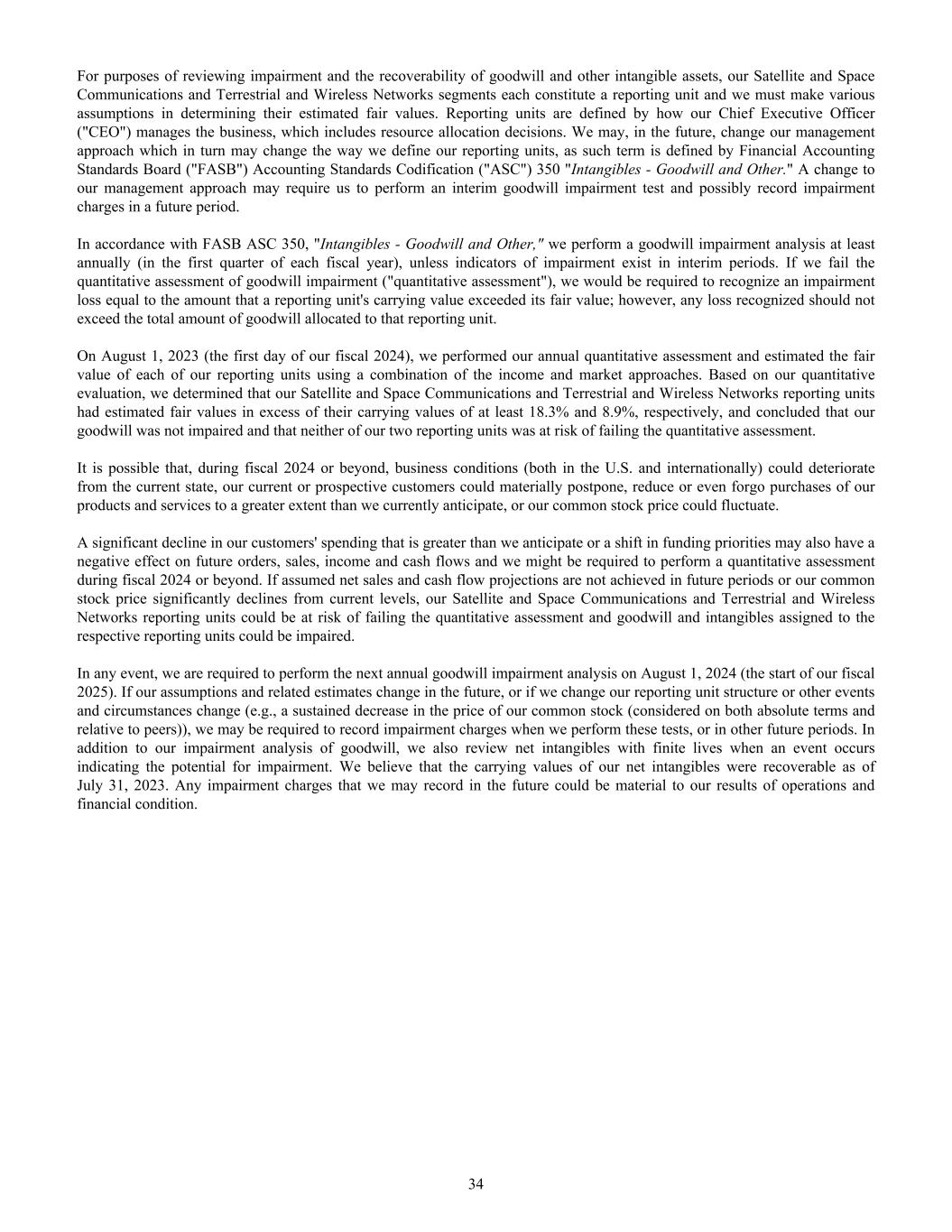
For purposes of reviewing impairment and the recoverability of goodwill and other intangible assets, our Satellite and Space Communications and Terrestrial and Wireless Networks segments each constitute a reporting unit and we must make various assumptions in determining their estimated fair values. Reporting units are defined by how our Chief Executive Officer ("CEO") manages the business, which includes resource allocation decisions. We may, in the future, change our management approach which in turn may change the way we define our reporting units, as such term is defined by Financial Accounting Standards Board ("FASB") Accounting Standards Codification ("ASC") 350 "Intangibles - Goodwill and Other." A change to our management approach may require us to perform an interim goodwill impairment test and possibly record impairment charges in a future period. In accordance with FASB ASC 350, "Intangibles - Goodwill and Other," we perform a goodwill impairment analysis at least annually (in the first quarter of each fiscal year), unless indicators of impairment exist in interim periods. If we fail the quantitative assessment of goodwill impairment ("quantitative assessment"), we would be required to recognize an impairment loss equal to the amount that a reporting unit's carrying value exceeded its fair value; however, any loss recognized should not exceed the total amount of goodwill allocated to that reporting unit. On August 1, 2023 (the first day of our fiscal 2024), we performed our annual quantitative assessment and estimated the fair value of each of our reporting units using a combination of the income and market approaches. Based on our quantitative evaluation, we determined that our Satellite and Space Communications and Terrestrial and Wireless Networks reporting units had estimated fair values in excess of their carrying values of at least 18.3% and 8.9%, respectively, and concluded that our goodwill was not impaired and that neither of our two reporting units was at risk of failing the quantitative assessment. It is possible that, during fiscal 2024 or beyond, business conditions (both in the U.S. and internationally) could deteriorate from the current state, our current or prospective customers could materially postpone, reduce or even forgo purchases of our products and services to a greater extent than we currently anticipate, or our common stock price could fluctuate. A significant decline in our customers' spending that is greater than we anticipate or a shift in funding priorities may also have a negative effect on future orders, sales, income and cash flows and we might be required to perform a quantitative assessment during fiscal 2024 or beyond. If assumed net sales and cash flow projections are not achieved in future periods or our common stock price significantly declines from current levels, our Satellite and Space Communications and Terrestrial and Wireless Networks reporting units could be at risk of failing the quantitative assessment and goodwill and intangibles assigned to the respective reporting units could be impaired. In any event, we are required to perform the next annual goodwill impairment analysis on August 1, 2024 (the start of our fiscal 2025). If our assumptions and related estimates change in the future, or if we change our reporting unit structure or other events and circumstances change (e.g., a sustained decrease in the price of our common stock (considered on both absolute terms and relative to peers)), we may be required to record impairment charges when we perform these tests, or in other future periods. In addition to our impairment analysis of goodwill, we also review net intangibles with finite lives when an event occurs indicating the potential for impairment. We believe that the carrying values of our net intangibles were recoverable as of July 31, 2023. Any impairment charges that we may record in the future could be material to our results of operations and financial condition. 34

Cybersecurity Risks We could be negatively impacted by a system failure, lack of or failure of redundant system components, security breach through cyber-attack, cyber intrusion or otherwise, by other significant disruption of our IT networks or those we operate for certain customers, or third-party data center facilities, servers and related systems. If any such events occur, we may have to reimburse our customers for damages that they may have incurred, pay contract penalties, or provide refunds. Similar to all companies in our industry, we are under constant cyber-attack and are subject to an ongoing risk of security breaches and disruptions of our IT networks and related systems, including third-party data center facilities, whether through actual breaches, cyber-attacks (including ransomware) or cyber intrusions via the Internet, malware, computer viruses, attachments to e-mails, persons inside our organization or persons with access to systems inside our organization. Actual security breaches or disruption, particularly through cyber-attack or cyber intrusion, including by computer hackers, foreign governments and cyber terrorists, have increased in recent years and have become more complex. Our IT networks and systems, as well as third-party data center facilities, have been and, we believe will continue to be under constant attack. We face an added risk of a security breach or other significant disruption to certain of our equipment used on some of our customers' IT networks and related systems which may involve managing and protecting information relating to public safety agencies, wireless carriers as well as national security and other sensitive government functions. Many of our systems have, or are required to have, system redundancies and back-up; in some cases, we may not have sufficient redundancy and/or redundancy and/or back-ups may fail. We may incur significant costs to prevent and respond to system failures, failure of redundant system components, actual breaches, cyber-attacks and other systems disruptions. As a communications company, and particularly as a government contractor and a provider of public safety and location technologies (including 911 hosted systems), we face a heightened risk of a security breach or disruption from actual breaches, cyber-attacks and other threats to gain unauthorized access to our and our customers’ proprietary or classified information on our IT networks, third-party data center facilities and related systems and to certain of our equipment used on some of our customers' IT networks and related systems. These types of information, IT networks and related systems are critical to the operation of our business and essential to our ability to perform day-to-day operations, and, in some cases, are critical to the operations of certain of our customers. There can be no assurance that our security efforts and measures will be effective or that actual security breaches or disruptions will not be successful or damaging. Techniques used in such breaches and cyber-attacks are constantly evolving and generally are not recognized until launched against a target, and in some cases are designed not to be detected and, in fact, may not be detected. In some cases, the resources of foreign governments may be behind such attacks. Accordingly, we may be unable to anticipate these techniques or to implement adequate security barriers or other preventative measures, and thus it is virtually impossible for us to entirely mitigate this risk. A security breach or other significant disruption (including as a result of a lack of redundancy and/or failure of such redundancy) involving these types of information, IT networks and related systems could: • Disrupt the proper functionality of these networks, data center facilities and systems and therefore our operations and/ or those of certain of our customers; • Result in the unauthorized access to, and destruction, loss, theft, misappropriation or release of proprietary, confidential, sensitive or otherwise valuable information of ours or our customers, including trade secrets, which others could use to compete against us or for disruptive, destructive or otherwise harmful purposes and outcomes; • Compromise national security and other sensitive government functions; • Require significant management attention and resources to remedy the damage that results and delay progress on other business objectives; • Require us to make payments to our customers to reimburse them for damages, pay them penalties or provide refunds; and • Damage our reputation with our customers (particularly agencies of the U.S. government) and the public generally. In addition, the cost of continually defending against cyber-attacks and actual breaches has increased in recent years and future costs and any or all of the foregoing could have a material adverse effect on our business, results of operations and financial condition. 35

The measures we have implemented to secure information we collect and store or enable access to may be breached, which could cause us to breach agreements with our partners and expose us to potential investigation and penalties by authorities and potential claims for contract breach, product liability damages, credits, penalties or termination by persons whose information was disclosed. We take reasonable steps to protect the security, integrity and confidentiality of the information we collect and store and to prevent unauthorized access to third-party data to which we enable access through our products, but there is no guarantee that inadvertent or unauthorized disclosure will not occur or that third parties will not gain unauthorized access despite our efforts. If such unauthorized disclosure or access does occur, we may be required to notify persons whose information was disclosed or accessed under existing and proposed laws. Because the techniques used to obtain unauthorized access, disable or degrade service, or sabotage systems change frequently and are often not recognized until launched against a target, we may be unable to anticipate these techniques or implement adequate preventative measures. In the event of such disclosure, we also may be subject to claims of breach of contract, investigation and penalties by regulatory authorities and potential claims by persons whose information was disclosed. If there is a security breach or if there is an inappropriate disclosure of any of these types of information, we could be exposed to investigations, litigation, fines and penalties. Remediation of and liability for loss or misappropriation of end user or employee personal information could have a material adverse effect on our business, results of operations and financial condition. Even if we were not held liable for such event, a security breach or inappropriate disclosure of personal, private or confidential information could harm our reputation and our relationships with current and potential customers and end users. Even the perception of a security risk could inhibit market acceptance of our products and services. We may be required to invest additional resources to protect against damage caused by any actual or perceived disruptions of our services. We may also be required to provide information about the location of an end user’s mobile device to government authorities, which could result in public perception that we are providing the government with intelligence information and deter some end users from using our services. Any of these developments could have a material adverse effect on our business, results of operations and financial condition. Legal, Regulatory and Litigation Risks Changes in U.S. federal, state and local and foreign tax law could adversely affect our business and financial condition. The laws, rules, and regulations dealing with U.S. federal, state and local and foreign income taxation are constantly under review by persons involved in the legislative process and by the Internal Revenue Service and the U.S. Treasury Department. Changes to tax laws (which changes may have immediate and/or retroactive application) could adversely affect us or holders of our common stock. In recent years, many changes have been made to applicable tax laws and changes are likely to continue to occur in the future. It cannot be predicted whether, when, in what form, or with what effective dates, new tax laws may be enacted, or regulations and rulings may be enacted, promulgated or issued under existing or new tax laws, which could result in an increase in our tax liability or require changes in the manner in which we operate in order to minimize or mitigate any adverse effects of changes in tax law or in the interpretation thereof. Our U.S. federal, state and local and foreign tax returns are subject to audit and a resulting tax assessment or settlement could have a material adverse effect on our business, results of operations and financial condition. Significant judgment is required in determining the provision for income taxes. The final determination of tax examinations and any related litigation could be materially different than what is reflected in historical income tax provisions and accruals. Our U.S. federal income tax returns for fiscal 2020 through 2022 are subject to potential future Internal Revenue Service ("IRS") audit. None of our state income tax returns prior to fiscal 2019 are subject to audit. Although adjustments relating to past audits of our federal income tax returns were immaterial, a tax assessment or settlement for other periods or other jurisdictions that may be selected for future audit could have a material adverse effect on our business, consolidated results of operations and financial condition. 36
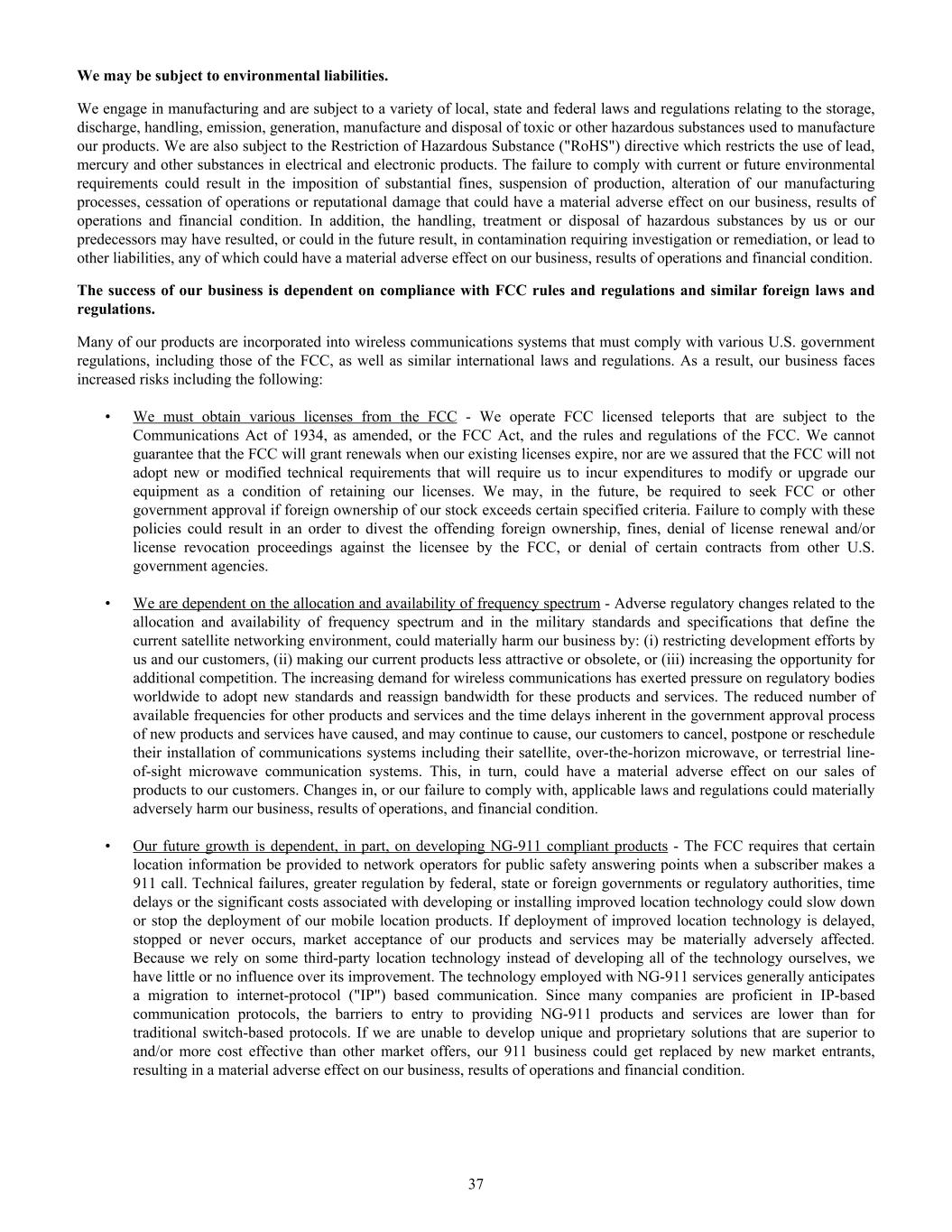
We may be subject to environmental liabilities. We engage in manufacturing and are subject to a variety of local, state and federal laws and regulations relating to the storage, discharge, handling, emission, generation, manufacture and disposal of toxic or other hazardous substances used to manufacture our products. We are also subject to the Restriction of Hazardous Substance ("RoHS") directive which restricts the use of lead, mercury and other substances in electrical and electronic products. The failure to comply with current or future environmental requirements could result in the imposition of substantial fines, suspension of production, alteration of our manufacturing processes, cessation of operations or reputational damage that could have a material adverse effect on our business, results of operations and financial condition. In addition, the handling, treatment or disposal of hazardous substances by us or our predecessors may have resulted, or could in the future result, in contamination requiring investigation or remediation, or lead to other liabilities, any of which could have a material adverse effect on our business, results of operations and financial condition. The success of our business is dependent on compliance with FCC rules and regulations and similar foreign laws and regulations. Many of our products are incorporated into wireless communications systems that must comply with various U.S. government regulations, including those of the FCC, as well as similar international laws and regulations. As a result, our business faces increased risks including the following: • We must obtain various licenses from the FCC - We operate FCC licensed teleports that are subject to the Communications Act of 1934, as amended, or the FCC Act, and the rules and regulations of the FCC. We cannot guarantee that the FCC will grant renewals when our existing licenses expire, nor are we assured that the FCC will not adopt new or modified technical requirements that will require us to incur expenditures to modify or upgrade our equipment as a condition of retaining our licenses. We may, in the future, be required to seek FCC or other government approval if foreign ownership of our stock exceeds certain specified criteria. Failure to comply with these policies could result in an order to divest the offending foreign ownership, fines, denial of license renewal and/or license revocation proceedings against the licensee by the FCC, or denial of certain contracts from other U.S. government agencies. • We are dependent on the allocation and availability of frequency spectrum - Adverse regulatory changes related to the allocation and availability of frequency spectrum and in the military standards and specifications that define the current satellite networking environment, could materially harm our business by: (i) restricting development efforts by us and our customers, (ii) making our current products less attractive or obsolete, or (iii) increasing the opportunity for additional competition. The increasing demand for wireless communications has exerted pressure on regulatory bodies worldwide to adopt new standards and reassign bandwidth for these products and services. The reduced number of available frequencies for other products and services and the time delays inherent in the government approval process of new products and services have caused, and may continue to cause, our customers to cancel, postpone or reschedule their installation of communications systems including their satellite, over-the-horizon microwave, or terrestrial line- of-sight microwave communication systems. This, in turn, could have a material adverse effect on our sales of products to our customers. Changes in, or our failure to comply with, applicable laws and regulations could materially adversely harm our business, results of operations, and financial condition. • Our future growth is dependent, in part, on developing NG-911 compliant products - The FCC requires that certain location information be provided to network operators for public safety answering points when a subscriber makes a 911 call. Technical failures, greater regulation by federal, state or foreign governments or regulatory authorities, time delays or the significant costs associated with developing or installing improved location technology could slow down or stop the deployment of our mobile location products. If deployment of improved location technology is delayed, stopped or never occurs, market acceptance of our products and services may be materially adversely affected. Because we rely on some third-party location technology instead of developing all of the technology ourselves, we have little or no influence over its improvement. The technology employed with NG-911 services generally anticipates a migration to internet-protocol ("IP") based communication. Since many companies are proficient in IP-based communication protocols, the barriers to entry to providing NG-911 products and services are lower than for traditional switch-based protocols. If we are unable to develop unique and proprietary solutions that are superior to and/or more cost effective than other market offers, our 911 business could get replaced by new market entrants, resulting in a material adverse effect on our business, results of operations and financial condition. 37
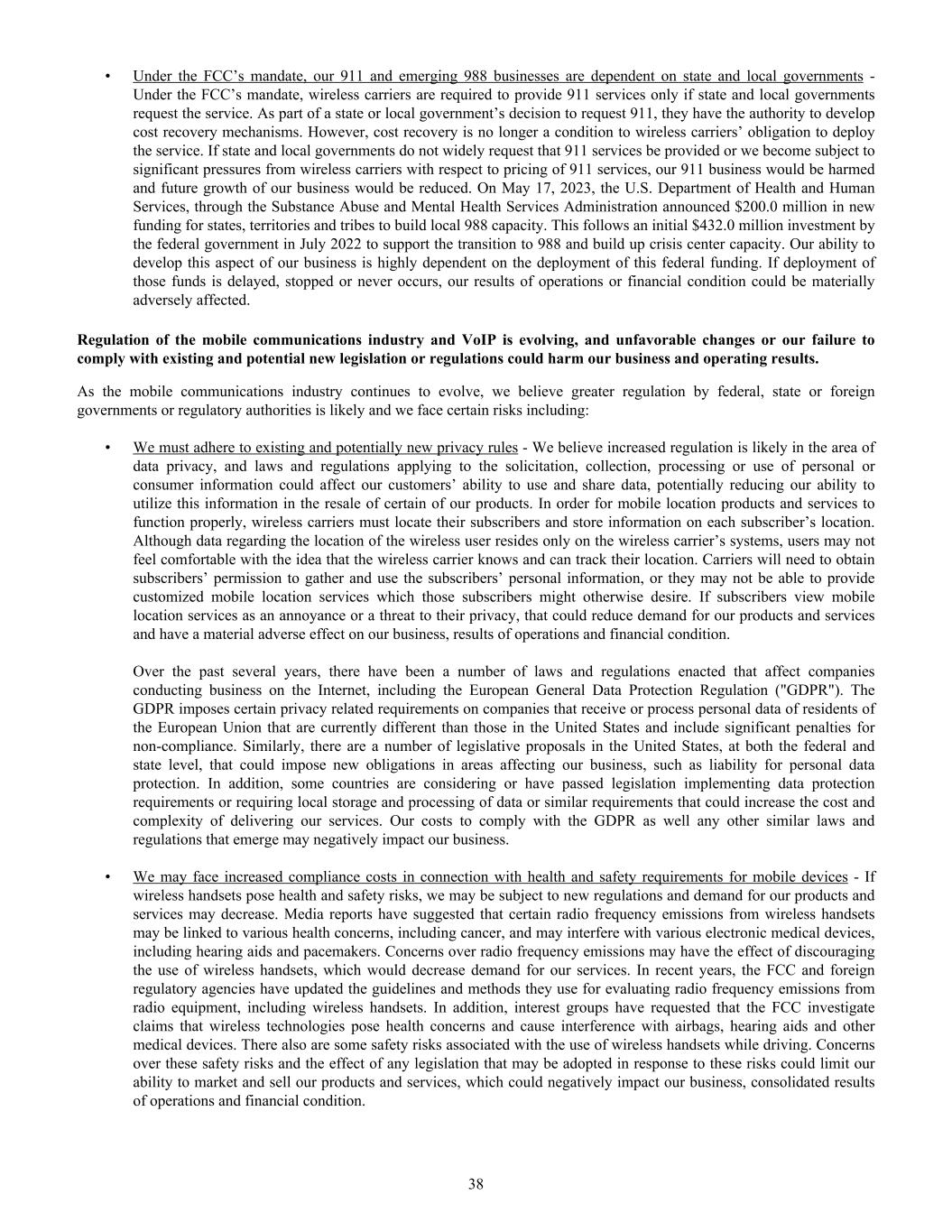
• Under the FCC’s mandate, our 911 and emerging 988 businesses are dependent on state and local governments - Under the FCC’s mandate, wireless carriers are required to provide 911 services only if state and local governments request the service. As part of a state or local government’s decision to request 911, they have the authority to develop cost recovery mechanisms. However, cost recovery is no longer a condition to wireless carriers’ obligation to deploy the service. If state and local governments do not widely request that 911 services be provided or we become subject to significant pressures from wireless carriers with respect to pricing of 911 services, our 911 business would be harmed and future growth of our business would be reduced. On May 17, 2023, the U.S. Department of Health and Human Services, through the Substance Abuse and Mental Health Services Administration announced $200.0 million in new funding for states, territories and tribes to build local 988 capacity. This follows an initial $432.0 million investment by the federal government in July 2022 to support the transition to 988 and build up crisis center capacity. Our ability to develop this aspect of our business is highly dependent on the deployment of this federal funding. If deployment of those funds is delayed, stopped or never occurs, our results of operations or financial condition could be materially adversely affected. Regulation of the mobile communications industry and VoIP is evolving, and unfavorable changes or our failure to comply with existing and potential new legislation or regulations could harm our business and operating results. As the mobile communications industry continues to evolve, we believe greater regulation by federal, state or foreign governments or regulatory authorities is likely and we face certain risks including: • We must adhere to existing and potentially new privacy rules - We believe increased regulation is likely in the area of data privacy, and laws and regulations applying to the solicitation, collection, processing or use of personal or consumer information could affect our customers’ ability to use and share data, potentially reducing our ability to utilize this information in the resale of certain of our products. In order for mobile location products and services to function properly, wireless carriers must locate their subscribers and store information on each subscriber’s location. Although data regarding the location of the wireless user resides only on the wireless carrier’s systems, users may not feel comfortable with the idea that the wireless carrier knows and can track their location. Carriers will need to obtain subscribers’ permission to gather and use the subscribers’ personal information, or they may not be able to provide customized mobile location services which those subscribers might otherwise desire. If subscribers view mobile location services as an annoyance or a threat to their privacy, that could reduce demand for our products and services and have a material adverse effect on our business, results of operations and financial condition. Over the past several years, there have been a number of laws and regulations enacted that affect companies conducting business on the Internet, including the European General Data Protection Regulation ("GDPR"). The GDPR imposes certain privacy related requirements on companies that receive or process personal data of residents of the European Union that are currently different than those in the United States and include significant penalties for non-compliance. Similarly, there are a number of legislative proposals in the United States, at both the federal and state level, that could impose new obligations in areas affecting our business, such as liability for personal data protection. In addition, some countries are considering or have passed legislation implementing data protection requirements or requiring local storage and processing of data or similar requirements that could increase the cost and complexity of delivering our services. Our costs to comply with the GDPR as well any other similar laws and regulations that emerge may negatively impact our business. • We may face increased compliance costs in connection with health and safety requirements for mobile devices - If wireless handsets pose health and safety risks, we may be subject to new regulations and demand for our products and services may decrease. Media reports have suggested that certain radio frequency emissions from wireless handsets may be linked to various health concerns, including cancer, and may interfere with various electronic medical devices, including hearing aids and pacemakers. Concerns over radio frequency emissions may have the effect of discouraging the use of wireless handsets, which would decrease demand for our services. In recent years, the FCC and foreign regulatory agencies have updated the guidelines and methods they use for evaluating radio frequency emissions from radio equipment, including wireless handsets. In addition, interest groups have requested that the FCC investigate claims that wireless technologies pose health concerns and cause interference with airbags, hearing aids and other medical devices. There also are some safety risks associated with the use of wireless handsets while driving. Concerns over these safety risks and the effect of any legislation that may be adopted in response to these risks could limit our ability to market and sell our products and services, which could negatively impact our business, consolidated results of operations and financial condition. 38

• The regulatory environment for VoIP services is developing - The FCC has determined that VoIP services are not subject to the same regulatory scheme as traditional wireline and wireless telephone services. If the regulatory environment for VoIP services evolves in a manner other than the way we anticipate, our 911 business would be significantly harmed and future growth of our business would be significantly reduced. For example, the regulatory scheme for wireless and wireline service providers requires those carriers to allow service providers such as us to have access to certain databases that make the delivery of a 911 call possible. No such requirements exist for VoIP service providers, so carriers could prevent us from continuing to provide VoIP 911 service by denying us access to the required databases. Ongoing compliance with the provisions of securities laws, related regulations and financial reporting standards could unexpectedly materially increase our costs and compliance related expenses. Because we are a publicly traded company, we are required to comply with provisions of securities laws, related regulations and financial reporting standards. Because securities laws, related regulations and financial reporting standards pertaining to our business are relatively complex, our business faces increased risks including the following: • If we identify a material weakness in the future, our costs may unexpectedly increase - Pursuant to Section 404 of the Sarbanes-Oxley Act of 2002 and related SEC rules, we are required to furnish a report of management’s assessment of the effectiveness of our internal controls as part of our Form 10-K. Our independent registered public accountants are required to attest to and provide a separate opinion. To issue our report, we document our internal control design and the testing processes that support our evaluation and conclusion, and then we test and evaluate the results. There can be no assurance, however, that we will be able to remediate material weaknesses, if any, that may be identified in future periods, or maintain all of the controls necessary for continued compliance. There likewise can be no assurance that we will be able to retain sufficient skilled finance and accounting personnel, especially in light of the increased demand for such personnel among publicly traded companies. • Stock-based compensation accounting standards could negatively impact our stock - Since our inception, we have used stock-based awards as a fundamental component of our employee compensation packages. We believe that stock- based awards directly motivate our employees to maximize long-term stockholder value and, through the use of long- term vesting, encourage employees to remain with us. We apply the provisions of ASC 718, "Compensation - Stock Compensation," which requires us to record compensation expense in our statement of operations for employee and director stock-based awards using a fair value method. In the first quarter of fiscal 2018, we adopted FASB ASU No. 2016-09 which modified certain aspects of ASC 718, including the requirement to recognize excess tax benefits and shortfalls in the income statement. The ongoing application of this standard will have a significant effect on our reported earnings, and could adversely impact our ability to provide accurate guidance on our future reported financial results due to the variability of the factors used to estimate the value of stock-based awards (including long-term performance shares which are subject to the achievement of three-year goals which are based on several performance metrics). The ongoing application of this standard could impact the future value of our common stock and may result in greater stock price volatility. To the extent that this accounting standard makes it less attractive to grant stock-based awards to employees, we may incur increased compensation costs, change our equity compensation strategy or find it difficult to attract, retain and motivate employees, each of which could have a material adverse effect on our business, results of operations and financial condition. Also, as further discussed in "Notes to Consolidated Financial Statements - Note (1) - Summary of Significant Accounting and Reporting Policies" included in "Part II - Item 8. Financial Statements and Supplementary Data," included in this Form 10-K, the accounting rules and regulations that we must comply with are complex and are continually changing in ways that could materially impact our financial statements. We must comply with these new rules on a go-forward basis. Because of the uncertainties of the estimates, judgments and assumptions associated with new accounting standards, as well as with any future guidance or interpretations related to them, we may incur additional costs and cannot provide any assurances that we will be able to comply with such complex rules. 39
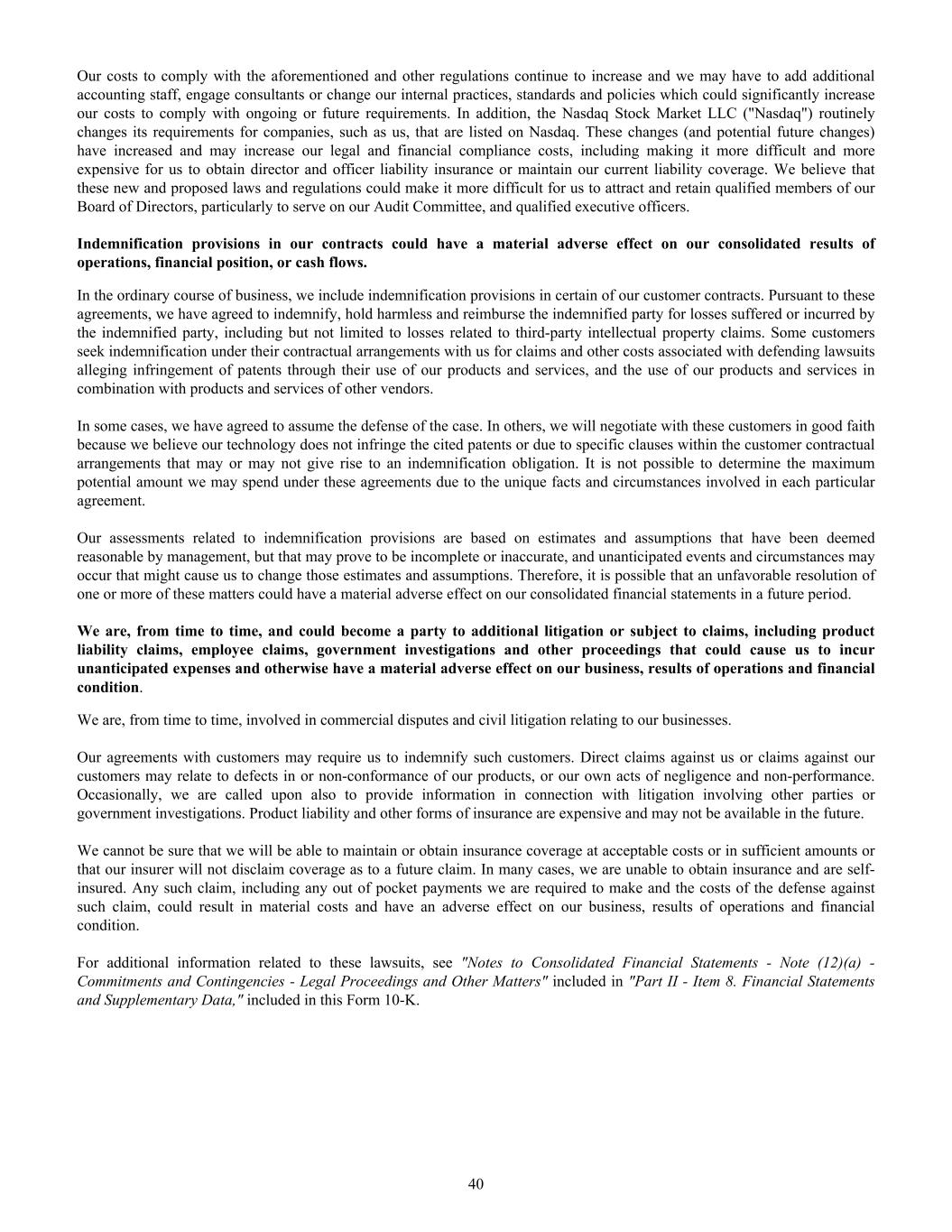
Our costs to comply with the aforementioned and other regulations continue to increase and we may have to add additional accounting staff, engage consultants or change our internal practices, standards and policies which could significantly increase our costs to comply with ongoing or future requirements. In addition, the Nasdaq Stock Market LLC ("Nasdaq") routinely changes its requirements for companies, such as us, that are listed on Nasdaq. These changes (and potential future changes) have increased and may increase our legal and financial compliance costs, including making it more difficult and more expensive for us to obtain director and officer liability insurance or maintain our current liability coverage. We believe that these new and proposed laws and regulations could make it more difficult for us to attract and retain qualified members of our Board of Directors, particularly to serve on our Audit Committee, and qualified executive officers. Indemnification provisions in our contracts could have a material adverse effect on our consolidated results of operations, financial position, or cash flows. In the ordinary course of business, we include indemnification provisions in certain of our customer contracts. Pursuant to these agreements, we have agreed to indemnify, hold harmless and reimburse the indemnified party for losses suffered or incurred by the indemnified party, including but not limited to losses related to third-party intellectual property claims. Some customers seek indemnification under their contractual arrangements with us for claims and other costs associated with defending lawsuits alleging infringement of patents through their use of our products and services, and the use of our products and services in combination with products and services of other vendors. In some cases, we have agreed to assume the defense of the case. In others, we will negotiate with these customers in good faith because we believe our technology does not infringe the cited patents or due to specific clauses within the customer contractual arrangements that may or may not give rise to an indemnification obligation. It is not possible to determine the maximum potential amount we may spend under these agreements due to the unique facts and circumstances involved in each particular agreement. Our assessments related to indemnification provisions are based on estimates and assumptions that have been deemed reasonable by management, but that may prove to be incomplete or inaccurate, and unanticipated events and circumstances may occur that might cause us to change those estimates and assumptions. Therefore, it is possible that an unfavorable resolution of one or more of these matters could have a material adverse effect on our consolidated financial statements in a future period. We are, from time to time, and could become a party to additional litigation or subject to claims, including product liability claims, employee claims, government investigations and other proceedings that could cause us to incur unanticipated expenses and otherwise have a material adverse effect on our business, results of operations and financial condition. We are, from time to time, involved in commercial disputes and civil litigation relating to our businesses. Our agreements with customers may require us to indemnify such customers. Direct claims against us or claims against our customers may relate to defects in or non-conformance of our products, or our own acts of negligence and non-performance. Occasionally, we are called upon also to provide information in connection with litigation involving other parties or government investigations. Product liability and other forms of insurance are expensive and may not be available in the future. We cannot be sure that we will be able to maintain or obtain insurance coverage at acceptable costs or in sufficient amounts or that our insurer will not disclaim coverage as to a future claim. In many cases, we are unable to obtain insurance and are self- insured. Any such claim, including any out of pocket payments we are required to make and the costs of the defense against such claim, could result in material costs and have an adverse effect on our business, results of operations and financial condition. For additional information related to these lawsuits, see "Notes to Consolidated Financial Statements - Note (12)(a) - Commitments and Contingencies - Legal Proceedings and Other Matters" included in "Part II - Item 8. Financial Statements and Supplementary Data," included in this Form 10-K. 40

Protection of our intellectual property is limited and pursuing infringers of our patents and other intellectual property rights can be costly. Our businesses rely, in large part, upon our proprietary scientific and engineering know-how and production techniques. We rely on a combination of patent, copyright, trademark, service mark, trade secret and unfair competition laws, restrictions in licensing agreements, confidentiality provisions and various other contractual provisions to protect our intellectual property and related proprietary rights, but these legal means provide only limited protection. We cannot guarantee that our issued and acquired patents will be upheld if challenged by another party. Additionally, with respect to any patent applications which we have filed, we cannot guarantee that any patents will be issued as a result of these applications. The departure of any of our key management and technical personnel, the breach of their confidentiality and non-disclosure obligations to us or the failure to achieve our intellectual property objectives could have an adverse effect on our business, results of operations and financial condition. Our ability to compete successfully and achieve future revenue growth will depend, in part, on our ability to protect our proprietary technology and operate without infringing upon the rights of others. We may fail to do so. In addition, the laws of certain countries in which our products are or may be sold may not protect our products or intellectual property rights to the same extent as the laws of the U.S. Our ability to protect our intellectual property rights is also subject to the terms of future government contracts. We cannot assure you that the federal government will not demand greater intellectual property rights or restrict our ability to disseminate intellectual property. We are also a member of standards-setting organizations and have agreed to license some of our intellectual property to other members on fair and reasonable terms to the extent that the license is required to develop non- infringing products. Pursuing infringers of our proprietary rights could result in significant litigation costs, and any failure to pursue infringers could result in our competitors utilizing our technology and offering similar products, potentially resulting in loss of a competitive advantage and decreased revenues. Despite our efforts to protect our proprietary rights, existing patent, copyright, trademark and trade secret laws afford only limited protection. In addition, the laws of some foreign countries do not protect our proprietary rights to the same extent as do the laws of the U.S. Protecting our know-how is difficult especially after our employees or those of our third-party contract service providers end their employment or engagement. Attempts may be made to copy or reverse-engineer aspects of our products or to obtain and use information that we regard as proprietary. Accordingly, we may not be able to prevent the misappropriation of our technology or prevent others from developing similar technology. Furthermore, policing the unauthorized use of our products is difficult and expensive. Litigation may be necessary in the future to enforce our intellectual property rights or to determine the validity and scope of the proprietary rights of others. The costs and diversion of resources could significantly harm our business. If we fail to protect our intellectual property, we may not receive any return on the resources expended to create the intellectual property or generate any competitive advantage based on it. Third parties may claim we are infringing their intellectual property rights and we could be prevented from selling our products, or suffer significant litigation expense, even if these claims have no merit. Our competitive position is driven in part by our intellectual property and other proprietary rights. Third parties, however, may claim that we, our products, operations or any products or technology we obtain from other parties are infringing their intellectual property rights, and we may be unaware of intellectual property rights of others that may impact some of our assets, technology and products. From time to time our customers are parties to allegations of intellectual property infringement claims based on our customers’ incorporation and use of our products and services, which may lead to demands from our customers for us to indemnify them for costs in defending those allegations. Any litigation regarding patents, trademarks, copyrights or intellectual property rights, even those without merit, and the related indemnification demands of our customers, can be costly and time consuming, and divert our management and key personnel from operating our business. The complexity of the technology involved, and inherent uncertainty and cost of intellectual property litigation increases our risks. If any third party has a meritorious or successful claim that we are infringing its intellectual property rights, we may be forced to change our products or enter into licensing arrangements with third parties that may include payment of a reasonable royalty, which may be costly or impractical. This also may require us to stop selling our products as currently engineered, which could harm our competitive position. We also may be subject to significant damages or injunctions that prevent the further development and sale of certain of our products or services and may result in a material loss of revenue. 41
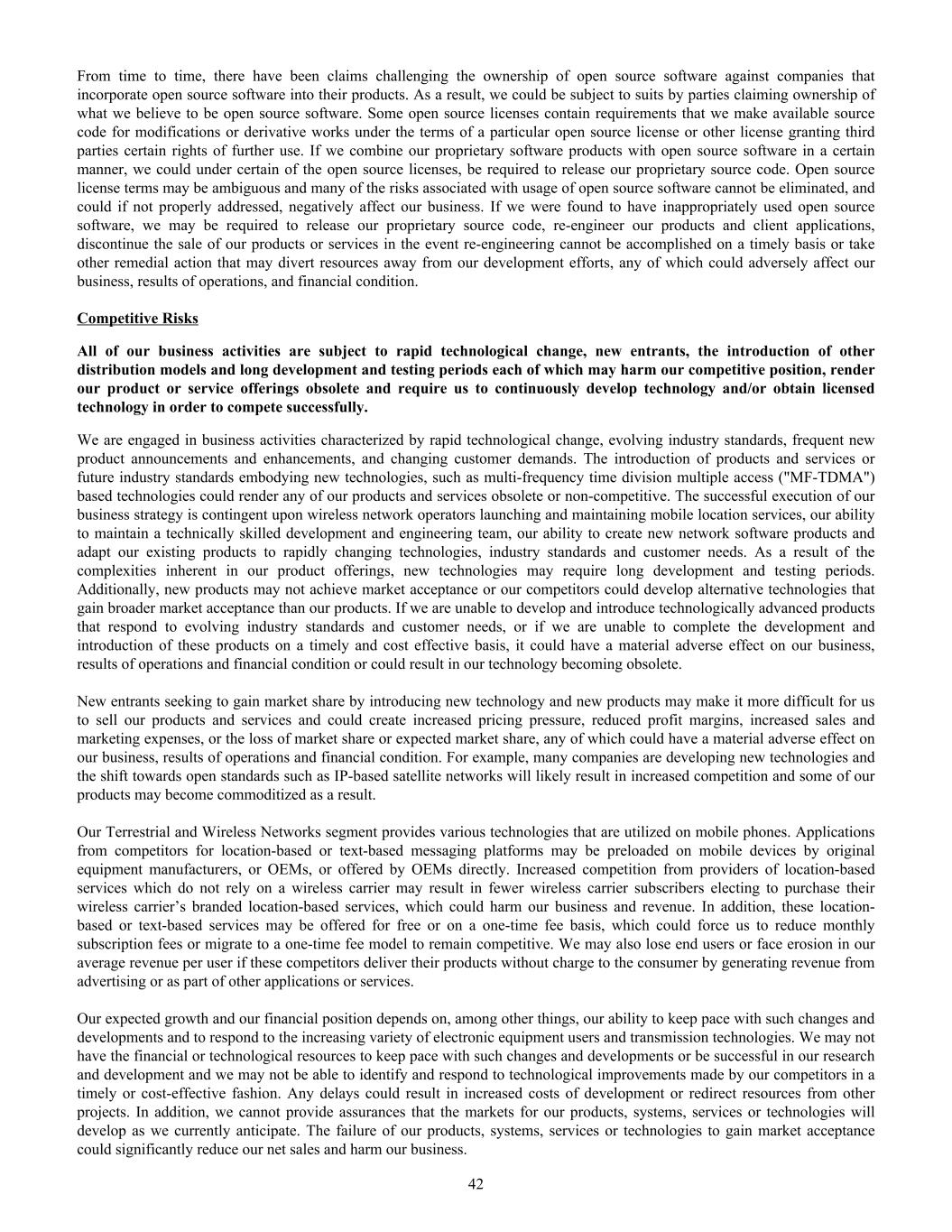
From time to time, there have been claims challenging the ownership of open source software against companies that incorporate open source software into their products. As a result, we could be subject to suits by parties claiming ownership of what we believe to be open source software. Some open source licenses contain requirements that we make available source code for modifications or derivative works under the terms of a particular open source license or other license granting third parties certain rights of further use. If we combine our proprietary software products with open source software in a certain manner, we could under certain of the open source licenses, be required to release our proprietary source code. Open source license terms may be ambiguous and many of the risks associated with usage of open source software cannot be eliminated, and could if not properly addressed, negatively affect our business. If we were found to have inappropriately used open source software, we may be required to release our proprietary source code, re-engineer our products and client applications, discontinue the sale of our products or services in the event re-engineering cannot be accomplished on a timely basis or take other remedial action that may divert resources away from our development efforts, any of which could adversely affect our business, results of operations, and financial condition. Competitive Risks All of our business activities are subject to rapid technological change, new entrants, the introduction of other distribution models and long development and testing periods each of which may harm our competitive position, render our product or service offerings obsolete and require us to continuously develop technology and/or obtain licensed technology in order to compete successfully. We are engaged in business activities characterized by rapid technological change, evolving industry standards, frequent new product announcements and enhancements, and changing customer demands. The introduction of products and services or future industry standards embodying new technologies, such as multi-frequency time division multiple access ("MF-TDMA") based technologies could render any of our products and services obsolete or non-competitive. The successful execution of our business strategy is contingent upon wireless network operators launching and maintaining mobile location services, our ability to maintain a technically skilled development and engineering team, our ability to create new network software products and adapt our existing products to rapidly changing technologies, industry standards and customer needs. As a result of the complexities inherent in our product offerings, new technologies may require long development and testing periods. Additionally, new products may not achieve market acceptance or our competitors could develop alternative technologies that gain broader market acceptance than our products. If we are unable to develop and introduce technologically advanced products that respond to evolving industry standards and customer needs, or if we are unable to complete the development and introduction of these products on a timely and cost effective basis, it could have a material adverse effect on our business, results of operations and financial condition or could result in our technology becoming obsolete. New entrants seeking to gain market share by introducing new technology and new products may make it more difficult for us to sell our products and services and could create increased pricing pressure, reduced profit margins, increased sales and marketing expenses, or the loss of market share or expected market share, any of which could have a material adverse effect on our business, results of operations and financial condition. For example, many companies are developing new technologies and the shift towards open standards such as IP-based satellite networks will likely result in increased competition and some of our products may become commoditized as a result. Our Terrestrial and Wireless Networks segment provides various technologies that are utilized on mobile phones. Applications from competitors for location-based or text-based messaging platforms may be preloaded on mobile devices by original equipment manufacturers, or OEMs, or offered by OEMs directly. Increased competition from providers of location-based services which do not rely on a wireless carrier may result in fewer wireless carrier subscribers electing to purchase their wireless carrier’s branded location-based services, which could harm our business and revenue. In addition, these location- based or text-based services may be offered for free or on a one-time fee basis, which could force us to reduce monthly subscription fees or migrate to a one-time fee model to remain competitive. We may also lose end users or face erosion in our average revenue per user if these competitors deliver their products without charge to the consumer by generating revenue from advertising or as part of other applications or services. Our expected growth and our financial position depends on, among other things, our ability to keep pace with such changes and developments and to respond to the increasing variety of electronic equipment users and transmission technologies. We may not have the financial or technological resources to keep pace with such changes and developments or be successful in our research and development and we may not be able to identify and respond to technological improvements made by our competitors in a timely or cost-effective fashion. Any delays could result in increased costs of development or redirect resources from other projects. In addition, we cannot provide assurances that the markets for our products, systems, services or technologies will develop as we currently anticipate. The failure of our products, systems, services or technologies to gain market acceptance could significantly reduce our net sales and harm our business. 42

Our business is highly competitive, we are reliant upon the success of our partners, and some of our competitors have significantly greater resources than we do, which could result in a loss of customers, market share and/or market acceptance. Our business is highly competitive. We will continue to invest in research and development for the introduction of new and enhanced products and services designed to improve capacity, data processing rates and features. We must also continue to develop new features and to improve functionality of our software. Research and development in our industry is complex, expensive and uncertain. We believe that we must continue to dedicate a significant amount of resources to research and development efforts to maintain our competitive position. If we continue to expend a significant amount of resources on research and development, but our efforts do not lead to the successful introduction of product and service enhancements more quickly than our competitors that are competitive in the marketplace, our business, results of operations and financial condition could be materially adversely affected. Several of our potential competitors are substantially larger than we are and have greater financial, technical and marketing resources than we do. In particular, larger competitors have certain advantages over us which could cause us to lose customers and impede our ability to attract new customers, including: larger bases of financial, technical, marketing, personnel and other resources; more established relationships with wireless carriers and government customers; more funds to deploy products and services; and the ability to lower prices of (or not charge any price for) competitive products and services because they are selling larger volumes. Furthermore, we cannot be sure that our competitors will not develop competing products, systems, services or technologies that gain market acceptance in advance of our products, systems, services or technologies, or that our competitors will not develop new products, systems, services or technologies that cause our existing products, systems, services or technologies to become non-competitive or obsolete, which could adversely affect our results of operations. Our Terrestrial and Wireless Networks segment provides public safety and location technologies to various state and local municipalities and to a large extent, we are reliant on the success of our wireless partners and distributors to meet our growth objectives. In some cases, our wireless partners may have different objectives, or our distributors may not be successful. We also began an evaluation and repositioning of certain of our location technology solutions within our Terrestrial and Wireless Networks segment in order to focus on providing higher-margin solution offerings and increase our penetration into the public safety space. To date, we have ceased offering certain location technology solutions, have worked with customers to wind- down certain legacy contracts and have not renewed certain contracts. Going forward, we intend to continue to work with our partners and expand our direct and indirect sales and distribution channels in this area. If we are not successful in doing so, we may not be able to achieve our long-term business goals. We rely upon various third-party companies and their technology to provide services to our customers and if we are unable to obtain such services at reasonable prices, or at all, our gross margins and our ability to provide the services of our wireless applications business could be materially adversely affected. We rely on various third-party companies and their technology in our business. Risks from our reliance with these third parties include: • The loss of mapping and third-party content - The wireless data services provided to our customers are dependent on real-time, continuous feeds from map data, points of interest data, traffic information, gas prices, theater, event and weather information from vendors and others. Any disruption of this third-party content from our satellite feeds or backup landline feeds or other disruption could result in delays in our subscribers’ ability to receive information. We obtain this data that we sell to our customers from companies owned by current and potential competitors, who may act in a manner that is not in our best interest. If our suppliers of this data or content were to enter into exclusive relationships with other providers of location-based services or were to discontinue providing such information and we were unable to replace them cost effectively, or at all, our ability to provide the services of our wireless applications business would be materially adversely affected. Our gross margins may also be materially adversely affected if the cost of third-party data and content increases substantially. 43

• Third-party data centers or third-party networks may fail - Many products and services of our advanced communication solutions, in particular our public safety and location technology solutions, are provided through a combination of our servers, which are hosted at third-party data centers, and on the networks, as well as within the data centers of our wireless carrier partners. Our business relies to a significant degree on the efficient and uninterrupted operation of the third-party data centers, customer data centers, and cloud providers we use. Network failures, disruptions or capacity constraints in our third-party data center facilities or in our servers maintained at their location could affect the performance of the products and services of our wireless applications and 911 business and harm our reputation and our revenue. The ability of our subscribers to receive critical location and business information requires timely and uninterrupted connections with our wireless network carriers. Any disruption from our satellite feeds or backup landline feeds could also result in delays in our subscribers’ ability to receive information. • We must integrate our technologies and routinely upgrade them - We may not be able to upgrade our location services platform to support certain advanced features and functionality without obtaining technology licenses from third parties. Obtaining these licenses may be costly and may delay the introduction of such features and functionality, and these licenses may not be available on commercially favorable terms, or at all. Problems and delays in development or delivery as a result of issues with respect to design, technology, licensing and patent rights, labor, learning curve assumptions, or materials and components could prevent us from achieving contractual obligations. In addition, our products cannot be tested and proven in all situations and are otherwise subject to unforeseen problems. The inability to offer advanced features or functionality, or a delay in our ability to upgrade our location-based services platform, may materially adversely affect demand for our products and services and, consequently, have a material adverse effect on our business, results of operations and financial condition. • We rely upon "open-source" software - We have incorporated some types of open-source software into our products, allowing us to enhance certain solutions without incurring substantial additional research and development costs. Thus far, we have encountered no unanticipated material problems arising from our use of open-source software. However, as the use of open-source software becomes more widespread, certain open-source technology could become competitive with our proprietary technology, which could cause sales of our products to decline or force us to reduce the fees we charge for our products, which could have a material adverse effect on our business, results of operations and financial condition. Because our software may contain defects or errors, and our hardware products may incorporate defective components, our sales could decrease if these defects or errors adversely affect our reputation or delay shipments of our products. Products as complex as ours are likely to contain undetected errors or defects, especially when first introduced or when new versions are released. Software products, such as our 911 call handling software solutions, must meet stringent customer technical requirements and we must satisfy our warranty obligations to our customers. Our hardware products are also subject to warranty obligations and integrate a wide variety of components from different vendors. Our products including software may not be error or defect free after delivery to customers, which could damage our reputation, cause revenue losses, result in the rejection of our products or services, divert development resources and increase service and warranty costs, each of which could have a material adverse effect on our business, results of operations and financial condition. Risks Related to our Common Stock Our stock price is volatile. The stock market in general and the stock prices of technology-based companies, in particular, experience extreme volatility that often is unrelated to the operating performance of any specific public company. The market price of our common stock has fluctuated significantly in the past and is likely to fluctuate significantly in the future as well. Factors that could have a significant impact on the market price of our stock include, among others: • strategic transactions, such as acquisitions and divestures by us and our competitors; • our ability to successfully integrate and manage recent acquisitions; • our issuance of potentially dilutive equity or equity-type securities; • our issuance of debt; • our ability to successfully access equity and debt capital markets; • future announcements concerning us or our competitors; • shareholder activism involving our common stock, board of directors or corporate governance; 44

• receipt or non-receipt of substantial orders for products and services; • quality deficiencies in services or products; • results of technological innovations and new commercial products; • changes in recommendations of securities analysts; • government regulations; • changes in the status or outcome of government audits; • proprietary rights or product or patent litigation; • changes in U.S. government policies; • changes in economic conditions generally, particularly in the terrestrial and wireless networks and satellite and space communications markets; • changes in securities market conditions, generally; • changes in prevailing interest rates; • changes in the status of litigation and legal matters (including changes in the status of export matters); • cyber attacks; • energy blackouts; • acts of terrorism or war; • inflation or deflation; • rumors or allegations regarding our financial disclosures or practices; and • potential resurgences of the COVID-19 or similar pandemics. Shortfalls in our sales or earnings in any given period relative to the levels expected by securities analysts could immediately, significantly and adversely affect the trading price of our common stock. Future issuances of our shares of common stock could dilute a stockholder's ownership interest in Comtech and reduce the market price of our shares of common stock. In addition to potential issuances of our shares of common stock associated with acquisitions, in the future, we may issue additional securities to raise capital. We may also acquire interests in other companies by using a combination of cash and our common stock or just our common stock. We may also issue securities convertible into our common stock. Any of these events may dilute a stockholder's ownership interest in Comtech and have an adverse impact on the price of our common stock. Actions of activist stockholders could impact the pursuit of our business strategies and adversely affect our results of operations, financial condition and/or share price. Our Board of Directors and management team value constructive input from investors, regularly engage in dialogue with our stockholders, and are committed to acting in the best interests of all of our stockholders; however, we have been, and may in the future be, subject to actions, campaigns, or proposals that may not align with our business strategies or the interests of our other stockholders. Accordingly, there is no assurance that the actions taken by the Board of Directors and management in seeking to maintain constructive engagement with certain stockholders will be successful in preventing the occurrence of stockholder activist campaigns. Campaigns by activist stockholders to effect changes at publicly traded companies often demand that companies undertake or pursue financial restructuring, increase debt, issue special dividends, repurchase shares, or undertake sales of assets or other transactions, including strategic transactions. Campaigns may also be initiated by activist stockholders advocating for particular environmental or social causes. Activist stockholders who disagree with the composition of a company’s board of directors, or with its strategy and/or management often seek to involve themselves in the governance and strategic direction of a company through various activities. As discussed elsewhere in this report, we have been, and may in the future be, subject to activities and campaigns initiated by activist stockholders. Responding to proxy contests and other actions by activist stockholders can be costly and time-consuming, and could divert the attention of our Board of Directors, management team and employees from the management of our operations and the pursuit of our business strategies. Further, actions of activist stockholders may cause significant fluctuations in our stock price based on temporary or speculative market perceptions or other factors that do not necessarily reflect the underlying fundamentals and prospects of our business. Perceived uncertainties as to our future direction, strategy or leadership created as a consequence of activist stockholder campaigns or initiatives may result in the loss of potential business opportunities and make it more difficult to attract and retain investors, customers, employees, and other business partners. Also, we could be required to incur significant expenses related to any activist stockholder matters (included but not limited to legal fees, fees for financial 45
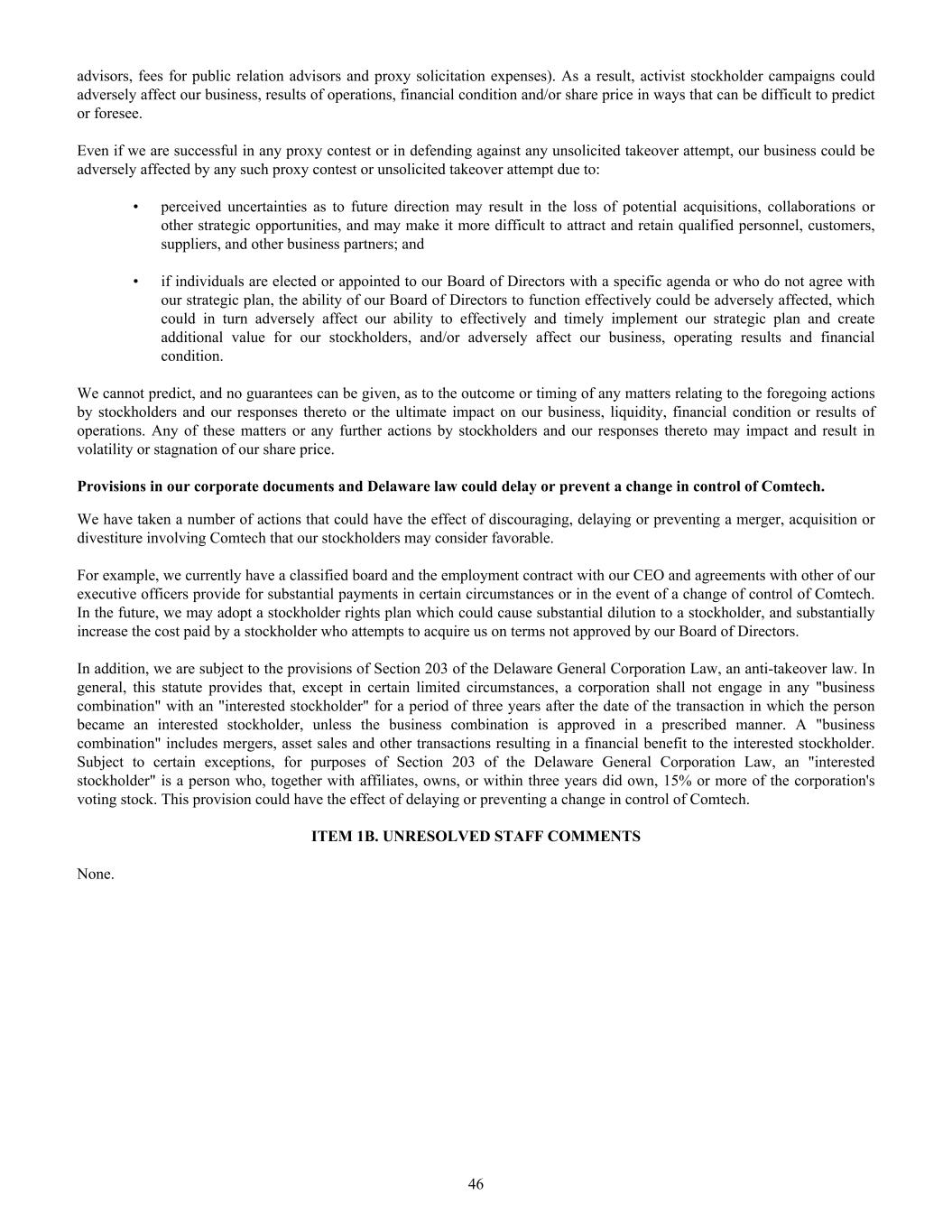
advisors, fees for public relation advisors and proxy solicitation expenses). As a result, activist stockholder campaigns could adversely affect our business, results of operations, financial condition and/or share price in ways that can be difficult to predict or foresee. Even if we are successful in any proxy contest or in defending against any unsolicited takeover attempt, our business could be adversely affected by any such proxy contest or unsolicited takeover attempt due to: • perceived uncertainties as to future direction may result in the loss of potential acquisitions, collaborations or other strategic opportunities, and may make it more difficult to attract and retain qualified personnel, customers, suppliers, and other business partners; and • if individuals are elected or appointed to our Board of Directors with a specific agenda or who do not agree with our strategic plan, the ability of our Board of Directors to function effectively could be adversely affected, which could in turn adversely affect our ability to effectively and timely implement our strategic plan and create additional value for our stockholders, and/or adversely affect our business, operating results and financial condition. We cannot predict, and no guarantees can be given, as to the outcome or timing of any matters relating to the foregoing actions by stockholders and our responses thereto or the ultimate impact on our business, liquidity, financial condition or results of operations. Any of these matters or any further actions by stockholders and our responses thereto may impact and result in volatility or stagnation of our share price. Provisions in our corporate documents and Delaware law could delay or prevent a change in control of Comtech. We have taken a number of actions that could have the effect of discouraging, delaying or preventing a merger, acquisition or divestiture involving Comtech that our stockholders may consider favorable. For example, we currently have a classified board and the employment contract with our CEO and agreements with other of our executive officers provide for substantial payments in certain circumstances or in the event of a change of control of Comtech. In the future, we may adopt a stockholder rights plan which could cause substantial dilution to a stockholder, and substantially increase the cost paid by a stockholder who attempts to acquire us on terms not approved by our Board of Directors. In addition, we are subject to the provisions of Section 203 of the Delaware General Corporation Law, an anti-takeover law. In general, this statute provides that, except in certain limited circumstances, a corporation shall not engage in any "business combination" with an "interested stockholder" for a period of three years after the date of the transaction in which the person became an interested stockholder, unless the business combination is approved in a prescribed manner. A "business combination" includes mergers, asset sales and other transactions resulting in a financial benefit to the interested stockholder. Subject to certain exceptions, for purposes of Section 203 of the Delaware General Corporation Law, an "interested stockholder" is a person who, together with affiliates, owns, or within three years did own, 15% or more of the corporation's voting stock. This provision could have the effect of delaying or preventing a change in control of Comtech. ITEM 1B. UNRESOLVED STAFF COMMENTS None. 46
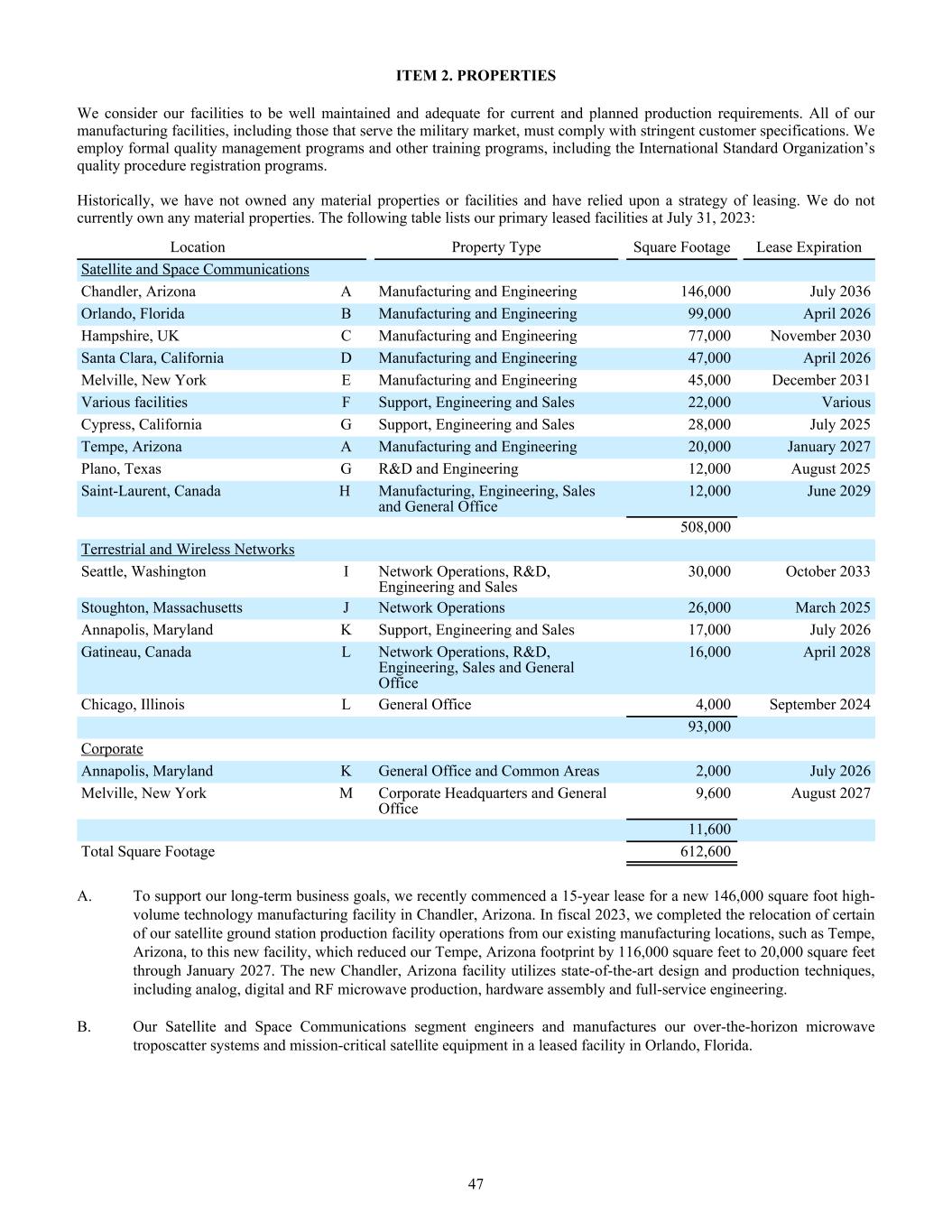
ITEM 2. PROPERTIES We consider our facilities to be well maintained and adequate for current and planned production requirements. All of our manufacturing facilities, including those that serve the military market, must comply with stringent customer specifications. We employ formal quality management programs and other training programs, including the International Standard Organization’s quality procedure registration programs. Historically, we have not owned any material properties or facilities and have relied upon a strategy of leasing. We do not currently own any material properties. The following table lists our primary leased facilities at July 31, 2023: Location Property Type Square Footage Lease Expiration Satellite and Space Communications Chandler, Arizona A Manufacturing and Engineering 146,000 July 2036 Orlando, Florida B Manufacturing and Engineering 99,000 April 2026 Hampshire, UK C Manufacturing and Engineering 77,000 November 2030 Santa Clara, California D Manufacturing and Engineering 47,000 April 2026 Melville, New York E Manufacturing and Engineering 45,000 December 2031 Various facilities F Support, Engineering and Sales 22,000 Various Cypress, California G Support, Engineering and Sales 28,000 July 2025 Tempe, Arizona A Manufacturing and Engineering 20,000 January 2027 Plano, Texas G R&D and Engineering 12,000 August 2025 Saint-Laurent, Canada H Manufacturing, Engineering, Sales and General Office 12,000 June 2029 508,000 Terrestrial and Wireless Networks Seattle, Washington I Network Operations, R&D, Engineering and Sales 30,000 October 2033 Stoughton, Massachusetts J Network Operations 26,000 March 2025 Annapolis, Maryland K Support, Engineering and Sales 17,000 July 2026 Gatineau, Canada L Network Operations, R&D, Engineering, Sales and General Office 16,000 April 2028 Chicago, Illinois L General Office 4,000 September 2024 93,000 Corporate Annapolis, Maryland K General Office and Common Areas 2,000 July 2026 Melville, New York M Corporate Headquarters and General Office 9,600 August 2027 11,600 Total Square Footage 612,600 A. To support our long-term business goals, we recently commenced a 15-year lease for a new 146,000 square foot high- volume technology manufacturing facility in Chandler, Arizona. In fiscal 2023, we completed the relocation of certain of our satellite ground station production facility operations from our existing manufacturing locations, such as Tempe, Arizona, to this new facility, which reduced our Tempe, Arizona footprint by 116,000 square feet to 20,000 square feet through January 2027. The new Chandler, Arizona facility utilizes state-of-the-art design and production techniques, including analog, digital and RF microwave production, hardware assembly and full-service engineering. B. Our Satellite and Space Communications segment engineers and manufactures our over-the-horizon microwave troposcatter systems and mission-critical satellite equipment in a leased facility in Orlando, Florida. 47
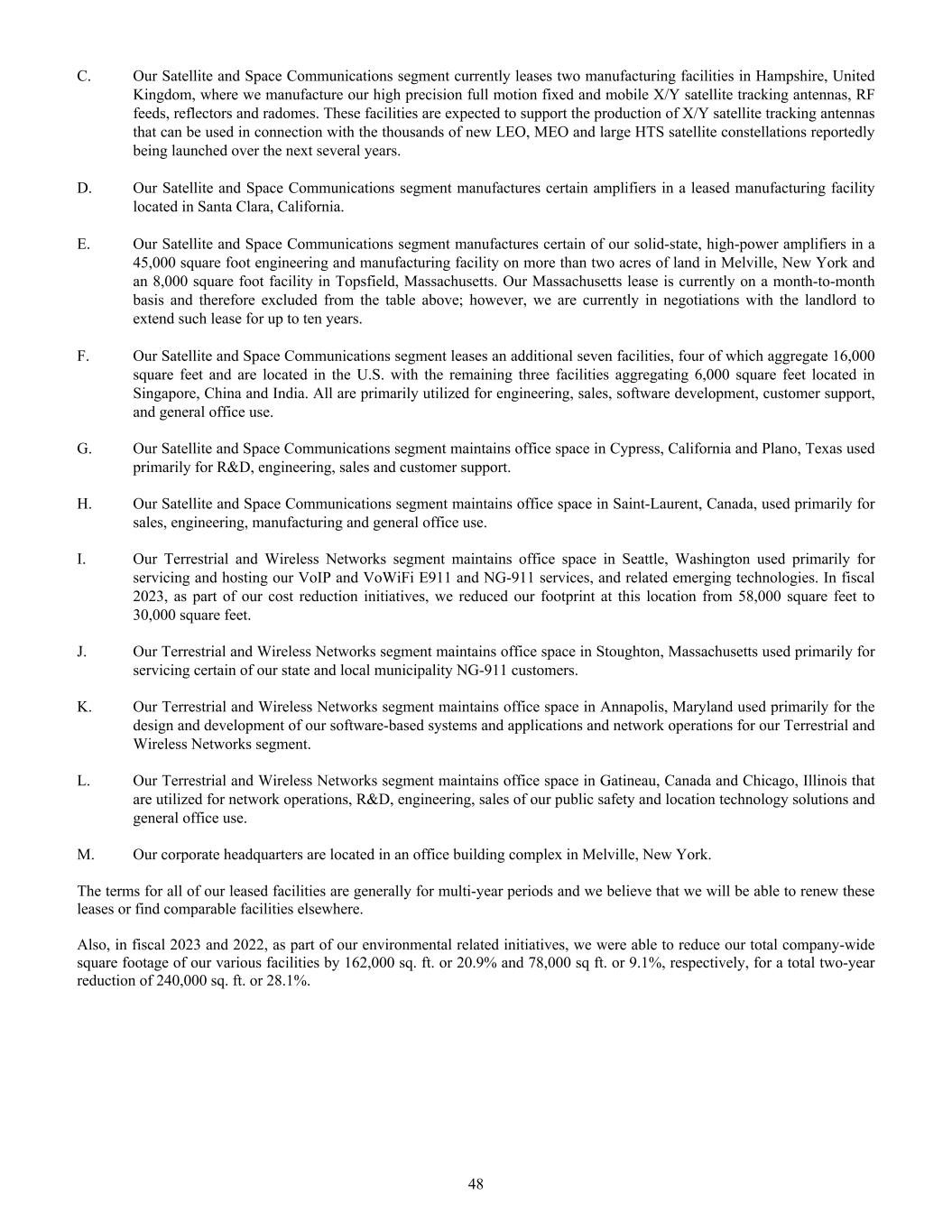
C. Our Satellite and Space Communications segment currently leases two manufacturing facilities in Hampshire, United Kingdom, where we manufacture our high precision full motion fixed and mobile X/Y satellite tracking antennas, RF feeds, reflectors and radomes. These facilities are expected to support the production of X/Y satellite tracking antennas that can be used in connection with the thousands of new LEO, MEO and large HTS satellite constellations reportedly being launched over the next several years. D. Our Satellite and Space Communications segment manufactures certain amplifiers in a leased manufacturing facility located in Santa Clara, California. E. Our Satellite and Space Communications segment manufactures certain of our solid-state, high-power amplifiers in a 45,000 square foot engineering and manufacturing facility on more than two acres of land in Melville, New York and an 8,000 square foot facility in Topsfield, Massachusetts. Our Massachusetts lease is currently on a month-to-month basis and therefore excluded from the table above; however, we are currently in negotiations with the landlord to extend such lease for up to ten years. F. Our Satellite and Space Communications segment leases an additional seven facilities, four of which aggregate 16,000 square feet and are located in the U.S. with the remaining three facilities aggregating 6,000 square feet located in Singapore, China and India. All are primarily utilized for engineering, sales, software development, customer support, and general office use. G. Our Satellite and Space Communications segment maintains office space in Cypress, California and Plano, Texas used primarily for R&D, engineering, sales and customer support. H. Our Satellite and Space Communications segment maintains office space in Saint-Laurent, Canada, used primarily for sales, engineering, manufacturing and general office use. I. Our Terrestrial and Wireless Networks segment maintains office space in Seattle, Washington used primarily for servicing and hosting our VoIP and VoWiFi E911 and NG-911 services, and related emerging technologies. In fiscal 2023, as part of our cost reduction initiatives, we reduced our footprint at this location from 58,000 square feet to 30,000 square feet. J. Our Terrestrial and Wireless Networks segment maintains office space in Stoughton, Massachusetts used primarily for servicing certain of our state and local municipality NG-911 customers. K. Our Terrestrial and Wireless Networks segment maintains office space in Annapolis, Maryland used primarily for the design and development of our software-based systems and applications and network operations for our Terrestrial and Wireless Networks segment. L. Our Terrestrial and Wireless Networks segment maintains office space in Gatineau, Canada and Chicago, Illinois that are utilized for network operations, R&D, engineering, sales of our public safety and location technology solutions and general office use. M. Our corporate headquarters are located in an office building complex in Melville, New York. The terms for all of our leased facilities are generally for multi-year periods and we believe that we will be able to renew these leases or find comparable facilities elsewhere. Also, in fiscal 2023 and 2022, as part of our environmental related initiatives, we were able to reduce our total company-wide square footage of our various facilities by 162,000 sq. ft. or 20.9% and 78,000 sq ft. or 9.1%, respectively, for a total two-year reduction of 240,000 sq. ft. or 28.1%. 48
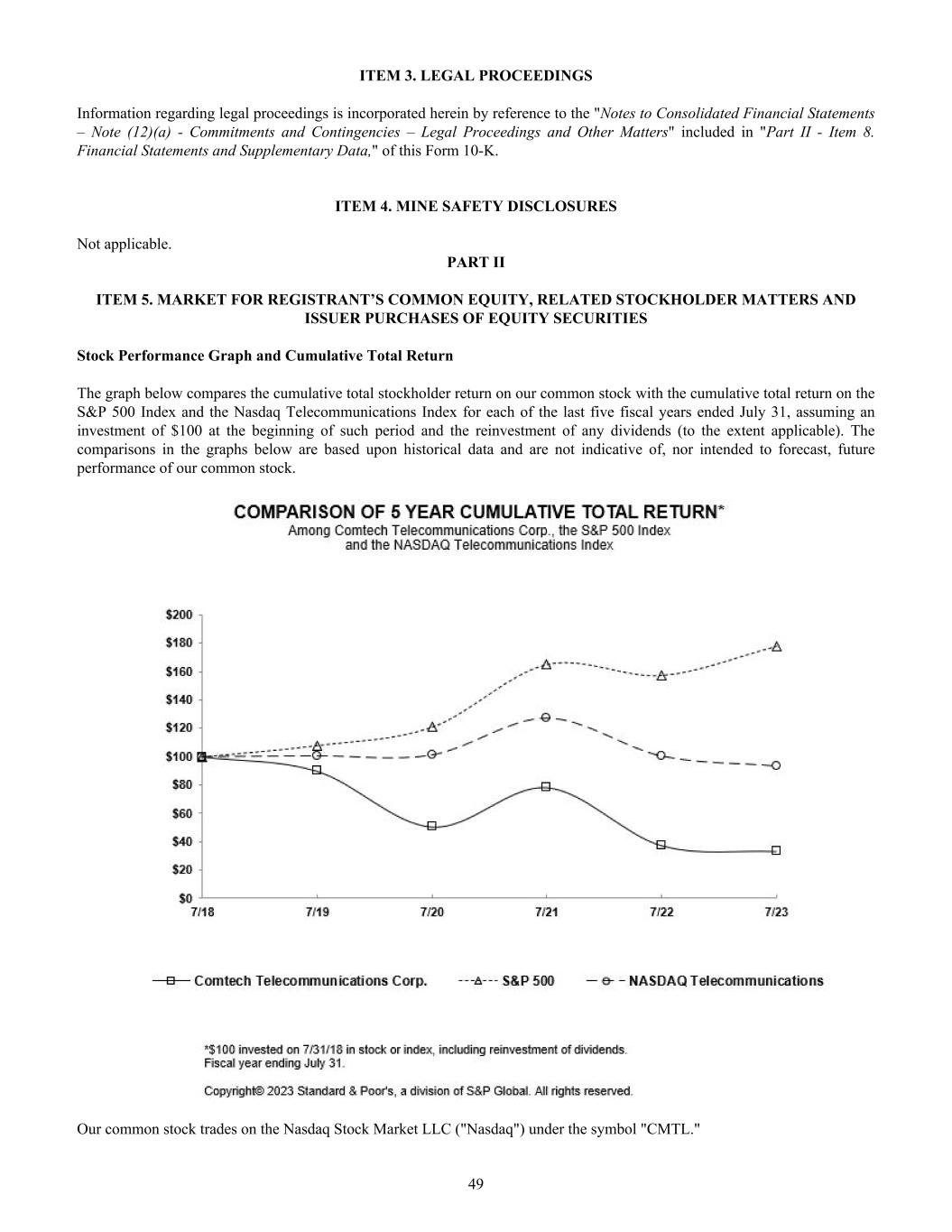
ITEM 3. LEGAL PROCEEDINGS Information regarding legal proceedings is incorporated herein by reference to the "Notes to Consolidated Financial Statements – Note (12)(a) - Commitments and Contingencies – Legal Proceedings and Other Matters" included in "Part II - Item 8. Financial Statements and Supplementary Data," of this Form 10-K. ITEM 4. MINE SAFETY DISCLOSURES Not applicable. PART II ITEM 5. MARKET FOR REGISTRANT’S COMMON EQUITY, RELATED STOCKHOLDER MATTERS AND ISSUER PURCHASES OF EQUITY SECURITIES Stock Performance Graph and Cumulative Total Return The graph below compares the cumulative total stockholder return on our common stock with the cumulative total return on the S&P 500 Index and the Nasdaq Telecommunications Index for each of the last five fiscal years ended July 31, assuming an investment of $100 at the beginning of such period and the reinvestment of any dividends (to the extent applicable). The comparisons in the graphs below are based upon historical data and are not indicative of, nor intended to forecast, future performance of our common stock. Our common stock trades on the Nasdaq Stock Market LLC ("Nasdaq") under the symbol "CMTL." 49
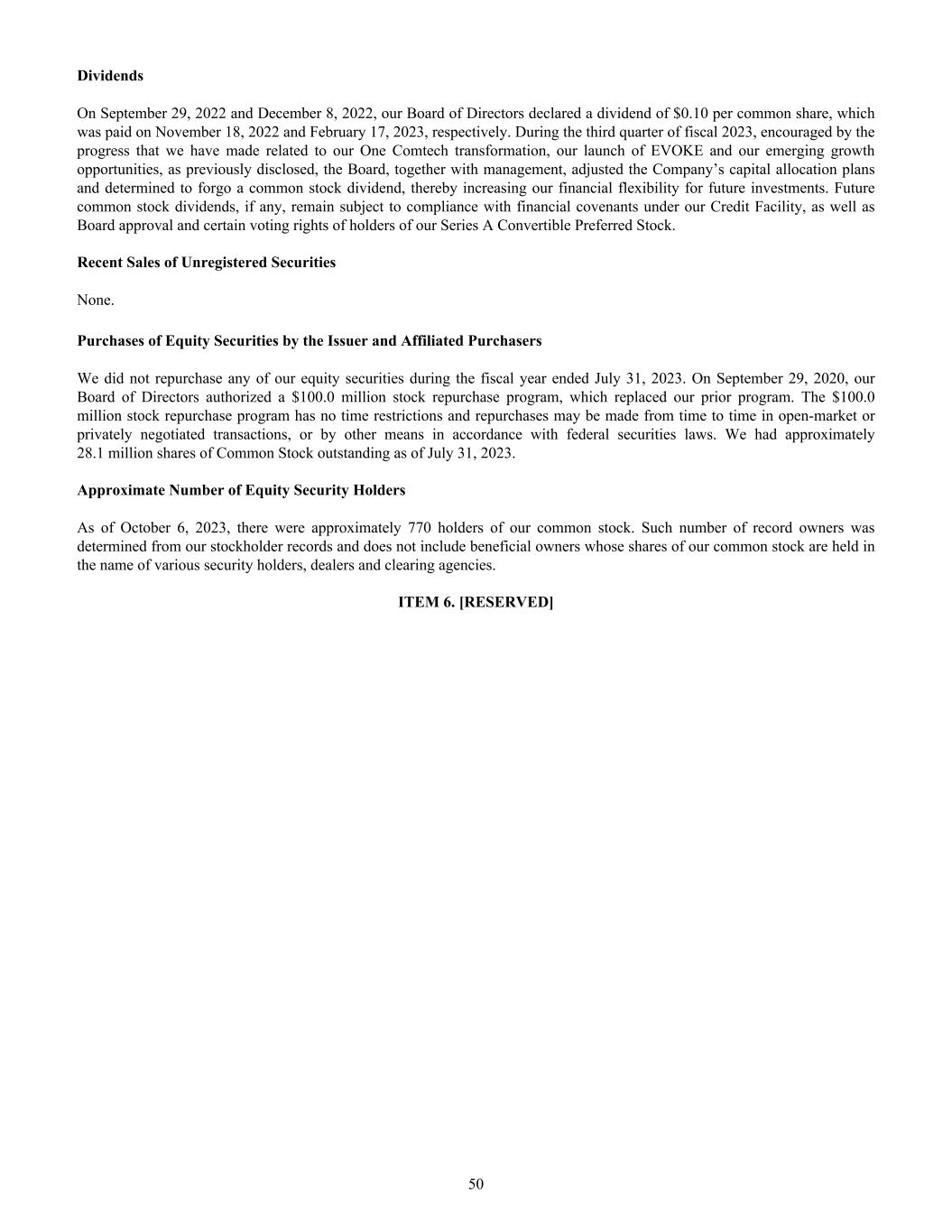
Dividends On September 29, 2022 and December 8, 2022, our Board of Directors declared a dividend of $0.10 per common share, which was paid on November 18, 2022 and February 17, 2023, respectively. During the third quarter of fiscal 2023, encouraged by the progress that we have made related to our One Comtech transformation, our launch of EVOKE and our emerging growth opportunities, as previously disclosed, the Board, together with management, adjusted the Company’s capital allocation plans and determined to forgo a common stock dividend, thereby increasing our financial flexibility for future investments. Future common stock dividends, if any, remain subject to compliance with financial covenants under our Credit Facility, as well as Board approval and certain voting rights of holders of our Series A Convertible Preferred Stock. Recent Sales of Unregistered Securities None. Purchases of Equity Securities by the Issuer and Affiliated Purchasers We did not repurchase any of our equity securities during the fiscal year ended July 31, 2023. On September 29, 2020, our Board of Directors authorized a $100.0 million stock repurchase program, which replaced our prior program. The $100.0 million stock repurchase program has no time restrictions and repurchases may be made from time to time in open-market or privately negotiated transactions, or by other means in accordance with federal securities laws. We had approximately 28.1 million shares of Common Stock outstanding as of July 31, 2023. Approximate Number of Equity Security Holders As of October 6, 2023, there were approximately 770 holders of our common stock. Such number of record owners was determined from our stockholder records and does not include beneficial owners whose shares of our common stock are held in the name of various security holders, dealers and clearing agencies. ITEM 6. [RESERVED] 50

ITEM 7. MANAGEMENT'S DISCUSSION AND ANALYSIS OF FINANCIAL CONDITION AND RESULTS OF OPERATIONS Overview of Business We are a leading global provider of next-generation 911 emergency systems ("NG-911") and secure wireless and satellite communications technologies. This includes the critical communications infrastructure that people, businesses, and governments rely on when durable, trusted connectivity is required, no matter where they are – on land, at sea, or in the air – and no matter what the circumstances – from armed conflict to a natural disaster. Our solutions are designed to fulfill our customers’ needs for secure wireless communications in the most demanding environments, including those where traditional communications are unavailable or cost-prohibitive, and in mission-critical and other scenarios where performance is crucial. We anticipate future growth in our business due to a trend of increasing demand for global voice, video and data usage in recent years, in addition to the growth of 988 networks. We provide our solutions to both commercial and governmental customers. We manage our business through two reportable operating segments: • Satellite and Space Communications - is organized into four technology areas: satellite modem and amplifier technologies; troposcatter and SATCOM solutions; space components and antennas; and high-power amplifiers and switch technologies. This segment offers customers: satellite ground station technologies, services and system integration that facilitate the transmission of voice, video and data over GEO, MEO and LEO satellite constellations, including solid-state and traveling wave tube power amplifiers, modems, VSAT platforms and frequency converters; satellite communications and tracking antenna systems, including high precision full motion fixed and mobile X/Y tracking antennas, RF feeds, reflectors and radomes; over-the-horizon microwave troposcatter equipment that can transmit digitized voice, video, and data over distances up to 200 miles using the troposphere and diffraction, including the Comtech COMET™; solid-state, RF microwave high-power amplifiers and control components designed for radar, electronic warfare, data link, medical and aviation applications; and procurement and supply chain management of high reliability Electrical, Electronic and Electromechanical ("EEE") parts for satellite, launch vehicle and manned space applications. • Terrestrial and Wireless Networks - is organized into three service areas: next generation 911 and call delivery, Solacom call handling solutions, and trusted location and messaging solutions. This segment offers customers SMS text to 911 services, providing alternate paths for individuals who need to request assistance (via text messaging) a method to reach Public Safety Answering Points ("PSAPs"); next generation 911 solutions, providing emergency call routing, location validation, policy-based routing rules, logging and security functionality; Emergency Services IP Network transport infrastructure for emergency services communications and support of next generation 911 services; call handling applications for PSAPs; wireless emergency alerts solutions for network operators; and software and equipment for location-based and text messaging services for various applications, including for public safety, commercial and government services. Our Quarterly Financial Information Quarterly and period-to-period sales and operating results may be significantly affected by either short-term or long-term contracts with our customers. In addition, our gross profit is affected by a variety of factors, including the mix of products, systems and services sold, production efficiencies, estimates of warranty expense, price competition and general economic conditions. Our gross profit may also be affected by the impact of any cumulative adjustments to contracts that are accounted for over time. In particular our contracts with the U.S. government can be terminated for convenience by it at any time and orders are subject to unpredictable funding, deployment and technology decisions by the U.S. government. Some of these contracts are indefinite delivery/indefinite quantity ("IDIQ") contracts and, as such, the U.S. government is not obligated to purchase any equipment or services under these contracts. We have, in the past, experienced and we continue to expect significant fluctuations in sales and operating results from quarter-to-quarter and period-to-period due to these factors. As such, comparisons between periods and our current results may not be indicative of a trend or future performance. 51

Critical Accounting Policies We consider certain accounting policies to be critical due to the estimation process involved in each. Revenue Recognition. In accordance with FASB ASC 606 - Revenue from Contracts with Customers ("ASC 606"), we record revenue in an amount that reflects the consideration to which we expect to be entitled in exchange for goods or services promised to customers. See "Notes to Consolidated Financial Statements - Note (1)(c) - Revenue Recognition" included in "Part II - Item 8. Financial Statements and Supplementary Data," (which discussion is incorporated herein by reference), included in this Form 10-K, for further information. Impairment of Goodwill and Other Intangible Assets. As of July 31, 2023, total goodwill recorded on our Consolidated Balance Sheet aggregated $347.7 million (of which $173.6 million relates to our Satellite and Space Communications segment and $174.1 million relates to our Terrestrial and Wireless Networks segment). Additionally, as of July 31, 2023, net intangibles recorded on our Consolidated Balance Sheet aggregated $225.9 million (of which $65.1 million relates to our Satellite and Space Communications segment and $160.8 million relates to our Terrestrial and Wireless Networks segment). For purposes of reviewing impairment and the recoverability of goodwill and other intangible assets, our Satellite and Space Communications and Terrestrial and Wireless Networks segments each constitute a reporting unit and we must make various assumptions in determining their estimated fair values. See "Notes to Consolidated Financial Statements - Note (13) - Goodwill and Note (14) - Intangible Assets" included in "Part II - Item 8. Financial Statements and Supplementary Data," (which discussion is incorporated herein by reference), included in this Form 10-K, for further information. Provision for Warranty Obligations. We provide warranty coverage for most of our products, including products under long- term contracts, for a period of at least one year from the date of shipment. We record a liability for estimated warranty expense based on historical claims, product failure rates and other factors. Costs associated with some of our warranties that are provided under long-term contracts are incorporated into our estimates of total contract costs. There exist inherent risks and uncertainties in estimating warranty expenses, particularly on larger or longer-term contracts. If we do not accurately estimate our warranty costs, any changes to our original estimates could be material to our results of operations and financial condition. Accounting for Income Taxes. Our deferred tax assets and liabilities are determined based on temporary differences between financial reporting and tax bases of assets and liabilities and applying enacted tax rates expected to be in effect for the year in which we expect the differences to reverse. Our provision for income taxes is based on domestic (including federal, state and local) and international statutory income tax rates in the tax jurisdictions where we operate, permanent differences between financial reporting and tax reporting and available credits and incentives. We recognize potential interest and penalties related to uncertain tax positions in income tax expense. The U.S. federal government is our most significant income tax jurisdiction. Significant judgment is required in determining income tax provisions and tax positions. We may be challenged upon review by the applicable taxing authority and positions taken by us may not be sustained. We recognize all or a portion of the benefit of income tax positions only when we have made a determination that it is "more likely than not" that the tax position will be sustained upon examination, based upon the technical merits of the position and other factors. For tax positions that are determined as "more likely than not" to be sustained upon examination, the tax benefit recognized is the largest amount of benefit that is greater than 50% likely of being realized upon ultimate settlement. The development of valuation allowances for deferred tax assets and reserves for income tax positions requires consideration of timing and judgments about future taxable income, tax issues and potential outcomes, and are subjective critical estimates. Valuation allowances are established, when necessary, to reduce net deferred tax assets to the amount "more likely than not" expected to be realized. A portion of our deferred tax assets consist of federal research and experimentation tax credit carryforwards, some of which was acquired in connection with prior acquisitions. No valuation allowance has been established on these deferred tax assets based on our evaluation that our ability to realize such assets has met the criteria of "more likely than not." We continuously evaluate additional facts representing positive and negative evidence in determining our ability to realize these deferred tax assets. In certain circumstances, the ultimate outcome of exposures and risks involves significant uncertainties. If actual outcomes differ materially from these estimates, they could have a material impact on our results of operations and financial condition. Our U.S. federal income tax returns for fiscal 2020 through 2022 are subject to potential future Internal Revenue Service ("IRS") audit. None of our state income tax returns prior to fiscal 2019 are subject to audit. Future tax assessments or settlements could have a material adverse effect on our consolidated results of operations and financial condition. 52
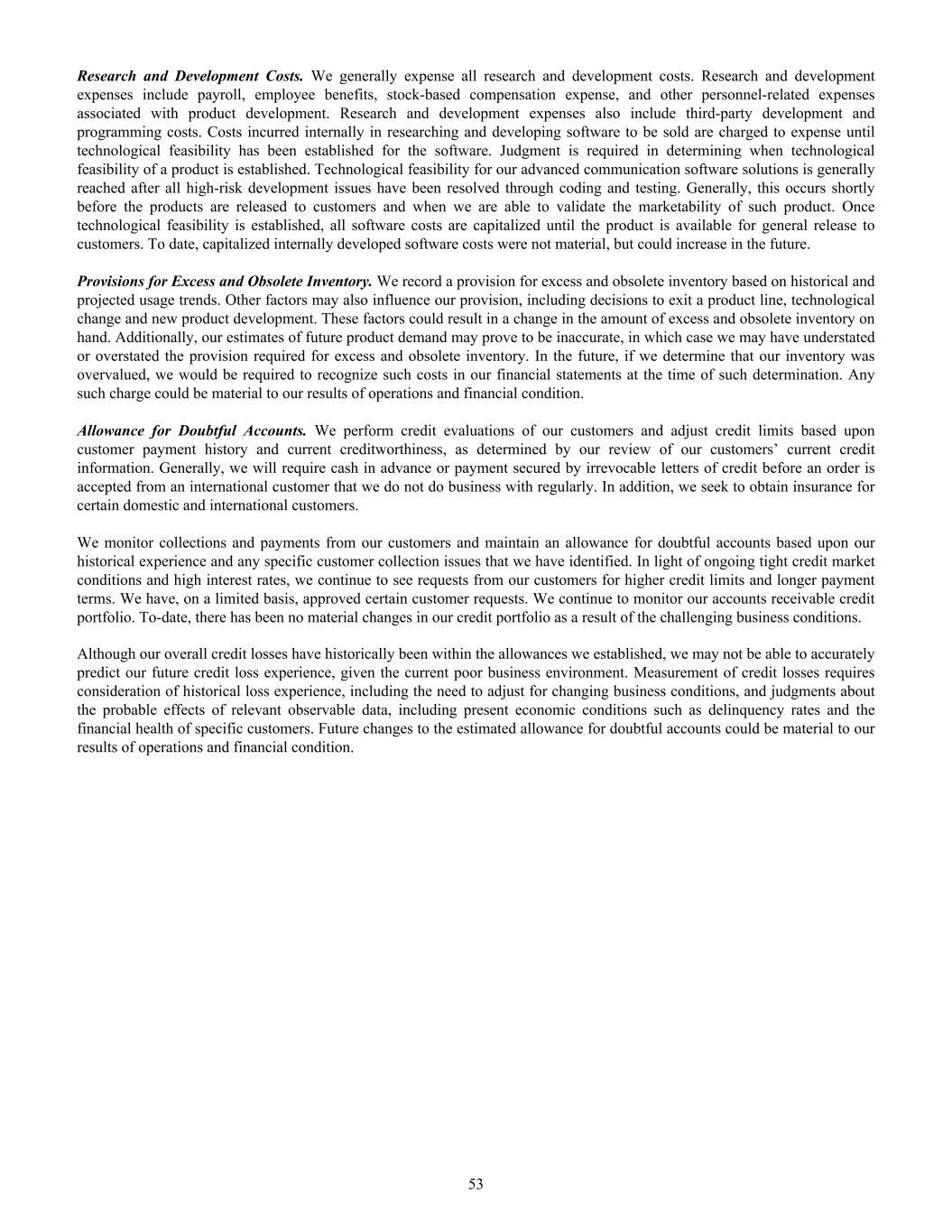
Research and Development Costs. We generally expense all research and development costs. Research and development expenses include payroll, employee benefits, stock-based compensation expense, and other personnel-related expenses associated with product development. Research and development expenses also include third-party development and programming costs. Costs incurred internally in researching and developing software to be sold are charged to expense until technological feasibility has been established for the software. Judgment is required in determining when technological feasibility of a product is established. Technological feasibility for our advanced communication software solutions is generally reached after all high-risk development issues have been resolved through coding and testing. Generally, this occurs shortly before the products are released to customers and when we are able to validate the marketability of such product. Once technological feasibility is established, all software costs are capitalized until the product is available for general release to customers. To date, capitalized internally developed software costs were not material, but could increase in the future. Provisions for Excess and Obsolete Inventory. We record a provision for excess and obsolete inventory based on historical and projected usage trends. Other factors may also influence our provision, including decisions to exit a product line, technological change and new product development. These factors could result in a change in the amount of excess and obsolete inventory on hand. Additionally, our estimates of future product demand may prove to be inaccurate, in which case we may have understated or overstated the provision required for excess and obsolete inventory. In the future, if we determine that our inventory was overvalued, we would be required to recognize such costs in our financial statements at the time of such determination. Any such charge could be material to our results of operations and financial condition. Allowance for Doubtful Accounts. We perform credit evaluations of our customers and adjust credit limits based upon customer payment history and current creditworthiness, as determined by our review of our customers’ current credit information. Generally, we will require cash in advance or payment secured by irrevocable letters of credit before an order is accepted from an international customer that we do not do business with regularly. In addition, we seek to obtain insurance for certain domestic and international customers. We monitor collections and payments from our customers and maintain an allowance for doubtful accounts based upon our historical experience and any specific customer collection issues that we have identified. In light of ongoing tight credit market conditions and high interest rates, we continue to see requests from our customers for higher credit limits and longer payment terms. We have, on a limited basis, approved certain customer requests. We continue to monitor our accounts receivable credit portfolio. To-date, there has been no material changes in our credit portfolio as a result of the challenging business conditions. Although our overall credit losses have historically been within the allowances we established, we may not be able to accurately predict our future credit loss experience, given the current poor business environment. Measurement of credit losses requires consideration of historical loss experience, including the need to adjust for changing business conditions, and judgments about the probable effects of relevant observable data, including present economic conditions such as delinquency rates and the financial health of specific customers. Future changes to the estimated allowance for doubtful accounts could be material to our results of operations and financial condition. 53
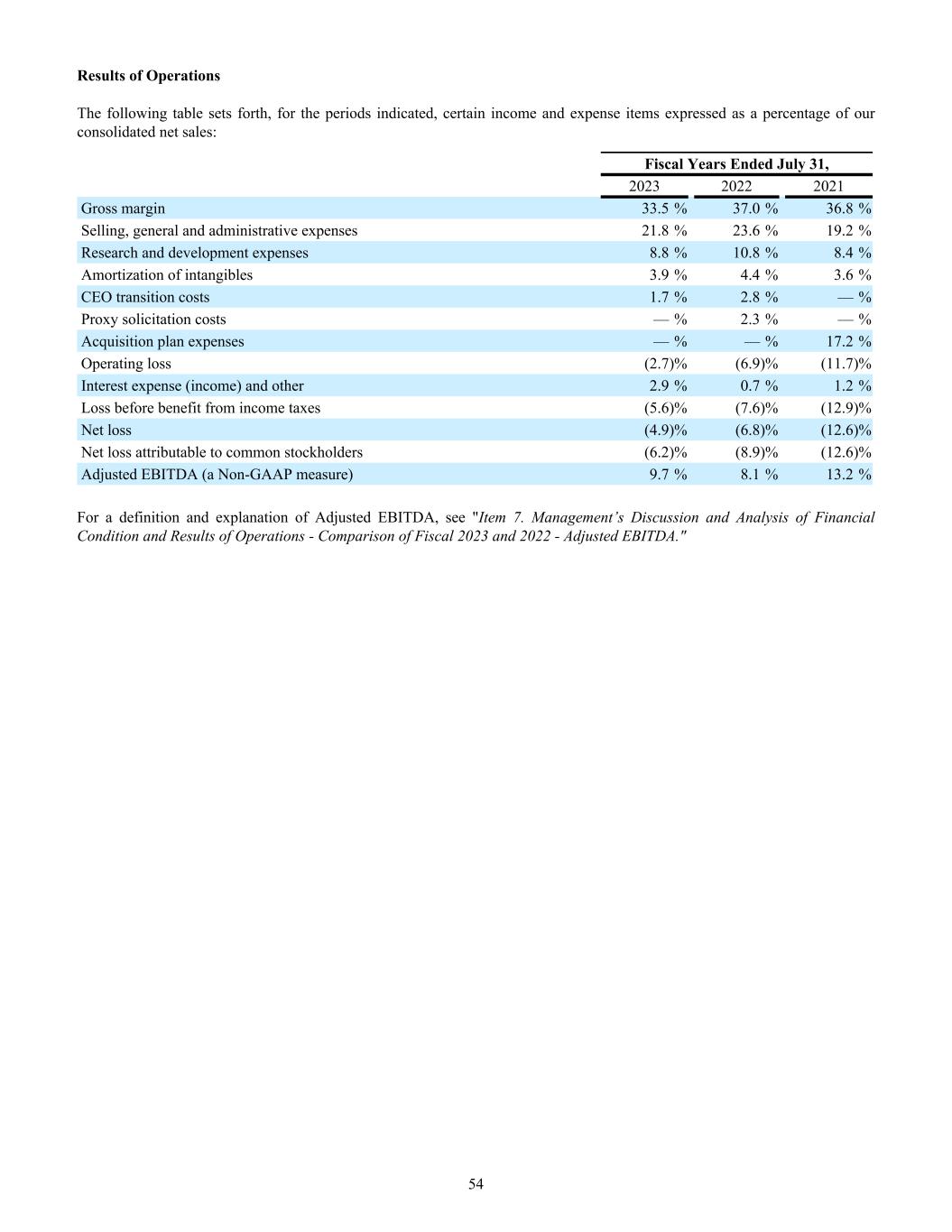
Results of Operations The following table sets forth, for the periods indicated, certain income and expense items expressed as a percentage of our consolidated net sales: Fiscal Years Ended July 31, 2023 2022 2021 Gross margin 33.5 % 37.0 % 36.8 % Selling, general and administrative expenses 21.8 % 23.6 % 19.2 % Research and development expenses 8.8 % 10.8 % 8.4 % Amortization of intangibles 3.9 % 4.4 % 3.6 % CEO transition costs 1.7 % 2.8 % — % Proxy solicitation costs — % 2.3 % — % Acquisition plan expenses — % — % 17.2 % Operating loss (2.7) % (6.9) % (11.7) % Interest expense (income) and other 2.9 % 0.7 % 1.2 % Loss before benefit from income taxes (5.6) % (7.6) % (12.9) % Net loss (4.9) % (6.8) % (12.6) % Net loss attributable to common stockholders (6.2) % (8.9) % (12.6) % Adjusted EBITDA (a Non-GAAP measure) 9.7 % 8.1 % 13.2 % For a definition and explanation of Adjusted EBITDA, see "Item 7. Management’s Discussion and Analysis of Financial Condition and Results of Operations - Comparison of Fiscal 2023 and 2022 - Adjusted EBITDA." 54
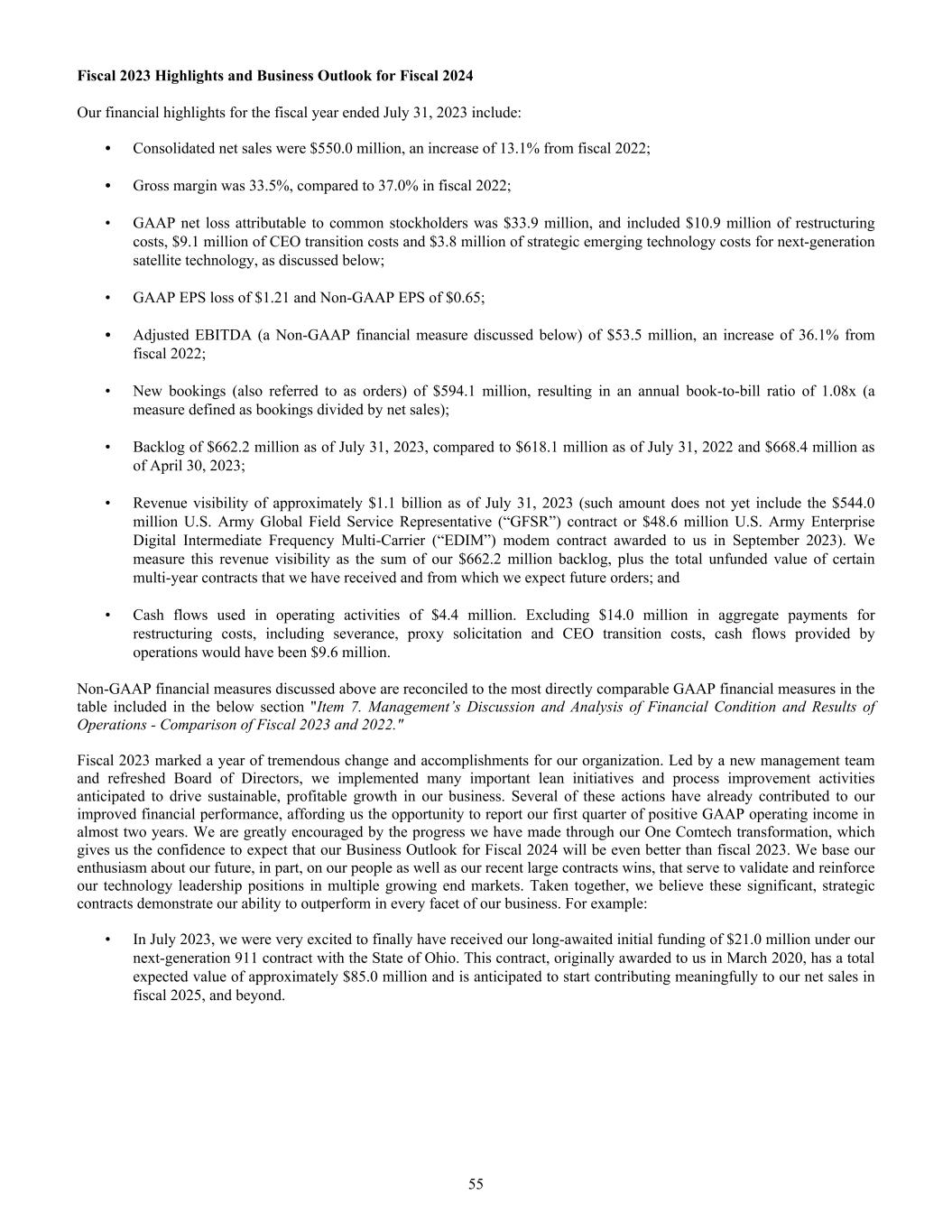
Fiscal 2023 Highlights and Business Outlook for Fiscal 2024 Our financial highlights for the fiscal year ended July 31, 2023 include: • Consolidated net sales were $550.0 million, an increase of 13.1% from fiscal 2022; • Gross margin was 33.5%, compared to 37.0% in fiscal 2022; • GAAP net loss attributable to common stockholders was $33.9 million, and included $10.9 million of restructuring costs, $9.1 million of CEO transition costs and $3.8 million of strategic emerging technology costs for next-generation satellite technology, as discussed below; • GAAP EPS loss of $1.21 and Non-GAAP EPS of $0.65; • Adjusted EBITDA (a Non-GAAP financial measure discussed below) of $53.5 million, an increase of 36.1% from fiscal 2022; • New bookings (also referred to as orders) of $594.1 million, resulting in an annual book-to-bill ratio of 1.08x (a measure defined as bookings divided by net sales); • Backlog of $662.2 million as of July 31, 2023, compared to $618.1 million as of July 31, 2022 and $668.4 million as of April 30, 2023; • Revenue visibility of approximately $1.1 billion as of July 31, 2023 (such amount does not yet include the $544.0 million U.S. Army Global Field Service Representative (“GFSR”) contract or $48.6 million U.S. Army Enterprise Digital Intermediate Frequency Multi-Carrier (“EDIM”) modem contract awarded to us in September 2023). We measure this revenue visibility as the sum of our $662.2 million backlog, plus the total unfunded value of certain multi-year contracts that we have received and from which we expect future orders; and • Cash flows used in operating activities of $4.4 million. Excluding $14.0 million in aggregate payments for restructuring costs, including severance, proxy solicitation and CEO transition costs, cash flows provided by operations would have been $9.6 million. Non-GAAP financial measures discussed above are reconciled to the most directly comparable GAAP financial measures in the table included in the below section "Item 7. Management’s Discussion and Analysis of Financial Condition and Results of Operations - Comparison of Fiscal 2023 and 2022." Fiscal 2023 marked a year of tremendous change and accomplishments for our organization. Led by a new management team and refreshed Board of Directors, we implemented many important lean initiatives and process improvement activities anticipated to drive sustainable, profitable growth in our business. Several of these actions have already contributed to our improved financial performance, affording us the opportunity to report our first quarter of positive GAAP operating income in almost two years. We are greatly encouraged by the progress we have made through our One Comtech transformation, which gives us the confidence to expect that our Business Outlook for Fiscal 2024 will be even better than fiscal 2023. We base our enthusiasm about our future, in part, on our people as well as our recent large contracts wins, that serve to validate and reinforce our technology leadership positions in multiple growing end markets. Taken together, we believe these significant, strategic contracts demonstrate our ability to outperform in every facet of our business. For example: • In July 2023, we were very excited to finally have received our long-awaited initial funding of $21.0 million under our next-generation 911 contract with the State of Ohio. This contract, originally awarded to us in March 2020, has a total expected value of approximately $85.0 million and is anticipated to start contributing meaningfully to our net sales in fiscal 2025, and beyond. 55
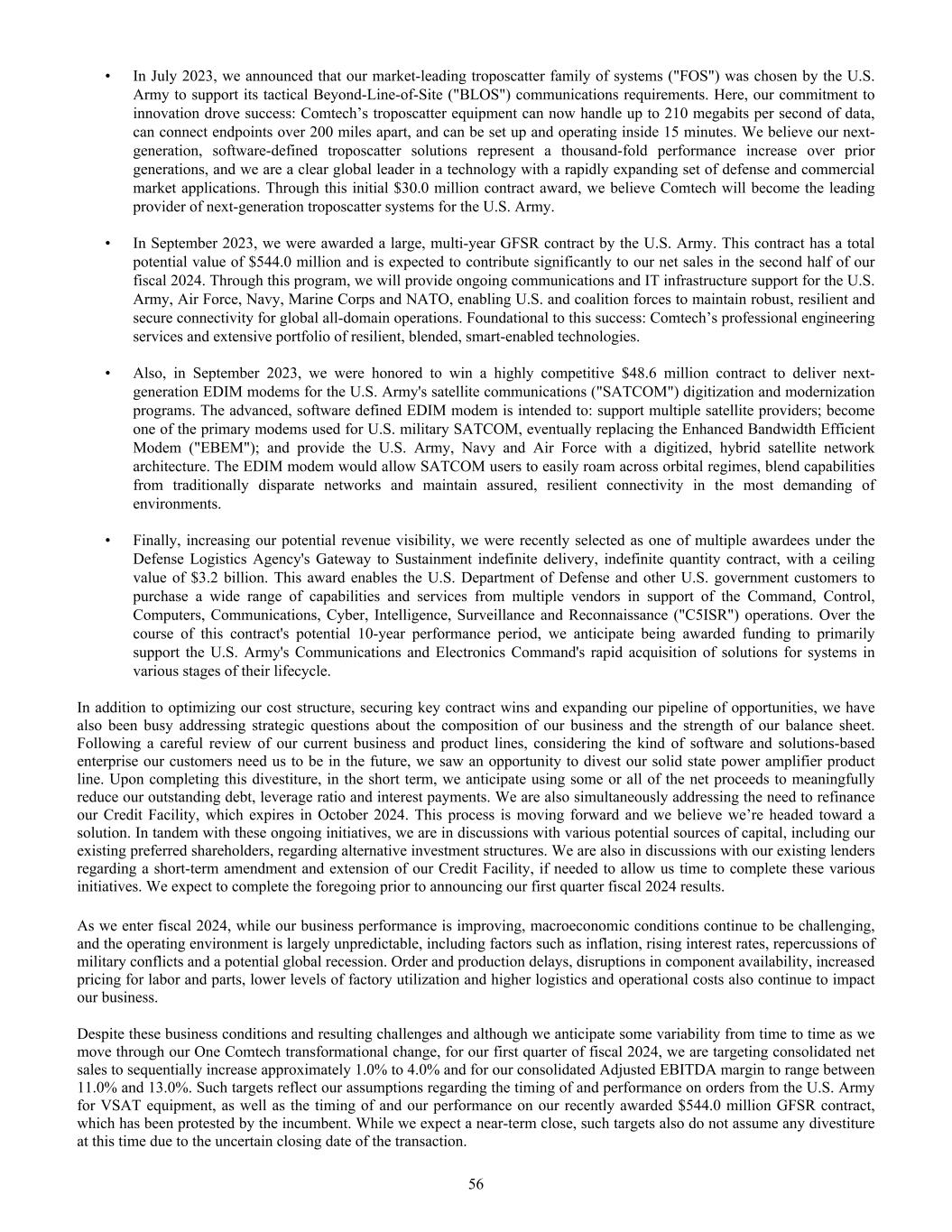
• In July 2023, we announced that our market-leading troposcatter family of systems ("FOS") was chosen by the U.S. Army to support its tactical Beyond-Line-of-Site ("BLOS") communications requirements. Here, our commitment to innovation drove success: Comtech’s troposcatter equipment can now handle up to 210 megabits per second of data, can connect endpoints over 200 miles apart, and can be set up and operating inside 15 minutes. We believe our next- generation, software-defined troposcatter solutions represent a thousand-fold performance increase over prior generations, and we are a clear global leader in a technology with a rapidly expanding set of defense and commercial market applications. Through this initial $30.0 million contract award, we believe Comtech will become the leading provider of next-generation troposcatter systems for the U.S. Army. • In September 2023, we were awarded a large, multi-year GFSR contract by the U.S. Army. This contract has a total potential value of $544.0 million and is expected to contribute significantly to our net sales in the second half of our fiscal 2024. Through this program, we will provide ongoing communications and IT infrastructure support for the U.S. Army, Air Force, Navy, Marine Corps and NATO, enabling U.S. and coalition forces to maintain robust, resilient and secure connectivity for global all-domain operations. Foundational to this success: Comtech’s professional engineering services and extensive portfolio of resilient, blended, smart-enabled technologies. • Also, in September 2023, we were honored to win a highly competitive $48.6 million contract to deliver next- generation EDIM modems for the U.S. Army's satellite communications ("SATCOM") digitization and modernization programs. The advanced, software defined EDIM modem is intended to: support multiple satellite providers; become one of the primary modems used for U.S. military SATCOM, eventually replacing the Enhanced Bandwidth Efficient Modem ("EBEM"); and provide the U.S. Army, Navy and Air Force with a digitized, hybrid satellite network architecture. The EDIM modem would allow SATCOM users to easily roam across orbital regimes, blend capabilities from traditionally disparate networks and maintain assured, resilient connectivity in the most demanding of environments. • Finally, increasing our potential revenue visibility, we were recently selected as one of multiple awardees under the Defense Logistics Agency's Gateway to Sustainment indefinite delivery, indefinite quantity contract, with a ceiling value of $3.2 billion. This award enables the U.S. Department of Defense and other U.S. government customers to purchase a wide range of capabilities and services from multiple vendors in support of the Command, Control, Computers, Communications, Cyber, Intelligence, Surveillance and Reconnaissance ("C5ISR") operations. Over the course of this contract's potential 10-year performance period, we anticipate being awarded funding to primarily support the U.S. Army's Communications and Electronics Command's rapid acquisition of solutions for systems in various stages of their lifecycle. In addition to optimizing our cost structure, securing key contract wins and expanding our pipeline of opportunities, we have also been busy addressing strategic questions about the composition of our business and the strength of our balance sheet. Following a careful review of our current business and product lines, considering the kind of software and solutions-based enterprise our customers need us to be in the future, we saw an opportunity to divest our solid state power amplifier product line. Upon completing this divestiture, in the short term, we anticipate using some or all of the net proceeds to meaningfully reduce our outstanding debt, leverage ratio and interest payments. We are also simultaneously addressing the need to refinance our Credit Facility, which expires in October 2024. This process is moving forward and we believe we’re headed toward a solution. In tandem with these ongoing initiatives, we are in discussions with various potential sources of capital, including our existing preferred shareholders, regarding alternative investment structures. We are also in discussions with our existing lenders regarding a short-term amendment and extension of our Credit Facility, if needed to allow us time to complete these various initiatives. We expect to complete the foregoing prior to announcing our first quarter fiscal 2024 results. As we enter fiscal 2024, while our business performance is improving, macroeconomic conditions continue to be challenging, and the operating environment is largely unpredictable, including factors such as inflation, rising interest rates, repercussions of military conflicts and a potential global recession. Order and production delays, disruptions in component availability, increased pricing for labor and parts, lower levels of factory utilization and higher logistics and operational costs also continue to impact our business. Despite these business conditions and resulting challenges and although we anticipate some variability from time to time as we move through our One Comtech transformational change, for our first quarter of fiscal 2024, we are targeting consolidated net sales to sequentially increase approximately 1.0% to 4.0% and for our consolidated Adjusted EBITDA margin to range between 11.0% and 13.0%. Such targets reflect our assumptions regarding the timing of and performance on orders from the U.S. Army for VSAT equipment, as well as the timing of and our performance on our recently awarded $544.0 million GFSR contract, which has been protested by the incumbent. While we expect a near-term close, such targets also do not assume any divestiture at this time due to the uncertain closing date of the transaction. 56
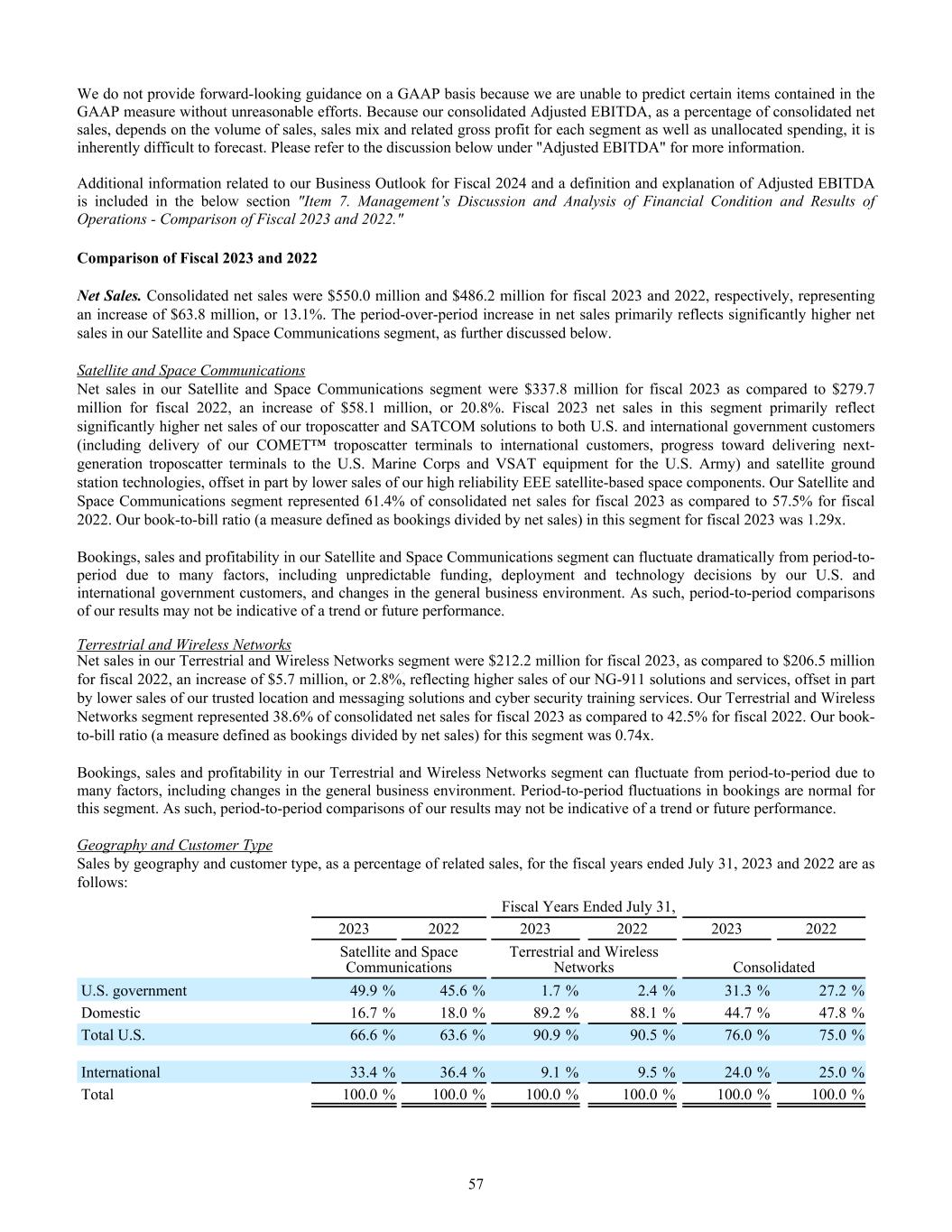
We do not provide forward-looking guidance on a GAAP basis because we are unable to predict certain items contained in the GAAP measure without unreasonable efforts. Because our consolidated Adjusted EBITDA, as a percentage of consolidated net sales, depends on the volume of sales, sales mix and related gross profit for each segment as well as unallocated spending, it is inherently difficult to forecast. Please refer to the discussion below under "Adjusted EBITDA" for more information. Additional information related to our Business Outlook for Fiscal 2024 and a definition and explanation of Adjusted EBITDA is included in the below section "Item 7. Management’s Discussion and Analysis of Financial Condition and Results of Operations - Comparison of Fiscal 2023 and 2022." Comparison of Fiscal 2023 and 2022 Net Sales. Consolidated net sales were $550.0 million and $486.2 million for fiscal 2023 and 2022, respectively, representing an increase of $63.8 million, or 13.1%. The period-over-period increase in net sales primarily reflects significantly higher net sales in our Satellite and Space Communications segment, as further discussed below. Satellite and Space Communications Net sales in our Satellite and Space Communications segment were $337.8 million for fiscal 2023 as compared to $279.7 million for fiscal 2022, an increase of $58.1 million, or 20.8%. Fiscal 2023 net sales in this segment primarily reflect significantly higher net sales of our troposcatter and SATCOM solutions to both U.S. and international government customers (including delivery of our COMET™ troposcatter terminals to international customers, progress toward delivering next- generation troposcatter terminals to the U.S. Marine Corps and VSAT equipment for the U.S. Army) and satellite ground station technologies, offset in part by lower sales of our high reliability EEE satellite-based space components. Our Satellite and Space Communications segment represented 61.4% of consolidated net sales for fiscal 2023 as compared to 57.5% for fiscal 2022. Our book-to-bill ratio (a measure defined as bookings divided by net sales) in this segment for fiscal 2023 was 1.29x. Bookings, sales and profitability in our Satellite and Space Communications segment can fluctuate dramatically from period-to- period due to many factors, including unpredictable funding, deployment and technology decisions by our U.S. and international government customers, and changes in the general business environment. As such, period-to-period comparisons of our results may not be indicative of a trend or future performance. Terrestrial and Wireless Networks Net sales in our Terrestrial and Wireless Networks segment were $212.2 million for fiscal 2023, as compared to $206.5 million for fiscal 2022, an increase of $5.7 million, or 2.8%, reflecting higher sales of our NG-911 solutions and services, offset in part by lower sales of our trusted location and messaging solutions and cyber security training services. Our Terrestrial and Wireless Networks segment represented 38.6% of consolidated net sales for fiscal 2023 as compared to 42.5% for fiscal 2022. Our book- to-bill ratio (a measure defined as bookings divided by net sales) for this segment was 0.74x. Bookings, sales and profitability in our Terrestrial and Wireless Networks segment can fluctuate from period-to-period due to many factors, including changes in the general business environment. Period-to-period fluctuations in bookings are normal for this segment. As such, period-to-period comparisons of our results may not be indicative of a trend or future performance. Geography and Customer Type Sales by geography and customer type, as a percentage of related sales, for the fiscal years ended July 31, 2023 and 2022 are as follows: Fiscal Years Ended July 31, 2023 2022 2023 2022 2023 2022 Satellite and Space Communications Terrestrial and Wireless Networks Consolidated U.S. government 49.9 % 45.6 % 1.7 % 2.4 % 31.3 % 27.2 % Domestic 16.7 % 18.0 % 89.2 % 88.1 % 44.7 % 47.8 % Total U.S. 66.6 % 63.6 % 90.9 % 90.5 % 76.0 % 75.0 % International 33.4 % 36.4 % 9.1 % 9.5 % 24.0 % 25.0 % Total 100.0 % 100.0 % 100.0 % 100.0 % 100.0 % 100.0 % 57
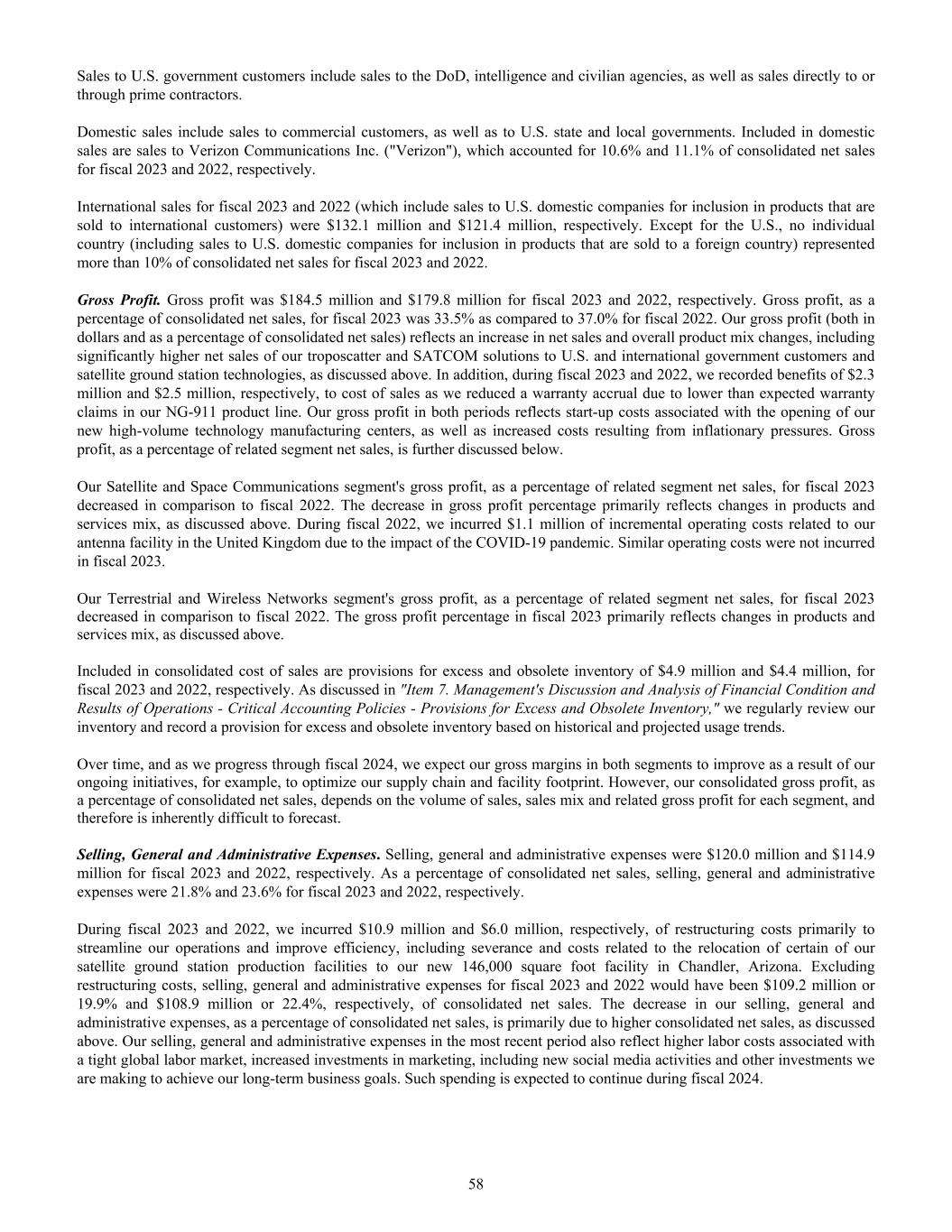
Sales to U.S. government customers include sales to the DoD, intelligence and civilian agencies, as well as sales directly to or through prime contractors. Domestic sales include sales to commercial customers, as well as to U.S. state and local governments. Included in domestic sales are sales to Verizon Communications Inc. ("Verizon"), which accounted for 10.6% and 11.1% of consolidated net sales for fiscal 2023 and 2022, respectively. International sales for fiscal 2023 and 2022 (which include sales to U.S. domestic companies for inclusion in products that are sold to international customers) were $132.1 million and $121.4 million, respectively. Except for the U.S., no individual country (including sales to U.S. domestic companies for inclusion in products that are sold to a foreign country) represented more than 10% of consolidated net sales for fiscal 2023 and 2022. Gross Profit. Gross profit was $184.5 million and $179.8 million for fiscal 2023 and 2022, respectively. Gross profit, as a percentage of consolidated net sales, for fiscal 2023 was 33.5% as compared to 37.0% for fiscal 2022. Our gross profit (both in dollars and as a percentage of consolidated net sales) reflects an increase in net sales and overall product mix changes, including significantly higher net sales of our troposcatter and SATCOM solutions to U.S. and international government customers and satellite ground station technologies, as discussed above. In addition, during fiscal 2023 and 2022, we recorded benefits of $2.3 million and $2.5 million, respectively, to cost of sales as we reduced a warranty accrual due to lower than expected warranty claims in our NG-911 product line. Our gross profit in both periods reflects start-up costs associated with the opening of our new high-volume technology manufacturing centers, as well as increased costs resulting from inflationary pressures. Gross profit, as a percentage of related segment net sales, is further discussed below. Our Satellite and Space Communications segment's gross profit, as a percentage of related segment net sales, for fiscal 2023 decreased in comparison to fiscal 2022. The decrease in gross profit percentage primarily reflects changes in products and services mix, as discussed above. During fiscal 2022, we incurred $1.1 million of incremental operating costs related to our antenna facility in the United Kingdom due to the impact of the COVID-19 pandemic. Similar operating costs were not incurred in fiscal 2023. Our Terrestrial and Wireless Networks segment's gross profit, as a percentage of related segment net sales, for fiscal 2023 decreased in comparison to fiscal 2022. The gross profit percentage in fiscal 2023 primarily reflects changes in products and services mix, as discussed above. Included in consolidated cost of sales are provisions for excess and obsolete inventory of $4.9 million and $4.4 million, for fiscal 2023 and 2022, respectively. As discussed in "Item 7. Management's Discussion and Analysis of Financial Condition and Results of Operations - Critical Accounting Policies - Provisions for Excess and Obsolete Inventory," we regularly review our inventory and record a provision for excess and obsolete inventory based on historical and projected usage trends. Over time, and as we progress through fiscal 2024, we expect our gross margins in both segments to improve as a result of our ongoing initiatives, for example, to optimize our supply chain and facility footprint. However, our consolidated gross profit, as a percentage of consolidated net sales, depends on the volume of sales, sales mix and related gross profit for each segment, and therefore is inherently difficult to forecast. Selling, General and Administrative Expenses. Selling, general and administrative expenses were $120.0 million and $114.9 million for fiscal 2023 and 2022, respectively. As a percentage of consolidated net sales, selling, general and administrative expenses were 21.8% and 23.6% for fiscal 2023 and 2022, respectively. During fiscal 2023 and 2022, we incurred $10.9 million and $6.0 million, respectively, of restructuring costs primarily to streamline our operations and improve efficiency, including severance and costs related to the relocation of certain of our satellite ground station production facilities to our new 146,000 square foot facility in Chandler, Arizona. Excluding restructuring costs, selling, general and administrative expenses for fiscal 2023 and 2022 would have been $109.2 million or 19.9% and $108.9 million or 22.4%, respectively, of consolidated net sales. The decrease in our selling, general and administrative expenses, as a percentage of consolidated net sales, is primarily due to higher consolidated net sales, as discussed above. Our selling, general and administrative expenses in the most recent period also reflect higher labor costs associated with a tight global labor market, increased investments in marketing, including new social media activities and other investments we are making to achieve our long-term business goals. Such spending is expected to continue during fiscal 2024. 58
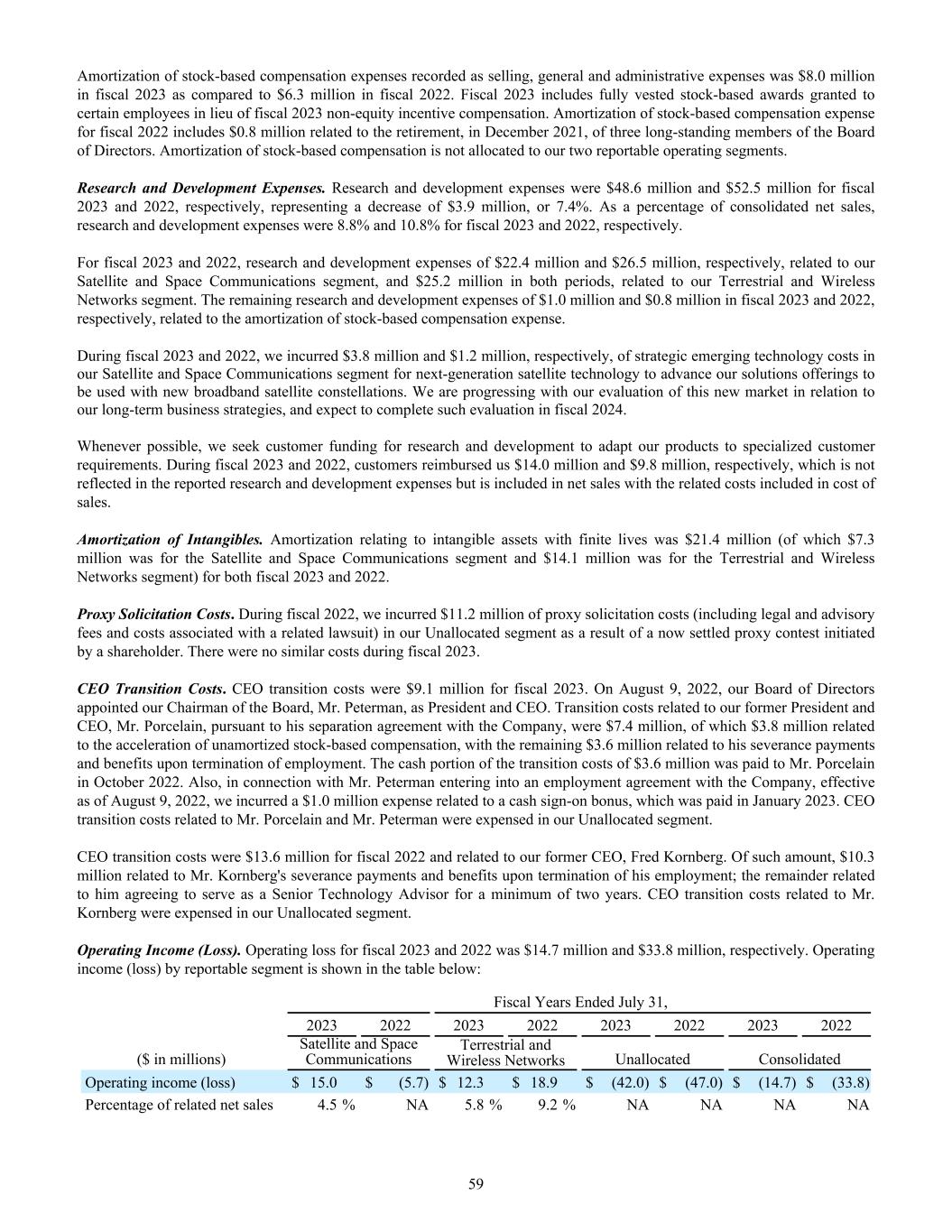
Amortization of stock-based compensation expenses recorded as selling, general and administrative expenses was $8.0 million in fiscal 2023 as compared to $6.3 million in fiscal 2022. Fiscal 2023 includes fully vested stock-based awards granted to certain employees in lieu of fiscal 2023 non-equity incentive compensation. Amortization of stock-based compensation expense for fiscal 2022 includes $0.8 million related to the retirement, in December 2021, of three long-standing members of the Board of Directors. Amortization of stock-based compensation is not allocated to our two reportable operating segments. Research and Development Expenses. Research and development expenses were $48.6 million and $52.5 million for fiscal 2023 and 2022, respectively, representing a decrease of $3.9 million, or 7.4%. As a percentage of consolidated net sales, research and development expenses were 8.8% and 10.8% for fiscal 2023 and 2022, respectively. For fiscal 2023 and 2022, research and development expenses of $22.4 million and $26.5 million, respectively, related to our Satellite and Space Communications segment, and $25.2 million in both periods, related to our Terrestrial and Wireless Networks segment. The remaining research and development expenses of $1.0 million and $0.8 million in fiscal 2023 and 2022, respectively, related to the amortization of stock-based compensation expense. During fiscal 2023 and 2022, we incurred $3.8 million and $1.2 million, respectively, of strategic emerging technology costs in our Satellite and Space Communications segment for next-generation satellite technology to advance our solutions offerings to be used with new broadband satellite constellations. We are progressing with our evaluation of this new market in relation to our long-term business strategies, and expect to complete such evaluation in fiscal 2024. Whenever possible, we seek customer funding for research and development to adapt our products to specialized customer requirements. During fiscal 2023 and 2022, customers reimbursed us $14.0 million and $9.8 million, respectively, which is not reflected in the reported research and development expenses but is included in net sales with the related costs included in cost of sales. Amortization of Intangibles. Amortization relating to intangible assets with finite lives was $21.4 million (of which $7.3 million was for the Satellite and Space Communications segment and $14.1 million was for the Terrestrial and Wireless Networks segment) for both fiscal 2023 and 2022. Proxy Solicitation Costs. During fiscal 2022, we incurred $11.2 million of proxy solicitation costs (including legal and advisory fees and costs associated with a related lawsuit) in our Unallocated segment as a result of a now settled proxy contest initiated by a shareholder. There were no similar costs during fiscal 2023. CEO Transition Costs. CEO transition costs were $9.1 million for fiscal 2023. On August 9, 2022, our Board of Directors appointed our Chairman of the Board, Mr. Peterman, as President and CEO. Transition costs related to our former President and CEO, Mr. Porcelain, pursuant to his separation agreement with the Company, were $7.4 million, of which $3.8 million related to the acceleration of unamortized stock-based compensation, with the remaining $3.6 million related to his severance payments and benefits upon termination of employment. The cash portion of the transition costs of $3.6 million was paid to Mr. Porcelain in October 2022. Also, in connection with Mr. Peterman entering into an employment agreement with the Company, effective as of August 9, 2022, we incurred a $1.0 million expense related to a cash sign-on bonus, which was paid in January 2023. CEO transition costs related to Mr. Porcelain and Mr. Peterman were expensed in our Unallocated segment. CEO transition costs were $13.6 million for fiscal 2022 and related to our former CEO, Fred Kornberg. Of such amount, $10.3 million related to Mr. Kornberg's severance payments and benefits upon termination of his employment; the remainder related to him agreeing to serve as a Senior Technology Advisor for a minimum of two years. CEO transition costs related to Mr. Kornberg were expensed in our Unallocated segment. Operating Income (Loss). Operating loss for fiscal 2023 and 2022 was $14.7 million and $33.8 million, respectively. Operating income (loss) by reportable segment is shown in the table below: Fiscal Years Ended July 31, 2023 2022 2023 2022 2023 2022 2023 2022 ($ in millions) Satellite and Space Communications Terrestrial and Wireless Networks Unallocated Consolidated Operating income (loss) $ 15.0 $ (5.7) $ 12.3 $ 18.9 $ (42.0) $ (47.0) $ (14.7) $ (33.8) Percentage of related net sales 4.5 % NA 5.8 % 9.2 % NA NA NA NA 59
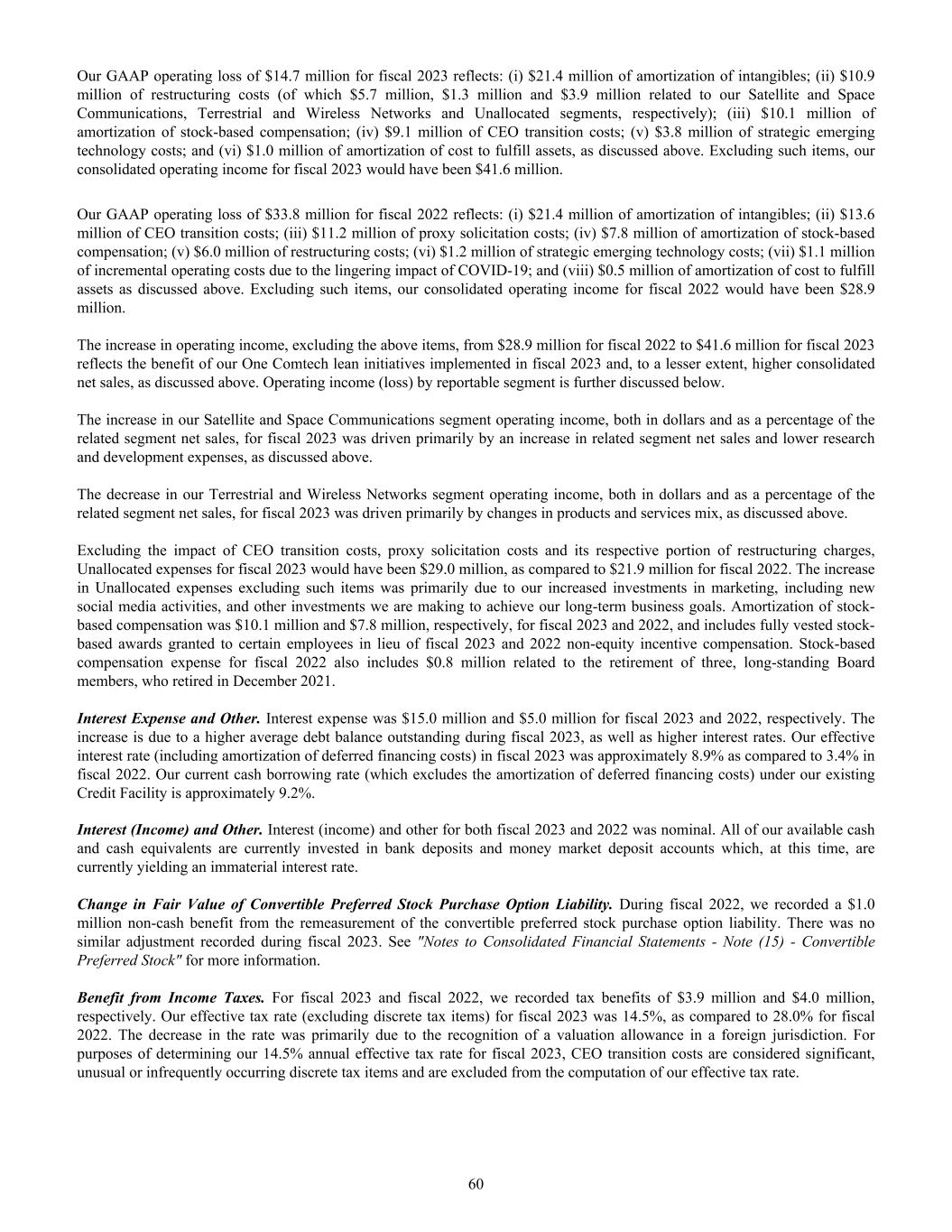
Our GAAP operating loss of $14.7 million for fiscal 2023 reflects: (i) $21.4 million of amortization of intangibles; (ii) $10.9 million of restructuring costs (of which $5.7 million, $1.3 million and $3.9 million related to our Satellite and Space Communications, Terrestrial and Wireless Networks and Unallocated segments, respectively); (iii) $10.1 million of amortization of stock-based compensation; (iv) $9.1 million of CEO transition costs; (v) $3.8 million of strategic emerging technology costs; and (vi) $1.0 million of amortization of cost to fulfill assets, as discussed above. Excluding such items, our consolidated operating income for fiscal 2023 would have been $41.6 million. Our GAAP operating loss of $33.8 million for fiscal 2022 reflects: (i) $21.4 million of amortization of intangibles; (ii) $13.6 million of CEO transition costs; (iii) $11.2 million of proxy solicitation costs; (iv) $7.8 million of amortization of stock-based compensation; (v) $6.0 million of restructuring costs; (vi) $1.2 million of strategic emerging technology costs; (vii) $1.1 million of incremental operating costs due to the lingering impact of COVID-19; and (viii) $0.5 million of amortization of cost to fulfill assets as discussed above. Excluding such items, our consolidated operating income for fiscal 2022 would have been $28.9 million. The increase in operating income, excluding the above items, from $28.9 million for fiscal 2022 to $41.6 million for fiscal 2023 reflects the benefit of our One Comtech lean initiatives implemented in fiscal 2023 and, to a lesser extent, higher consolidated net sales, as discussed above. Operating income (loss) by reportable segment is further discussed below. The increase in our Satellite and Space Communications segment operating income, both in dollars and as a percentage of the related segment net sales, for fiscal 2023 was driven primarily by an increase in related segment net sales and lower research and development expenses, as discussed above. The decrease in our Terrestrial and Wireless Networks segment operating income, both in dollars and as a percentage of the related segment net sales, for fiscal 2023 was driven primarily by changes in products and services mix, as discussed above. Excluding the impact of CEO transition costs, proxy solicitation costs and its respective portion of restructuring charges, Unallocated expenses for fiscal 2023 would have been $29.0 million, as compared to $21.9 million for fiscal 2022. The increase in Unallocated expenses excluding such items was primarily due to our increased investments in marketing, including new social media activities, and other investments we are making to achieve our long-term business goals. Amortization of stock- based compensation was $10.1 million and $7.8 million, respectively, for fiscal 2023 and 2022, and includes fully vested stock- based awards granted to certain employees in lieu of fiscal 2023 and 2022 non-equity incentive compensation. Stock-based compensation expense for fiscal 2022 also includes $0.8 million related to the retirement of three, long-standing Board members, who retired in December 2021. Interest Expense and Other. Interest expense was $15.0 million and $5.0 million for fiscal 2023 and 2022, respectively. The increase is due to a higher average debt balance outstanding during fiscal 2023, as well as higher interest rates. Our effective interest rate (including amortization of deferred financing costs) in fiscal 2023 was approximately 8.9% as compared to 3.4% in fiscal 2022. Our current cash borrowing rate (which excludes the amortization of deferred financing costs) under our existing Credit Facility is approximately 9.2%. Interest (Income) and Other. Interest (income) and other for both fiscal 2023 and 2022 was nominal. All of our available cash and cash equivalents are currently invested in bank deposits and money market deposit accounts which, at this time, are currently yielding an immaterial interest rate. Change in Fair Value of Convertible Preferred Stock Purchase Option Liability. During fiscal 2022, we recorded a $1.0 million non-cash benefit from the remeasurement of the convertible preferred stock purchase option liability. There was no similar adjustment recorded during fiscal 2023. See "Notes to Consolidated Financial Statements - Note (15) - Convertible Preferred Stock" for more information. Benefit from Income Taxes. For fiscal 2023 and fiscal 2022, we recorded tax benefits of $3.9 million and $4.0 million, respectively. Our effective tax rate (excluding discrete tax items) for fiscal 2023 was 14.5%, as compared to 28.0% for fiscal 2022. The decrease in the rate was primarily due to the recognition of a valuation allowance in a foreign jurisdiction. For purposes of determining our 14.5% annual effective tax rate for fiscal 2023, CEO transition costs are considered significant, unusual or infrequently occurring discrete tax items and are excluded from the computation of our effective tax rate. 60

During fiscal 2023, we recorded a net discrete tax benefit of $0.8 million, primarily related to the reversal of tax contingencies no longer required due to the expiration of applicable statute of limitations and the deductible portion of CEO transition costs, offset in part by the settlement of stock-based awards and the finalization of certain tax accounts in connection with our fiscal 2022 federal and state income tax returns. During fiscal 2022, we recorded a net discrete tax benefit of $0.6 million, primarily related to the deductible portion of CEO transition costs and proxy solicitation costs. These benefits were partially offset by the establishment of a valuation allowance on certain foreign related net deferred tax assets and the settlement of certain stock- based awards during fiscal 2022. Our U.S federal income tax returns for fiscal 2020 through 2022 are subject to potential future IRS audit. None of our state income tax returns prior to fiscal 2019 are subject to audit. Future tax assessments or settlements could have a material adverse effect on our consolidated results of operations and financial condition. Net Loss Attributable to Common Stockholders. During fiscal 2023 and 2022, consolidated net loss attributable to common stockholders was $33.9 million and $43.3 million, respectively. Adjusted EBITDA. Adjusted EBITDA (both in dollars and as a percentage of related net sales) for both fiscal 2023 and 2022 are shown in the table below (numbers in the table may not foot due to rounding): Fiscal Years Ended July 31, 2023 2022 2023 2022 2023 2022 2023 2022 ($ in millions) Satellite and Space Communications Terrestrial and Wireless Networks Unallocated Consolidated Net income (loss) $ 15.5 (3.9) 12.3 18.8 (54.7) (48.0) $ (26.9) (33.1) Benefit from income taxes (1.7) (1.1) (0.2) — (2.0) (2.9) (3.9) (4.0) Interest (income) and other 1.2 (0.8) 0.2 0.1 (0.2) — 1.2 (0.7) Change in fair value of convertible preferred stock option liability — — — — — (1.0) — (1.0) Interest expense — 0.1 — — 15.0 4.9 15.0 5.0 Amortization of stock-based compensation — — — — 10.1 7.8 10.1 7.8 Amortization of intangibles 7.3 7.3 14.1 14.1 — — 21.4 21.4 Depreciation 4.1 4.0 7.6 6.1 0.2 0.2 11.9 10.3 Amortization of cost to fulfill assets 1.0 0.5 — — — — 1.0 0.5 CEO transition costs — — — — 9.1 13.6 9.1 13.6 Proxy solicitation costs — — — — — 11.2 — 11.2 Restructuring costs 5.7 5.7 1.3 — 3.9 0.3 10.9 6.0 Strategic emerging technology costs 3.8 1.2 — — — — 3.8 1.2 COVID-19 related costs — 1.1 — — — — — 1.1 Adjusted EBITDA $ 37.0 14.1 35.3 39.1 (18.8) (13.9) $ 53.5 39.3 Percentage of related net sales 11.0 % 5.0 % 16.6 % 18.9 % NA NA 9.7 % 8.1 % The increase in consolidated Adjusted EBITDA, both in dollars and as a percentage of consolidated net sales, for fiscal 2023 as compared to fiscal 2022 reflects the benefit of our One Comtech lean initiatives implemented through fiscal 2023, as discussed above. The increase in our Satellite and Space Communications segment's Adjusted EBITDA, both in dollars and as a percentage of related segment net sales, is primarily due to an increase in related segment net sales and lower research and development expenses, as discussed above. The decrease in our Terrestrial and Wireless Networks segment's Adjusted EBITDA, both in dollars and as a percentage of related segment net sales, is primarily due to changes in products and services mix, as discussed above. Because our consolidated Adjusted EBITDA, as a percentage of consolidated net sales, depends on the volume of sales, sales mix and related gross profit for each segment as well as unallocated spending, it is inherently difficult to forecast. 61
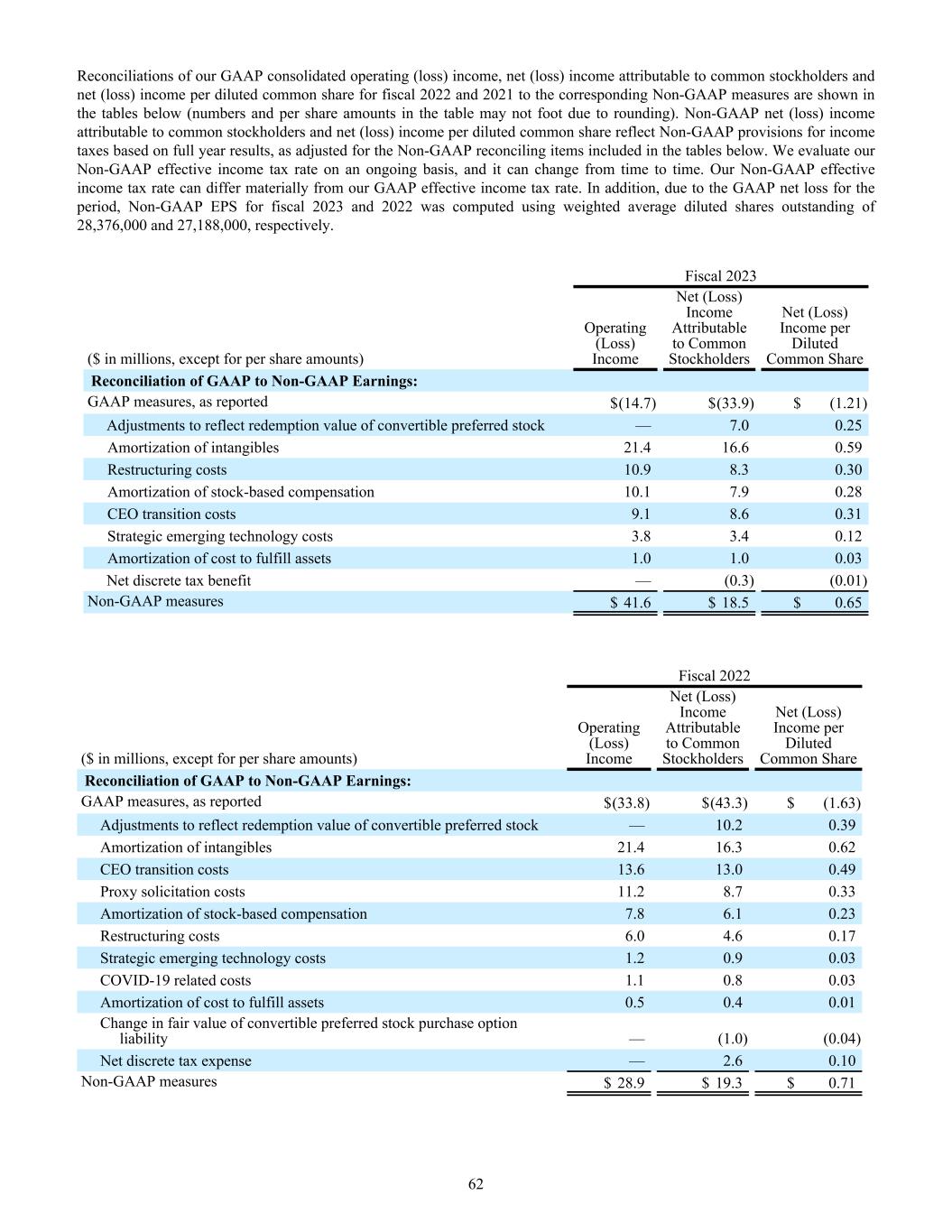
Reconciliations of our GAAP consolidated operating (loss) income, net (loss) income attributable to common stockholders and net (loss) income per diluted common share for fiscal 2022 and 2021 to the corresponding Non-GAAP measures are shown in the tables below (numbers and per share amounts in the table may not foot due to rounding). Non-GAAP net (loss) income attributable to common stockholders and net (loss) income per diluted common share reflect Non-GAAP provisions for income taxes based on full year results, as adjusted for the Non-GAAP reconciling items included in the tables below. We evaluate our Non-GAAP effective income tax rate on an ongoing basis, and it can change from time to time. Our Non-GAAP effective income tax rate can differ materially from our GAAP effective income tax rate. In addition, due to the GAAP net loss for the period, Non-GAAP EPS for fiscal 2023 and 2022 was computed using weighted average diluted shares outstanding of 28,376,000 and 27,188,000, respectively. Fiscal 2023 ($ in millions, except for per share amounts) Operating (Loss) Income Net (Loss) Income Attributable to Common Stockholders Net (Loss) Income per Diluted Common Share Reconciliation of GAAP to Non-GAAP Earnings: GAAP measures, as reported $ (14.7) $ (33.9) $ (1.21) Adjustments to reflect redemption value of convertible preferred stock — 7.0 0.25 Amortization of intangibles 21.4 16.6 0.59 Restructuring costs 10.9 8.3 0.30 Amortization of stock-based compensation 10.1 7.9 0.28 CEO transition costs 9.1 8.6 0.31 Strategic emerging technology costs 3.8 3.4 0.12 Amortization of cost to fulfill assets 1.0 1.0 0.03 Net discrete tax benefit — (0.3) (0.01) Non-GAAP measures $ 41.6 $ 18.5 $ 0.65 Fiscal 2022 ($ in millions, except for per share amounts) Operating (Loss) Income Net (Loss) Income Attributable to Common Stockholders Net (Loss) Income per Diluted Common Share Reconciliation of GAAP to Non-GAAP Earnings: GAAP measures, as reported $ (33.8) $ (43.3) $ (1.63) Adjustments to reflect redemption value of convertible preferred stock — 10.2 0.39 Amortization of intangibles 21.4 16.3 0.62 CEO transition costs 13.6 13.0 0.49 Proxy solicitation costs 11.2 8.7 0.33 Amortization of stock-based compensation 7.8 6.1 0.23 Restructuring costs 6.0 4.6 0.17 Strategic emerging technology costs 1.2 0.9 0.03 COVID-19 related costs 1.1 0.8 0.03 Amortization of cost to fulfill assets 0.5 0.4 0.01 Change in fair value of convertible preferred stock purchase option liability — (1.0) (0.04) Net discrete tax expense — 2.6 0.10 Non-GAAP measures $ 28.9 $ 19.3 $ 0.71 62
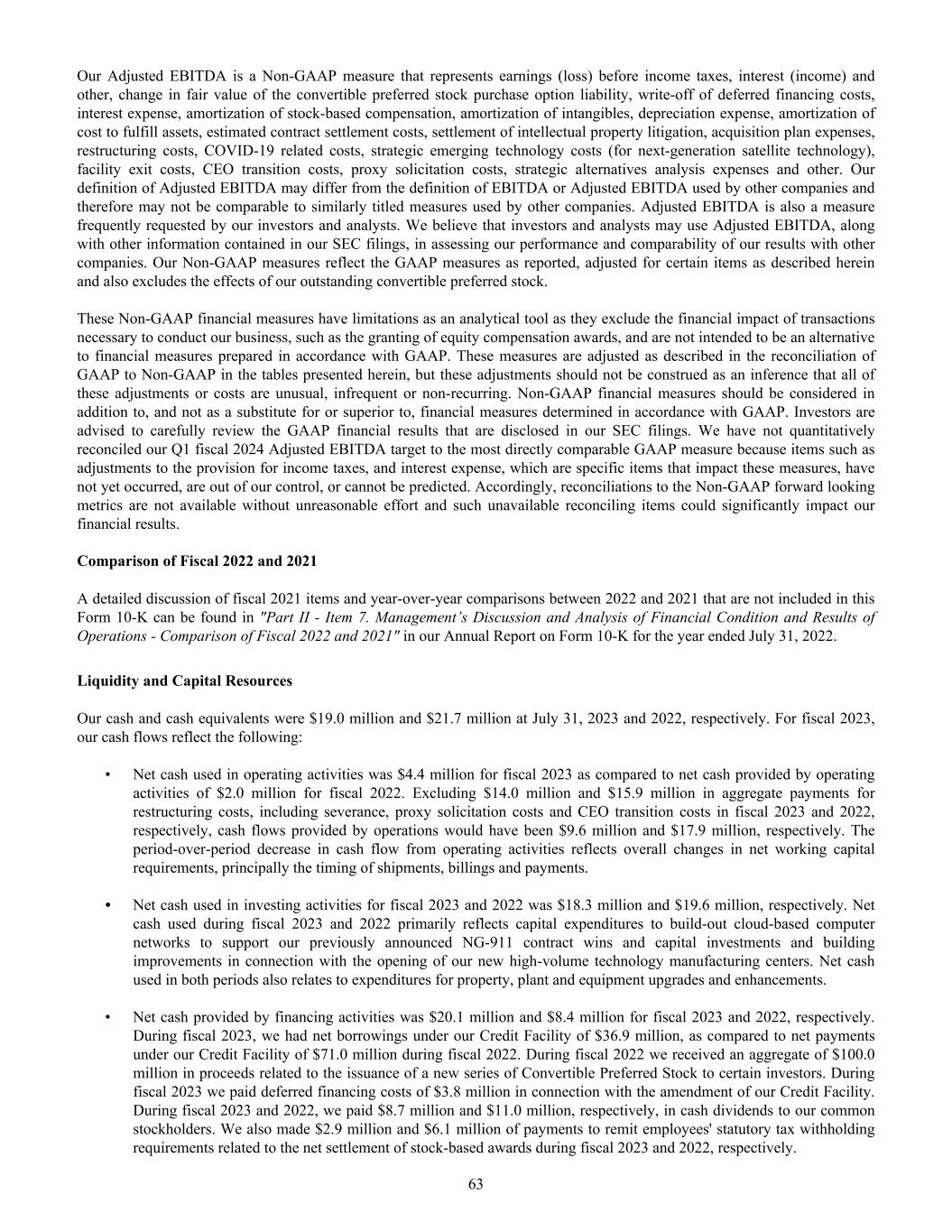
Our Adjusted EBITDA is a Non-GAAP measure that represents earnings (loss) before income taxes, interest (income) and other, change in fair value of the convertible preferred stock purchase option liability, write-off of deferred financing costs, interest expense, amortization of stock-based compensation, amortization of intangibles, depreciation expense, amortization of cost to fulfill assets, estimated contract settlement costs, settlement of intellectual property litigation, acquisition plan expenses, restructuring costs, COVID-19 related costs, strategic emerging technology costs (for next-generation satellite technology), facility exit costs, CEO transition costs, proxy solicitation costs, strategic alternatives analysis expenses and other. Our definition of Adjusted EBITDA may differ from the definition of EBITDA or Adjusted EBITDA used by other companies and therefore may not be comparable to similarly titled measures used by other companies. Adjusted EBITDA is also a measure frequently requested by our investors and analysts. We believe that investors and analysts may use Adjusted EBITDA, along with other information contained in our SEC filings, in assessing our performance and comparability of our results with other companies. Our Non-GAAP measures reflect the GAAP measures as reported, adjusted for certain items as described herein and also excludes the effects of our outstanding convertible preferred stock. These Non-GAAP financial measures have limitations as an analytical tool as they exclude the financial impact of transactions necessary to conduct our business, such as the granting of equity compensation awards, and are not intended to be an alternative to financial measures prepared in accordance with GAAP. These measures are adjusted as described in the reconciliation of GAAP to Non-GAAP in the tables presented herein, but these adjustments should not be construed as an inference that all of these adjustments or costs are unusual, infrequent or non-recurring. Non-GAAP financial measures should be considered in addition to, and not as a substitute for or superior to, financial measures determined in accordance with GAAP. Investors are advised to carefully review the GAAP financial results that are disclosed in our SEC filings. We have not quantitatively reconciled our Q1 fiscal 2024 Adjusted EBITDA target to the most directly comparable GAAP measure because items such as adjustments to the provision for income taxes, and interest expense, which are specific items that impact these measures, have not yet occurred, are out of our control, or cannot be predicted. Accordingly, reconciliations to the Non-GAAP forward looking metrics are not available without unreasonable effort and such unavailable reconciling items could significantly impact our financial results. Comparison of Fiscal 2022 and 2021 A detailed discussion of fiscal 2021 items and year-over-year comparisons between 2022 and 2021 that are not included in this Form 10-K can be found in "Part II - Item 7. Management’s Discussion and Analysis of Financial Condition and Results of Operations - Comparison of Fiscal 2022 and 2021" in our Annual Report on Form 10-K for the year ended July 31, 2022. Liquidity and Capital Resources Our cash and cash equivalents were $19.0 million and $21.7 million at July 31, 2023 and 2022, respectively. For fiscal 2023, our cash flows reflect the following: • Net cash used in operating activities was $4.4 million for fiscal 2023 as compared to net cash provided by operating activities of $2.0 million for fiscal 2022. Excluding $14.0 million and $15.9 million in aggregate payments for restructuring costs, including severance, proxy solicitation costs and CEO transition costs in fiscal 2023 and 2022, respectively, cash flows provided by operations would have been $9.6 million and $17.9 million, respectively. The period-over-period decrease in cash flow from operating activities reflects overall changes in net working capital requirements, principally the timing of shipments, billings and payments. • Net cash used in investing activities for fiscal 2023 and 2022 was $18.3 million and $19.6 million, respectively. Net cash used during fiscal 2023 and 2022 primarily reflects capital expenditures to build-out cloud-based computer networks to support our previously announced NG-911 contract wins and capital investments and building improvements in connection with the opening of our new high-volume technology manufacturing centers. Net cash used in both periods also relates to expenditures for property, plant and equipment upgrades and enhancements. • Net cash provided by financing activities was $20.1 million and $8.4 million for fiscal 2023 and 2022, respectively. During fiscal 2023, we had net borrowings under our Credit Facility of $36.9 million, as compared to net payments under our Credit Facility of $71.0 million during fiscal 2022. During fiscal 2022 we received an aggregate of $100.0 million in proceeds related to the issuance of a new series of Convertible Preferred Stock to certain investors. During fiscal 2023 we paid deferred financing costs of $3.8 million in connection with the amendment of our Credit Facility. During fiscal 2023 and 2022, we paid $8.7 million and $11.0 million, respectively, in cash dividends to our common stockholders. We also made $2.9 million and $6.1 million of payments to remit employees' statutory tax withholding requirements related to the net settlement of stock-based awards during fiscal 2023 and 2022, respectively. 63

The Credit Facility is discussed below and in "Notes to Consolidated Financial Statements - Note (7) - Credit Facility" included in "Part II - Item 8. Financial Statements and Supplementary Data" included in this Form 10-K. The Convertible Preferred Stock is discussed below and in "Notes to Consolidated Financial Statements - Note (15) - Convertible Preferred Stock" included in "Part II - Item 8. Financial Statements and Supplementary Data" included in this Form 10-K. Our investment policy relating to our cash and cash equivalents is intended to minimize principal loss while at the same time maximize the income we receive without significantly increasing risk. To minimize risk, we generally invest our cash and cash equivalents in money market mutual funds (both government and commercial), certificates of deposit, bank deposits, and U.S. Treasury securities. Many of our money market mutual funds invest in direct obligations of the U.S. government, bank securities guaranteed by the Federal Deposit Insurance Corporation, certificates of deposit and commercial paper and other securities issued by other companies. While we cannot predict future market conditions or market liquidity, we believe our investment policies are appropriate in the current environment. Ultimately, the availability of our cash and cash equivalents is dependent on a well-functioning liquid market. In addition to making capital investments for our new high-volume manufacturing centers, we have been making significant capital expenditures and building out cloud-based computer networks to support our previously announced NG-911 contract wins for the states of Pennsylvania, South Carolina and Arizona. We expect capital investments for these and other initiatives to continue in fiscal 2024. On July 13, 2022, we filed a $200.0 million shelf registration statement with the SEC for the sale of various types of securities, including debt. This new shelf registration statement was declared effective by the SEC as of July 25, 2022 and expires on July 25, 2025. On September 29, 2020, our Board of Directors authorized a $100.0 million stock repurchase program, which replaced our prior program. The $100.0 million stock repurchase program has no time restrictions and repurchases may be made from time to time in open-market or privately negotiated transactions, or by other means in accordance with federal securities laws. There were no repurchases of our common stock during fiscal 2023 and 2022. During the third quarter of fiscal 2023, encouraged by the progress that we have made related to our One Comtech transformation, our launch of EVOKE and our emerging growth opportunities, as previously disclosed, our Board of Directors, together with management, adjusted the Company’s capital allocation plans and determined to forgo a common stock dividend, thereby increasing our financial flexibility for future investments. Future common stock dividends, if any, remain subject to compliance with financial covenants under our Credit Facility, as well as Board approval and certain voting rights of holders of our Series A Convertible Preferred Stock. Our material cash requirements are for working capital, capital expenditures, income tax payments, debt service (including interest), facilities lease payments, and dividends related to our Convertible Preferred Stock, which are payable in kind or in cash at our election. We have historically met our cash requirements with funds provided by a combination of cash and cash equivalent balances, cash generated from operating activities and cash generated from equity and debt financing transactions. In our first quarter of fiscal 2022, we secured a $100.0 million strategic growth investment to enhance our financial flexibility and strengthen our ability to capitalize on large contract awards and growing customer demand by making crucial investments in our satellite and space communications and terrestrial and wireless network solutions. Based on our current revenue visibility, we believe that our existing cash and cash equivalent balances, our cash generated from operating activities and amounts potentially available under our Credit Facility will be sufficient to meet our currently anticipated cash requirements in the next twelve months and beyond. 64
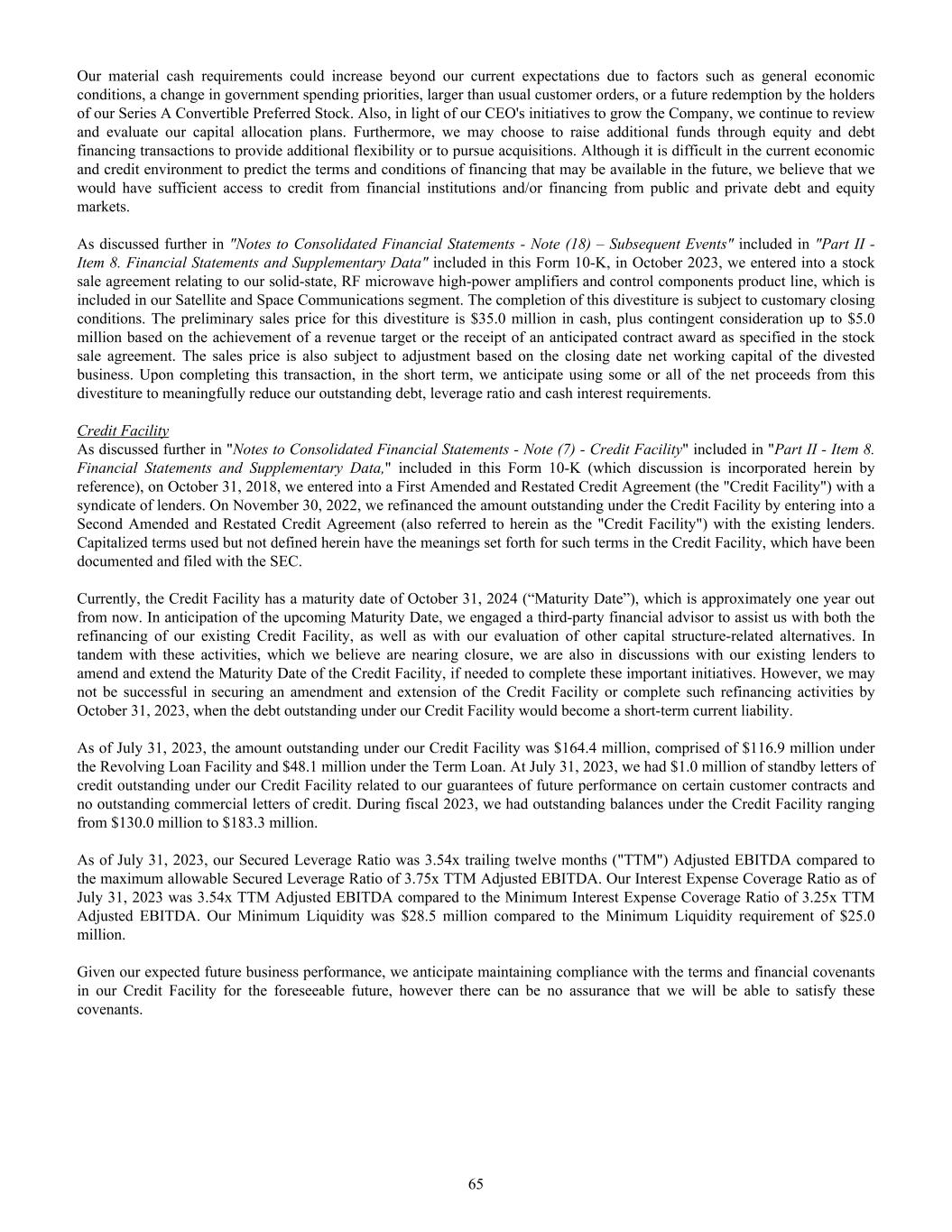
Our material cash requirements could increase beyond our current expectations due to factors such as general economic conditions, a change in government spending priorities, larger than usual customer orders, or a future redemption by the holders of our Series A Convertible Preferred Stock. Also, in light of our CEO's initiatives to grow the Company, we continue to review and evaluate our capital allocation plans. Furthermore, we may choose to raise additional funds through equity and debt financing transactions to provide additional flexibility or to pursue acquisitions. Although it is difficult in the current economic and credit environment to predict the terms and conditions of financing that may be available in the future, we believe that we would have sufficient access to credit from financial institutions and/or financing from public and private debt and equity markets. As discussed further in "Notes to Consolidated Financial Statements - Note (18) – Subsequent Events" included in "Part II - Item 8. Financial Statements and Supplementary Data" included in this Form 10-K, in October 2023, we entered into a stock sale agreement relating to our solid-state, RF microwave high-power amplifiers and control components product line, which is included in our Satellite and Space Communications segment. The completion of this divestiture is subject to customary closing conditions. The preliminary sales price for this divestiture is $35.0 million in cash, plus contingent consideration up to $5.0 million based on the achievement of a revenue target or the receipt of an anticipated contract award as specified in the stock sale agreement. The sales price is also subject to adjustment based on the closing date net working capital of the divested business. Upon completing this transaction, in the short term, we anticipate using some or all of the net proceeds from this divestiture to meaningfully reduce our outstanding debt, leverage ratio and cash interest requirements. Credit Facility As discussed further in "Notes to Consolidated Financial Statements - Note (7) - Credit Facility" included in "Part II - Item 8. Financial Statements and Supplementary Data," included in this Form 10-K (which discussion is incorporated herein by reference), on October 31, 2018, we entered into a First Amended and Restated Credit Agreement (the "Credit Facility") with a syndicate of lenders. On November 30, 2022, we refinanced the amount outstanding under the Credit Facility by entering into a Second Amended and Restated Credit Agreement (also referred to herein as the "Credit Facility") with the existing lenders. Capitalized terms used but not defined herein have the meanings set forth for such terms in the Credit Facility, which have been documented and filed with the SEC. Currently, the Credit Facility has a maturity date of October 31, 2024 (“Maturity Date”), which is approximately one year out from now. In anticipation of the upcoming Maturity Date, we engaged a third-party financial advisor to assist us with both the refinancing of our existing Credit Facility, as well as with our evaluation of other capital structure-related alternatives. In tandem with these activities, which we believe are nearing closure, we are also in discussions with our existing lenders to amend and extend the Maturity Date of the Credit Facility, if needed to complete these important initiatives. However, we may not be successful in securing an amendment and extension of the Credit Facility or complete such refinancing activities by October 31, 2023, when the debt outstanding under our Credit Facility would become a short-term current liability. As of July 31, 2023, the amount outstanding under our Credit Facility was $164.4 million, comprised of $116.9 million under the Revolving Loan Facility and $48.1 million under the Term Loan. At July 31, 2023, we had $1.0 million of standby letters of credit outstanding under our Credit Facility related to our guarantees of future performance on certain customer contracts and no outstanding commercial letters of credit. During fiscal 2023, we had outstanding balances under the Credit Facility ranging from $130.0 million to $183.3 million. As of July 31, 2023, our Secured Leverage Ratio was 3.54x trailing twelve months ("TTM") Adjusted EBITDA compared to the maximum allowable Secured Leverage Ratio of 3.75x TTM Adjusted EBITDA. Our Interest Expense Coverage Ratio as of July 31, 2023 was 3.54x TTM Adjusted EBITDA compared to the Minimum Interest Expense Coverage Ratio of 3.25x TTM Adjusted EBITDA. Our Minimum Liquidity was $28.5 million compared to the Minimum Liquidity requirement of $25.0 million. Given our expected future business performance, we anticipate maintaining compliance with the terms and financial covenants in our Credit Facility for the foreseeable future, however there can be no assurance that we will be able to satisfy these covenants. 65
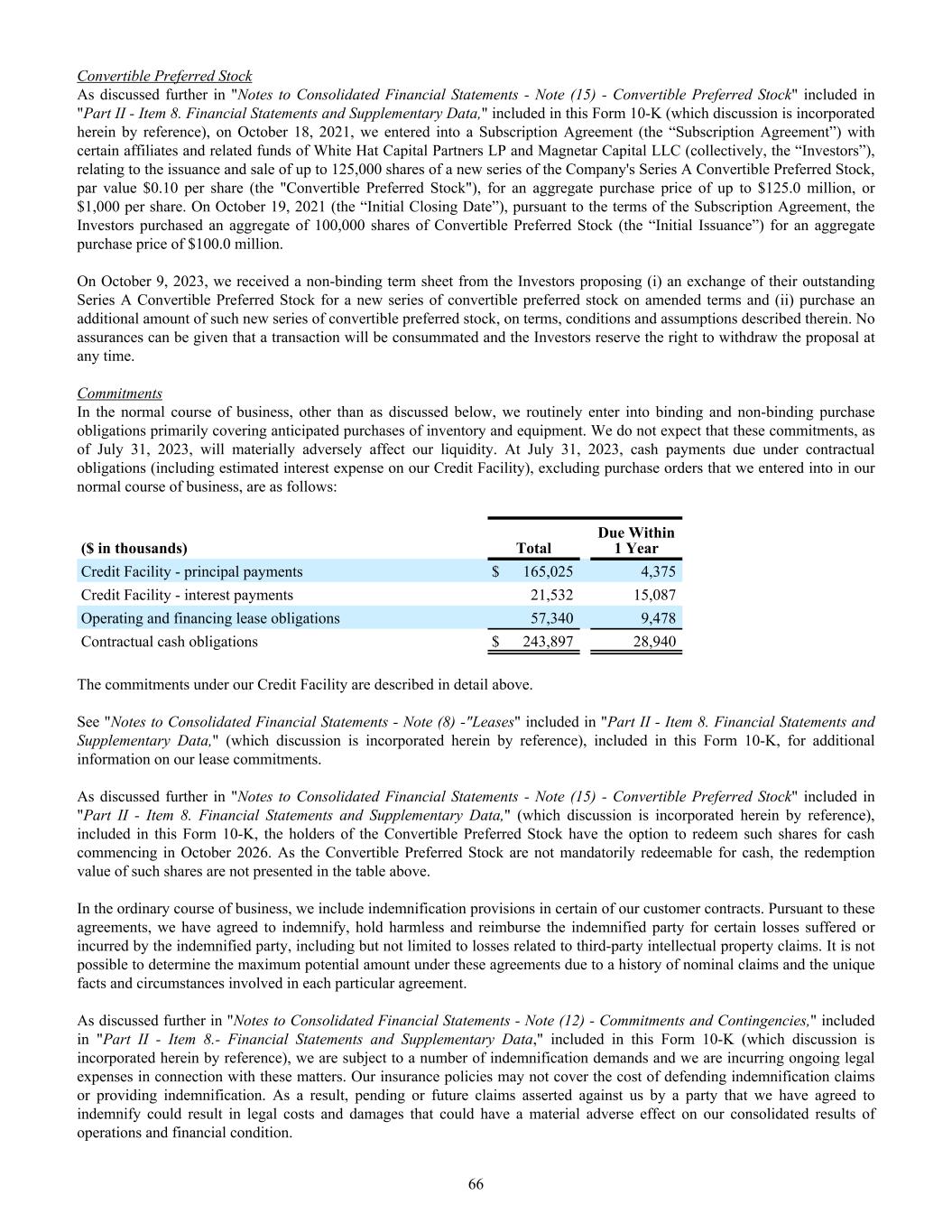
Convertible Preferred Stock As discussed further in "Notes to Consolidated Financial Statements - Note (15) - Convertible Preferred Stock" included in "Part II - Item 8. Financial Statements and Supplementary Data," included in this Form 10-K (which discussion is incorporated herein by reference), on October 18, 2021, we entered into a Subscription Agreement (the “Subscription Agreement”) with certain affiliates and related funds of White Hat Capital Partners LP and Magnetar Capital LLC (collectively, the “Investors”), relating to the issuance and sale of up to 125,000 shares of a new series of the Company's Series A Convertible Preferred Stock, par value $0.10 per share (the "Convertible Preferred Stock"), for an aggregate purchase price of up to $125.0 million, or $1,000 per share. On October 19, 2021 (the “Initial Closing Date”), pursuant to the terms of the Subscription Agreement, the Investors purchased an aggregate of 100,000 shares of Convertible Preferred Stock (the “Initial Issuance”) for an aggregate purchase price of $100.0 million. On October 9, 2023, we received a non-binding term sheet from the Investors proposing (i) an exchange of their outstanding Series A Convertible Preferred Stock for a new series of convertible preferred stock on amended terms and (ii) purchase an additional amount of such new series of convertible preferred stock, on terms, conditions and assumptions described therein. No assurances can be given that a transaction will be consummated and the Investors reserve the right to withdraw the proposal at any time. Commitments In the normal course of business, other than as discussed below, we routinely enter into binding and non-binding purchase obligations primarily covering anticipated purchases of inventory and equipment. We do not expect that these commitments, as of July 31, 2023, will materially adversely affect our liquidity. At July 31, 2023, cash payments due under contractual obligations (including estimated interest expense on our Credit Facility), excluding purchase orders that we entered into in our normal course of business, are as follows: ($ in thousands) Total Due Within 1 Year Credit Facility - principal payments $ 165,025 4,375 Credit Facility - interest payments 21,532 15,087 Operating and financing lease obligations 57,340 9,478 Contractual cash obligations $ 243,897 28,940 The commitments under our Credit Facility are described in detail above. See "Notes to Consolidated Financial Statements - Note (8) -"Leases" included in "Part II - Item 8. Financial Statements and Supplementary Data," (which discussion is incorporated herein by reference), included in this Form 10-K, for additional information on our lease commitments. As discussed further in "Notes to Consolidated Financial Statements - Note (15) - Convertible Preferred Stock" included in "Part II - Item 8. Financial Statements and Supplementary Data," (which discussion is incorporated herein by reference), included in this Form 10-K, the holders of the Convertible Preferred Stock have the option to redeem such shares for cash commencing in October 2026. As the Convertible Preferred Stock are not mandatorily redeemable for cash, the redemption value of such shares are not presented in the table above. In the ordinary course of business, we include indemnification provisions in certain of our customer contracts. Pursuant to these agreements, we have agreed to indemnify, hold harmless and reimburse the indemnified party for certain losses suffered or incurred by the indemnified party, including but not limited to losses related to third-party intellectual property claims. It is not possible to determine the maximum potential amount under these agreements due to a history of nominal claims and the unique facts and circumstances involved in each particular agreement. As discussed further in "Notes to Consolidated Financial Statements - Note (12) - Commitments and Contingencies," included in "Part II - Item 8.- Financial Statements and Supplementary Data," included in this Form 10-K (which discussion is incorporated herein by reference), we are subject to a number of indemnification demands and we are incurring ongoing legal expenses in connection with these matters. Our insurance policies may not cover the cost of defending indemnification claims or providing indemnification. As a result, pending or future claims asserted against us by a party that we have agreed to indemnify could result in legal costs and damages that could have a material adverse effect on our consolidated results of operations and financial condition. 66
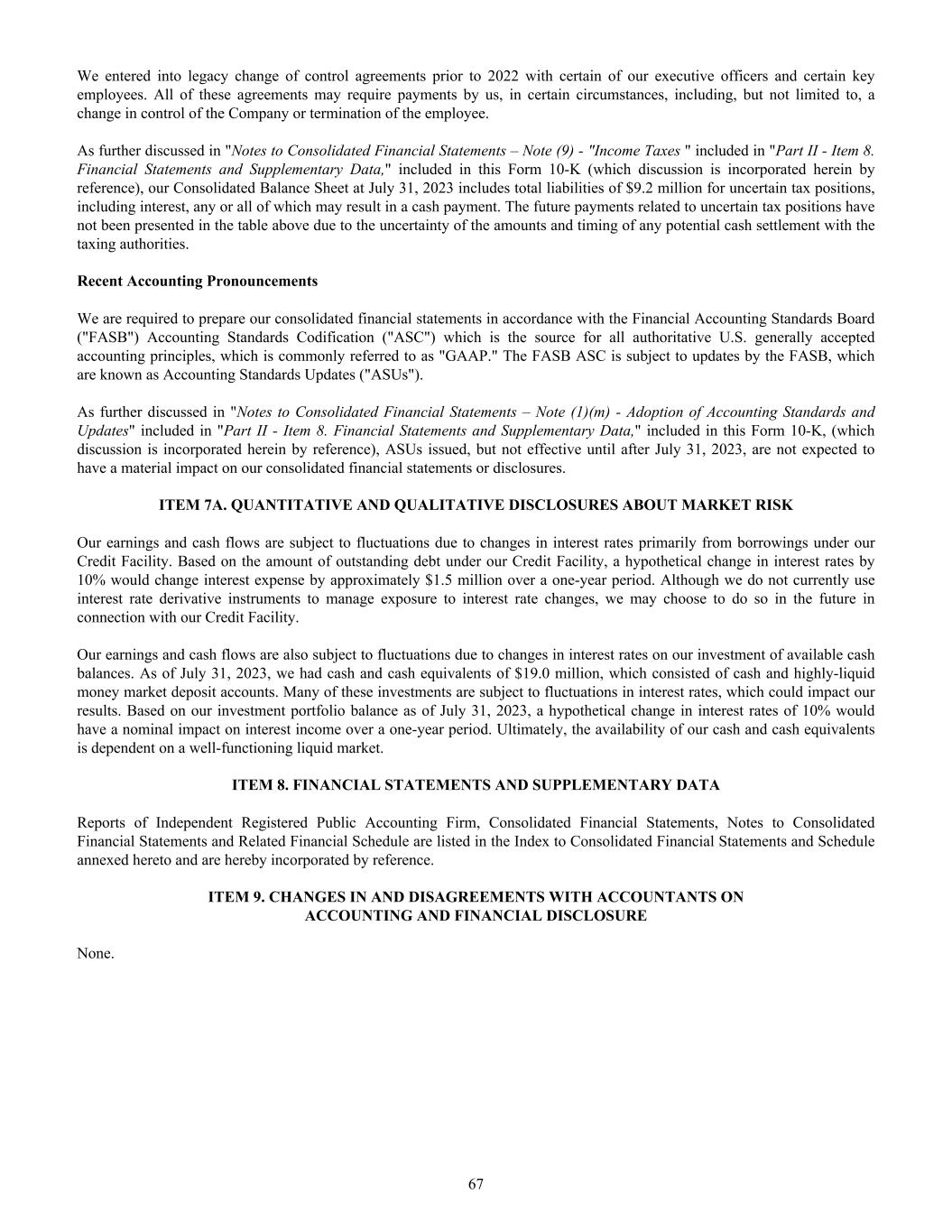
We entered into legacy change of control agreements prior to 2022 with certain of our executive officers and certain key employees. All of these agreements may require payments by us, in certain circumstances, including, but not limited to, a change in control of the Company or termination of the employee. As further discussed in "Notes to Consolidated Financial Statements – Note (9) - "Income Taxes " included in "Part II - Item 8. Financial Statements and Supplementary Data," included in this Form 10-K (which discussion is incorporated herein by reference), our Consolidated Balance Sheet at July 31, 2023 includes total liabilities of $9.2 million for uncertain tax positions, including interest, any or all of which may result in a cash payment. The future payments related to uncertain tax positions have not been presented in the table above due to the uncertainty of the amounts and timing of any potential cash settlement with the taxing authorities. Recent Accounting Pronouncements We are required to prepare our consolidated financial statements in accordance with the Financial Accounting Standards Board ("FASB") Accounting Standards Codification ("ASC") which is the source for all authoritative U.S. generally accepted accounting principles, which is commonly referred to as "GAAP." The FASB ASC is subject to updates by the FASB, which are known as Accounting Standards Updates ("ASUs"). As further discussed in "Notes to Consolidated Financial Statements – Note (1)(m) - Adoption of Accounting Standards and Updates" included in "Part II - Item 8. Financial Statements and Supplementary Data," included in this Form 10-K, (which discussion is incorporated herein by reference), ASUs issued, but not effective until after July 31, 2023, are not expected to have a material impact on our consolidated financial statements or disclosures. ITEM 7A. QUANTITATIVE AND QUALITATIVE DISCLOSURES ABOUT MARKET RISK Our earnings and cash flows are subject to fluctuations due to changes in interest rates primarily from borrowings under our Credit Facility. Based on the amount of outstanding debt under our Credit Facility, a hypothetical change in interest rates by 10% would change interest expense by approximately $1.5 million over a one-year period. Although we do not currently use interest rate derivative instruments to manage exposure to interest rate changes, we may choose to do so in the future in connection with our Credit Facility. Our earnings and cash flows are also subject to fluctuations due to changes in interest rates on our investment of available cash balances. As of July 31, 2023, we had cash and cash equivalents of $19.0 million, which consisted of cash and highly-liquid money market deposit accounts. Many of these investments are subject to fluctuations in interest rates, which could impact our results. Based on our investment portfolio balance as of July 31, 2023, a hypothetical change in interest rates of 10% would have a nominal impact on interest income over a one-year period. Ultimately, the availability of our cash and cash equivalents is dependent on a well-functioning liquid market. ITEM 8. FINANCIAL STATEMENTS AND SUPPLEMENTARY DATA Reports of Independent Registered Public Accounting Firm, Consolidated Financial Statements, Notes to Consolidated Financial Statements and Related Financial Schedule are listed in the Index to Consolidated Financial Statements and Schedule annexed hereto and are hereby incorporated by reference. ITEM 9. CHANGES IN AND DISAGREEMENTS WITH ACCOUNTANTS ON ACCOUNTING AND FINANCIAL DISCLOSURE None. 67
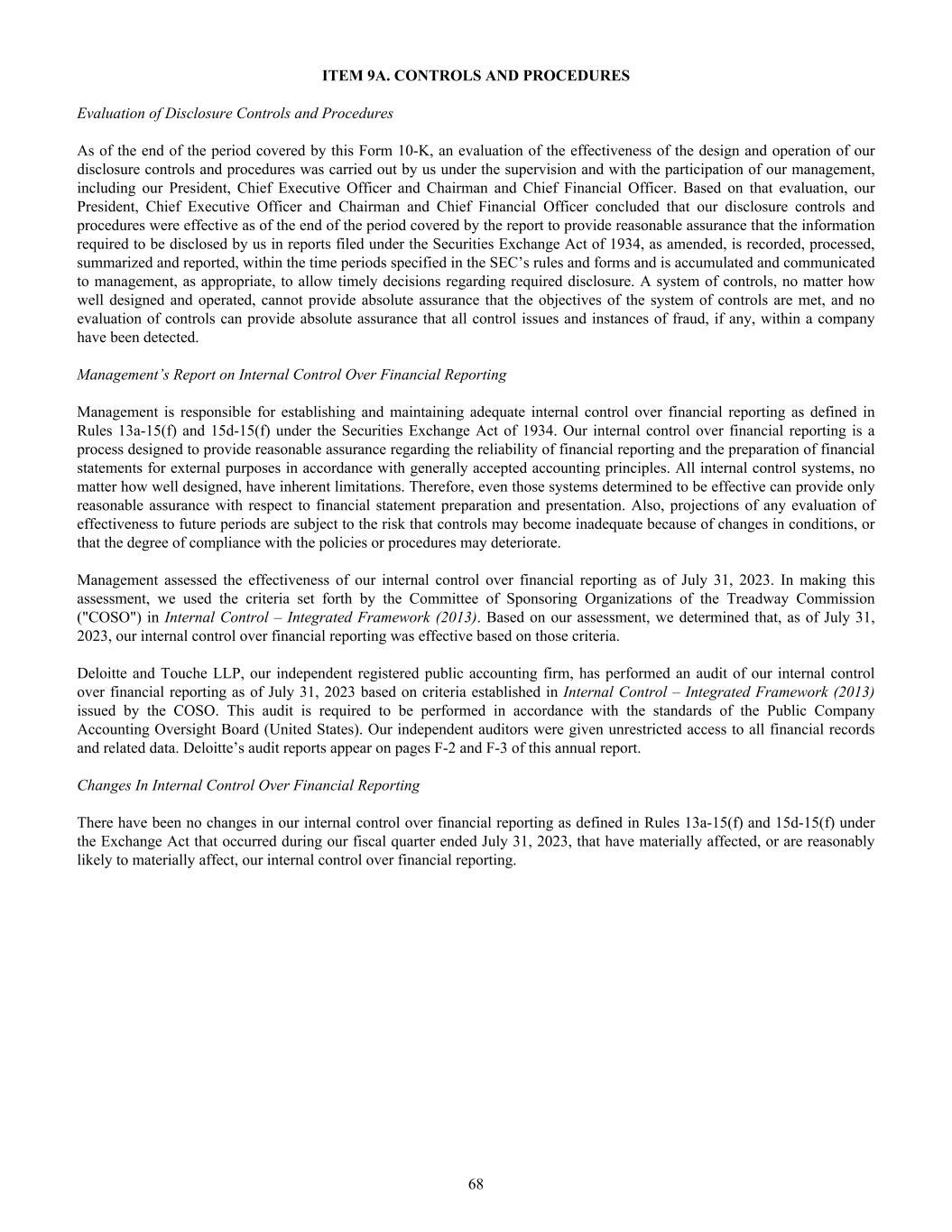
ITEM 9A. CONTROLS AND PROCEDURES Evaluation of Disclosure Controls and Procedures As of the end of the period covered by this Form 10-K, an evaluation of the effectiveness of the design and operation of our disclosure controls and procedures was carried out by us under the supervision and with the participation of our management, including our President, Chief Executive Officer and Chairman and Chief Financial Officer. Based on that evaluation, our President, Chief Executive Officer and Chairman and Chief Financial Officer concluded that our disclosure controls and procedures were effective as of the end of the period covered by the report to provide reasonable assurance that the information required to be disclosed by us in reports filed under the Securities Exchange Act of 1934, as amended, is recorded, processed, summarized and reported, within the time periods specified in the SEC’s rules and forms and is accumulated and communicated to management, as appropriate, to allow timely decisions regarding required disclosure. A system of controls, no matter how well designed and operated, cannot provide absolute assurance that the objectives of the system of controls are met, and no evaluation of controls can provide absolute assurance that all control issues and instances of fraud, if any, within a company have been detected. Management’s Report on Internal Control Over Financial Reporting Management is responsible for establishing and maintaining adequate internal control over financial reporting as defined in Rules 13a-15(f) and 15d-15(f) under the Securities Exchange Act of 1934. Our internal control over financial reporting is a process designed to provide reasonable assurance regarding the reliability of financial reporting and the preparation of financial statements for external purposes in accordance with generally accepted accounting principles. All internal control systems, no matter how well designed, have inherent limitations. Therefore, even those systems determined to be effective can provide only reasonable assurance with respect to financial statement preparation and presentation. Also, projections of any evaluation of effectiveness to future periods are subject to the risk that controls may become inadequate because of changes in conditions, or that the degree of compliance with the policies or procedures may deteriorate. Management assessed the effectiveness of our internal control over financial reporting as of July 31, 2023. In making this assessment, we used the criteria set forth by the Committee of Sponsoring Organizations of the Treadway Commission ("COSO") in Internal Control – Integrated Framework (2013). Based on our assessment, we determined that, as of July 31, 2023, our internal control over financial reporting was effective based on those criteria. Deloitte and Touche LLP, our independent registered public accounting firm, has performed an audit of our internal control over financial reporting as of July 31, 2023 based on criteria established in Internal Control – Integrated Framework (2013) issued by the COSO. This audit is required to be performed in accordance with the standards of the Public Company Accounting Oversight Board (United States). Our independent auditors were given unrestricted access to all financial records and related data. Deloitte’s audit reports appear on pages F-2 and F-3 of this annual report. Changes In Internal Control Over Financial Reporting There have been no changes in our internal control over financial reporting as defined in Rules 13a-15(f) and 15d-15(f) under the Exchange Act that occurred during our fiscal quarter ended July 31, 2023, that have materially affected, or are reasonably likely to materially affect, our internal control over financial reporting. 68

ITEM 9B. OTHER INFORMATION Securities Trading Plans of Directors and Officers During the three months ended July 31, 2023, none of our directors or officers adopted or terminated a Rule 10b5-1 trading plan or adopted or terminated a non-Rule 10b5-1 trading arrangement (as each term is defined in Item 408(a) of Regulation S-K). ITEM 9C. DISCLOSURE REGARDING FOREIGN JURISDICTIONS THAT PREVENT INSPECTIONS Not applicable. 69
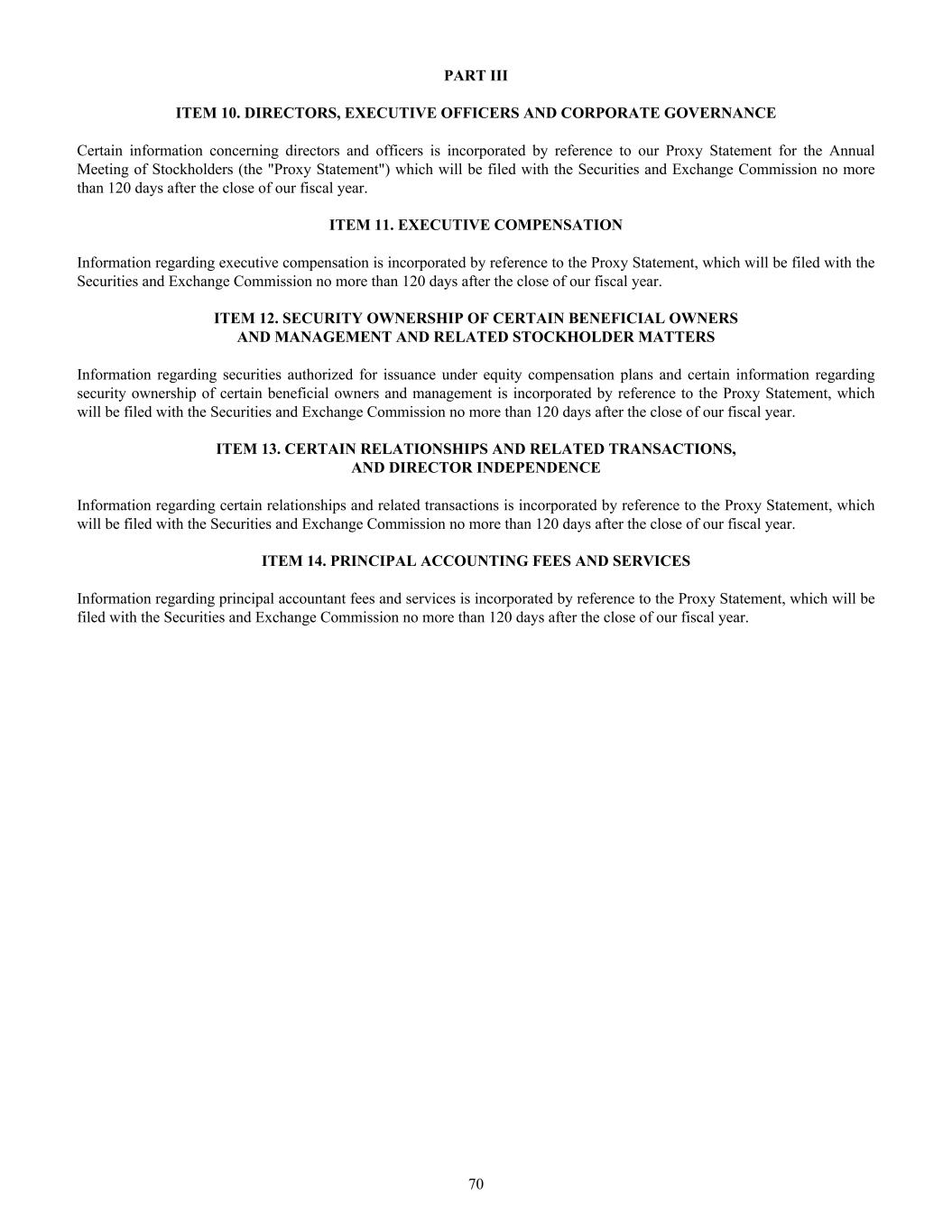
PART III ITEM 10. DIRECTORS, EXECUTIVE OFFICERS AND CORPORATE GOVERNANCE Certain information concerning directors and officers is incorporated by reference to our Proxy Statement for the Annual Meeting of Stockholders (the "Proxy Statement") which will be filed with the Securities and Exchange Commission no more than 120 days after the close of our fiscal year. ITEM 11. EXECUTIVE COMPENSATION Information regarding executive compensation is incorporated by reference to the Proxy Statement, which will be filed with the Securities and Exchange Commission no more than 120 days after the close of our fiscal year. ITEM 12. SECURITY OWNERSHIP OF CERTAIN BENEFICIAL OWNERS AND MANAGEMENT AND RELATED STOCKHOLDER MATTERS Information regarding securities authorized for issuance under equity compensation plans and certain information regarding security ownership of certain beneficial owners and management is incorporated by reference to the Proxy Statement, which will be filed with the Securities and Exchange Commission no more than 120 days after the close of our fiscal year. ITEM 13. CERTAIN RELATIONSHIPS AND RELATED TRANSACTIONS, AND DIRECTOR INDEPENDENCE Information regarding certain relationships and related transactions is incorporated by reference to the Proxy Statement, which will be filed with the Securities and Exchange Commission no more than 120 days after the close of our fiscal year. ITEM 14. PRINCIPAL ACCOUNTING FEES AND SERVICES Information regarding principal accountant fees and services is incorporated by reference to the Proxy Statement, which will be filed with the Securities and Exchange Commission no more than 120 days after the close of our fiscal year. 70
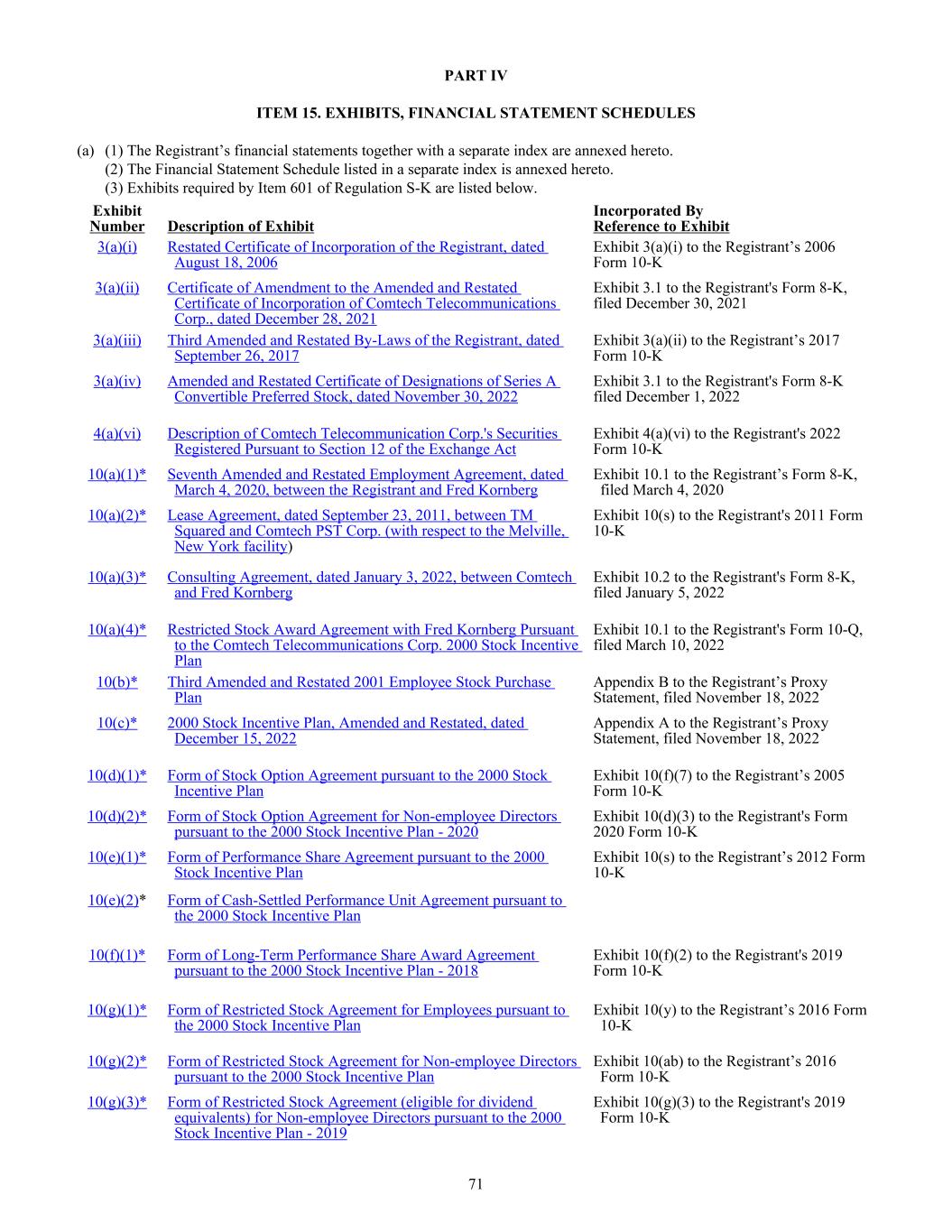
PART IV ITEM 15. EXHIBITS, FINANCIAL STATEMENT SCHEDULES (a) (1) The Registrant’s financial statements together with a separate index are annexed hereto. (2) The Financial Statement Schedule listed in a separate index is annexed hereto. (3) Exhibits required by Item 601 of Regulation S-K are listed below. 3(a)(i) Restated Certificate of Incorporation of the Registrant, dated August 18, 2006 Exhibit 3(a)(i) to the Registrant’s 2006 Form 10-K 3(a)(ii) Certificate of Amendment to the Amended and Restated Certificate of Incorporation of Comtech Telecommunications Corp., dated December 28, 2021 Exhibit 3.1 to the Registrant's Form 8-K, filed December 30, 2021 3(a)(iii) Third Amended and Restated By-Laws of the Registrant, dated September 26, 2017 Exhibit 3(a)(ii) to the Registrant’s 2017 Form 10-K 3(a)(iv) Amended and Restated Certificate of Designations of Series A Convertible Preferred Stock, dated November 30, 2022 Exhibit 3.1 to the Registrant's Form 8-K filed December 1, 2022 4(a)(vi) Description of Comtech Telecommunication Corp.'s Securities Registered Pursuant to Section 12 of the Exchange Act Exhibit 4(a)(vi) to the Registrant's 2022 Form 10-K 10(a)(1)* Seventh Amended and Restated Employment Agreement, dated March 4, 2020, between the Registrant and Fred Kornberg Exhibit 10.1 to the Registrant’s Form 8-K, filed March 4, 2020 10(a)(2)* Lease Agreement, dated September 23, 2011, between TM Squared and Comtech PST Corp. (with respect to the Melville, New York facility) Exhibit 10(s) to the Registrant's 2011 Form 10-K 10(a)(3)* Consulting Agreement, dated January 3, 2022, between Comtech and Fred Kornberg Exhibit 10.2 to the Registrant's Form 8-K, filed January 5, 2022 10(a)(4)* Restricted Stock Award Agreement with Fred Kornberg Pursuant to the Comtech Telecommunications Corp. 2000 Stock Incentive Plan Exhibit 10.1 to the Registrant's Form 10-Q, filed March 10, 2022 10(b)* Third Amended and Restated 2001 Employee Stock Purchase Plan Appendix B to the Registrant’s Proxy Statement, filed November 18, 2022 10(c)* 2000 Stock Incentive Plan, Amended and Restated, dated December 15, 2022 Appendix A to the Registrant’s Proxy Statement, filed November 18, 2022 10(d)(1)* Form of Stock Option Agreement pursuant to the 2000 Stock Incentive Plan Exhibit 10(f)(7) to the Registrant’s 2005 Form 10-K 10(d)(2)* Form of Stock Option Agreement for Non-employee Directors pursuant to the 2000 Stock Incentive Plan - 2020 Exhibit 10(d)(3) to the Registrant's Form 2020 Form 10-K 10(e)(1)* Form of Performance Share Agreement pursuant to the 2000 Stock Incentive Plan Exhibit 10(s) to the Registrant’s 2012 Form 10-K 10(e)(2)* Form of Cash-Settled Performance Unit Agreement pursuant to the 2000 Stock Incentive Plan 10(f)(1)* Form of Long-Term Performance Share Award Agreement pursuant to the 2000 Stock Incentive Plan - 2018 Exhibit 10(f)(2) to the Registrant's 2019 Form 10-K 10(g)(1)* Form of Restricted Stock Agreement for Employees pursuant to the 2000 Stock Incentive Plan Exhibit 10(y) to the Registrant’s 2016 Form 10-K 10(g)(2)* Form of Restricted Stock Agreement for Non-employee Directors pursuant to the 2000 Stock Incentive Plan Exhibit 10(ab) to the Registrant’s 2016 Form 10-K 10(g)(3)* Form of Restricted Stock Agreement (eligible for dividend equivalents) for Non-employee Directors pursuant to the 2000 Stock Incentive Plan - 2019 Exhibit 10(g)(3) to the Registrant's 2019 Form 10-K Exhibit Number Description of Exhibit Incorporated By Reference to Exhibit 71

10(g)(4)* Form of Restricted Stock Agreement (eligible for dividend equivalents) for Non-employee Directors pursuant to the 2000 Stock Incentive Plan - 2022 Exhibit 10(g)(4) to the Registrant's 2022 Form 10-K 10(h)(1)* Form of Restricted Stock Unit Agreement for Employees pursuant to the 2000 Stock Incentive Plan - 2017 Exhibit 10(h)(1) to the Registrant’s 2017 Form 10-K 10(h)(2)* Form of Restricted Stock Unit Agreement for Employees pursuant to the 2000 Stock Incentive Plan - 2016 Exhibit 10(z) to the Registrant’s 2016 Form 10-K 10(h)(3)* Form of Restricted Stock Unit Agreement for Non-employee Directors pursuant to the 2000 Stock Incentive Plan Exhibit 10.2 to the Registrant's Form 10-Q, filed June 7, 2012 10(h)(4)* Form of Restricted Stock Unit Agreement (eligible for dividend equivalents) for Non-employee Directors pursuant to the 2000 Stock Incentive Plan Exhibit 10(aa) to the Registrant’s 2016 Form 10-K 10(h)(5)* Form of Restricted Stock Unit Agreement (eligible for dividend equivalents) for Non-employee Directors pursuant to the 2000 Stock Incentive Plan - 2013 Exhibit 10(x) to the Registrant's 2013 Form 10-K 10(h)(6)* Form of Restricted Stock Unit Agreement (eligible for dividend equivalents) for Non-employee Directors pursuant to the 2000 Stock Incentive Plan - 2020 Exhibit 10.1 to the Registrant's Form 10-Q, filed June 3, 2020 10(h)(7)* Form of Restricted Stock Unit Agreement (eligible for dividend equivalents) for Non-employee Directors pursuant to the 2000 Stock Incentive Plan - 2022 Exhibit 10(h)(7) to the Registrant's 2022 Form 10-K 10(h)(8)* Form of Restricted Stock Unit Agreement (eligible for dividend equivalents) for Employees pursuant to the 2000 Stock Incentive Plan - 2022 Exhibit 10(h)(8) to the Registrant's 2022 Form 10-K 10(i)(1)* Form of Stock Unit Agreement for Non-employee Directors pursuant to the 2000 Stock Incentive Plan Exhibit 10.1 to the Registrant's Form 10-Q, filed June 7, 2012 10(i)(2)* Form of Stock Unit Agreement (eligible for dividend equivalents) for Non-employee Directors pursuant to the 2000 Stock Incentive Plan Exhibit 10(v) to the Registrant's 2013 Form 10-K 10(i)(3)* Form of Other Stock-Based Award Agreement pursuant to the 2000 Stock Incentive Plan 10(j)(1)* Form of Share Unit Agreement (eligible for dividend equivalents) for Employees pursuant to the 2000 Stock Incentive Plan Exhibit 10.2 to the Registrant's Form 10-Q, filed December 9, 2013 10(j)(2)* Form of Share Unit Agreement (eligible for dividend equivalents) for Employees pursuant to the 2000 Stock Incentive Plan - 2018 Exhibit 10(j)(2) to the Registrant's 2018 Form 10-K 10(k)* Form of Indemnification Agreement between the Registrant and the Named Executive Officers and Certain Other Executive Officers Exhibit 10.1 to Registrant’s Form 8-K, filed on March 8, 2007 10(l)(1)* Form of Change-in-Control Agreement (Tier 1) Exhibit 10(l)(1) to the Registrant's 2022 Form 10-K 10(l)(2)* Form of Change-in-Control Agreement (Tier 2) between the Registrant and Certain Named Executive Officers (other than the CEO) and Certain Other Executive Officers Exhibit 10(l)(2) to the Registrant's 2022 Form 10-K Exhibit Number Description of Exhibit Incorporated By Reference to Exhibit 72
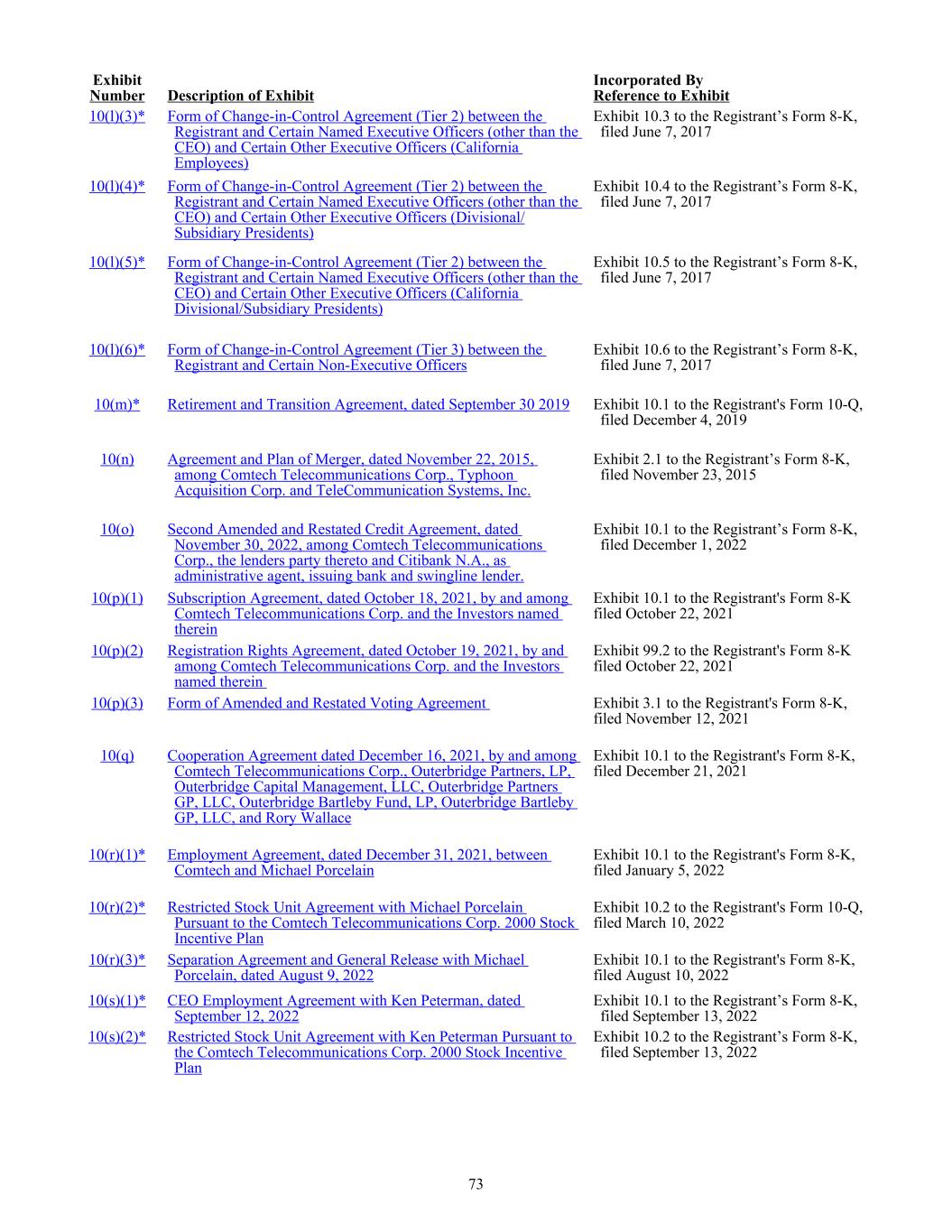
10(l)(3)* Form of Change-in-Control Agreement (Tier 2) between the Registrant and Certain Named Executive Officers (other than the CEO) and Certain Other Executive Officers (California Employees) Exhibit 10.3 to the Registrant’s Form 8-K, filed June 7, 2017 10(l)(4)* Form of Change-in-Control Agreement (Tier 2) between the Registrant and Certain Named Executive Officers (other than the CEO) and Certain Other Executive Officers (Divisional/ Subsidiary Presidents) Exhibit 10.4 to the Registrant’s Form 8-K, filed June 7, 2017 10(l)(5)* Form of Change-in-Control Agreement (Tier 2) between the Registrant and Certain Named Executive Officers (other than the CEO) and Certain Other Executive Officers (California Divisional/Subsidiary Presidents) Exhibit 10.5 to the Registrant’s Form 8-K, filed June 7, 2017 10(l)(6)* Form of Change-in-Control Agreement (Tier 3) between the Registrant and Certain Non-Executive Officers Exhibit 10.6 to the Registrant’s Form 8-K, filed June 7, 2017 10(m)* Retirement and Transition Agreement, dated September 30 2019 Exhibit 10.1 to the Registrant's Form 10-Q, filed December 4, 2019 10(n) Agreement and Plan of Merger, dated November 22, 2015, among Comtech Telecommunications Corp., Typhoon Acquisition Corp. and TeleCommunication Systems, Inc. Exhibit 2.1 to the Registrant’s Form 8-K, filed November 23, 2015 10(o) Second Amended and Restated Credit Agreement, dated November 30, 2022, among Comtech Telecommunications Corp., the lenders party thereto and Citibank N.A., as administrative agent, issuing bank and swingline lender. Exhibit 10.1 to the Registrant’s Form 8-K, filed December 1, 2022 10(p)(1) Subscription Agreement, dated October 18, 2021, by and among Comtech Telecommunications Corp. and the Investors named therein Exhibit 10.1 to the Registrant's Form 8-K filed October 22, 2021 10(p)(2) Registration Rights Agreement, dated October 19, 2021, by and among Comtech Telecommunications Corp. and the Investors named therein Exhibit 99.2 to the Registrant's Form 8-K filed October 22, 2021 10(p)(3) Form of Amended and Restated Voting Agreement Exhibit 3.1 to the Registrant's Form 8-K, filed November 12, 2021 10(q) Cooperation Agreement dated December 16, 2021, by and among Comtech Telecommunications Corp., Outerbridge Partners, LP, Outerbridge Capital Management, LLC, Outerbridge Partners GP, LLC, Outerbridge Bartleby Fund, LP, Outerbridge Bartleby GP, LLC, and Rory Wallace Exhibit 10.1 to the Registrant's Form 8-K, filed December 21, 2021 10(r)(1)* Employment Agreement, dated December 31, 2021, between Comtech and Michael Porcelain Exhibit 10.1 to the Registrant's Form 8-K, filed January 5, 2022 10(r)(2)* Restricted Stock Unit Agreement with Michael Porcelain Pursuant to the Comtech Telecommunications Corp. 2000 Stock Incentive Plan Exhibit 10.2 to the Registrant's Form 10-Q, filed March 10, 2022 10(r)(3)* Separation Agreement and General Release with Michael Porcelain, dated August 9, 2022 Exhibit 10.1 to the Registrant's Form 8-K, filed August 10, 2022 10(s)(1)* CEO Employment Agreement with Ken Peterman, dated September 12, 2022 Exhibit 10.1 to the Registrant’s Form 8-K, filed September 13, 2022 10(s)(2)* Restricted Stock Unit Agreement with Ken Peterman Pursuant to the Comtech Telecommunications Corp. 2000 Stock Incentive Plan Exhibit 10.2 to the Registrant’s Form 8-K, filed September 13, 2022 Exhibit Number Description of Exhibit Incorporated By Reference to Exhibit 73
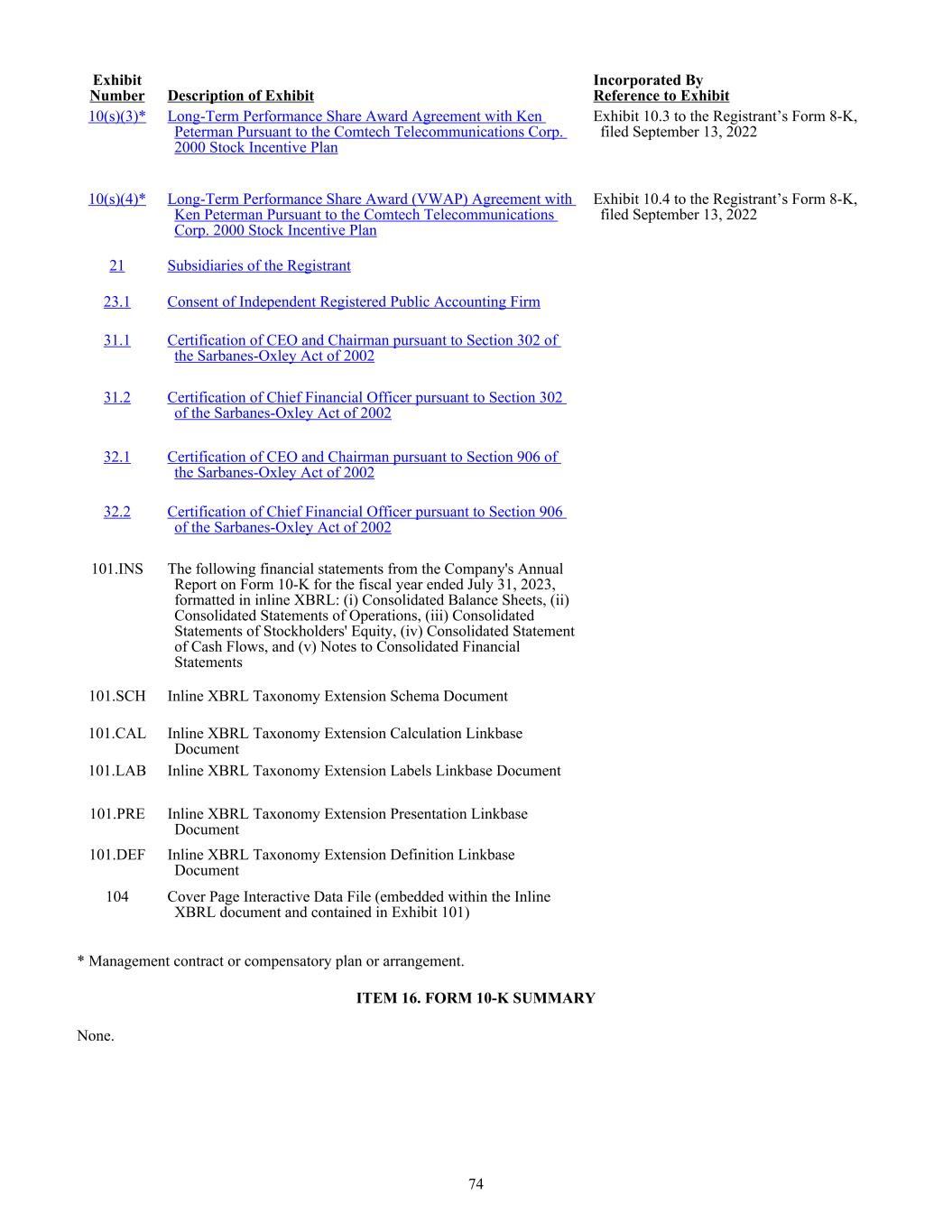
10(s)(3)* Long-Term Performance Share Award Agreement with Ken Peterman Pursuant to the Comtech Telecommunications Corp. 2000 Stock Incentive Plan Exhibit 10.3 to the Registrant’s Form 8-K, filed September 13, 2022 10(s)(4)* Long-Term Performance Share Award (VWAP) Agreement with Ken Peterman Pursuant to the Comtech Telecommunications Corp. 2000 Stock Incentive Plan Exhibit 10.4 to the Registrant’s Form 8-K, filed September 13, 2022 21 Subsidiaries of the Registrant 23.1 Consent of Independent Registered Public Accounting Firm 31.1 Certification of CEO and Chairman pursuant to Section 302 of the Sarbanes-Oxley Act of 2002 31.2 Certification of Chief Financial Officer pursuant to Section 302 of the Sarbanes-Oxley Act of 2002 32.1 Certification of CEO and Chairman pursuant to Section 906 of the Sarbanes-Oxley Act of 2002 32.2 Certification of Chief Financial Officer pursuant to Section 906 of the Sarbanes-Oxley Act of 2002 101.INS The following financial statements from the Company's Annual Report on Form 10-K for the fiscal year ended July 31, 2023, formatted in inline XBRL: (i) Consolidated Balance Sheets, (ii) Consolidated Statements of Operations, (iii) Consolidated Statements of Stockholders' Equity, (iv) Consolidated Statement of Cash Flows, and (v) Notes to Consolidated Financial Statements 101.SCH Inline XBRL Taxonomy Extension Schema Document 101.CAL Inline XBRL Taxonomy Extension Calculation Linkbase Document 101.LAB Inline XBRL Taxonomy Extension Labels Linkbase Document 101.PRE Inline XBRL Taxonomy Extension Presentation Linkbase Document 101.DEF Inline XBRL Taxonomy Extension Definition Linkbase Document 104 Cover Page Interactive Data File (embedded within the Inline XBRL document and contained in Exhibit 101) Exhibit Number Description of Exhibit Incorporated By Reference to Exhibit * Management contract or compensatory plan or arrangement. ITEM 16. FORM 10-K SUMMARY None. 74
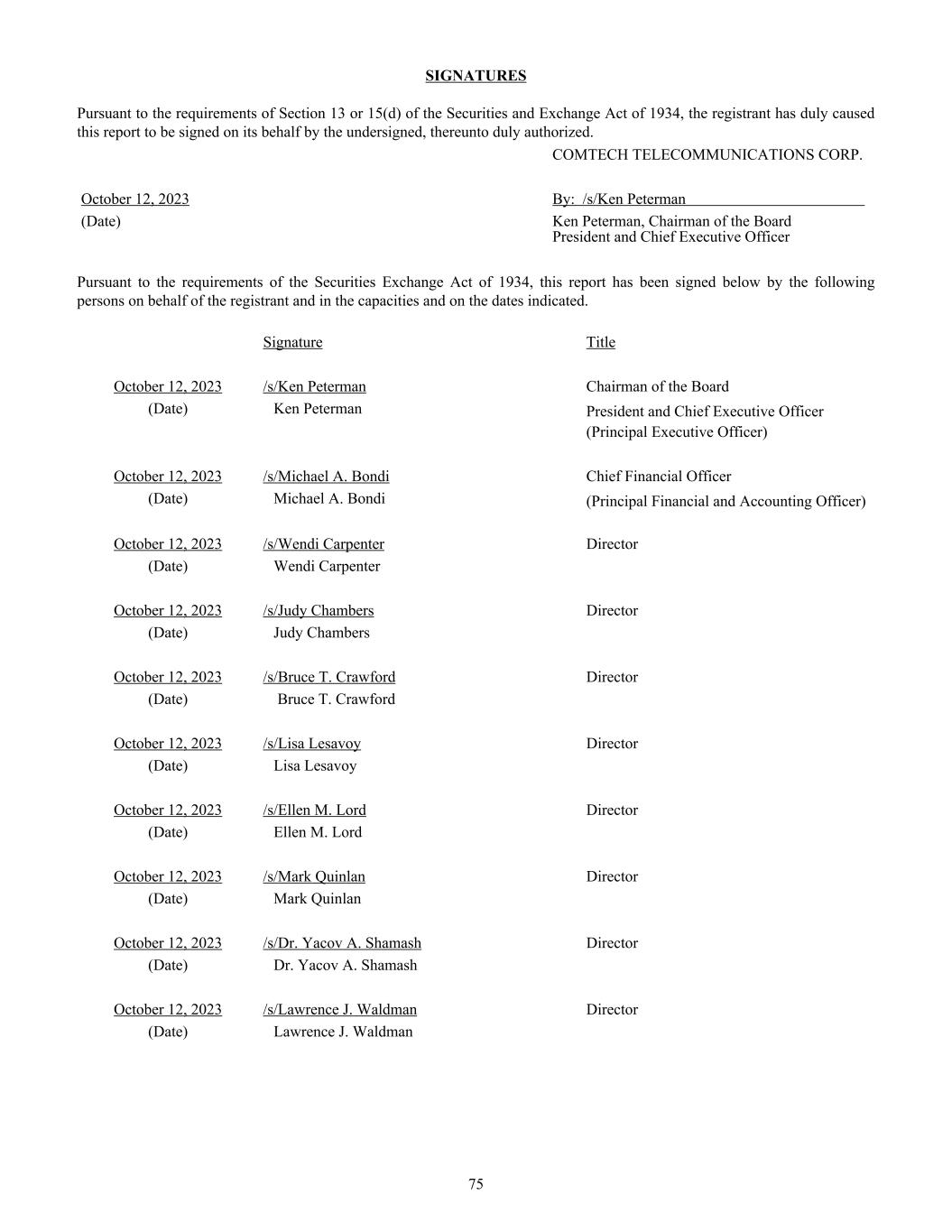
SIGNATURES Pursuant to the requirements of Section 13 or 15(d) of the Securities and Exchange Act of 1934, the registrant has duly caused this report to be signed on its behalf by the undersigned, thereunto duly authorized. COMTECH TELECOMMUNICATIONS CORP. October 12, 2023 By: /s/Ken Peterman (Date) Ken Peterman, Chairman of the Board President and Chief Executive Officer Pursuant to the requirements of the Securities Exchange Act of 1934, this report has been signed below by the following persons on behalf of the registrant and in the capacities and on the dates indicated. Signature Title October 12, 2023 /s/Ken Peterman Chairman of the Board (Date) Ken Peterman President and Chief Executive Officer (Principal Executive Officer) October 12, 2023 /s/Michael A. Bondi Chief Financial Officer (Date) Michael A. Bondi (Principal Financial and Accounting Officer) October 12, 2023 /s/Wendi Carpenter Director (Date) Wendi Carpenter October 12, 2023 /s/Judy Chambers Director (Date) Judy Chambers October 12, 2023 /s/Bruce T. Crawford Director (Date) Bruce T. Crawford October 12, 2023 /s/Lisa Lesavoy Director (Date) Lisa Lesavoy October 12, 2023 /s/Ellen M. Lord Director (Date) Ellen M. Lord October 12, 2023 /s/Mark Quinlan Director (Date) Mark Quinlan October 12, 2023 /s/Dr. Yacov A. Shamash Director (Date) Dr. Yacov A. Shamash October 12, 2023 /s/Lawrence J. Waldman Director (Date) Lawrence J. Waldman 75

COMTECH TELECOMMUNICATIONS CORP. AND SUBSIDIARIES Index to Consolidated Financial Statements and Schedule Page Reports of Independent Registered Public Accounting Firm (PCAOB ID: 34) F-2 Consolidated Financial Statements: Balance Sheets as of July 31, 2023 and 2022 F-6 Statements of Operations for each of the years in the three-year period ended July 31, 2023 F-7 Statements of Convertible Preferred Stock and Stockholders' Equity for each of the years in the three-year period ended July 31, 2023 F-8 Statements of Cash Flows for each of the years in the three-year period ended July 31, 2023 F-9 Notes to Consolidated Financial Statements F-11 Additional Financial Information Pursuant to the Requirements of Form 10-K: Schedule II – Valuation and Qualifying Accounts and Reserves S-1 Schedules not listed above have been omitted because they are either not applicable or the required information has been provided elsewhere in the consolidated financial statements or notes thereto. F - 1
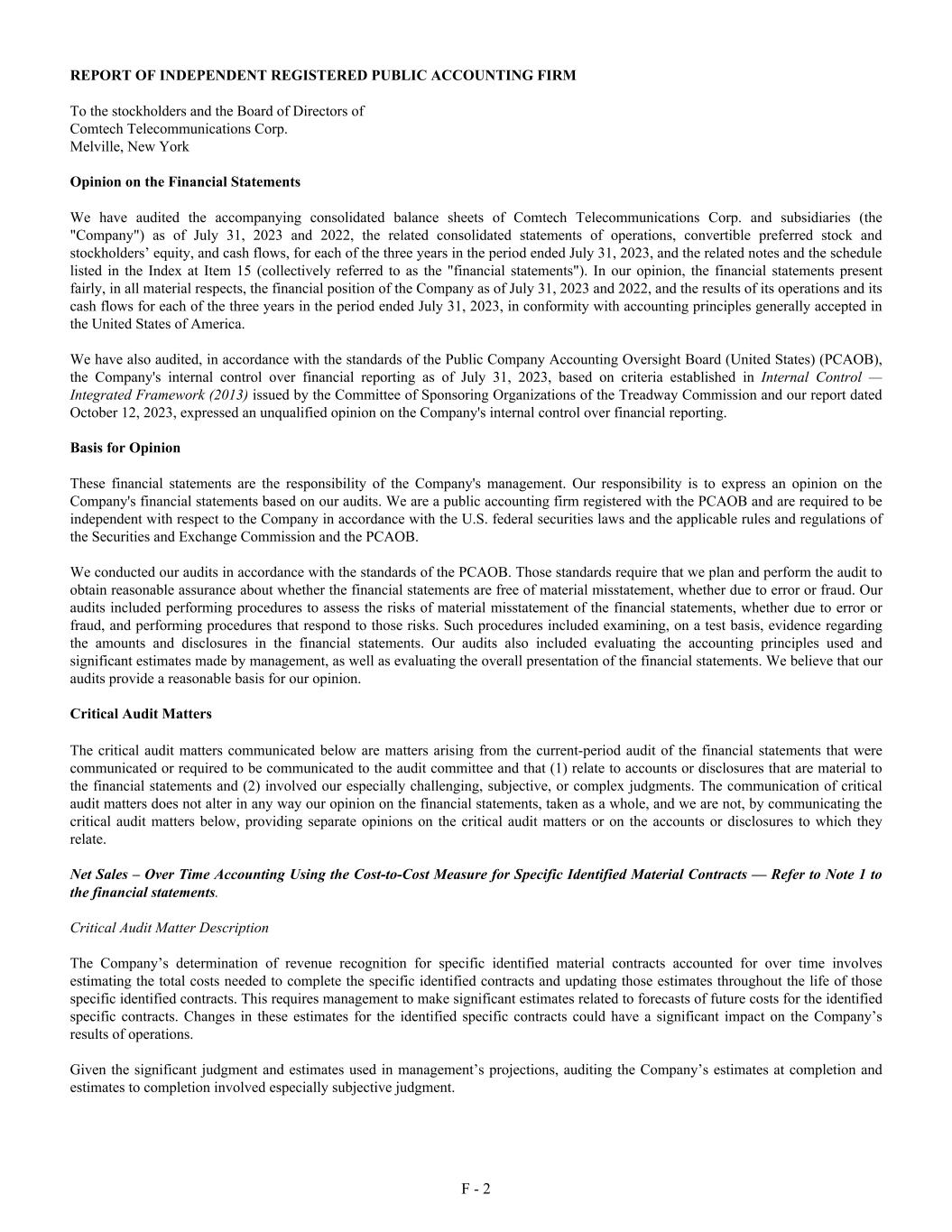
REPORT OF INDEPENDENT REGISTERED PUBLIC ACCOUNTING FIRM To the stockholders and the Board of Directors of Comtech Telecommunications Corp. Melville, New York Opinion on the Financial Statements We have audited the accompanying consolidated balance sheets of Comtech Telecommunications Corp. and subsidiaries (the "Company") as of July 31, 2023 and 2022, the related consolidated statements of operations, convertible preferred stock and stockholders’ equity, and cash flows, for each of the three years in the period ended July 31, 2023, and the related notes and the schedule listed in the Index at Item 15 (collectively referred to as the "financial statements"). In our opinion, the financial statements present fairly, in all material respects, the financial position of the Company as of July 31, 2023 and 2022, and the results of its operations and its cash flows for each of the three years in the period ended July 31, 2023, in conformity with accounting principles generally accepted in the United States of America. We have also audited, in accordance with the standards of the Public Company Accounting Oversight Board (United States) (PCAOB), the Company's internal control over financial reporting as of July 31, 2023, based on criteria established in Internal Control — Integrated Framework (2013) issued by the Committee of Sponsoring Organizations of the Treadway Commission and our report dated October 12, 2023, expressed an unqualified opinion on the Company's internal control over financial reporting. Basis for Opinion These financial statements are the responsibility of the Company's management. Our responsibility is to express an opinion on the Company's financial statements based on our audits. We are a public accounting firm registered with the PCAOB and are required to be independent with respect to the Company in accordance with the U.S. federal securities laws and the applicable rules and regulations of the Securities and Exchange Commission and the PCAOB. We conducted our audits in accordance with the standards of the PCAOB. Those standards require that we plan and perform the audit to obtain reasonable assurance about whether the financial statements are free of material misstatement, whether due to error or fraud. Our audits included performing procedures to assess the risks of material misstatement of the financial statements, whether due to error or fraud, and performing procedures that respond to those risks. Such procedures included examining, on a test basis, evidence regarding the amounts and disclosures in the financial statements. Our audits also included evaluating the accounting principles used and significant estimates made by management, as well as evaluating the overall presentation of the financial statements. We believe that our audits provide a reasonable basis for our opinion. Critical Audit Matters The critical audit matters communicated below are matters arising from the current-period audit of the financial statements that were communicated or required to be communicated to the audit committee and that (1) relate to accounts or disclosures that are material to the financial statements and (2) involved our especially challenging, subjective, or complex judgments. The communication of critical audit matters does not alter in any way our opinion on the financial statements, taken as a whole, and we are not, by communicating the critical audit matters below, providing separate opinions on the critical audit matters or on the accounts or disclosures to which they relate. Net Sales – Over Time Accounting Using the Cost-to-Cost Measure for Specific Identified Material Contracts — Refer to Note 1 to the financial statements. Critical Audit Matter Description The Company’s determination of revenue recognition for specific identified material contracts accounted for over time involves estimating the total costs needed to complete the specific identified contracts and updating those estimates throughout the life of those specific identified contracts. This requires management to make significant estimates related to forecasts of future costs for the identified specific contracts. Changes in these estimates for the identified specific contracts could have a significant impact on the Company’s results of operations. Given the significant judgment and estimates used in management’s projections, auditing the Company’s estimates at completion and estimates to completion involved especially subjective judgment. F - 2
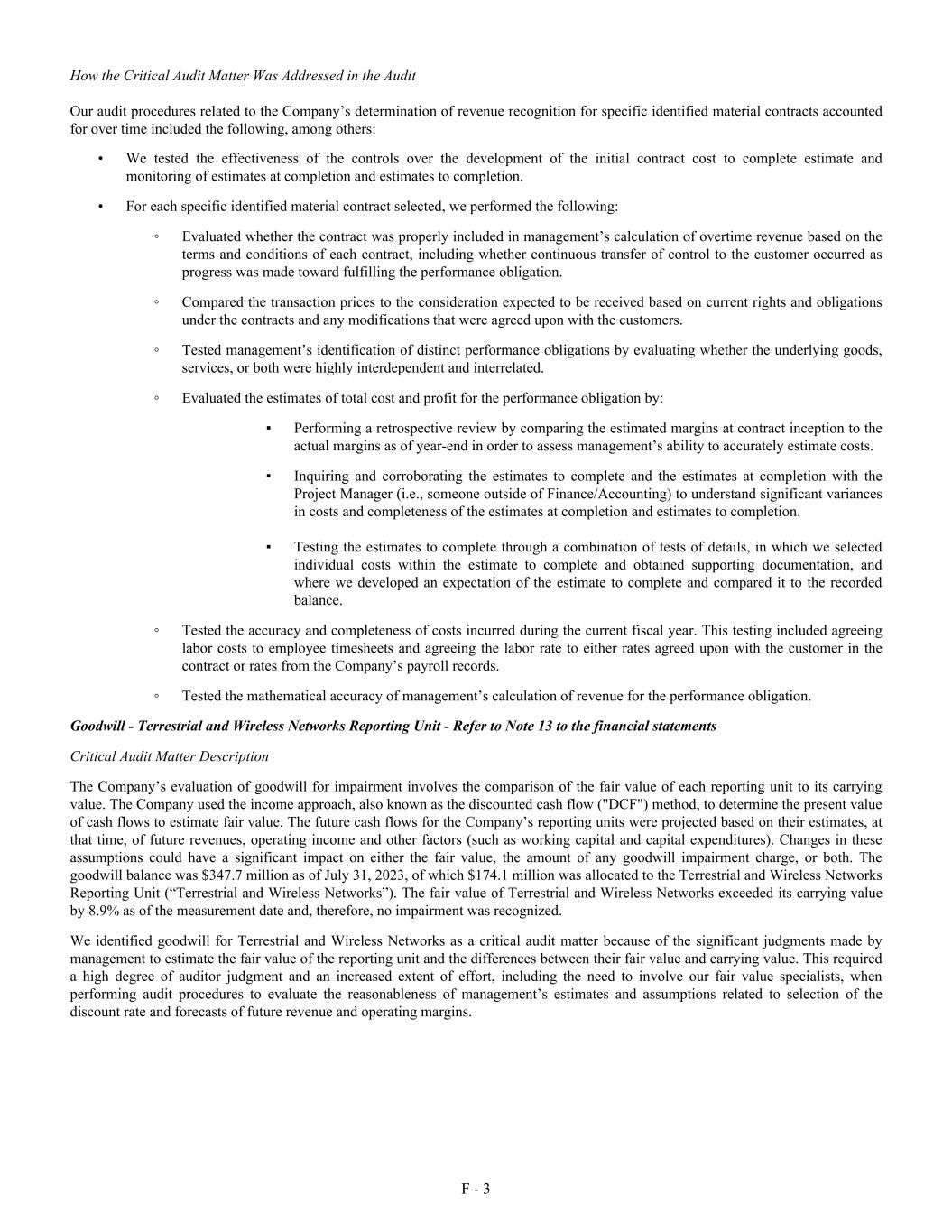
How the Critical Audit Matter Was Addressed in the Audit Our audit procedures related to the Company’s determination of revenue recognition for specific identified material contracts accounted for over time included the following, among others: • We tested the effectiveness of the controls over the development of the initial contract cost to complete estimate and monitoring of estimates at completion and estimates to completion. • For each specific identified material contract selected, we performed the following: ◦ Evaluated whether the contract was properly included in management’s calculation of overtime revenue based on the terms and conditions of each contract, including whether continuous transfer of control to the customer occurred as progress was made toward fulfilling the performance obligation. ◦ Compared the transaction prices to the consideration expected to be received based on current rights and obligations under the contracts and any modifications that were agreed upon with the customers. ◦ Tested management’s identification of distinct performance obligations by evaluating whether the underlying goods, services, or both were highly interdependent and interrelated. ◦ Evaluated the estimates of total cost and profit for the performance obligation by: ▪ Performing a retrospective review by comparing the estimated margins at contract inception to the actual margins as of year-end in order to assess management’s ability to accurately estimate costs. ▪ Inquiring and corroborating the estimates to complete and the estimates at completion with the Project Manager (i.e., someone outside of Finance/Accounting) to understand significant variances in costs and completeness of the estimates at completion and estimates to completion. ▪ Testing the estimates to complete through a combination of tests of details, in which we selected individual costs within the estimate to complete and obtained supporting documentation, and where we developed an expectation of the estimate to complete and compared it to the recorded balance. ◦ Tested the accuracy and completeness of costs incurred during the current fiscal year. This testing included agreeing labor costs to employee timesheets and agreeing the labor rate to either rates agreed upon with the customer in the contract or rates from the Company’s payroll records. ◦ Tested the mathematical accuracy of management’s calculation of revenue for the performance obligation. Goodwill - Terrestrial and Wireless Networks Reporting Unit - Refer to Note 13 to the financial statements Critical Audit Matter Description The Company’s evaluation of goodwill for impairment involves the comparison of the fair value of each reporting unit to its carrying value. The Company used the income approach, also known as the discounted cash flow ("DCF") method, to determine the present value of cash flows to estimate fair value. The future cash flows for the Company’s reporting units were projected based on their estimates, at that time, of future revenues, operating income and other factors (such as working capital and capital expenditures). Changes in these assumptions could have a significant impact on either the fair value, the amount of any goodwill impairment charge, or both. The goodwill balance was $347.7 million as of July 31, 2023, of which $174.1 million was allocated to the Terrestrial and Wireless Networks Reporting Unit (“Terrestrial and Wireless Networks”). The fair value of Terrestrial and Wireless Networks exceeded its carrying value by 8.9% as of the measurement date and, therefore, no impairment was recognized. We identified goodwill for Terrestrial and Wireless Networks as a critical audit matter because of the significant judgments made by management to estimate the fair value of the reporting unit and the differences between their fair value and carrying value. This required a high degree of auditor judgment and an increased extent of effort, including the need to involve our fair value specialists, when performing audit procedures to evaluate the reasonableness of management’s estimates and assumptions related to selection of the discount rate and forecasts of future revenue and operating margins. F - 3
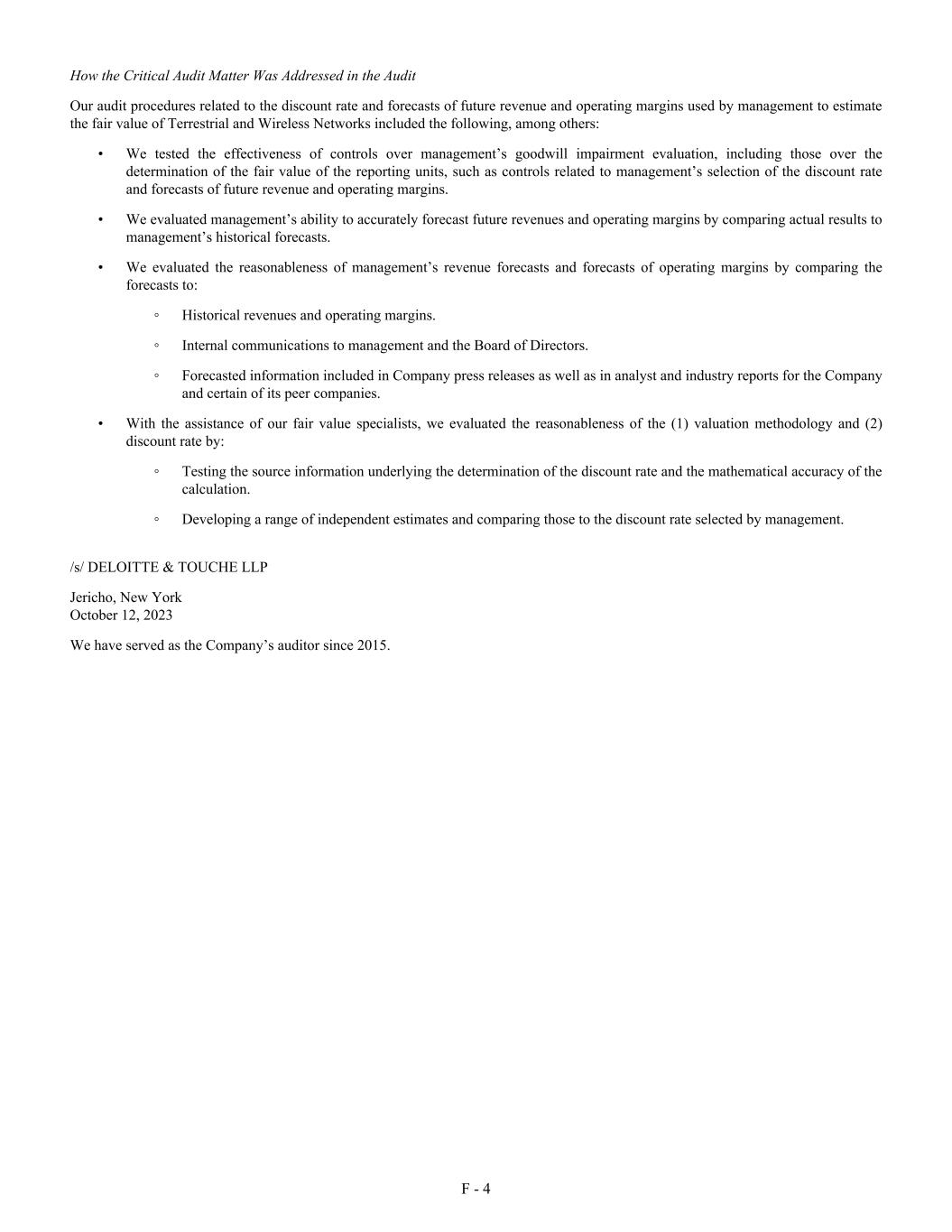
How the Critical Audit Matter Was Addressed in the Audit Our audit procedures related to the discount rate and forecasts of future revenue and operating margins used by management to estimate the fair value of Terrestrial and Wireless Networks included the following, among others: • We tested the effectiveness of controls over management’s goodwill impairment evaluation, including those over the determination of the fair value of the reporting units, such as controls related to management’s selection of the discount rate and forecasts of future revenue and operating margins. • We evaluated management’s ability to accurately forecast future revenues and operating margins by comparing actual results to management’s historical forecasts. • We evaluated the reasonableness of management’s revenue forecasts and forecasts of operating margins by comparing the forecasts to: ◦ Historical revenues and operating margins. ◦ Internal communications to management and the Board of Directors. ◦ Forecasted information included in Company press releases as well as in analyst and industry reports for the Company and certain of its peer companies. • With the assistance of our fair value specialists, we evaluated the reasonableness of the (1) valuation methodology and (2) discount rate by: ◦ Testing the source information underlying the determination of the discount rate and the mathematical accuracy of the calculation. ◦ Developing a range of independent estimates and comparing those to the discount rate selected by management. /s/ DELOITTE & TOUCHE LLP Jericho, New York October 12, 2023 We have served as the Company’s auditor since 2015. F - 4
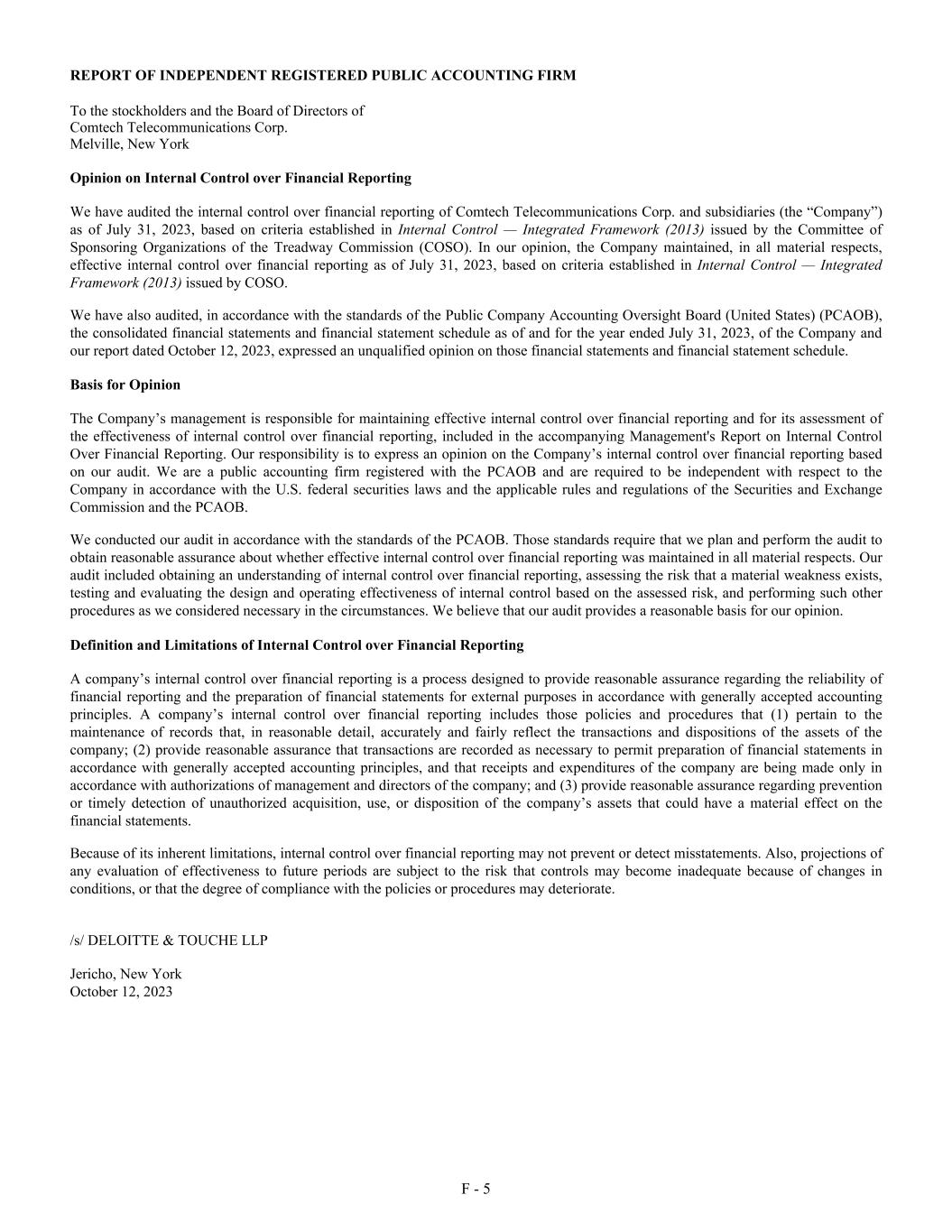
REPORT OF INDEPENDENT REGISTERED PUBLIC ACCOUNTING FIRM To the stockholders and the Board of Directors of Comtech Telecommunications Corp. Melville, New York Opinion on Internal Control over Financial Reporting We have audited the internal control over financial reporting of Comtech Telecommunications Corp. and subsidiaries (the “Company”) as of July 31, 2023, based on criteria established in Internal Control — Integrated Framework (2013) issued by the Committee of Sponsoring Organizations of the Treadway Commission (COSO). In our opinion, the Company maintained, in all material respects, effective internal control over financial reporting as of July 31, 2023, based on criteria established in Internal Control — Integrated Framework (2013) issued by COSO. We have also audited, in accordance with the standards of the Public Company Accounting Oversight Board (United States) (PCAOB), the consolidated financial statements and financial statement schedule as of and for the year ended July 31, 2023, of the Company and our report dated October 12, 2023, expressed an unqualified opinion on those financial statements and financial statement schedule. Basis for Opinion The Company’s management is responsible for maintaining effective internal control over financial reporting and for its assessment of the effectiveness of internal control over financial reporting, included in the accompanying Management's Report on Internal Control Over Financial Reporting. Our responsibility is to express an opinion on the Company’s internal control over financial reporting based on our audit. We are a public accounting firm registered with the PCAOB and are required to be independent with respect to the Company in accordance with the U.S. federal securities laws and the applicable rules and regulations of the Securities and Exchange Commission and the PCAOB. We conducted our audit in accordance with the standards of the PCAOB. Those standards require that we plan and perform the audit to obtain reasonable assurance about whether effective internal control over financial reporting was maintained in all material respects. Our audit included obtaining an understanding of internal control over financial reporting, assessing the risk that a material weakness exists, testing and evaluating the design and operating effectiveness of internal control based on the assessed risk, and performing such other procedures as we considered necessary in the circumstances. We believe that our audit provides a reasonable basis for our opinion. Definition and Limitations of Internal Control over Financial Reporting A company’s internal control over financial reporting is a process designed to provide reasonable assurance regarding the reliability of financial reporting and the preparation of financial statements for external purposes in accordance with generally accepted accounting principles. A company’s internal control over financial reporting includes those policies and procedures that (1) pertain to the maintenance of records that, in reasonable detail, accurately and fairly reflect the transactions and dispositions of the assets of the company; (2) provide reasonable assurance that transactions are recorded as necessary to permit preparation of financial statements in accordance with generally accepted accounting principles, and that receipts and expenditures of the company are being made only in accordance with authorizations of management and directors of the company; and (3) provide reasonable assurance regarding prevention or timely detection of unauthorized acquisition, use, or disposition of the company’s assets that could have a material effect on the financial statements. Because of its inherent limitations, internal control over financial reporting may not prevent or detect misstatements. Also, projections of any evaluation of effectiveness to future periods are subject to the risk that controls may become inadequate because of changes in conditions, or that the degree of compliance with the policies or procedures may deteriorate. /s/ DELOITTE & TOUCHE LLP Jericho, New York October 12, 2023 F - 5
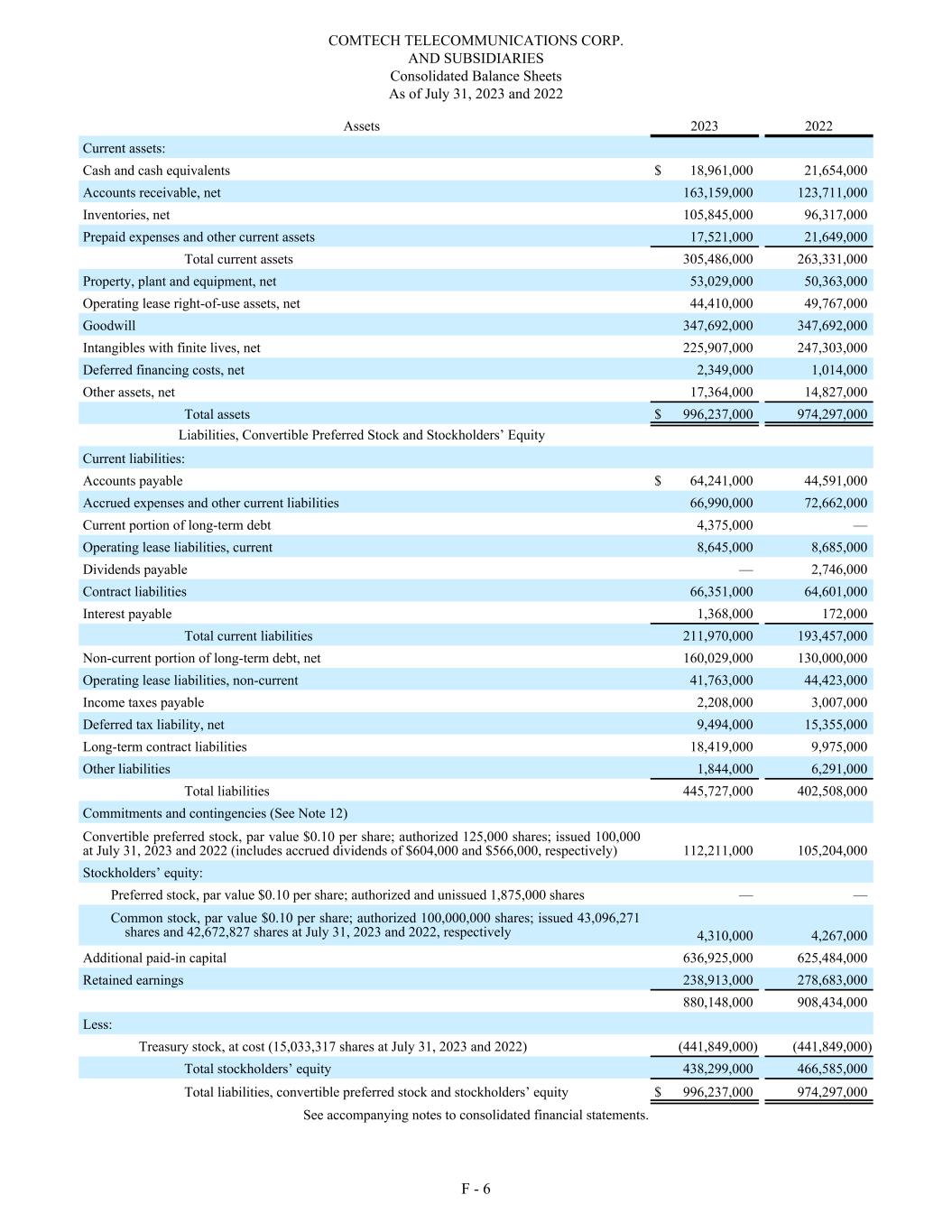
COMTECH TELECOMMUNICATIONS CORP. AND SUBSIDIARIES Consolidated Balance Sheets As of July 31, 2023 and 2022 Assets 2023 2022 Current assets: Cash and cash equivalents $ 18,961,000 21,654,000 Accounts receivable, net 163,159,000 123,711,000 Inventories, net 105,845,000 96,317,000 Prepaid expenses and other current assets 17,521,000 21,649,000 Total current assets 305,486,000 263,331,000 Property, plant and equipment, net 53,029,000 50,363,000 Operating lease right-of-use assets, net 44,410,000 49,767,000 Goodwill 347,692,000 347,692,000 Intangibles with finite lives, net 225,907,000 247,303,000 Deferred financing costs, net 2,349,000 1,014,000 Other assets, net 17,364,000 14,827,000 Total assets $ 996,237,000 974,297,000 Liabilities, Convertible Preferred Stock and Stockholders’ Equity Current liabilities: Accounts payable $ 64,241,000 44,591,000 Accrued expenses and other current liabilities 66,990,000 72,662,000 Current portion of long-term debt 4,375,000 — Operating lease liabilities, current 8,645,000 8,685,000 Dividends payable — 2,746,000 Contract liabilities 66,351,000 64,601,000 Interest payable 1,368,000 172,000 Total current liabilities 211,970,000 193,457,000 Non-current portion of long-term debt, net 160,029,000 130,000,000 Operating lease liabilities, non-current 41,763,000 44,423,000 Income taxes payable 2,208,000 3,007,000 Deferred tax liability, net 9,494,000 15,355,000 Long-term contract liabilities 18,419,000 9,975,000 Other liabilities 1,844,000 6,291,000 Total liabilities 445,727,000 402,508,000 Commitments and contingencies (See Note 12) Convertible preferred stock, par value $0.10 per share; authorized 125,000 shares; issued 100,000 at July 31, 2023 and 2022 (includes accrued dividends of $604,000 and $566,000, respectively) 112,211,000 105,204,000 Stockholders’ equity: Preferred stock, par value $0.10 per share; authorized and unissued 1,875,000 shares — — Common stock, par value $0.10 per share; authorized 100,000,000 shares; issued 43,096,271 shares and 42,672,827 shares at July 31, 2023 and 2022, respectively 4,310,000 4,267,000 Additional paid-in capital 636,925,000 625,484,000 Retained earnings 238,913,000 278,683,000 880,148,000 908,434,000 Less: Treasury stock, at cost (15,033,317 shares at July 31, 2023 and 2022) (441,849,000) (441,849,000) Total stockholders’ equity 438,299,000 466,585,000 Total liabilities, convertible preferred stock and stockholders’ equity $ 996,237,000 974,297,000 See accompanying notes to consolidated financial statements. F - 6
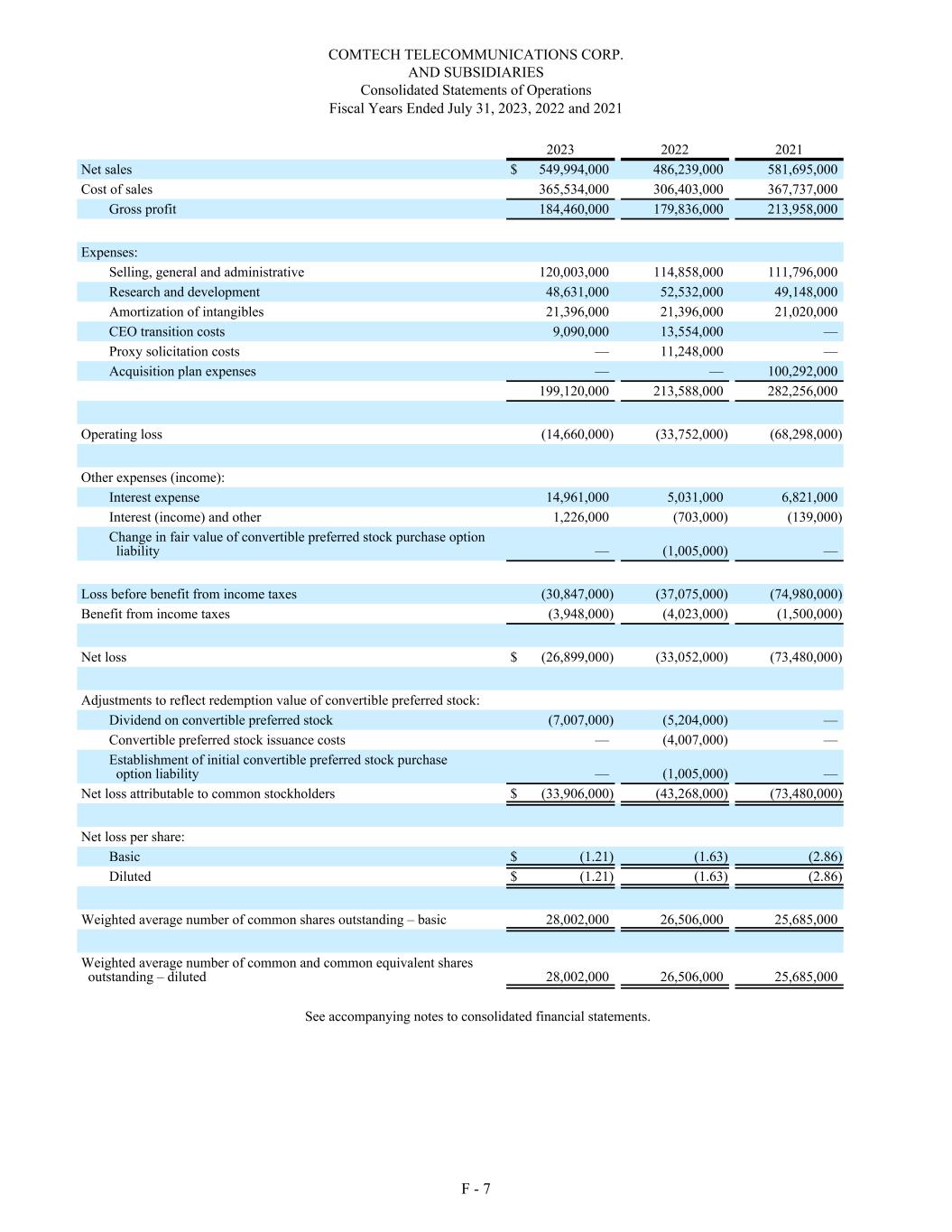
COMTECH TELECOMMUNICATIONS CORP. AND SUBSIDIARIES Consolidated Statements of Operations Fiscal Years Ended July 31, 2023, 2022 and 2021 2023 2022 2021 Net sales $ 549,994,000 486,239,000 581,695,000 Cost of sales 365,534,000 306,403,000 367,737,000 Gross profit 184,460,000 179,836,000 213,958,000 Expenses: Selling, general and administrative 120,003,000 114,858,000 111,796,000 Research and development 48,631,000 52,532,000 49,148,000 Amortization of intangibles 21,396,000 21,396,000 21,020,000 CEO transition costs 9,090,000 13,554,000 — Proxy solicitation costs — 11,248,000 — Acquisition plan expenses — — 100,292,000 199,120,000 213,588,000 282,256,000 Operating loss (14,660,000) (33,752,000) (68,298,000) Other expenses (income): Interest expense 14,961,000 5,031,000 6,821,000 Interest (income) and other 1,226,000 (703,000) (139,000) Change in fair value of convertible preferred stock purchase option liability — (1,005,000) — Loss before benefit from income taxes (30,847,000) (37,075,000) (74,980,000) Benefit from income taxes (3,948,000) (4,023,000) (1,500,000) Net loss $ (26,899,000) (33,052,000) (73,480,000) Adjustments to reflect redemption value of convertible preferred stock: Dividend on convertible preferred stock (7,007,000) (5,204,000) — Convertible preferred stock issuance costs — (4,007,000) — Establishment of initial convertible preferred stock purchase option liability — (1,005,000) — Net loss attributable to common stockholders $ (33,906,000) (43,268,000) (73,480,000) Net loss per share: Basic $ (1.21) (1.63) (2.86) Diluted $ (1.21) (1.63) (2.86) Weighted average number of common shares outstanding – basic 28,002,000 26,506,000 25,685,000 Weighted average number of common and common equivalent shares outstanding – diluted 28,002,000 26,506,000 25,685,000 See accompanying notes to consolidated financial statements. F - 7

COMTECH TELECOMMUNICATIONS CORP. AND SUBSIDIARIES Consolidated Statements of Convertible Preferred Stock and Stockholders’ Equity Fiscal Years Ended July 31, 2023, 2022 and 2021 Series A Convertible Preferred Stock Common Stock Additional Paid-in Capital Retained Earnings Treasury Stock Stockholders' EquityShares Amount Shares Amount Shares Amount Balance as of July 31, 2020 — $ — 39,924,439 $ 3,992,000 $ 569,891,000 $ 417,265,000 15,033,317 $ (441,849,000) $ 549,299,000 Equity-classified stock award compensation — — — — 9,983,000 — — — 9,983,000 Issuance of employee stock purchase plan shares — — 54,762 5,000 804,000 — — — 809,000 Issuance of restricted stock — — 35,495 4,000 (4,000) — — — — Net settlement of stock-based awards — — 240,549 24,000 (4,024,000) — — — (4,000,000) Common stock issued for acquisition of UHP Networks Inc. ("UHP") — — 1,026,567 103,000 28,789,000 — — — 28,892,000 Cash dividends declared ($0.40 per share) — — — — — (10,189,000) — — (10,189,000) Accrual of dividend equivalents, net of reversal ($0.40 per share) — — — — — (380,000) — — (380,000) Adoption of current expected credit loss standard — — — — — (215,000) — — (215,000) Net loss — — — — — (73,480,000) — — (73,480,000) Balance as of July 31, 2021 — — 41,281,812 4,128,000 605,439,000 333,001,000 15,033,317 (441,849,000) 500,719,000 Equity-classified stock award compensation — — — — 7,767,000 — — — 7,767,000 CEO transition costs related to equity-classified stock-based awards (See Note 11) — — — — 7,388,000 — — — 7,388,000 Issuance of employee stock purchase plan shares — — 49,138 5,000 725,000 — — — 730,000 Issuance of restricted stock, net of forfeiture — — 132,854 13,000 (13,000) — — — — Net settlement of stock-based awards — — 247,721 25,000 (4,640,000) — — — (4,615,000) Common stock issued for settlement of UHP earn-out liability — — 961,302 96,000 8,818,000 — — — 8,914,000 Issuance of convertible preferred stock 100,000 100,000,000 — — — — — — — Convertible preferred stock issuance costs — (4,007,000) — — — — — — — Establishment of initial convertible preferred stock purchase option liability — (1,005,000) — — — — — — — Adjustment to reflect redemption value of convertible preferred stock (including accrued dividends) — 10,216,000 — — — (10,216,000) — — (10,216,000) Cash dividends declared ($0.40 per share) — — — — — (10,661,000) — — (10,661,000) Accrual of dividend equivalents, net of reversal ($0.40 per share) — — — — — (389,000) — — (389,000) Net loss — — — — — (33,052,000) — — (33,052,000) Balance as of July 31, 2022 100,000 105,204,000 42,672,827 4,267,000 625,484,000 278,683,000 15,033,317 (441,849,000) 466,585,000 Equity-classified stock award compensation — — — — 10,257,000 — — — 10,257,000 CEO transition costs related to equity-classified stock-based awards (See Note 11) — — — — 3,764,000 — — — 3,764,000 Issuance of employee stock purchase plan shares — — 54,617 5,000 429,000 — — — 434,000 Issuance of restricted stock, net of forfeiture — — 93,091 9,000 (9,000) — — — — Net settlement of stock-based awards — — 275,736 29,000 (3,000,000) — — — (2,971,000) Adjustment to reflect redemption value of convertible preferred stock (including accrued dividends) — 7,007,000 — — — (7,007,000) — — (7,007,000) Cash dividends declared ($0.20 per share) — — — — — (5,549,000) — — (5,549,000) Accrual of dividend equivalents, net of reversal ($0.20 per share) — — — — — (315,000) — — (315,000) Net loss — — — — — (26,899,000) — — (26,899,000) Balance as of July 31, 2023 100,000 $ 112,211,000 43,096,271 $ 4,310,000 $ 636,925,000 $ 238,913,000 15,033,317 $ (441,849,000) $ 438,299,000 See accompanying notes to consolidated financial statements. F - 8
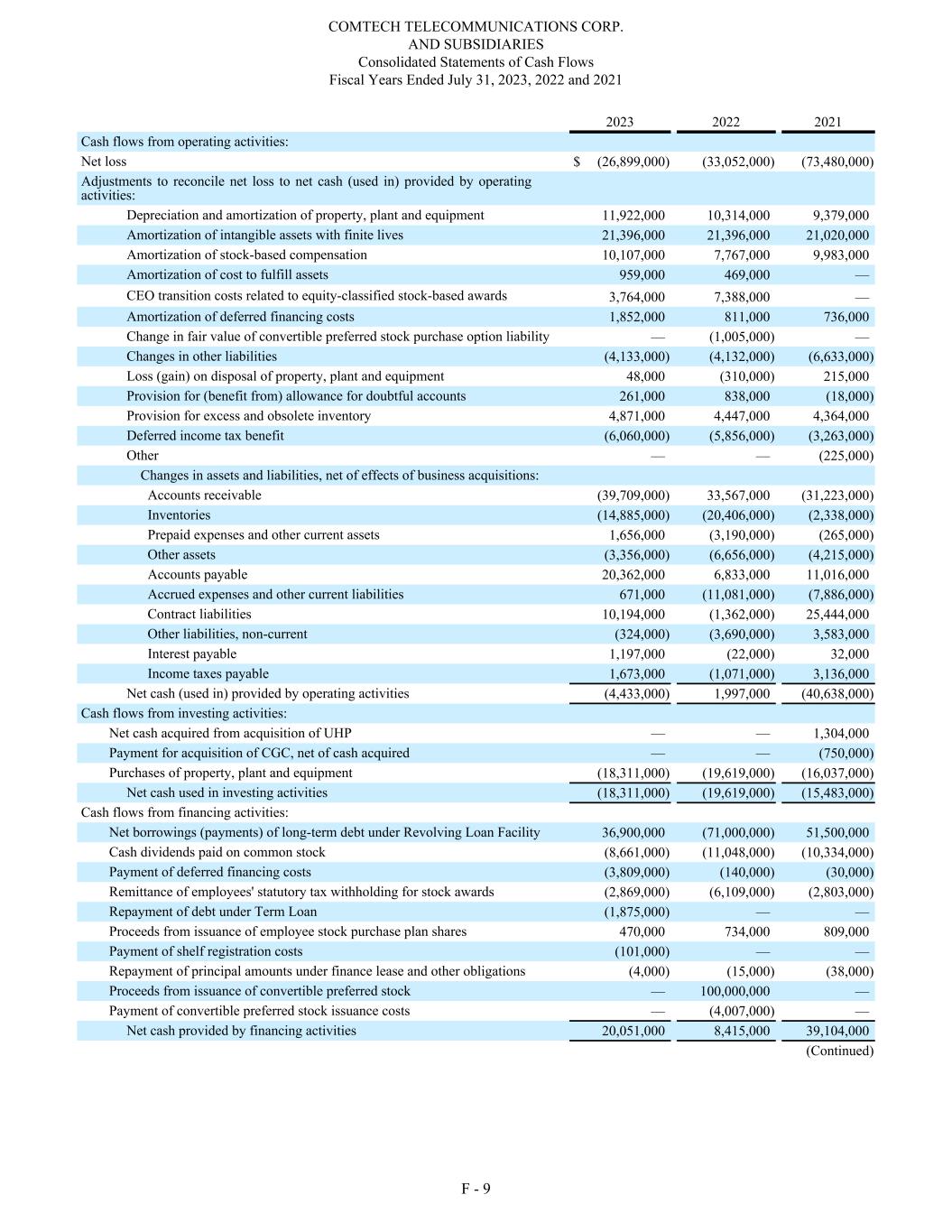
Cash flows from operating activities: Net loss $ (26,899,000) (33,052,000) (73,480,000) Adjustments to reconcile net loss to net cash (used in) provided by operating activities: Depreciation and amortization of property, plant and equipment 11,922,000 10,314,000 9,379,000 Amortization of intangible assets with finite lives 21,396,000 21,396,000 21,020,000 Amortization of stock-based compensation 10,107,000 7,767,000 9,983,000 Amortization of cost to fulfill assets 959,000 469,000 — CEO transition costs related to equity-classified stock-based awards 3,764,000 7,388,000 — Amortization of deferred financing costs 1,852,000 811,000 736,000 Change in fair value of convertible preferred stock purchase option liability — (1,005,000) — Changes in other liabilities (4,133,000) (4,132,000) (6,633,000) Loss (gain) on disposal of property, plant and equipment 48,000 (310,000) 215,000 Provision for (benefit from) allowance for doubtful accounts 261,000 838,000 (18,000) Provision for excess and obsolete inventory 4,871,000 4,447,000 4,364,000 Deferred income tax benefit (6,060,000) (5,856,000) (3,263,000) Other — — (225,000) Changes in assets and liabilities, net of effects of business acquisitions: Accounts receivable (39,709,000) 33,567,000 (31,223,000) Inventories (14,885,000) (20,406,000) (2,338,000) Prepaid expenses and other current assets 1,656,000 (3,190,000) (265,000) Other assets (3,356,000) (6,656,000) (4,215,000) Accounts payable 20,362,000 6,833,000 11,016,000 Accrued expenses and other current liabilities 671,000 (11,081,000) (7,886,000) Contract liabilities 10,194,000 (1,362,000) 25,444,000 Other liabilities, non-current (324,000) (3,690,000) 3,583,000 Interest payable 1,197,000 (22,000) 32,000 Income taxes payable 1,673,000 (1,071,000) 3,136,000 Net cash (used in) provided by operating activities (4,433,000) 1,997,000 (40,638,000) Cash flows from investing activities: Net cash acquired from acquisition of UHP — — 1,304,000 Payment for acquisition of CGC, net of cash acquired — — (750,000) Purchases of property, plant and equipment (18,311,000) (19,619,000) (16,037,000) Net cash used in investing activities (18,311,000) (19,619,000) (15,483,000) Cash flows from financing activities: Net borrowings (payments) of long-term debt under Revolving Loan Facility 36,900,000 (71,000,000) 51,500,000 Cash dividends paid on common stock (8,661,000) (11,048,000) (10,334,000) Payment of deferred financing costs (3,809,000) (140,000) (30,000) Remittance of employees' statutory tax withholding for stock awards (2,869,000) (6,109,000) (2,803,000) Repayment of debt under Term Loan (1,875,000) — — Proceeds from issuance of employee stock purchase plan shares 470,000 734,000 809,000 Payment of shelf registration costs (101,000) — — Repayment of principal amounts under finance lease and other obligations (4,000) (15,000) (38,000) Proceeds from issuance of convertible preferred stock — 100,000,000 — Payment of convertible preferred stock issuance costs — (4,007,000) — Net cash provided by financing activities 20,051,000 8,415,000 39,104,000 (Continued) 2023 2022 2021 COMTECH TELECOMMUNICATIONS CORP. AND SUBSIDIARIES Consolidated Statements of Cash Flows Fiscal Years Ended July 31, 2023, 2022 and 2021 F - 9

2023 2022 2021 Net decrease in cash and cash equivalents $ (2,693,000) (9,207,000) (17,017,000) Cash and cash equivalents at beginning of year 21,654,000 30,861,000 47,878,000 Cash and cash equivalents at end of year $ 18,961,000 21,654,000 30,861,000 Supplemental cash flow disclosure Cash paid (received) during the year for: Interest $ 11,914,000 4,094,000 5,987,000 Income taxes, net $ 361,000 2,913,000 (1,373,000) Non-cash investing and financing activities: Accrued remittance of employees' statutory tax withholdings for fully-vested share units $ 1,204,000 1,102,000 2,596,000 Cash dividends declared on common stock but unpaid (including accrual of dividend equivalents) $ 315,000 3,135,000 2,981,000 Adjustment to reflect redemption value of convertible preferred stock $ 7,007,000 10,216,000 — Establishment of initial convertible preferred stock purchase option liability $ — 1,005,000 — Accrued additions to property, plant and equipment $ 993,000 5,586,000 2,466,000 Issuance of restricted stock $ 9,000 13,000 4,000 Common stock issued for acquisitions $ — 9,000,000 28,892,000 Fair value of UHP acquisition contingent earn-out consideration $ — — 8,500,000 Accrued deferred financing costs $ — — 139,000 See accompanying notes to consolidated financial statements. COMTECH TELECOMMUNICATIONS CORP. AND SUBSIDIARIES Consolidated Statements of Cash Flows (continued) Fiscal Years Ended July 31, 2023, 2022 and 2021 F - 10

(1) Summary of Significant Accounting and Reporting Policies (a) Principles of Consolidation The accompanying consolidated financial statements include the accounts of Comtech Telecommunications Corp. and its subsidiaries ("Comtech," "we," "us," or "our"), all of which are wholly-owned. All significant intercompany balances and transactions have been eliminated in consolidation. (b) Nature of Business We design, produce and market innovative products, systems and services for advanced communications solutions. We conduct our business through two reportable operating segments: Satellite and Space Communications and Terrestrial and Wireless Networks. Our business is highly competitive and characterized by rapid technological change. Our growth and financial position depends on our ability to keep pace with such changes and developments and to respond to the sophisticated requirements of an increasing variety of secure wireless communications technology users, among other things. Many of our competitors are substantially larger, and have significantly greater financial, marketing and operating resources and broader product lines than our own. A significant technological or sales breakthrough by others, including smaller competitors or new companies, could have a material adverse effect on our business. In addition, certain of our customers have technological capabilities in our product areas and could choose to replace our products with their own. International sales expose us to certain risks, including barriers to trade, fluctuations in foreign currency exchange rates (which may make our products less price competitive), political and economic instability, availability of suitable export financing, export license requirements, tariff regulations, and other United States ("U.S.") and foreign regulations that may apply to the export of our products, as well as the generally greater difficulties of doing business abroad. We attempt to reduce the risk of doing business in foreign countries by seeking contracts denominated in U.S. dollars, advance or milestone payments, credit insurance and irrevocable letters of credit in our favor. COMTECH TELECOMMUNICATIONS CORP. AND SUBSIDIARIES Notes to Consolidated Financial Statements F - 11

(c) Revenue Recognition In accordance with FASB ASC 606 - Revenue from Contracts with Customers ("ASC 606"), we record revenue in an amount that reflects the consideration to which we expect to be entitled in exchange for goods or services promised to customers. Under ASC 606, we follow a five-step model to: (1) identify the contract with our customer; (2) identify our performance obligations in our contract; (3) determine the transaction price for our contract; (4) allocate the transaction price to our performance obligations; and (5) recognize revenue using one of the following two methods: • Over time - We recognize revenue using the over time method when there is a continuous transfer of control to the customer over the contractual period of performance. This generally occurs when we enter into a long- term contract relating to the design, development or manufacture of complex equipment or technology platforms to a buyer’s specification (or to provide services related to the performance of such contracts). Continuous transfer of control is typically supported by contract clauses which allow our customers to unilaterally terminate a contract for convenience, pay for costs incurred plus a reasonable profit and take control of work-in-process. Revenue recognized over time is generally based on the extent of progress toward completion of the related performance obligations. The selection of the method to measure progress requires judgment and is based on the nature of the products or services provided. In certain instances, typically for firm fixed-price contracts, we use the cost-to-cost measure because it best depicts the transfer of control to the customer which occurs as we incur costs on our contracts. Under the cost-to-cost measure, the extent of progress toward completion is measured based on the ratio of costs incurred to date to the total estimated costs at completion, including warranty costs. Revenues, including estimated fees or profits, are recorded proportionally as costs are incurred. Costs to fulfill generally include direct labor, materials, subcontractor costs, other direct costs and an allocation of indirect costs. When these contracts are modified, the additional goods or services are generally not distinct from those already provided. As a result, these modifications form part of an existing contract and we must update the transaction price and our measure of progress for the single performance obligation and recognize a cumulative catch-up to revenue and gross profits. For over time contracts using a cost-to-cost measure of progress, we have an estimate at completion ("EAC") process in which management reviews the progress and execution of our performance obligations. This EAC process requires management judgment relative to assessing risks, estimating contract revenue and costs, and making assumptions for schedule and technical issues. Since certain contracts extend over a long period of time, the impact of revisions in revenue and or cost estimates during the progress of work may impact current period earnings through a cumulative adjustment. Additionally, if the EAC process indicates a loss, a provision is made for the total anticipated loss in the period that it becomes evident. Contract revenue and cost estimates for significant contracts are generally reviewed and reassessed at least quarterly. The cost-to-cost method is principally used to account for contracts in our Satellite and Space Communications segment and, to a lesser extent, certain location-based and messaging infrastructure contracts in our Terrestrial and Wireless Networks segment. For service-based contracts in our Terrestrial and Wireless Networks segment, we also recognize revenue over time. These services are typically recognized as a series of services performed over the contract term using the straight-line method, or based on our customers’ actual usage of the networks and platforms which we provide. • Point in time - When a performance obligation is not satisfied over time, we must record revenue using the point in time accounting method which generally results in revenue being recognized upon shipment or delivery of a promised good or service to a customer. This generally occurs when we enter into short term contracts or purchase orders where items are provided to customers with relatively quick turn-around times. Modifications to such contracts and or purchase orders, which typically provide for additional quantities or services, are accounted for as a new contract because the pricing for these additional quantities or services are based on standalone selling prices. COMTECH TELECOMMUNICATIONS CORP. AND SUBSIDIARIES Notes to Consolidated Financial Statements, Continued F - 12

Point in time accounting is principally applied to contracts in our Satellite and Space Communications segment, which includes satellite modems, solid-state and traveling wave tube amplifiers and to certain contracts for our solid-state, high-power RF amplifiers. The contracts related to these products do not meet the requirements for over time revenue recognition because our customers cannot utilize the equipment for its intended purpose during any phase of our manufacturing process; customers do not simultaneously receive and or consume the benefits provided by our performance; customers do not control the asset (i.e., prior to delivery, customers cannot direct the use of the asset, sell or exchange the equipment, etc.); and, although many of our contracts have termination for convenience clauses and or an enforceable right to payment for performance completed to date, our performance creates an asset with an alternative use through the point of delivery. In determining that our equipment has alternative use, we considered the underlying manufacturing process. In the early phases of manufacturing, raw materials and work in process (including subassemblies) consist of common parts that are highly fungible among many different types of products and customer applications. Finished products are either configured to our standard configuration or based on our customers’ specifications. Finished products, whether built to our standard specification or to a customers’ specification, can be sold to a variety of customers and across many different end use applications with minimal rework, if needed, and without incurring a significant economic loss. When identifying a contract with our customer, we consider when it has approval and commitment from both parties, if the rights of the parties are identified, if the payment terms are identified, if it has commercial substance and if collectability is probable. When identifying performance obligations, we consider whether there are multiple promises and how to account for them. In our contracts, multiple promises are separated if they are distinct, both individually and in the context of the contract. If multiple promises in a contract are highly interrelated or comprise a series of distinct services performed over time, they are combined into a single performance obligation. In some cases, we may also provide the customer with an additional service-type warranty, which we recognize as a separate performance obligation. Service-type warranties do not represent a significant portion of our consolidated net sales. When service-type warranties represent a separate performance obligation, the revenue is deferred and recognized ratably over the extended warranty period. Our contracts, from time-to-time, may also include options for additional goods and services. To date, these options have not represented material rights to the customer as the pricing for them reflects standalone selling prices. As a result, we do not consider options we offer to be performance obligations for which we must allocate a portion of the transaction price. In many cases, we provide assurance-type warranty coverage for some of our products for a period of at least one year from the date of delivery. When identifying the transaction price, we typically utilize the contract's stated price as a starting point. The transaction price in certain arrangements may include estimated amounts of variable consideration, including award fees, incentive fees or other provisions that can either increase or decrease the transaction price. We estimate variable consideration as the amount to which we expect to be entitled, and we include estimated amounts in the transaction price to the extent it is probable that a significant reversal of cumulative revenue recognized will not occur when the estimation uncertainty is resolved. The estimation of this variable consideration and determination of whether to include estimated amounts in the transaction price are based largely on an assessment of our anticipated performance and all information (e.g., historical, current and forecasted) that is reasonably available to us. When allocating the contract’s transaction price, we consider each distinct performance obligation. For contracts with multiple performance obligations, we allocate the contract’s transaction price to each performance obligation using our best estimate of the standalone selling price of each distinct good or service in the contract. We determine standalone selling price based on the price at which the performance obligation is sold separately. If the standalone selling price is not observable through past transactions, we estimate the standalone selling price taking into account available information such as market conditions, including geographic or regional specific factors, competitive positioning, internal costs, profit objectives and internally approved pricing guidelines related to the performance obligations. COMTECH TELECOMMUNICATIONS CORP. AND SUBSIDIARIES Notes to Consolidated Financial Statements, Continued F - 13
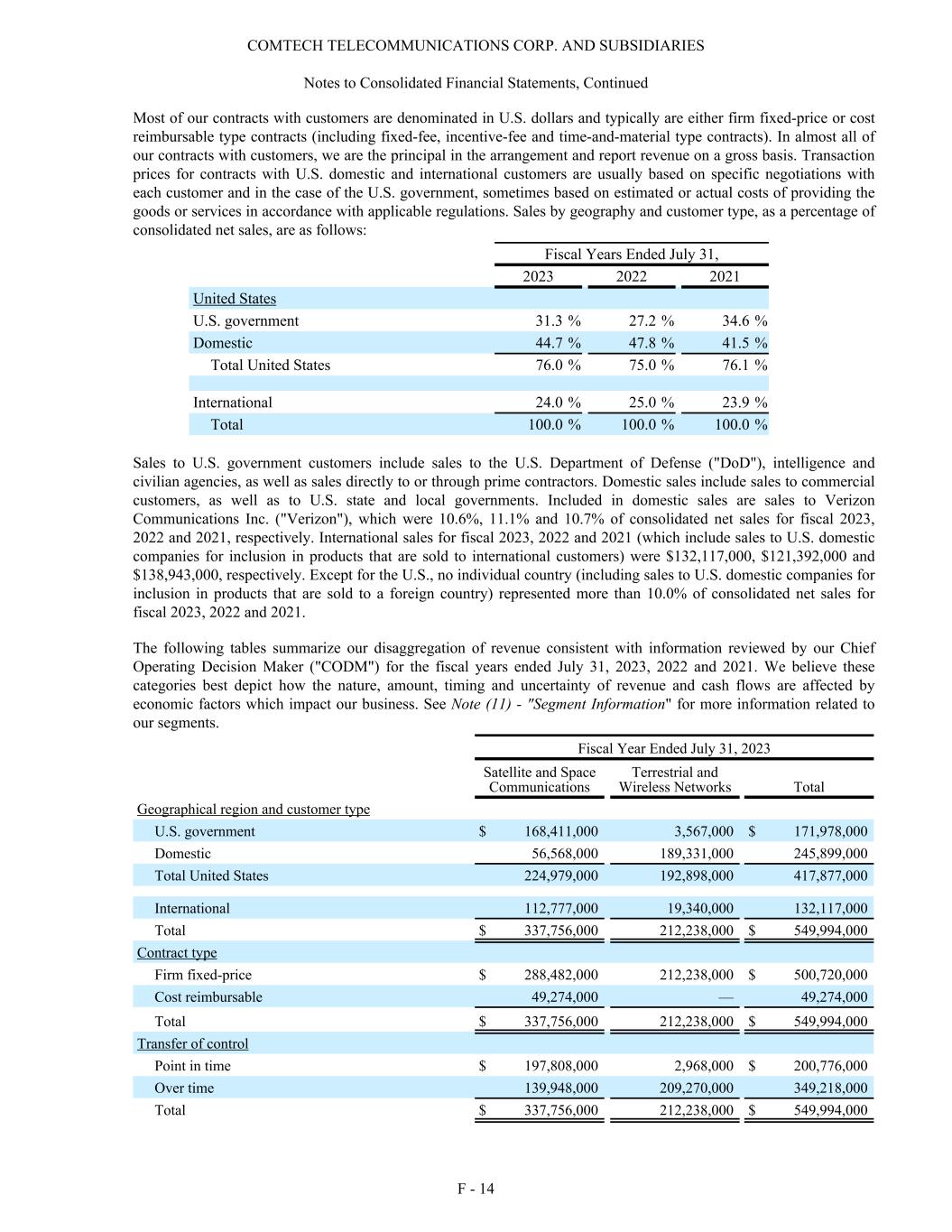
Most of our contracts with customers are denominated in U.S. dollars and typically are either firm fixed-price or cost reimbursable type contracts (including fixed-fee, incentive-fee and time-and-material type contracts). In almost all of our contracts with customers, we are the principal in the arrangement and report revenue on a gross basis. Transaction prices for contracts with U.S. domestic and international customers are usually based on specific negotiations with each customer and in the case of the U.S. government, sometimes based on estimated or actual costs of providing the goods or services in accordance with applicable regulations. Sales by geography and customer type, as a percentage of consolidated net sales, are as follows: Fiscal Years Ended July 31, 2023 2022 2021 United States U.S. government 31.3 % 27.2 % 34.6 % Domestic 44.7 % 47.8 % 41.5 % Total United States 76.0 % 75.0 % 76.1 % International 24.0 % 25.0 % 23.9 % Total 100.0 % 100.0 % 100.0 % Sales to U.S. government customers include sales to the U.S. Department of Defense ("DoD"), intelligence and civilian agencies, as well as sales directly to or through prime contractors. Domestic sales include sales to commercial customers, as well as to U.S. state and local governments. Included in domestic sales are sales to Verizon Communications Inc. ("Verizon"), which were 10.6%, 11.1% and 10.7% of consolidated net sales for fiscal 2023, 2022 and 2021, respectively. International sales for fiscal 2023, 2022 and 2021 (which include sales to U.S. domestic companies for inclusion in products that are sold to international customers) were $132,117,000, $121,392,000 and $138,943,000, respectively. Except for the U.S., no individual country (including sales to U.S. domestic companies for inclusion in products that are sold to a foreign country) represented more than 10.0% of consolidated net sales for fiscal 2023, 2022 and 2021. The following tables summarize our disaggregation of revenue consistent with information reviewed by our Chief Operating Decision Maker ("CODM") for the fiscal years ended July 31, 2023, 2022 and 2021. We believe these categories best depict how the nature, amount, timing and uncertainty of revenue and cash flows are affected by economic factors which impact our business. See Note (11) - "Segment Information" for more information related to our segments. Fiscal Year Ended July 31, 2023 Satellite and Space Communications Terrestrial and Wireless Networks Total Geographical region and customer type U.S. government $ 168,411,000 3,567,000 $ 171,978,000 Domestic 56,568,000 189,331,000 245,899,000 Total United States 224,979,000 192,898,000 417,877,000 International 112,777,000 19,340,000 132,117,000 Total $ 337,756,000 212,238,000 $ 549,994,000 Contract type Firm fixed-price $ 288,482,000 212,238,000 $ 500,720,000 Cost reimbursable 49,274,000 — 49,274,000 Total $ 337,756,000 212,238,000 $ 549,994,000 Transfer of control Point in time $ 197,808,000 2,968,000 $ 200,776,000 Over time 139,948,000 209,270,000 349,218,000 Total $ 337,756,000 212,238,000 $ 549,994,000 COMTECH TELECOMMUNICATIONS CORP. AND SUBSIDIARIES Notes to Consolidated Financial Statements, Continued F - 14
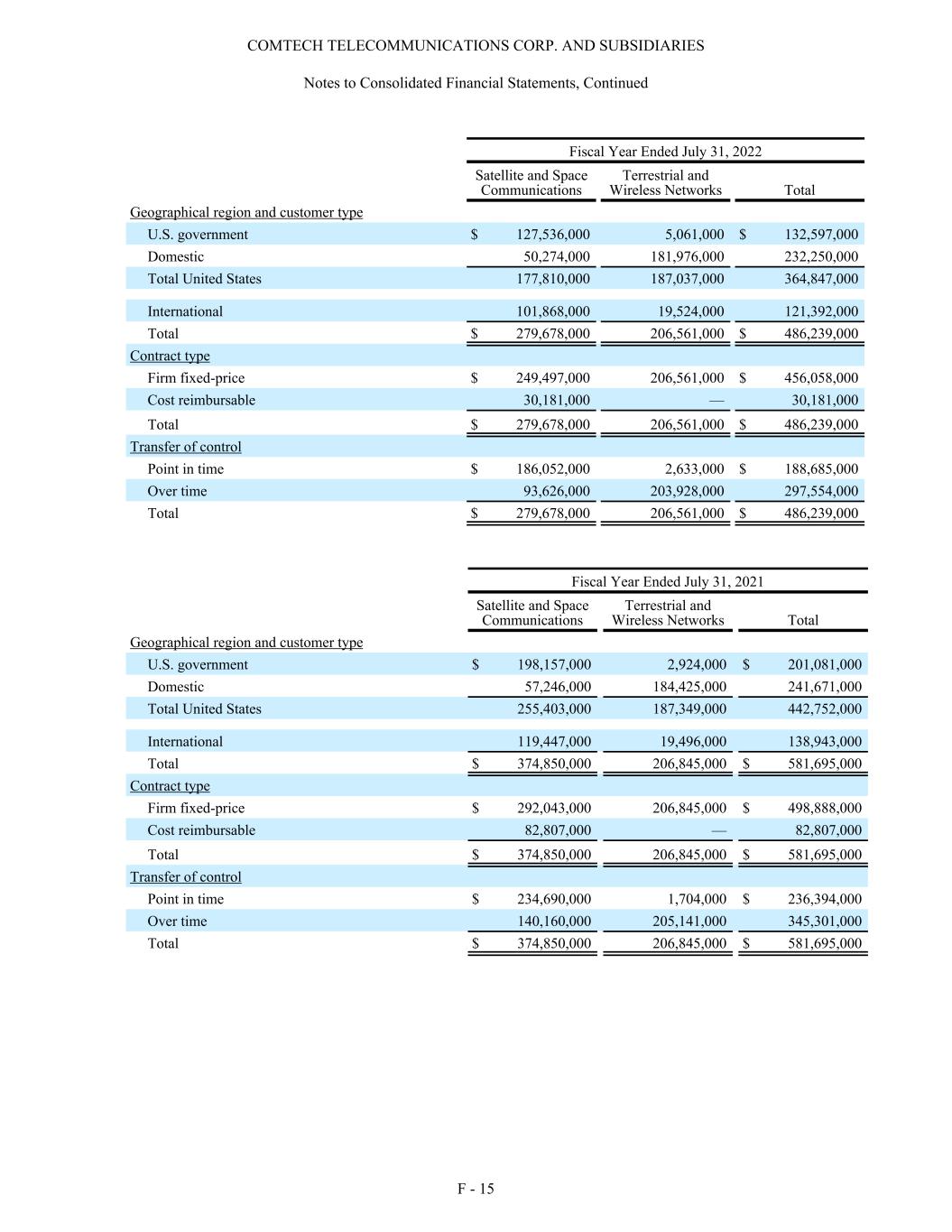
Fiscal Year Ended July 31, 2022 Satellite and Space Communications Terrestrial and Wireless Networks Total Geographical region and customer type U.S. government $ 127,536,000 5,061,000 $ 132,597,000 Domestic 50,274,000 181,976,000 232,250,000 Total United States 177,810,000 187,037,000 364,847,000 International 101,868,000 19,524,000 121,392,000 Total $ 279,678,000 206,561,000 $ 486,239,000 Contract type Firm fixed-price $ 249,497,000 206,561,000 $ 456,058,000 Cost reimbursable 30,181,000 — 30,181,000 Total $ 279,678,000 206,561,000 $ 486,239,000 Transfer of control Point in time $ 186,052,000 2,633,000 $ 188,685,000 Over time 93,626,000 203,928,000 297,554,000 Total $ 279,678,000 206,561,000 $ 486,239,000 Fiscal Year Ended July 31, 2021 Satellite and Space Communications Terrestrial and Wireless Networks Total Geographical region and customer type U.S. government $ 198,157,000 2,924,000 $ 201,081,000 Domestic 57,246,000 184,425,000 241,671,000 Total United States 255,403,000 187,349,000 442,752,000 International 119,447,000 19,496,000 138,943,000 Total $ 374,850,000 206,845,000 $ 581,695,000 Contract type Firm fixed-price $ 292,043,000 206,845,000 $ 498,888,000 Cost reimbursable 82,807,000 — 82,807,000 Total $ 374,850,000 206,845,000 $ 581,695,000 Transfer of control Point in time $ 234,690,000 1,704,000 $ 236,394,000 Over time 140,160,000 205,141,000 345,301,000 Total $ 374,850,000 206,845,000 $ 581,695,000 COMTECH TELECOMMUNICATIONS CORP. AND SUBSIDIARIES Notes to Consolidated Financial Statements, Continued F - 15

The timing of revenue recognition, billings and collections results in receivables, unbilled receivables and contract liabilities on our Consolidated Balance Sheet. Under typical payment terms for our contracts accounted for over time, amounts are billed as work progresses in accordance with agreed-upon contractual terms, either at periodic intervals (e.g., monthly) or upon achievement of contractual milestones. For certain contracts with provisions that are intended to protect customers in the event we do not satisfy our performance obligations, billings occur subsequent to revenue recognition, resulting in unbilled receivables. Under ASC 606, unbilled receivables constitute contract assets. There were no material impairment losses recognized on contract assets during the fiscal years ended July 31, 2023, 2022 and 2021. On large long-term contracts, and for contracts with international customers that do not do business with us regularly, payment terms typically require advanced payments and deposits. Under ASC 606, payments received from customers in excess of revenue recognized to-date results in a contract liability. These contract liabilities are not considered to represent a significant financing component of the contract because we believe these cash advances and deposits are generally used to meet working capital demands which can be higher in the earlier stages of a contract. Also, advanced payments and deposits provide us with some measure of assurance that the customer will perform on its obligations under the contract. Under the typical payment terms for our contracts accounted for at a point in time, costs are accumulated in inventory until the time of billing, which generally coincides with revenue recognition. Of the current contract liability balance of $64,601,000 at July 31, 2022 and $66,130,000 at July 31, 2021, $53,079,000 and $51,762,000 was recognized as revenue during fiscal years 2023 and 2022, respectively. We recognize the incremental costs to obtain or fulfill a contract as an expense when incurred if the amortization period of the asset is one year or less. During fiscal years 2023 and 2022, incremental costs to obtain or fulfill contracts with an amortization period greater than one year were not material. As commissions payable to our internal sales and marketing employees or contractors are contingent upon multiple factors, such commissions are not considered direct costs to obtain or fulfill a contract with a customer and are expensed as incurred in selling, general and administrative expenses on our Consolidated Statements of Operations. As for commissions payable to our third-party sales representatives related to large long-term contracts, we do consider these types of commissions both direct and incremental costs to obtain and fulfill such contracts. Therefore, such commissions are included in total estimated costs at completion for such contracts and expensed over time through cost of sales on our Consolidated Statements of Operations. Remaining performance obligations represent the transaction price of firm orders for which work has not been performed as of the end of a fiscal period. Remaining performance obligations, which we refer to as backlog, exclude unexercised contract options and potential orders under indefinite delivery / indefinite quantity ("IDIQ") contracts. As of July 31, 2023, the aggregate amount of the transaction price allocated to remaining performance obligations was $662,215,000 (which represents the amount of our consolidated backlog). We estimate that a substantial portion of our remaining performance obligations at July 31, 2023 will be completed and recognized as revenue during the next twenty-four month period, with the rest thereafter. During fiscal 2023, revenue recognized from performance obligations satisfied, or partially satisfied, in previous periods (for example due to changes in the transaction price) was not material. (d) Cash and Cash Equivalents Our cash equivalents are short-term, highly liquid investments that are both readily convertible to known amounts of cash and have insignificant risk of change in value as a result of changes in interest rates. Our cash and cash equivalents, as of July 31, 2023 and 2022, amounted to $18,961,000 and $21,654,000, respectively, and primarily consist of bank deposits and money market deposit accounts insured by the Federal Deposit Insurance Corporation. Cash equivalents are carried at cost, which approximates fair value. (e) Inventories Our inventories are stated at the lower of cost and net realizable value, the latter of which is defined as the estimated selling price in the ordinary course of business, less reasonably predictable costs of completion, disposal and transportation. Our inventories are reduced to their estimated net realizable value by a charge to cost of sales in the period such excess costs are determined. Our inventories are principally recorded using either average or standard costing methods. COMTECH TELECOMMUNICATIONS CORP. AND SUBSIDIARIES Notes to Consolidated Financial Statements, Continued F - 16
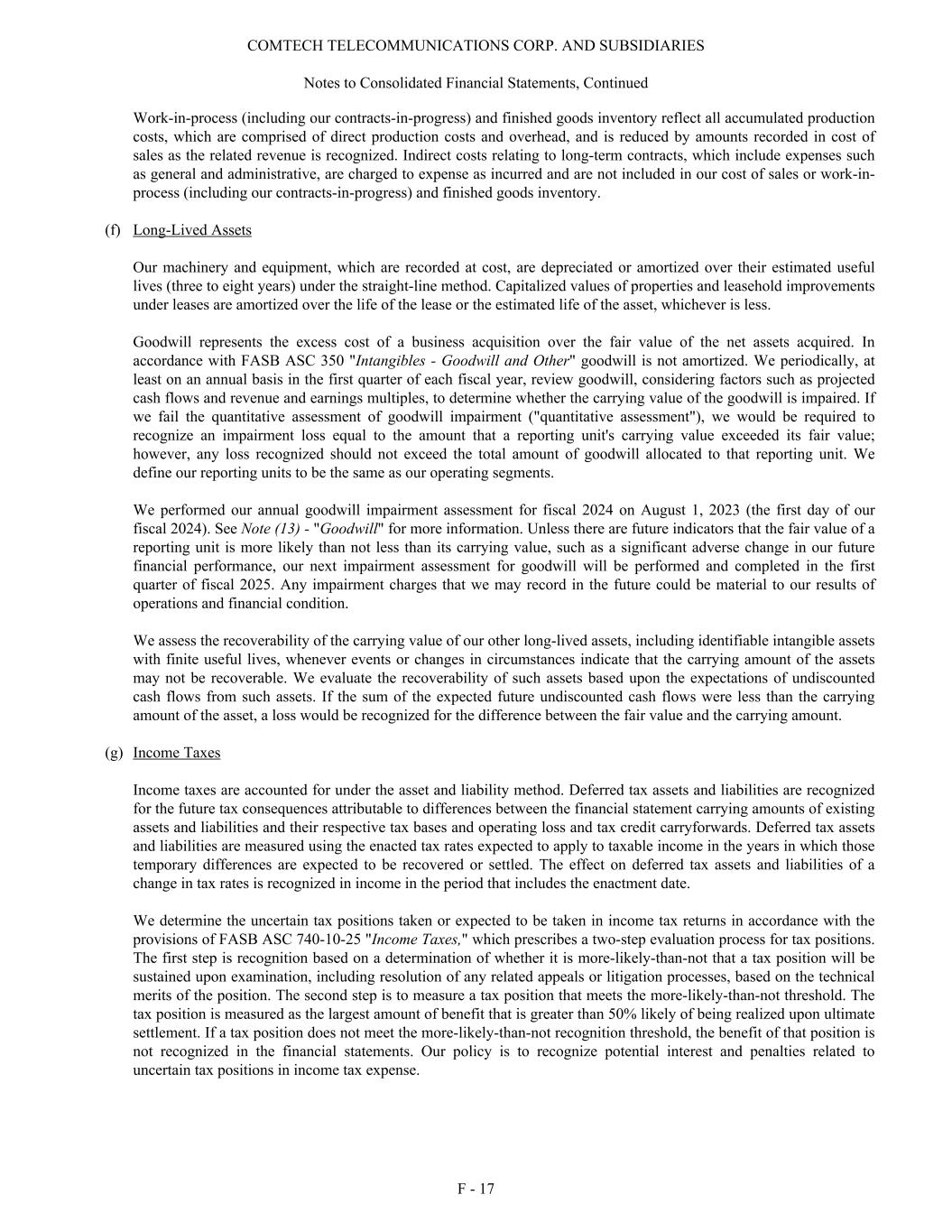
Work-in-process (including our contracts-in-progress) and finished goods inventory reflect all accumulated production costs, which are comprised of direct production costs and overhead, and is reduced by amounts recorded in cost of sales as the related revenue is recognized. Indirect costs relating to long-term contracts, which include expenses such as general and administrative, are charged to expense as incurred and are not included in our cost of sales or work-in- process (including our contracts-in-progress) and finished goods inventory. (f) Long-Lived Assets Our machinery and equipment, which are recorded at cost, are depreciated or amortized over their estimated useful lives (three to eight years) under the straight-line method. Capitalized values of properties and leasehold improvements under leases are amortized over the life of the lease or the estimated life of the asset, whichever is less. Goodwill represents the excess cost of a business acquisition over the fair value of the net assets acquired. In accordance with FASB ASC 350 "Intangibles - Goodwill and Other" goodwill is not amortized. We periodically, at least on an annual basis in the first quarter of each fiscal year, review goodwill, considering factors such as projected cash flows and revenue and earnings multiples, to determine whether the carrying value of the goodwill is impaired. If we fail the quantitative assessment of goodwill impairment ("quantitative assessment"), we would be required to recognize an impairment loss equal to the amount that a reporting unit's carrying value exceeded its fair value; however, any loss recognized should not exceed the total amount of goodwill allocated to that reporting unit. We define our reporting units to be the same as our operating segments. We performed our annual goodwill impairment assessment for fiscal 2024 on August 1, 2023 (the first day of our fiscal 2024). See Note (13) - "Goodwill" for more information. Unless there are future indicators that the fair value of a reporting unit is more likely than not less than its carrying value, such as a significant adverse change in our future financial performance, our next impairment assessment for goodwill will be performed and completed in the first quarter of fiscal 2025. Any impairment charges that we may record in the future could be material to our results of operations and financial condition. We assess the recoverability of the carrying value of our other long-lived assets, including identifiable intangible assets with finite useful lives, whenever events or changes in circumstances indicate that the carrying amount of the assets may not be recoverable. We evaluate the recoverability of such assets based upon the expectations of undiscounted cash flows from such assets. If the sum of the expected future undiscounted cash flows were less than the carrying amount of the asset, a loss would be recognized for the difference between the fair value and the carrying amount. (g) Income Taxes Income taxes are accounted for under the asset and liability method. Deferred tax assets and liabilities are recognized for the future tax consequences attributable to differences between the financial statement carrying amounts of existing assets and liabilities and their respective tax bases and operating loss and tax credit carryforwards. Deferred tax assets and liabilities are measured using the enacted tax rates expected to apply to taxable income in the years in which those temporary differences are expected to be recovered or settled. The effect on deferred tax assets and liabilities of a change in tax rates is recognized in income in the period that includes the enactment date. We determine the uncertain tax positions taken or expected to be taken in income tax returns in accordance with the provisions of FASB ASC 740-10-25 "Income Taxes," which prescribes a two-step evaluation process for tax positions. The first step is recognition based on a determination of whether it is more-likely-than-not that a tax position will be sustained upon examination, including resolution of any related appeals or litigation processes, based on the technical merits of the position. The second step is to measure a tax position that meets the more-likely-than-not threshold. The tax position is measured as the largest amount of benefit that is greater than 50% likely of being realized upon ultimate settlement. If a tax position does not meet the more-likely-than-not recognition threshold, the benefit of that position is not recognized in the financial statements. Our policy is to recognize potential interest and penalties related to uncertain tax positions in income tax expense. COMTECH TELECOMMUNICATIONS CORP. AND SUBSIDIARIES Notes to Consolidated Financial Statements, Continued F - 17
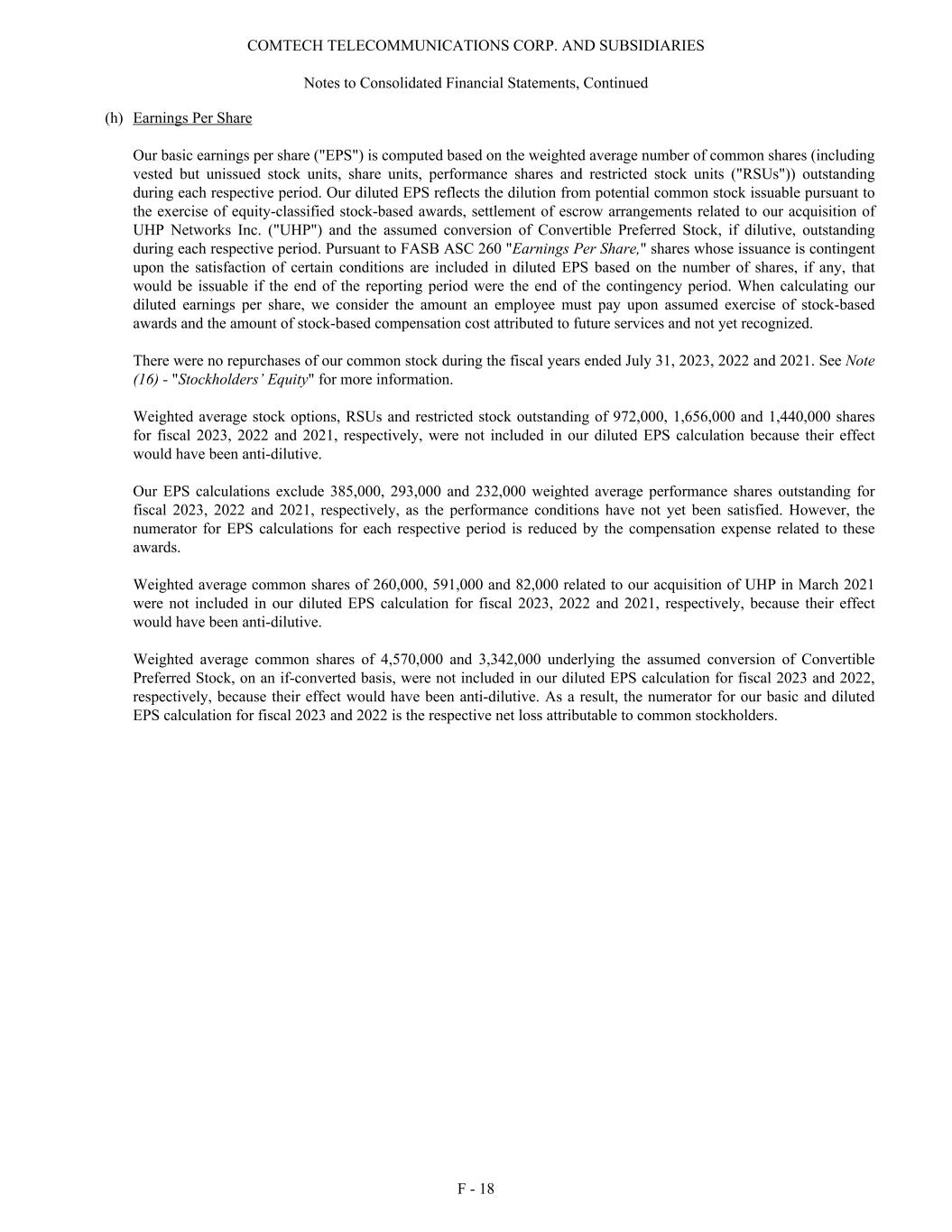
(h) Earnings Per Share Our basic earnings per share ("EPS") is computed based on the weighted average number of common shares (including vested but unissued stock units, share units, performance shares and restricted stock units ("RSUs")) outstanding during each respective period. Our diluted EPS reflects the dilution from potential common stock issuable pursuant to the exercise of equity-classified stock-based awards, settlement of escrow arrangements related to our acquisition of UHP Networks Inc. ("UHP") and the assumed conversion of Convertible Preferred Stock, if dilutive, outstanding during each respective period. Pursuant to FASB ASC 260 "Earnings Per Share," shares whose issuance is contingent upon the satisfaction of certain conditions are included in diluted EPS based on the number of shares, if any, that would be issuable if the end of the reporting period were the end of the contingency period. When calculating our diluted earnings per share, we consider the amount an employee must pay upon assumed exercise of stock-based awards and the amount of stock-based compensation cost attributed to future services and not yet recognized. There were no repurchases of our common stock during the fiscal years ended July 31, 2023, 2022 and 2021. See Note (16) - "Stockholders’ Equity" for more information. Weighted average stock options, RSUs and restricted stock outstanding of 972,000, 1,656,000 and 1,440,000 shares for fiscal 2023, 2022 and 2021, respectively, were not included in our diluted EPS calculation because their effect would have been anti-dilutive. Our EPS calculations exclude 385,000, 293,000 and 232,000 weighted average performance shares outstanding for fiscal 2023, 2022 and 2021, respectively, as the performance conditions have not yet been satisfied. However, the numerator for EPS calculations for each respective period is reduced by the compensation expense related to these awards. Weighted average common shares of 260,000, 591,000 and 82,000 related to our acquisition of UHP in March 2021 were not included in our diluted EPS calculation for fiscal 2023, 2022 and 2021, respectively, because their effect would have been anti-dilutive. Weighted average common shares of 4,570,000 and 3,342,000 underlying the assumed conversion of Convertible Preferred Stock, on an if-converted basis, were not included in our diluted EPS calculation for fiscal 2023 and 2022, respectively, because their effect would have been anti-dilutive. As a result, the numerator for our basic and diluted EPS calculation for fiscal 2023 and 2022 is the respective net loss attributable to common stockholders. COMTECH TELECOMMUNICATIONS CORP. AND SUBSIDIARIES Notes to Consolidated Financial Statements, Continued F - 18
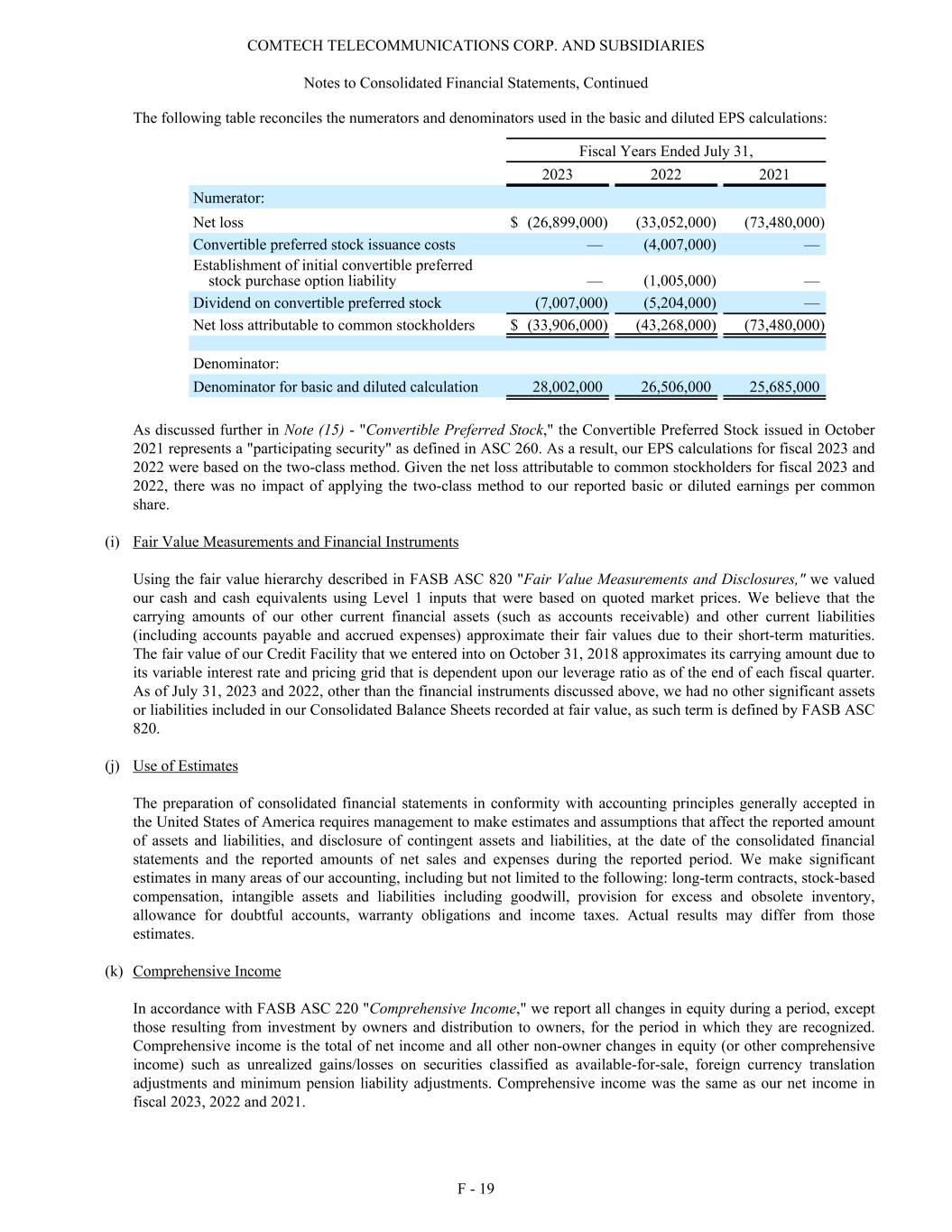
The following table reconciles the numerators and denominators used in the basic and diluted EPS calculations: Fiscal Years Ended July 31, 2023 2022 2021 Numerator: Net loss $ (26,899,000) (33,052,000) (73,480,000) Convertible preferred stock issuance costs — (4,007,000) — Establishment of initial convertible preferred stock purchase option liability — (1,005,000) — Dividend on convertible preferred stock (7,007,000) (5,204,000) — Net loss attributable to common stockholders $ (33,906,000) (43,268,000) (73,480,000) Denominator: Denominator for basic and diluted calculation 28,002,000 26,506,000 25,685,000 As discussed further in Note (15) - "Convertible Preferred Stock," the Convertible Preferred Stock issued in October 2021 represents a "participating security" as defined in ASC 260. As a result, our EPS calculations for fiscal 2023 and 2022 were based on the two-class method. Given the net loss attributable to common stockholders for fiscal 2023 and 2022, there was no impact of applying the two-class method to our reported basic or diluted earnings per common share. (i) Fair Value Measurements and Financial Instruments Using the fair value hierarchy described in FASB ASC 820 "Fair Value Measurements and Disclosures," we valued our cash and cash equivalents using Level 1 inputs that were based on quoted market prices. We believe that the carrying amounts of our other current financial assets (such as accounts receivable) and other current liabilities (including accounts payable and accrued expenses) approximate their fair values due to their short-term maturities. The fair value of our Credit Facility that we entered into on October 31, 2018 approximates its carrying amount due to its variable interest rate and pricing grid that is dependent upon our leverage ratio as of the end of each fiscal quarter. As of July 31, 2023 and 2022, other than the financial instruments discussed above, we had no other significant assets or liabilities included in our Consolidated Balance Sheets recorded at fair value, as such term is defined by FASB ASC 820. (j) Use of Estimates The preparation of consolidated financial statements in conformity with accounting principles generally accepted in the United States of America requires management to make estimates and assumptions that affect the reported amount of assets and liabilities, and disclosure of contingent assets and liabilities, at the date of the consolidated financial statements and the reported amounts of net sales and expenses during the reported period. We make significant estimates in many areas of our accounting, including but not limited to the following: long-term contracts, stock-based compensation, intangible assets and liabilities including goodwill, provision for excess and obsolete inventory, allowance for doubtful accounts, warranty obligations and income taxes. Actual results may differ from those estimates. (k) Comprehensive Income In accordance with FASB ASC 220 "Comprehensive Income," we report all changes in equity during a period, except those resulting from investment by owners and distribution to owners, for the period in which they are recognized. Comprehensive income is the total of net income and all other non-owner changes in equity (or other comprehensive income) such as unrealized gains/losses on securities classified as available-for-sale, foreign currency translation adjustments and minimum pension liability adjustments. Comprehensive income was the same as our net income in fiscal 2023, 2022 and 2021. COMTECH TELECOMMUNICATIONS CORP. AND SUBSIDIARIES Notes to Consolidated Financial Statements, Continued F - 19

(l) Reclassifications Certain reclassifications have been made to previously reported consolidated financial statements to conform to the fiscal 2023 presentation. (m) Adoption of Accounting Standards and Updates We are required to prepare our consolidated financial statements in accordance with the Financial Accounting Standards Board ("FASB") Accounting Standards Codification ("ASC") which is the source for all authoritative U.S. generally accepted accounting principles, which are commonly referred to as "GAAP." The FASB ASC is subject to updates by the FASB, which are known as Accounting Standards Updates ("ASUs"). ASUs issued, but not effective until after July 31, 2023, are not expected to have a material impact on our consolidated financial statements or disclosures. (2) CEO Transition Costs On August 9, 2022, our Board of Directors appointed our Chairman of the Board, Ken Peterman, as President and Chief Executive Officer ("CEO"). Transition costs related to our former President and CEO, Michael D. Porcelain, pursuant to his separation agreement with the Company, were $7,424,000, of which $3,764,000 related to the acceleration of unamortized stock based compensation, with the remaining $3,660,000 related to his severance payments and benefits upon termination of employment. The cash portion of the transition costs of $3,660,000 was paid to Mr. Porcelain in October 2022. Also, in connection with Mr. Peterman entering into an employment agreement with the Company, effective as of August 9, 2022, we incurred a $1,000,000 expense related to a cash sign-on bonus, which was paid to Mr. Peterman in January 2023. CEO transition costs related to Mr. Porcelain and Mr. Peterman were expensed in our Unallocated segment during the first quarter of fiscal 2023. During fiscal 2022, we expensed $13,554,000 of transition costs related to another former CEO, Fred Kornberg. (3) Accounts Receivable Accounts receivable consists of the following at July 31, 2023 and 2022: 2023 2022 Receivables from commercial and international customers $ 52,438,000 59,922,000 Unbilled receivables from commercial and international customers 54,469,000 39,826,000 Receivables from the U.S. government and its agencies 31,149,000 24,776,000 Unbilled receivables from the U.S. government and its agencies 27,192,000 1,524,000 Total accounts receivable 165,248,000 126,048,000 Less allowance for doubtful accounts 2,089,000 2,337,000 Accounts receivable, net $ 163,159,000 123,711,000 Unbilled receivables as of July 31, 2023 relate to contracts-in-progress for which revenue has been recognized, but we have not yet earned the right to bill the customer for work performed to-date. Under ASC 606, unbilled receivables constitute contract assets. Management estimates that a substantial portion of the amounts not yet billed at July 31, 2023 will be billed and collected within one year. Accounts receivable in the table above excludes $2,993,000 of long- term unbilled receivables presented within "Other assets, net" in the consolidated balance sheet as of July 31, 2023. As of July 31, 2023, except for the U.S. government (and its agencies) and AT&T, which represented 35.3% and 11.0% of total accounts receivable, respectively, there were no other customers which accounted for greater than 10.0% of total accounts receivable. As of July 31, 2022, except for the U.S. government (and its agencies) and Verizon, which represented 20.9% and 13.4% of total accounts receivable, respectively, there were no other customers which accounted for greater than 10.0% of total accounts receivable. COMTECH TELECOMMUNICATIONS CORP. AND SUBSIDIARIES Notes to Consolidated Financial Statements, Continued F - 20

(4) Inventories Inventories consist of the following at July 31, 2023 and 2022: 2023 2022 Raw materials and components $ 87,139,000 78,478,000 Work-in-process and finished goods 43,365,000 40,960,000 Total inventories 130,504,000 119,438,000 Less reserve for excess and obsolete inventories 24,659,000 23,121,000 Inventories, net $ 105,845,000 96,317,000 As of July 31, 2023 and 2022, the amount of inventory directly related to long-term contracts (including contracts-in- progress) was $5,911,000 and $4,100,000, respectively, and the amount of inventory related to contracts from third- party commercial customers who outsource their manufacturing to us was $3,277,000 and $1,866,000, respectively. (5) Property, Plant and Equipment Property, plant and equipment consist of the following at July 31, 2023 and 2022: 2023 2022 Machinery and equipment $ 193,832,000 186,935,000 Leasehold improvements 9,680,000 14,260,000 203,512,000 201,195,000 Less accumulated depreciation and amortization 150,483,000 150,832,000 Property, plant and equipment, net $ 53,029,000 50,363,000 Depreciation and amortization expense on property, plant and equipment amounted to $11,917,000, $10,303,000 and $9,343,000 for the fiscal years ended July 31, 2023, 2022 and 2021, respectively. (6) Accrued Expenses and Other Current Liabilities Accrued expenses and other current liabilities consist of the following at July 31, 2023 and 2022: 2023 2022 Accrued wages and benefits $ 21,994,000 25,675,000 Accrued contract costs 19,041,000 15,921,000 Accrued warranty obligations 8,285,000 9,420,000 Accrued commissions and royalties 4,659,000 5,697,000 Accrued legal costs 688,000 2,514,000 Other 12,323,000 13,435,000 Accrued expenses and other current liabilities $ 66,990,000 72,662,000 Accrued contract costs represent direct and indirect costs on contracts as well as estimates of amounts owed for invoices not yet received from vendors or reflected in accounts payable. Accrued warranty obligations as of July 31, 2023 relate to estimated liabilities for assurance type warranty coverage that we provide to our customers. We generally provide warranty coverage for some of our products for a period of at least one year from the date of delivery. We record a liability for estimated warranty expense based on historical claims, product failure rates, consideration of contractual obligations, future costs to resolve software issues and other factors. Some of our product warranties are provided under long-term contracts, the costs of which are incorporated into our estimates of total contract costs. COMTECH TELECOMMUNICATIONS CORP. AND SUBSIDIARIES Notes to Consolidated Financial Statements, Continued F - 21
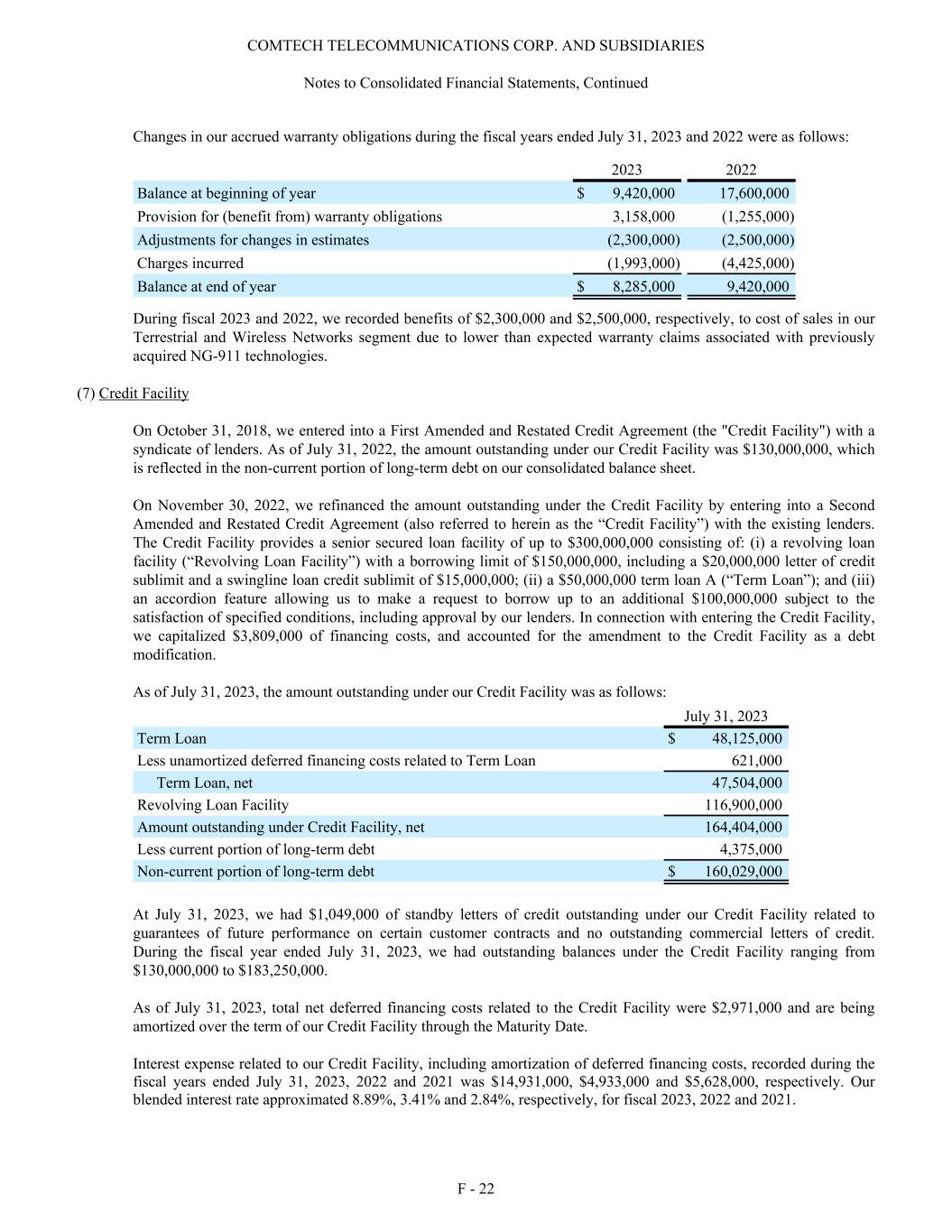
Changes in our accrued warranty obligations during the fiscal years ended July 31, 2023 and 2022 were as follows: 2023 2022 Balance at beginning of year $ 9,420,000 17,600,000 Provision for (benefit from) warranty obligations 3,158,000 (1,255,000) Adjustments for changes in estimates (2,300,000) (2,500,000) Charges incurred (1,993,000) (4,425,000) Balance at end of year $ 8,285,000 9,420,000 During fiscal 2023 and 2022, we recorded benefits of $2,300,000 and $2,500,000, respectively, to cost of sales in our Terrestrial and Wireless Networks segment due to lower than expected warranty claims associated with previously acquired NG-911 technologies. (7) Credit Facility On October 31, 2018, we entered into a First Amended and Restated Credit Agreement (the "Credit Facility") with a syndicate of lenders. As of July 31, 2022, the amount outstanding under our Credit Facility was $130,000,000, which is reflected in the non-current portion of long-term debt on our consolidated balance sheet. On November 30, 2022, we refinanced the amount outstanding under the Credit Facility by entering into a Second Amended and Restated Credit Agreement (also referred to herein as the “Credit Facility”) with the existing lenders. The Credit Facility provides a senior secured loan facility of up to $300,000,000 consisting of: (i) a revolving loan facility (“Revolving Loan Facility”) with a borrowing limit of $150,000,000, including a $20,000,000 letter of credit sublimit and a swingline loan credit sublimit of $15,000,000; (ii) a $50,000,000 term loan A (“Term Loan”); and (iii) an accordion feature allowing us to make a request to borrow up to an additional $100,000,000 subject to the satisfaction of specified conditions, including approval by our lenders. In connection with entering the Credit Facility, we capitalized $3,809,000 of financing costs, and accounted for the amendment to the Credit Facility as a debt modification. As of July 31, 2023, the amount outstanding under our Credit Facility was as follows: July 31, 2023 Term Loan $ 48,125,000 Less unamortized deferred financing costs related to Term Loan 621,000 Term Loan, net 47,504,000 Revolving Loan Facility 116,900,000 Amount outstanding under Credit Facility, net 164,404,000 Less current portion of long-term debt 4,375,000 Non-current portion of long-term debt $ 160,029,000 At July 31, 2023, we had $1,049,000 of standby letters of credit outstanding under our Credit Facility related to guarantees of future performance on certain customer contracts and no outstanding commercial letters of credit. During the fiscal year ended July 31, 2023, we had outstanding balances under the Credit Facility ranging from $130,000,000 to $183,250,000. As of July 31, 2023, total net deferred financing costs related to the Credit Facility were $2,971,000 and are being amortized over the term of our Credit Facility through the Maturity Date. Interest expense related to our Credit Facility, including amortization of deferred financing costs, recorded during the fiscal years ended July 31, 2023, 2022 and 2021 was $14,931,000, $4,933,000 and $5,628,000, respectively. Our blended interest rate approximated 8.89%, 3.41% and 2.84%, respectively, for fiscal 2023, 2022 and 2021. COMTECH TELECOMMUNICATIONS CORP. AND SUBSIDIARIES Notes to Consolidated Financial Statements, Continued F - 22
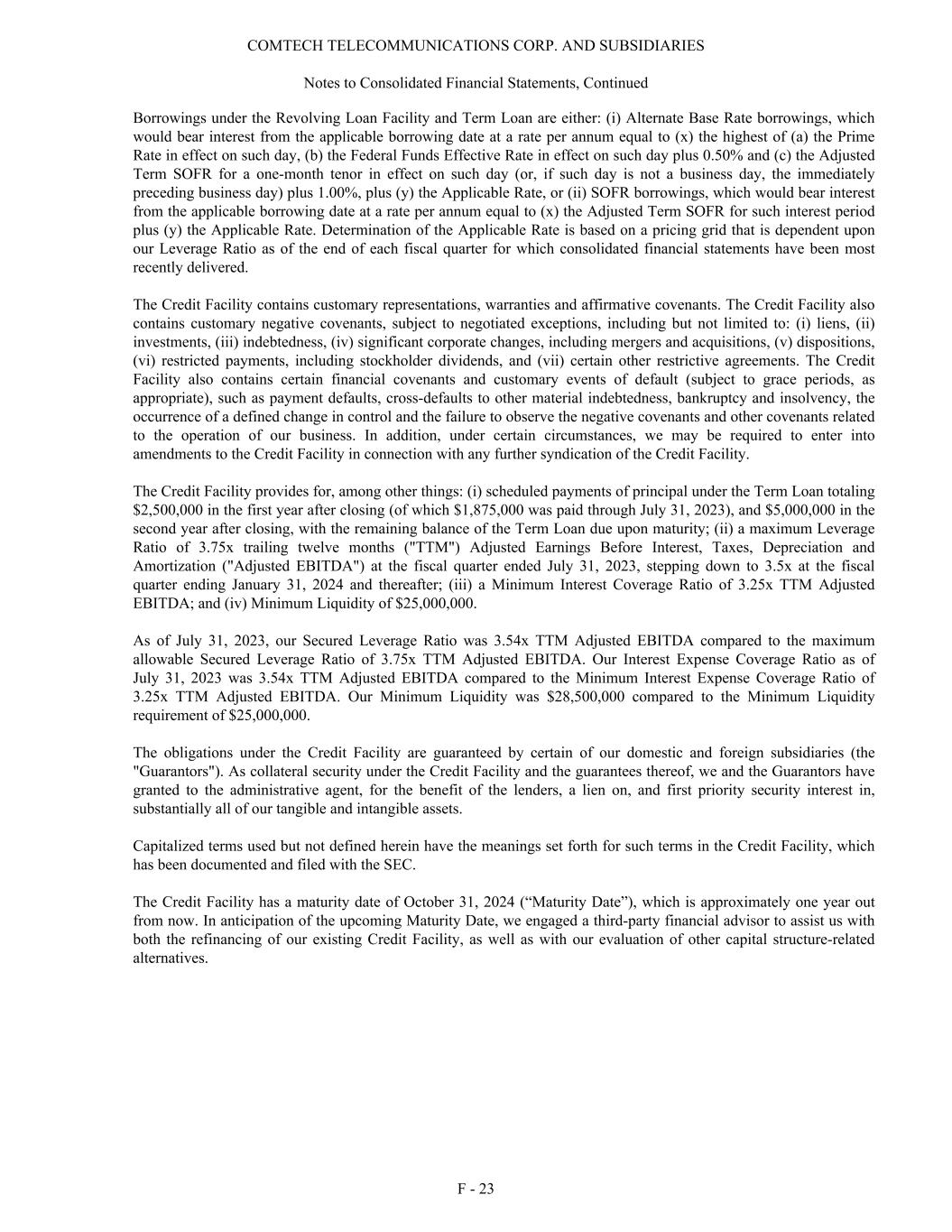
Borrowings under the Revolving Loan Facility and Term Loan are either: (i) Alternate Base Rate borrowings, which would bear interest from the applicable borrowing date at a rate per annum equal to (x) the highest of (a) the Prime Rate in effect on such day, (b) the Federal Funds Effective Rate in effect on such day plus 0.50% and (c) the Adjusted Term SOFR for a one-month tenor in effect on such day (or, if such day is not a business day, the immediately preceding business day) plus 1.00%, plus (y) the Applicable Rate, or (ii) SOFR borrowings, which would bear interest from the applicable borrowing date at a rate per annum equal to (x) the Adjusted Term SOFR for such interest period plus (y) the Applicable Rate. Determination of the Applicable Rate is based on a pricing grid that is dependent upon our Leverage Ratio as of the end of each fiscal quarter for which consolidated financial statements have been most recently delivered. The Credit Facility contains customary representations, warranties and affirmative covenants. The Credit Facility also contains customary negative covenants, subject to negotiated exceptions, including but not limited to: (i) liens, (ii) investments, (iii) indebtedness, (iv) significant corporate changes, including mergers and acquisitions, (v) dispositions, (vi) restricted payments, including stockholder dividends, and (vii) certain other restrictive agreements. The Credit Facility also contains certain financial covenants and customary events of default (subject to grace periods, as appropriate), such as payment defaults, cross-defaults to other material indebtedness, bankruptcy and insolvency, the occurrence of a defined change in control and the failure to observe the negative covenants and other covenants related to the operation of our business. In addition, under certain circumstances, we may be required to enter into amendments to the Credit Facility in connection with any further syndication of the Credit Facility. The Credit Facility provides for, among other things: (i) scheduled payments of principal under the Term Loan totaling $2,500,000 in the first year after closing (of which $1,875,000 was paid through July 31, 2023), and $5,000,000 in the second year after closing, with the remaining balance of the Term Loan due upon maturity; (ii) a maximum Leverage Ratio of 3.75x trailing twelve months ("TTM") Adjusted Earnings Before Interest, Taxes, Depreciation and Amortization ("Adjusted EBITDA") at the fiscal quarter ended July 31, 2023, stepping down to 3.5x at the fiscal quarter ending January 31, 2024 and thereafter; (iii) a Minimum Interest Coverage Ratio of 3.25x TTM Adjusted EBITDA; and (iv) Minimum Liquidity of $25,000,000. As of July 31, 2023, our Secured Leverage Ratio was 3.54x TTM Adjusted EBITDA compared to the maximum allowable Secured Leverage Ratio of 3.75x TTM Adjusted EBITDA. Our Interest Expense Coverage Ratio as of July 31, 2023 was 3.54x TTM Adjusted EBITDA compared to the Minimum Interest Expense Coverage Ratio of 3.25x TTM Adjusted EBITDA. Our Minimum Liquidity was $28,500,000 compared to the Minimum Liquidity requirement of $25,000,000. The obligations under the Credit Facility are guaranteed by certain of our domestic and foreign subsidiaries (the "Guarantors"). As collateral security under the Credit Facility and the guarantees thereof, we and the Guarantors have granted to the administrative agent, for the benefit of the lenders, a lien on, and first priority security interest in, substantially all of our tangible and intangible assets. Capitalized terms used but not defined herein have the meanings set forth for such terms in the Credit Facility, which has been documented and filed with the SEC. The Credit Facility has a maturity date of October 31, 2024 (“Maturity Date”), which is approximately one year out from now. In anticipation of the upcoming Maturity Date, we engaged a third-party financial advisor to assist us with both the refinancing of our existing Credit Facility, as well as with our evaluation of other capital structure-related alternatives. COMTECH TELECOMMUNICATIONS CORP. AND SUBSIDIARIES Notes to Consolidated Financial Statements, Continued F - 23

(8) Leases Our leases historically relate to the leasing of facilities and equipment. In accordance with FASB ASC 842 - "Leases" ("ASC 842"), we determine at inception whether an arrangement is, or contains, a lease and whether the lease should be classified as an operating or a financing lease. At lease commencement, we recognize a right-of-use ("ROU") asset and lease liability based on the present value of the future lease payments over the estimated lease term. We have elected to not recognize a ROU asset or lease liability for any leases with terms of twelve months or less. Instead, for such short-term leases, we recognize lease expense on a straight-line basis over the lease term. Certain of our leases include options to extend the term of the lease or to terminate the lease early. When it is reasonably certain that we will exercise a renewal option or will not exercise a termination option, we include the impact of exercising or not exercising such option, respectively, in the estimate of the lease term. As our lease agreements do not explicitly state the discount rate implicit in the lease, we use our incremental borrowing rate ("IBR") on the commencement date to calculate the present value of future lease payments. Such IBR represents our estimated rate of interest to borrow on a collateralized basis over a term commensurate with the expected lease term. Some of our leases include payments that are based on the Consumer Price Index ("CPI") or other similar indices. These variable lease payments are included in the calculation of the ROU asset and lease liability using the index as of the lease commencement date. Other variable lease payments, such as common area maintenance, property taxes, and usage-based amounts, are required by ASC 842 to be excluded from the ROU asset and lease liability and expensed as incurred. In addition to the present value of the future lease payments, the calculation of the ROU asset would also consider, to the extent applicable, any deferred rent upon adoption, lease pre-payments or initial direct costs of obtaining the lease (e.g., such as commissions). For all classes of leased assets, we elected the practical expedient to not separate lease components (i.e., the actual item being leased, such as the facility or piece of equipment) from non-lease components (i.e., the distinct elements of a contract not related to securing the use of the leased asset, such as common area maintenance and consumable supplies). Certain of our facility lease agreements (which are classified as operating leases) contain rent holidays or rent escalation clauses. For rent holidays and rent escalation clauses during the lease term, we record rental expense on a straight-line basis over the term of the lease. As of July 31, 2023, none of our leases contained a residual value guarantee and covenants included in our lease agreements are customary for the types of facilities and equipment being leased. The components of lease expense are as follows: Fiscal years ended July 31, 2023 2022 2021 Finance lease expense: Amortization of ROU assets $ 5,000 13,000 36,000 Interest on lease liabilities — 1,000 3,000 Operating lease expense 10,439,000 11,658,000 12,152,000 Short-term lease expense 435,000 402,000 819,000 Variable lease expense 4,031,000 4,619,000 4,523,000 Sublease income (67,000) (67,000) (67,000) Total lease expense $ 14,843,000 16,626,000 17,466,000 COMTECH TELECOMMUNICATIONS CORP. AND SUBSIDIARIES Notes to Consolidated Financial Statements, Continued F - 24
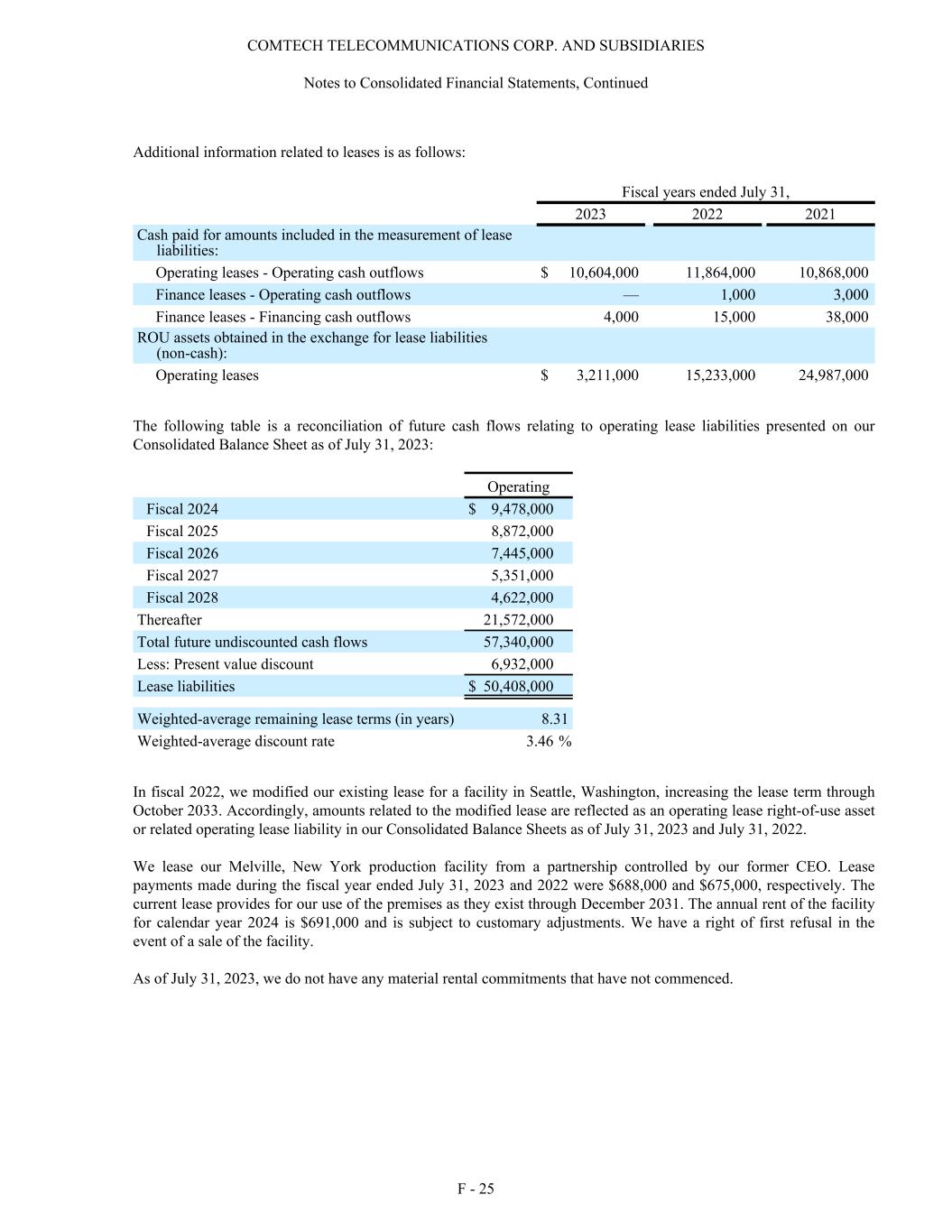
Additional information related to leases is as follows: Fiscal years ended July 31, 2023 2022 2021 Cash paid for amounts included in the measurement of lease liabilities: Operating leases - Operating cash outflows $ 10,604,000 11,864,000 10,868,000 Finance leases - Operating cash outflows — 1,000 3,000 Finance leases - Financing cash outflows 4,000 15,000 38,000 ROU assets obtained in the exchange for lease liabilities (non-cash): Operating leases $ 3,211,000 15,233,000 24,987,000 The following table is a reconciliation of future cash flows relating to operating lease liabilities presented on our Consolidated Balance Sheet as of July 31, 2023: Operating Fiscal 2024 $ 9,478,000 Fiscal 2025 8,872,000 Fiscal 2026 7,445,000 Fiscal 2027 5,351,000 Fiscal 2028 4,622,000 Thereafter 21,572,000 Total future undiscounted cash flows 57,340,000 Less: Present value discount 6,932,000 Lease liabilities $ 50,408,000 Weighted-average remaining lease terms (in years) 8.31 Weighted-average discount rate 3.46 % In fiscal 2022, we modified our existing lease for a facility in Seattle, Washington, increasing the lease term through October 2033. Accordingly, amounts related to the modified lease are reflected as an operating lease right-of-use asset or related operating lease liability in our Consolidated Balance Sheets as of July 31, 2023 and July 31, 2022. We lease our Melville, New York production facility from a partnership controlled by our former CEO. Lease payments made during the fiscal year ended July 31, 2023 and 2022 were $688,000 and $675,000, respectively. The current lease provides for our use of the premises as they exist through December 2031. The annual rent of the facility for calendar year 2024 is $691,000 and is subject to customary adjustments. We have a right of first refusal in the event of a sale of the facility. As of July 31, 2023, we do not have any material rental commitments that have not commenced. COMTECH TELECOMMUNICATIONS CORP. AND SUBSIDIARIES Notes to Consolidated Financial Statements, Continued F - 25
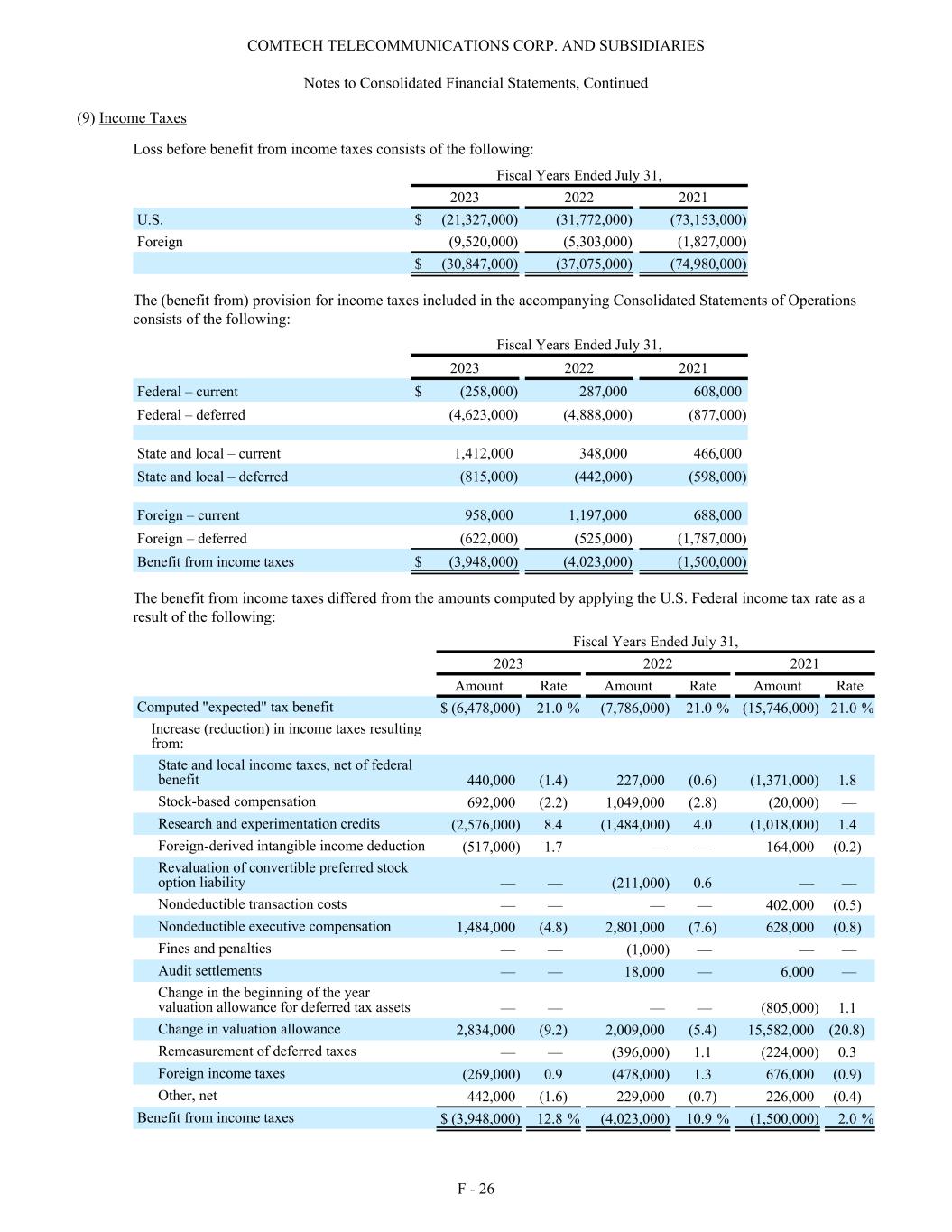
(9) Income Taxes Loss before benefit from income taxes consists of the following: Fiscal Years Ended July 31, 2023 2022 2021 U.S. $ (21,327,000) (31,772,000) (73,153,000) Foreign (9,520,000) (5,303,000) (1,827,000) $ (30,847,000) (37,075,000) (74,980,000) The (benefit from) provision for income taxes included in the accompanying Consolidated Statements of Operations consists of the following: Fiscal Years Ended July 31, 2023 2022 2021 Federal – current $ (258,000) 287,000 608,000 Federal – deferred (4,623,000) (4,888,000) (877,000) State and local – current 1,412,000 348,000 466,000 State and local – deferred (815,000) (442,000) (598,000) Foreign – current 958,000 1,197,000 688,000 Foreign – deferred (622,000) (525,000) (1,787,000) Benefit from income taxes $ (3,948,000) (4,023,000) (1,500,000) The benefit from income taxes differed from the amounts computed by applying the U.S. Federal income tax rate as a result of the following: Fiscal Years Ended July 31, 2023 2022 2021 Amount Rate Amount Rate Amount Rate Computed "expected" tax benefit $ (6,478,000) 21.0 % (7,786,000) 21.0 % (15,746,000) 21.0 % Increase (reduction) in income taxes resulting from: State and local income taxes, net of federal benefit 440,000 (1.4) 227,000 (0.6) (1,371,000) 1.8 Stock-based compensation 692,000 (2.2) 1,049,000 (2.8) (20,000) — Research and experimentation credits (2,576,000) 8.4 (1,484,000) 4.0 (1,018,000) 1.4 Foreign-derived intangible income deduction (517,000) 1.7 — — 164,000 (0.2) Revaluation of convertible preferred stock option liability — — (211,000) 0.6 — — Nondeductible transaction costs — — — — 402,000 (0.5) Nondeductible executive compensation 1,484,000 (4.8) 2,801,000 (7.6) 628,000 (0.8) Fines and penalties — — (1,000) — — — Audit settlements — — 18,000 — 6,000 — Change in the beginning of the year valuation allowance for deferred tax assets — — — — (805,000) 1.1 Change in valuation allowance 2,834,000 (9.2) 2,009,000 (5.4) 15,582,000 (20.8) Remeasurement of deferred taxes — — (396,000) 1.1 (224,000) 0.3 Foreign income taxes (269,000) 0.9 (478,000) 1.3 676,000 (0.9) Other, net 442,000 (1.6) 229,000 (0.7) 226,000 (0.4) Benefit from income taxes $ (3,948,000) 12.8 % (4,023,000) 10.9 % (1,500,000) 2.0 % COMTECH TELECOMMUNICATIONS CORP. AND SUBSIDIARIES Notes to Consolidated Financial Statements, Continued F - 26
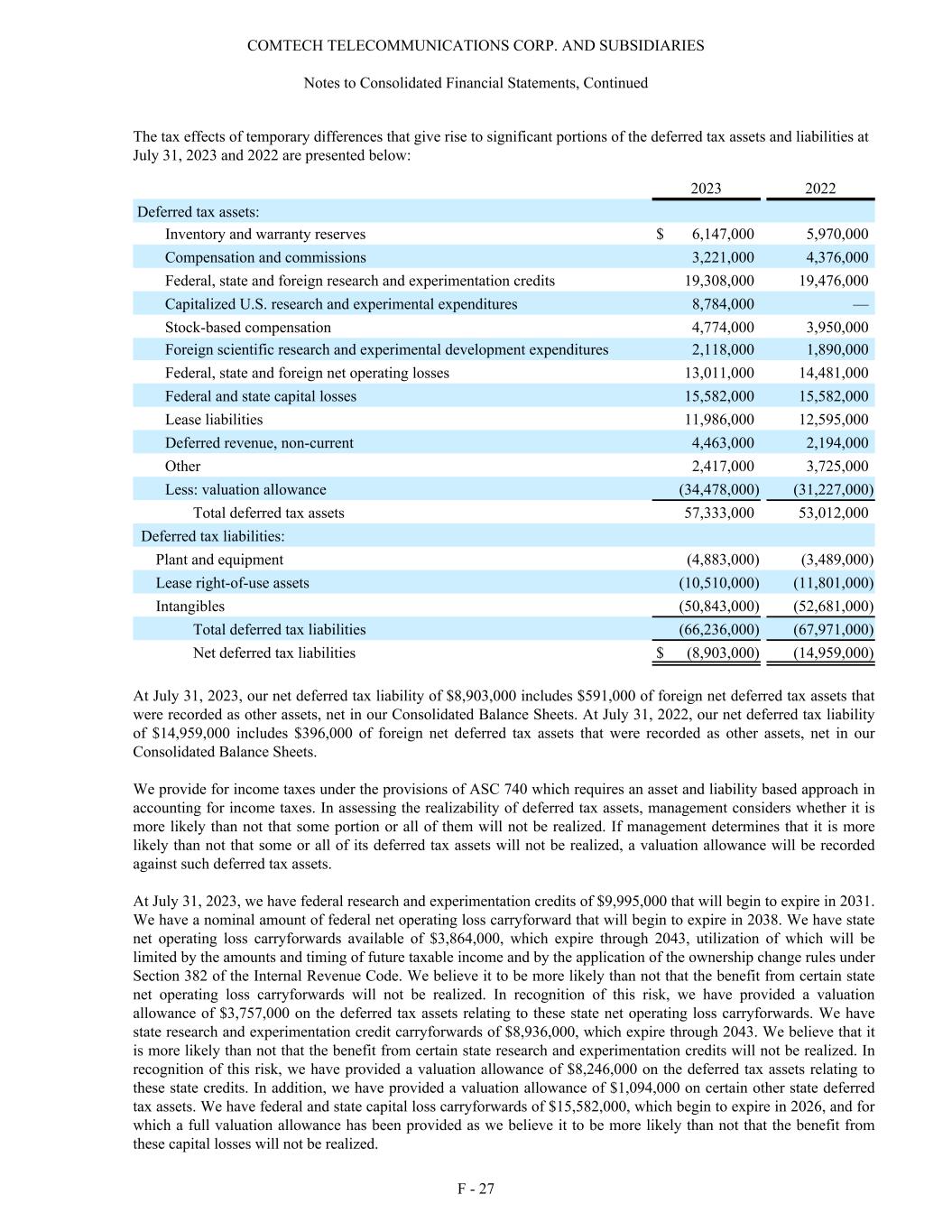
The tax effects of temporary differences that give rise to significant portions of the deferred tax assets and liabilities at July 31, 2023 and 2022 are presented below: 2023 2022 Deferred tax assets: Inventory and warranty reserves $ 6,147,000 5,970,000 Compensation and commissions 3,221,000 4,376,000 Federal, state and foreign research and experimentation credits 19,308,000 19,476,000 Capitalized U.S. research and experimental expenditures 8,784,000 — Stock-based compensation 4,774,000 3,950,000 Foreign scientific research and experimental development expenditures 2,118,000 1,890,000 Federal, state and foreign net operating losses 13,011,000 14,481,000 Federal and state capital losses 15,582,000 15,582,000 Lease liabilities 11,986,000 12,595,000 Deferred revenue, non-current 4,463,000 2,194,000 Other 2,417,000 3,725,000 Less: valuation allowance (34,478,000) (31,227,000) Total deferred tax assets 57,333,000 53,012,000 Deferred tax liabilities: Plant and equipment (4,883,000) (3,489,000) Lease right-of-use assets (10,510,000) (11,801,000) Intangibles (50,843,000) (52,681,000) Total deferred tax liabilities (66,236,000) (67,971,000) Net deferred tax liabilities $ (8,903,000) (14,959,000) At July 31, 2023, our net deferred tax liability of $8,903,000 includes $591,000 of foreign net deferred tax assets that were recorded as other assets, net in our Consolidated Balance Sheets. At July 31, 2022, our net deferred tax liability of $14,959,000 includes $396,000 of foreign net deferred tax assets that were recorded as other assets, net in our Consolidated Balance Sheets. We provide for income taxes under the provisions of ASC 740 which requires an asset and liability based approach in accounting for income taxes. In assessing the realizability of deferred tax assets, management considers whether it is more likely than not that some portion or all of them will not be realized. If management determines that it is more likely than not that some or all of its deferred tax assets will not be realized, a valuation allowance will be recorded against such deferred tax assets. At July 31, 2023, we have federal research and experimentation credits of $9,995,000 that will begin to expire in 2031. We have a nominal amount of federal net operating loss carryforward that will begin to expire in 2038. We have state net operating loss carryforwards available of $3,864,000, which expire through 2043, utilization of which will be limited by the amounts and timing of future taxable income and by the application of the ownership change rules under Section 382 of the Internal Revenue Code. We believe it to be more likely than not that the benefit from certain state net operating loss carryforwards will not be realized. In recognition of this risk, we have provided a valuation allowance of $3,757,000 on the deferred tax assets relating to these state net operating loss carryforwards. We have state research and experimentation credit carryforwards of $8,936,000, which expire through 2043. We believe that it is more likely than not that the benefit from certain state research and experimentation credits will not be realized. In recognition of this risk, we have provided a valuation allowance of $8,246,000 on the deferred tax assets relating to these state credits. In addition, we have provided a valuation allowance of $1,094,000 on certain other state deferred tax assets. We have federal and state capital loss carryforwards of $15,582,000, which begin to expire in 2026, and for which a full valuation allowance has been provided as we believe it to be more likely than not that the benefit from these capital losses will not be realized. COMTECH TELECOMMUNICATIONS CORP. AND SUBSIDIARIES Notes to Consolidated Financial Statements, Continued F - 27

At July 31, 2023, we had foreign deferred tax assets relating to net operating loss carryforwards of $9,186,000, which will begin to expire in 2032. We believe that it is more likely than not that certain net operating loss carryforwards may not be realized. In recognition of this risk, we have provided a valuation allowance of $5,799,000 on the deferred tax assets relating to these net operating loss carryforwards. We have foreign deferred tax assets relating to research and experimentation credits of $377,000, which will begin to expire in 2038. Our foreign earnings and profits are insignificant and, as such, we have not recorded any deferred tax liability on unremitted foreign earnings. At July 31, 2023 and 2022, total unrecognized tax benefits were $9,166,000 and $10,008,000, respectively, including interest of $210,000 and $330,000, respectively. At July 31, 2023 and 2022, $2,208,000 and $3,007,000, respectively, of our unrecognized tax benefits were recorded as non-current income taxes payable on our Consolidated Balance Sheets. The remaining unrecognized tax benefits of $6,958,000 and $7,001,000 at July 31, 2023 and 2022, respectively, were presented as an offset to the associated non-current deferred tax assets on our Consolidated Balance Sheets. Of the total unrecognized tax benefits, $8,286,000 and $9,034,000 at July 31, 2023 and 2022, respectively, net of the reversal of the federal benefit recognized as a deferred tax asset relating to state reserves, would favorably impact our effective tax rate, if recognized. Unrecognized tax benefits result from income tax positions taken or expected to be taken on our income tax returns for which a tax benefit has not been recorded in our consolidated financial statements. We believe it is reasonably possible that the gross unrecognized tax benefits could decrease by as much as $622,000 in the next 12 months due to the expiration of a statute of limitations related to federal, state and foreign tax positions. Our policy is to recognize potential interest and penalties relating to uncertain tax positions in income tax expense. The following table summarizes the activity related to our unrecognized tax benefits for fiscal years 2023, 2022 and 2021 (excluding interest): 2023 2022 2021 Balance at beginning of period $ 9,675,000 9,009,000 8,270,000 Increase related to current period 681,000 598,000 528,000 Increase related to prior periods 51,000 153,000 338,000 Expiration of statute of limitations (1,406,000) (83,000) (48,000) Decrease related to prior periods (45,000) (2,000) (79,000) Balance at end of period $ 8,956,000 9,675,000 9,009,000 Our U.S. federal income tax returns for fiscal 2020 through 2022 are subject to potential future Internal Revenue Service ("IRS") audit. None of our state income tax returns prior to fiscal 2019 are subject to audit. Future tax assessments or settlements could have a material adverse effect on our consolidated results of operations and financial condition. (10) Stock-Based Compensation Overview We issue stock-based awards to certain of our employees and our Board of Directors pursuant to our 2000 Stock Incentive Plan, as amended and/or restated from time to time (the "Plan") and our 2001 Employee Stock Purchase Plan, as amended and/or restated from time to time (the "ESPP"), and recognize related stock-based compensation in our consolidated financial statements. The Plan provides for the granting to employees and consultants of Comtech (including prospective employees and consultants): (i) incentive and non-qualified stock options, (ii) restricted stock units ("RSUs"), (iii) RSUs with performance measures (which we refer to as "performance shares"), (iv) restricted stock, (v) stock units (reserved for issuance to non-employee directors) and share units (reserved for issuance to employees) (collectively, "share units") and (vi) stock appreciation rights ("SARs"), among other types of awards. Our non-employee directors are eligible to receive non-discretionary grants of stock-based awards, subject to certain limitations. COMTECH TELECOMMUNICATIONS CORP. AND SUBSIDIARIES Notes to Consolidated Financial Statements, Continued F - 28

As of July 31, 2023, the aggregate number of shares of common stock which may be issued, pursuant to the Plan, may not exceed 11,962,500. Stock options granted may not have a term exceeding ten years or, in the case of an incentive stock award granted to a stockholder who owns stock representing more than 10.0% of the voting power, no more than five years. We expect to settle all outstanding awards under the Plan and employee purchases under the ESPP with the issuance of new shares of our common stock. As of July 31, 2023, we had granted stock-based awards pursuant to the Plan representing the right to purchase and/or acquire an aggregate of 10,600,865 shares (net of 5,815,202 expired and canceled awards), of which an aggregate of 8,484,125 have been exercised or settled. As of July 31, 2023, the following stock-based awards, by award type, were outstanding: July 31, 2023 Stock options 240,510 Performance shares 666,324 RSUs, restricted stock, share units and other stock-based awards 1,209,906 Total 2,116,740 Our ESPP provides for the issuance of up to 1,300,000 shares of our common stock. Our ESPP is intended to provide our eligible employees the opportunity to acquire our common stock at 85% of fair market value on the first or last day of each calendar quarter, whichever is lower. Through July 31, 2023, we have cumulatively issued 998,526 shares of our common stock to participating employees in connection with our ESPP. Stock-based compensation for awards issued is reflected in the following line items in our Consolidated Statements of Operations: Fiscal Years Ended July 31, 2023 2022 2021 Cost of sales $ 1,110,000 692,000 929,000 Selling, general and administrative expenses 7,960,000 6,312,000 8,091,000 Research and development expenses 1,037,000 763,000 963,000 Stock-based compensation expense before CEO transition costs 10,107,000 7,767,000 9,983,000 CEO transition costs related to equity-classified stock-based awards 3,764,000 7,388,000 — Total stock-based compensation expense before income tax benefit 13,871,000 15,155,000 9,983,000 Estimated income tax benefit (2,552,000) (2,260,000) (2,164,000) Net stock-based compensation expense $ 11,319,000 12,895,000 7,819,000 Stock-based compensation for equity-classified awards is measured at the date of grant, based on an estimate of the fair value of the award and is generally expensed over the vesting period of the award. At July 31, 2023, unrecognized stock-based compensation of $7,812,000, net of estimated forfeitures of $530,000, is expected to be recognized over a weighted average period of 2.3 years. Total stock-based compensation capitalized and included in ending inventory at July 31, 2023 and 2022 was $198,000 and $48,000, respectively. There are no liability-classified stock-based awards outstanding as of July 31, 2023 or 2022. Selling, general and administrative expenses included in the table above, for fiscal 2022, includes $827,000 of amortization of stock-based compensation related to three, long-standing members of our Board of Directors who retired in December 2021. COMTECH TELECOMMUNICATIONS CORP. AND SUBSIDIARIES Notes to Consolidated Financial Statements, Continued F - 29
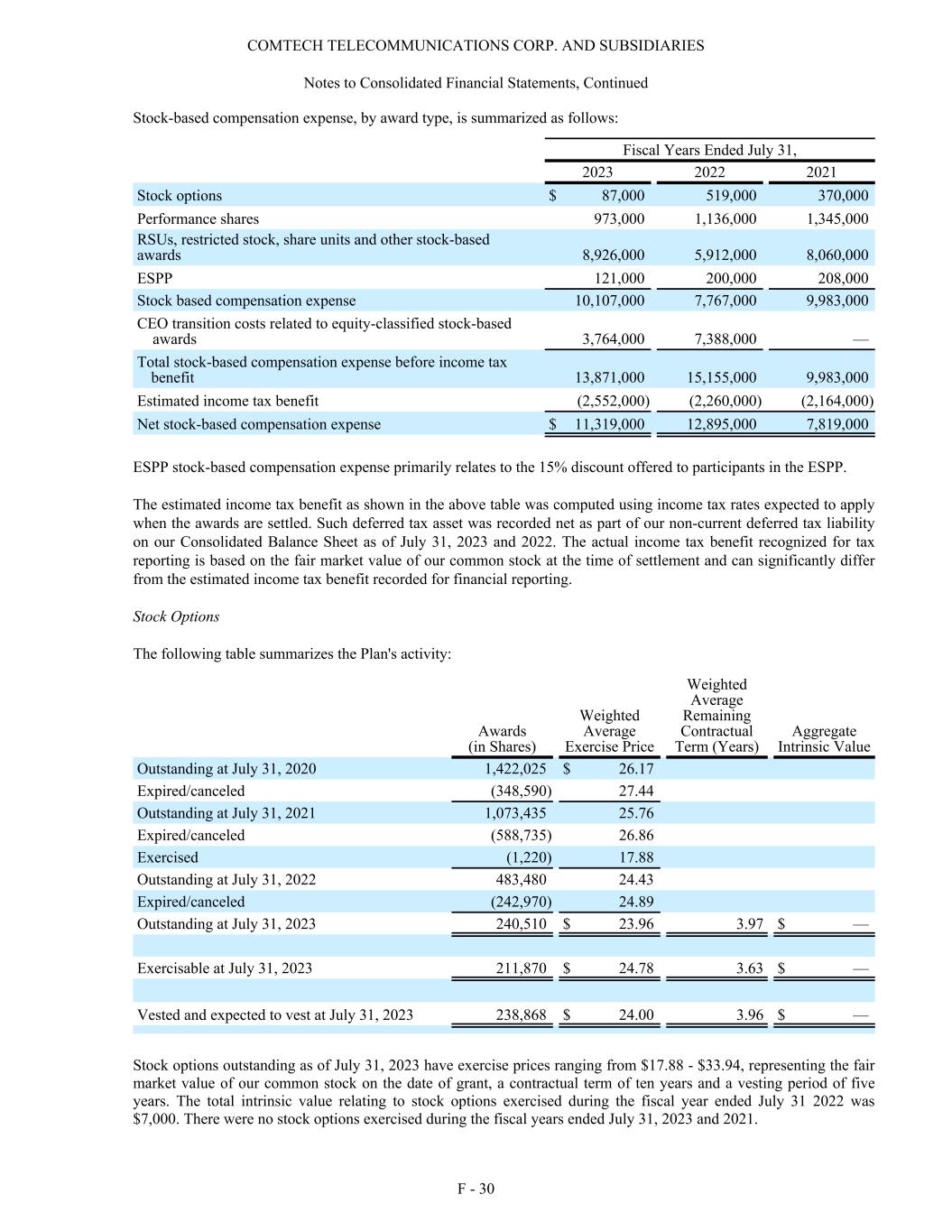
Stock-based compensation expense, by award type, is summarized as follows: Fiscal Years Ended July 31, 2023 2022 2021 Stock options $ 87,000 519,000 370,000 Performance shares 973,000 1,136,000 1,345,000 RSUs, restricted stock, share units and other stock-based awards 8,926,000 5,912,000 8,060,000 ESPP 121,000 200,000 208,000 Stock based compensation expense 10,107,000 7,767,000 9,983,000 CEO transition costs related to equity-classified stock-based awards 3,764,000 7,388,000 — Total stock-based compensation expense before income tax benefit 13,871,000 15,155,000 9,983,000 Estimated income tax benefit (2,552,000) (2,260,000) (2,164,000) Net stock-based compensation expense $ 11,319,000 12,895,000 7,819,000 ESPP stock-based compensation expense primarily relates to the 15% discount offered to participants in the ESPP. The estimated income tax benefit as shown in the above table was computed using income tax rates expected to apply when the awards are settled. Such deferred tax asset was recorded net as part of our non-current deferred tax liability on our Consolidated Balance Sheet as of July 31, 2023 and 2022. The actual income tax benefit recognized for tax reporting is based on the fair market value of our common stock at the time of settlement and can significantly differ from the estimated income tax benefit recorded for financial reporting. Stock Options The following table summarizes the Plan's activity: Awards (in Shares) Weighted Average Exercise Price Weighted Average Remaining Contractual Term (Years) Aggregate Intrinsic Value Outstanding at July 31, 2020 1,422,025 $ 26.17 Expired/canceled (348,590) 27.44 Outstanding at July 31, 2021 1,073,435 25.76 Expired/canceled (588,735) 26.86 Exercised (1,220) 17.88 Outstanding at July 31, 2022 483,480 24.43 Expired/canceled (242,970) 24.89 Outstanding at July 31, 2023 240,510 $ 23.96 3.97 $ — Exercisable at July 31, 2023 211,870 $ 24.78 3.63 $ — Vested and expected to vest at July 31, 2023 238,868 $ 24.00 3.96 $ — Stock options outstanding as of July 31, 2023 have exercise prices ranging from $17.88 - $33.94, representing the fair market value of our common stock on the date of grant, a contractual term of ten years and a vesting period of five years. The total intrinsic value relating to stock options exercised during the fiscal year ended July 31 2022 was $7,000. There were no stock options exercised during the fiscal years ended July 31, 2023 and 2021. COMTECH TELECOMMUNICATIONS CORP. AND SUBSIDIARIES Notes to Consolidated Financial Statements, Continued F - 30
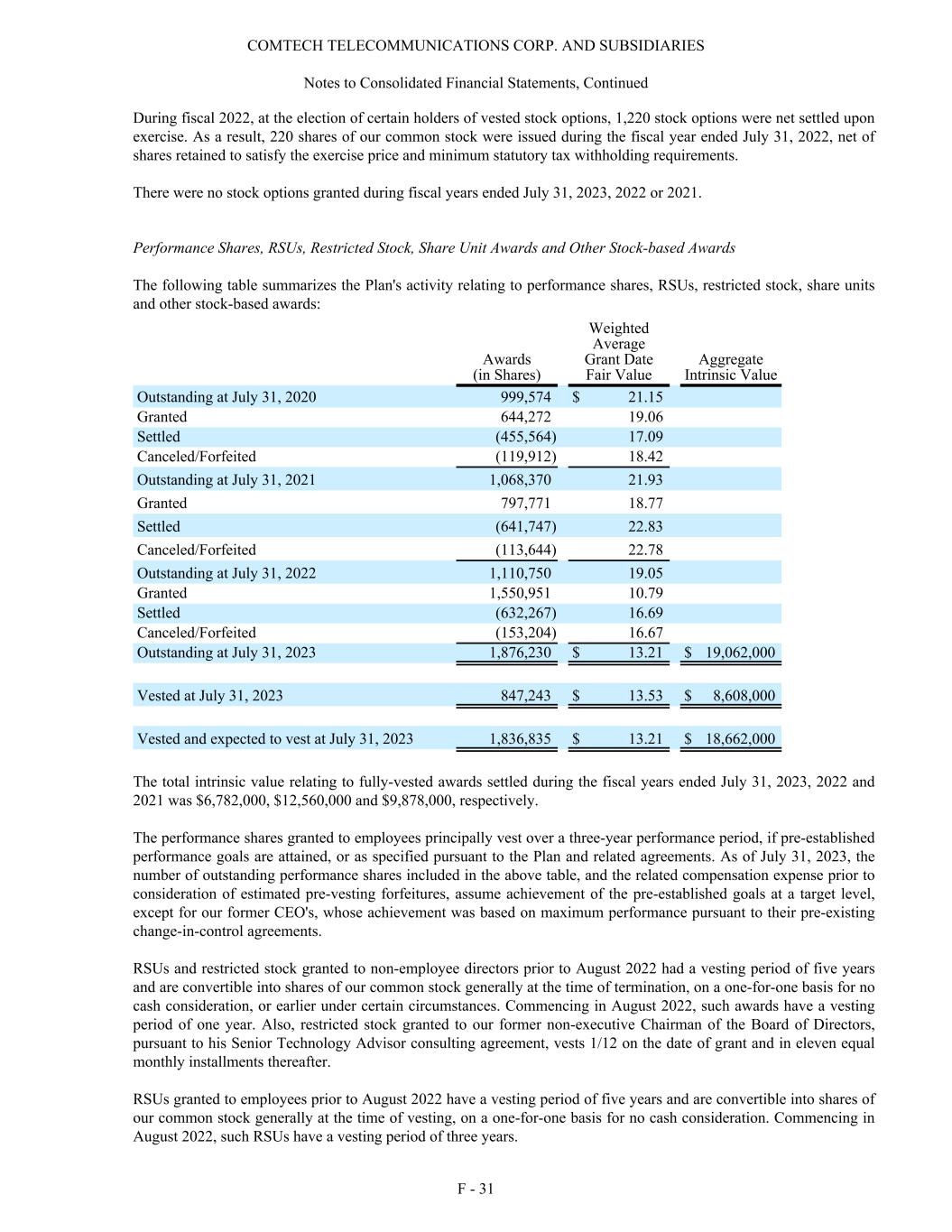
During fiscal 2022, at the election of certain holders of vested stock options, 1,220 stock options were net settled upon exercise. As a result, 220 shares of our common stock were issued during the fiscal year ended July 31, 2022, net of shares retained to satisfy the exercise price and minimum statutory tax withholding requirements. There were no stock options granted during fiscal years ended July 31, 2023, 2022 or 2021. Performance Shares, RSUs, Restricted Stock, Share Unit Awards and Other Stock-based Awards The following table summarizes the Plan's activity relating to performance shares, RSUs, restricted stock, share units and other stock-based awards: Awards (in Shares) Weighted Average Grant Date Fair Value Aggregate Intrinsic Value Outstanding at July 31, 2020 999,574 $ 21.15 Granted 644,272 19.06 Settled (455,564) 17.09 Canceled/Forfeited (119,912) 18.42 Outstanding at July 31, 2021 1,068,370 21.93 Granted 797,771 18.77 Settled (641,747) 22.83 Canceled/Forfeited (113,644) 22.78 Outstanding at July 31, 2022 1,110,750 19.05 Granted 1,550,951 10.79 Settled (632,267) 16.69 Canceled/Forfeited (153,204) 16.67 Outstanding at July 31, 2023 1,876,230 $ 13.21 $ 19,062,000 Vested at July 31, 2023 847,243 $ 13.53 $ 8,608,000 Vested and expected to vest at July 31, 2023 1,836,835 $ 13.21 $ 18,662,000 The total intrinsic value relating to fully-vested awards settled during the fiscal years ended July 31, 2023, 2022 and 2021 was $6,782,000, $12,560,000 and $9,878,000, respectively. The performance shares granted to employees principally vest over a three-year performance period, if pre-established performance goals are attained, or as specified pursuant to the Plan and related agreements. As of July 31, 2023, the number of outstanding performance shares included in the above table, and the related compensation expense prior to consideration of estimated pre-vesting forfeitures, assume achievement of the pre-established goals at a target level, except for our former CEO's, whose achievement was based on maximum performance pursuant to their pre-existing change-in-control agreements. RSUs and restricted stock granted to non-employee directors prior to August 2022 had a vesting period of five years and are convertible into shares of our common stock generally at the time of termination, on a one-for-one basis for no cash consideration, or earlier under certain circumstances. Commencing in August 2022, such awards have a vesting period of one year. Also, restricted stock granted to our former non-executive Chairman of the Board of Directors, pursuant to his Senior Technology Advisor consulting agreement, vests 1/12 on the date of grant and in eleven equal monthly installments thereafter. RSUs granted to employees prior to August 2022 have a vesting period of five years and are convertible into shares of our common stock generally at the time of vesting, on a one-for-one basis for no cash consideration. Commencing in August 2022, such RSUs have a vesting period of three years. COMTECH TELECOMMUNICATIONS CORP. AND SUBSIDIARIES Notes to Consolidated Financial Statements, Continued F - 31
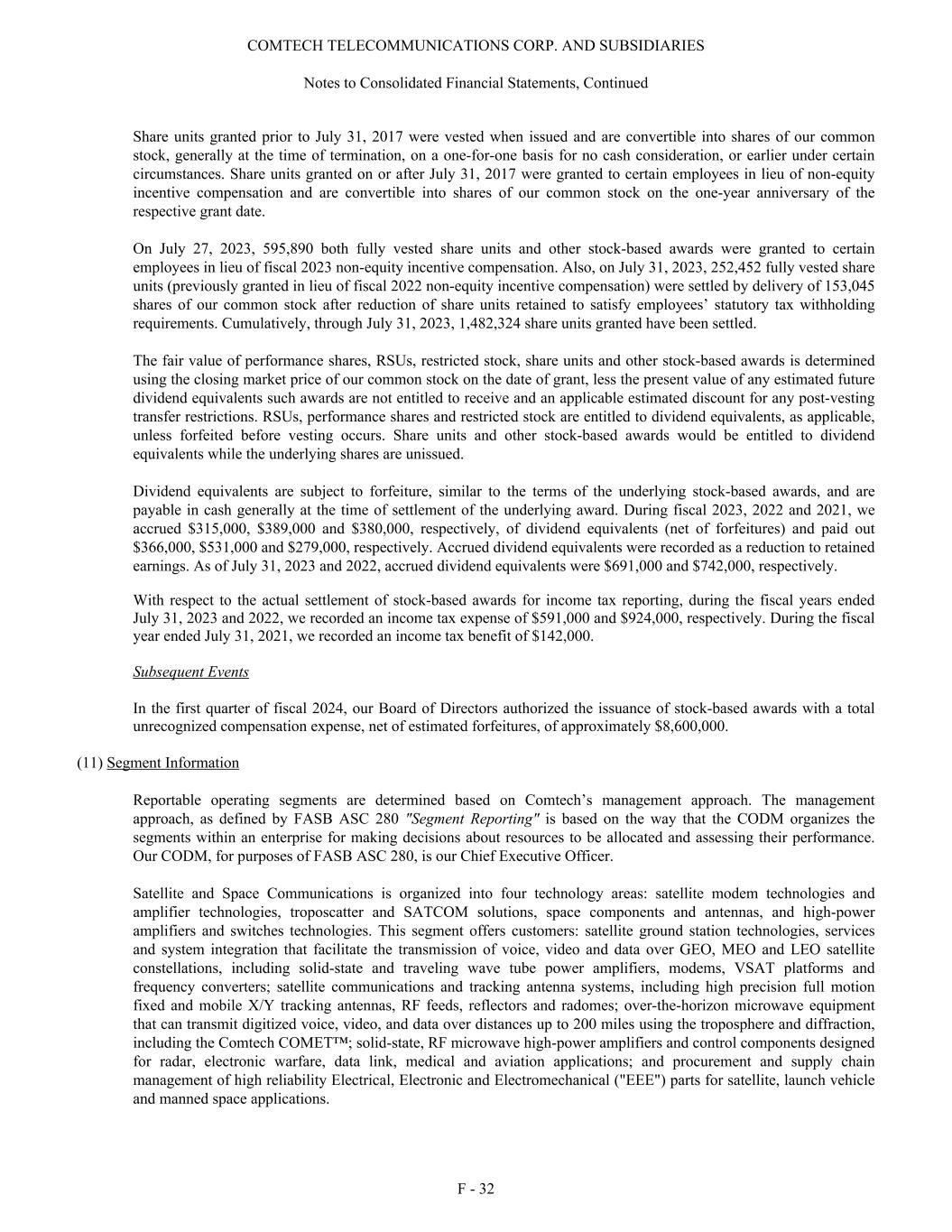
Share units granted prior to July 31, 2017 were vested when issued and are convertible into shares of our common stock, generally at the time of termination, on a one-for-one basis for no cash consideration, or earlier under certain circumstances. Share units granted on or after July 31, 2017 were granted to certain employees in lieu of non-equity incentive compensation and are convertible into shares of our common stock on the one-year anniversary of the respective grant date. On July 27, 2023, 595,890 both fully vested share units and other stock-based awards were granted to certain employees in lieu of fiscal 2023 non-equity incentive compensation. Also, on July 31, 2023, 252,452 fully vested share units (previously granted in lieu of fiscal 2022 non-equity incentive compensation) were settled by delivery of 153,045 shares of our common stock after reduction of share units retained to satisfy employees’ statutory tax withholding requirements. Cumulatively, through July 31, 2023, 1,482,324 share units granted have been settled. The fair value of performance shares, RSUs, restricted stock, share units and other stock-based awards is determined using the closing market price of our common stock on the date of grant, less the present value of any estimated future dividend equivalents such awards are not entitled to receive and an applicable estimated discount for any post-vesting transfer restrictions. RSUs, performance shares and restricted stock are entitled to dividend equivalents, as applicable, unless forfeited before vesting occurs. Share units and other stock-based awards would be entitled to dividend equivalents while the underlying shares are unissued. Dividend equivalents are subject to forfeiture, similar to the terms of the underlying stock-based awards, and are payable in cash generally at the time of settlement of the underlying award. During fiscal 2023, 2022 and 2021, we accrued $315,000, $389,000 and $380,000, respectively, of dividend equivalents (net of forfeitures) and paid out $366,000, $531,000 and $279,000, respectively. Accrued dividend equivalents were recorded as a reduction to retained earnings. As of July 31, 2023 and 2022, accrued dividend equivalents were $691,000 and $742,000, respectively. With respect to the actual settlement of stock-based awards for income tax reporting, during the fiscal years ended July 31, 2023 and 2022, we recorded an income tax expense of $591,000 and $924,000, respectively. During the fiscal year ended July 31, 2021, we recorded an income tax benefit of $142,000. Subsequent Events In the first quarter of fiscal 2024, our Board of Directors authorized the issuance of stock-based awards with a total unrecognized compensation expense, net of estimated forfeitures, of approximately $8,600,000. (11) Segment Information Reportable operating segments are determined based on Comtech’s management approach. The management approach, as defined by FASB ASC 280 "Segment Reporting" is based on the way that the CODM organizes the segments within an enterprise for making decisions about resources to be allocated and assessing their performance. Our CODM, for purposes of FASB ASC 280, is our Chief Executive Officer. Satellite and Space Communications is organized into four technology areas: satellite modem technologies and amplifier technologies, troposcatter and SATCOM solutions, space components and antennas, and high-power amplifiers and switches technologies. This segment offers customers: satellite ground station technologies, services and system integration that facilitate the transmission of voice, video and data over GEO, MEO and LEO satellite constellations, including solid-state and traveling wave tube power amplifiers, modems, VSAT platforms and frequency converters; satellite communications and tracking antenna systems, including high precision full motion fixed and mobile X/Y tracking antennas, RF feeds, reflectors and radomes; over-the-horizon microwave equipment that can transmit digitized voice, video, and data over distances up to 200 miles using the troposphere and diffraction, including the Comtech COMET™; solid-state, RF microwave high-power amplifiers and control components designed for radar, electronic warfare, data link, medical and aviation applications; and procurement and supply chain management of high reliability Electrical, Electronic and Electromechanical ("EEE") parts for satellite, launch vehicle and manned space applications. COMTECH TELECOMMUNICATIONS CORP. AND SUBSIDIARIES Notes to Consolidated Financial Statements, Continued F - 32
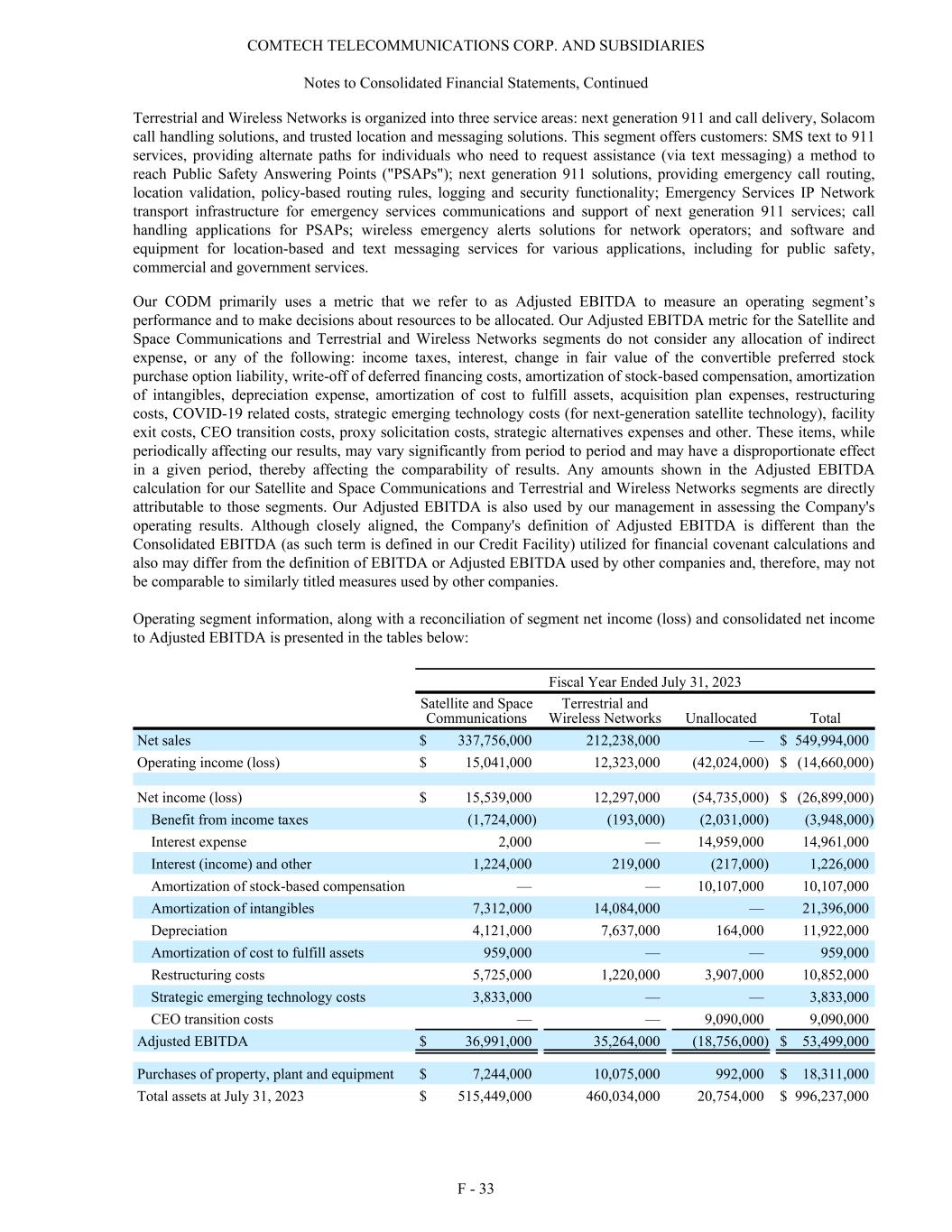
Terrestrial and Wireless Networks is organized into three service areas: next generation 911 and call delivery, Solacom call handling solutions, and trusted location and messaging solutions. This segment offers customers: SMS text to 911 services, providing alternate paths for individuals who need to request assistance (via text messaging) a method to reach Public Safety Answering Points ("PSAPs"); next generation 911 solutions, providing emergency call routing, location validation, policy-based routing rules, logging and security functionality; Emergency Services IP Network transport infrastructure for emergency services communications and support of next generation 911 services; call handling applications for PSAPs; wireless emergency alerts solutions for network operators; and software and equipment for location-based and text messaging services for various applications, including for public safety, commercial and government services. Our CODM primarily uses a metric that we refer to as Adjusted EBITDA to measure an operating segment’s performance and to make decisions about resources to be allocated. Our Adjusted EBITDA metric for the Satellite and Space Communications and Terrestrial and Wireless Networks segments do not consider any allocation of indirect expense, or any of the following: income taxes, interest, change in fair value of the convertible preferred stock purchase option liability, write-off of deferred financing costs, amortization of stock-based compensation, amortization of intangibles, depreciation expense, amortization of cost to fulfill assets, acquisition plan expenses, restructuring costs, COVID-19 related costs, strategic emerging technology costs (for next-generation satellite technology), facility exit costs, CEO transition costs, proxy solicitation costs, strategic alternatives expenses and other. These items, while periodically affecting our results, may vary significantly from period to period and may have a disproportionate effect in a given period, thereby affecting the comparability of results. Any amounts shown in the Adjusted EBITDA calculation for our Satellite and Space Communications and Terrestrial and Wireless Networks segments are directly attributable to those segments. Our Adjusted EBITDA is also used by our management in assessing the Company's operating results. Although closely aligned, the Company's definition of Adjusted EBITDA is different than the Consolidated EBITDA (as such term is defined in our Credit Facility) utilized for financial covenant calculations and also may differ from the definition of EBITDA or Adjusted EBITDA used by other companies and, therefore, may not be comparable to similarly titled measures used by other companies. Operating segment information, along with a reconciliation of segment net income (loss) and consolidated net income to Adjusted EBITDA is presented in the tables below: Fiscal Year Ended July 31, 2023 Satellite and Space Communications Terrestrial and Wireless Networks Unallocated Total Net sales $ 337,756,000 212,238,000 — $ 549,994,000 Operating income (loss) $ 15,041,000 12,323,000 (42,024,000) $ (14,660,000) Net income (loss) $ 15,539,000 12,297,000 (54,735,000) $ (26,899,000) Benefit from income taxes (1,724,000) (193,000) (2,031,000) (3,948,000) Interest expense 2,000 — 14,959,000 14,961,000 Interest (income) and other 1,224,000 219,000 (217,000) 1,226,000 Amortization of stock-based compensation — — 10,107,000 10,107,000 Amortization of intangibles 7,312,000 14,084,000 — 21,396,000 Depreciation 4,121,000 7,637,000 164,000 11,922,000 Amortization of cost to fulfill assets 959,000 — — 959,000 Restructuring costs 5,725,000 1,220,000 3,907,000 10,852,000 Strategic emerging technology costs 3,833,000 — — 3,833,000 CEO transition costs — — 9,090,000 9,090,000 Adjusted EBITDA $ 36,991,000 35,264,000 (18,756,000) $ 53,499,000 Purchases of property, plant and equipment $ 7,244,000 10,075,000 992,000 $ 18,311,000 Total assets at July 31, 2023 $ 515,449,000 460,034,000 20,754,000 $ 996,237,000 COMTECH TELECOMMUNICATIONS CORP. AND SUBSIDIARIES Notes to Consolidated Financial Statements, Continued F - 33
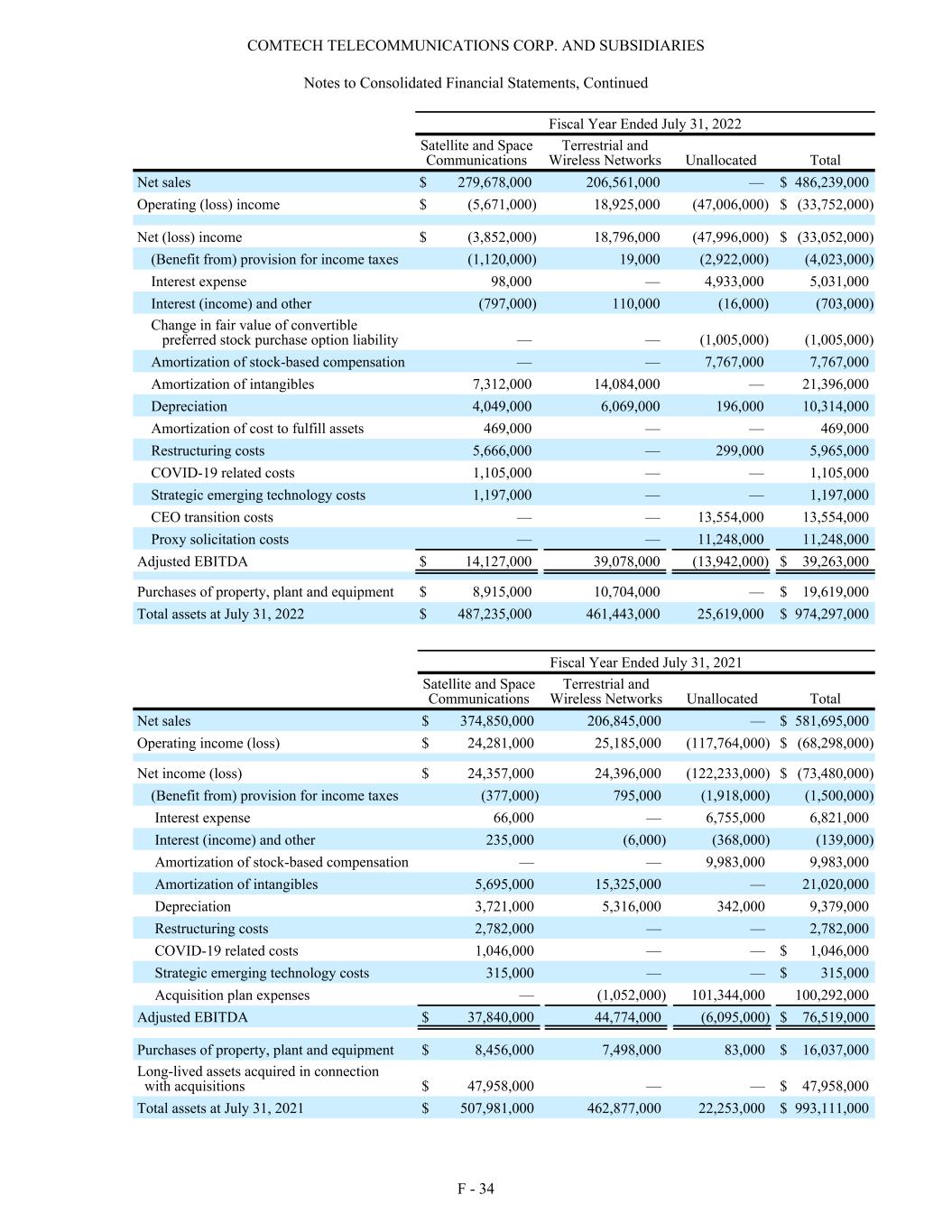
Fiscal Year Ended July 31, 2022 Satellite and Space Communications Terrestrial and Wireless Networks Unallocated Total Net sales $ 279,678,000 206,561,000 — $ 486,239,000 Operating (loss) income $ (5,671,000) 18,925,000 (47,006,000) $ (33,752,000) Net (loss) income $ (3,852,000) 18,796,000 (47,996,000) $ (33,052,000) (Benefit from) provision for income taxes (1,120,000) 19,000 (2,922,000) (4,023,000) Interest expense 98,000 — 4,933,000 5,031,000 Interest (income) and other (797,000) 110,000 (16,000) (703,000) Change in fair value of convertible preferred stock purchase option liability — — (1,005,000) (1,005,000) Amortization of stock-based compensation — — 7,767,000 7,767,000 Amortization of intangibles 7,312,000 14,084,000 — 21,396,000 Depreciation 4,049,000 6,069,000 196,000 10,314,000 Amortization of cost to fulfill assets 469,000 — — 469,000 Restructuring costs 5,666,000 — 299,000 5,965,000 COVID-19 related costs 1,105,000 — — 1,105,000 Strategic emerging technology costs 1,197,000 — — 1,197,000 CEO transition costs — — 13,554,000 13,554,000 Proxy solicitation costs — — 11,248,000 11,248,000 Adjusted EBITDA $ 14,127,000 39,078,000 (13,942,000) $ 39,263,000 Purchases of property, plant and equipment $ 8,915,000 10,704,000 — $ 19,619,000 Total assets at July 31, 2022 $ 487,235,000 461,443,000 25,619,000 $ 974,297,000 Fiscal Year Ended July 31, 2021 Satellite and Space Communications Terrestrial and Wireless Networks Unallocated Total Net sales $ 374,850,000 206,845,000 — $ 581,695,000 Operating income (loss) $ 24,281,000 25,185,000 (117,764,000) $ (68,298,000) Net income (loss) $ 24,357,000 24,396,000 (122,233,000) $ (73,480,000) (Benefit from) provision for income taxes (377,000) 795,000 (1,918,000) (1,500,000) Interest expense 66,000 — 6,755,000 6,821,000 Interest (income) and other 235,000 (6,000) (368,000) (139,000) Amortization of stock-based compensation — — 9,983,000 9,983,000 Amortization of intangibles 5,695,000 15,325,000 — 21,020,000 Depreciation 3,721,000 5,316,000 342,000 9,379,000 Restructuring costs 2,782,000 — — 2,782,000 COVID-19 related costs 1,046,000 — — $ 1,046,000 Strategic emerging technology costs 315,000 — — $ 315,000 Acquisition plan expenses — (1,052,000) 101,344,000 100,292,000 Adjusted EBITDA $ 37,840,000 44,774,000 (6,095,000) $ 76,519,000 Purchases of property, plant and equipment $ 8,456,000 7,498,000 83,000 $ 16,037,000 Long-lived assets acquired in connection with acquisitions $ 47,958,000 — — $ 47,958,000 Total assets at July 31, 2021 $ 507,981,000 462,877,000 22,253,000 $ 993,111,000 COMTECH TELECOMMUNICATIONS CORP. AND SUBSIDIARIES Notes to Consolidated Financial Statements, Continued F - 34
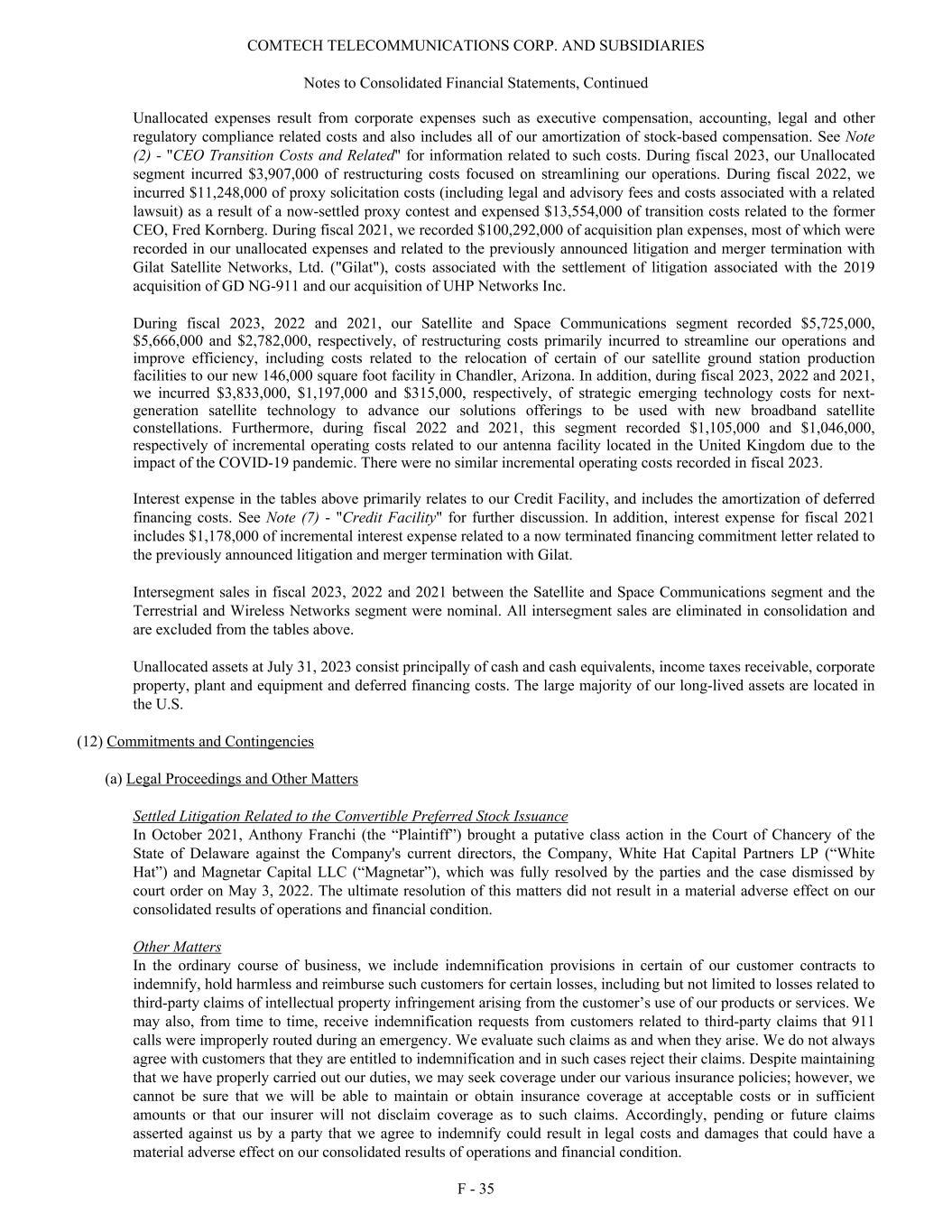
Unallocated expenses result from corporate expenses such as executive compensation, accounting, legal and other regulatory compliance related costs and also includes all of our amortization of stock-based compensation. See Note (2) - "CEO Transition Costs and Related" for information related to such costs. During fiscal 2023, our Unallocated segment incurred $3,907,000 of restructuring costs focused on streamlining our operations. During fiscal 2022, we incurred $11,248,000 of proxy solicitation costs (including legal and advisory fees and costs associated with a related lawsuit) as a result of a now-settled proxy contest and expensed $13,554,000 of transition costs related to the former CEO, Fred Kornberg. During fiscal 2021, we recorded $100,292,000 of acquisition plan expenses, most of which were recorded in our unallocated expenses and related to the previously announced litigation and merger termination with Gilat Satellite Networks, Ltd. ("Gilat"), costs associated with the settlement of litigation associated with the 2019 acquisition of GD NG-911 and our acquisition of UHP Networks Inc. During fiscal 2023, 2022 and 2021, our Satellite and Space Communications segment recorded $5,725,000, $5,666,000 and $2,782,000, respectively, of restructuring costs primarily incurred to streamline our operations and improve efficiency, including costs related to the relocation of certain of our satellite ground station production facilities to our new 146,000 square foot facility in Chandler, Arizona. In addition, during fiscal 2023, 2022 and 2021, we incurred $3,833,000, $1,197,000 and $315,000, respectively, of strategic emerging technology costs for next- generation satellite technology to advance our solutions offerings to be used with new broadband satellite constellations. Furthermore, during fiscal 2022 and 2021, this segment recorded $1,105,000 and $1,046,000, respectively of incremental operating costs related to our antenna facility located in the United Kingdom due to the impact of the COVID-19 pandemic. There were no similar incremental operating costs recorded in fiscal 2023. Interest expense in the tables above primarily relates to our Credit Facility, and includes the amortization of deferred financing costs. See Note (7) - "Credit Facility" for further discussion. In addition, interest expense for fiscal 2021 includes $1,178,000 of incremental interest expense related to a now terminated financing commitment letter related to the previously announced litigation and merger termination with Gilat. Intersegment sales in fiscal 2023, 2022 and 2021 between the Satellite and Space Communications segment and the Terrestrial and Wireless Networks segment were nominal. All intersegment sales are eliminated in consolidation and are excluded from the tables above. Unallocated assets at July 31, 2023 consist principally of cash and cash equivalents, income taxes receivable, corporate property, plant and equipment and deferred financing costs. The large majority of our long-lived assets are located in the U.S. (12) Commitments and Contingencies (a) Legal Proceedings and Other Matters Settled Litigation Related to the Convertible Preferred Stock Issuance In October 2021, Anthony Franchi (the “Plaintiff”) brought a putative class action in the Court of Chancery of the State of Delaware against the Company's current directors, the Company, White Hat Capital Partners LP (“White Hat”) and Magnetar Capital LLC (“Magnetar”), which was fully resolved by the parties and the case dismissed by court order on May 3, 2022. The ultimate resolution of this matters did not result in a material adverse effect on our consolidated results of operations and financial condition. Other Matters In the ordinary course of business, we include indemnification provisions in certain of our customer contracts to indemnify, hold harmless and reimburse such customers for certain losses, including but not limited to losses related to third-party claims of intellectual property infringement arising from the customer’s use of our products or services. We may also, from time to time, receive indemnification requests from customers related to third-party claims that 911 calls were improperly routed during an emergency. We evaluate such claims as and when they arise. We do not always agree with customers that they are entitled to indemnification and in such cases reject their claims. Despite maintaining that we have properly carried out our duties, we may seek coverage under our various insurance policies; however, we cannot be sure that we will be able to maintain or obtain insurance coverage at acceptable costs or in sufficient amounts or that our insurer will not disclaim coverage as to such claims. Accordingly, pending or future claims asserted against us by a party that we agree to indemnify could result in legal costs and damages that could have a material adverse effect on our consolidated results of operations and financial condition. COMTECH TELECOMMUNICATIONS CORP. AND SUBSIDIARIES Notes to Consolidated Financial Statements, Continued F - 35
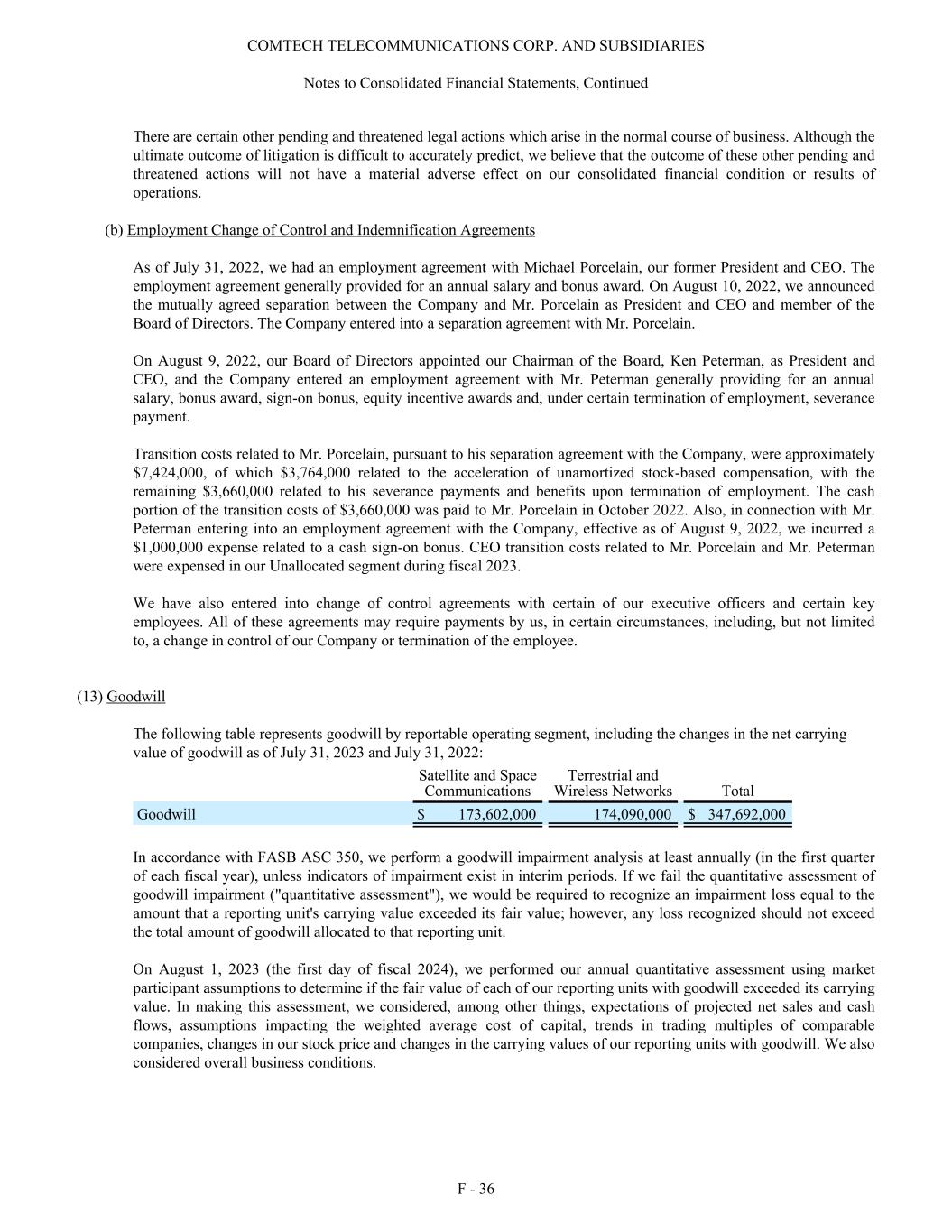
There are certain other pending and threatened legal actions which arise in the normal course of business. Although the ultimate outcome of litigation is difficult to accurately predict, we believe that the outcome of these other pending and threatened actions will not have a material adverse effect on our consolidated financial condition or results of operations. (b) Employment Change of Control and Indemnification Agreements As of July 31, 2022, we had an employment agreement with Michael Porcelain, our former President and CEO. The employment agreement generally provided for an annual salary and bonus award. On August 10, 2022, we announced the mutually agreed separation between the Company and Mr. Porcelain as President and CEO and member of the Board of Directors. The Company entered into a separation agreement with Mr. Porcelain. On August 9, 2022, our Board of Directors appointed our Chairman of the Board, Ken Peterman, as President and CEO, and the Company entered an employment agreement with Mr. Peterman generally providing for an annual salary, bonus award, sign-on bonus, equity incentive awards and, under certain termination of employment, severance payment. Transition costs related to Mr. Porcelain, pursuant to his separation agreement with the Company, were approximately $7,424,000, of which $3,764,000 related to the acceleration of unamortized stock-based compensation, with the remaining $3,660,000 related to his severance payments and benefits upon termination of employment. The cash portion of the transition costs of $3,660,000 was paid to Mr. Porcelain in October 2022. Also, in connection with Mr. Peterman entering into an employment agreement with the Company, effective as of August 9, 2022, we incurred a $1,000,000 expense related to a cash sign-on bonus. CEO transition costs related to Mr. Porcelain and Mr. Peterman were expensed in our Unallocated segment during fiscal 2023. We have also entered into change of control agreements with certain of our executive officers and certain key employees. All of these agreements may require payments by us, in certain circumstances, including, but not limited to, a change in control of our Company or termination of the employee. (13) Goodwill The following table represents goodwill by reportable operating segment, including the changes in the net carrying value of goodwill as of July 31, 2023 and July 31, 2022: Satellite and Space Communications Terrestrial and Wireless Networks Total Goodwill $ 173,602,000 174,090,000 $ 347,692,000 In accordance with FASB ASC 350, we perform a goodwill impairment analysis at least annually (in the first quarter of each fiscal year), unless indicators of impairment exist in interim periods. If we fail the quantitative assessment of goodwill impairment ("quantitative assessment"), we would be required to recognize an impairment loss equal to the amount that a reporting unit's carrying value exceeded its fair value; however, any loss recognized should not exceed the total amount of goodwill allocated to that reporting unit. On August 1, 2023 (the first day of fiscal 2024), we performed our annual quantitative assessment using market participant assumptions to determine if the fair value of each of our reporting units with goodwill exceeded its carrying value. In making this assessment, we considered, among other things, expectations of projected net sales and cash flows, assumptions impacting the weighted average cost of capital, trends in trading multiples of comparable companies, changes in our stock price and changes in the carrying values of our reporting units with goodwill. We also considered overall business conditions. COMTECH TELECOMMUNICATIONS CORP. AND SUBSIDIARIES Notes to Consolidated Financial Statements, Continued F - 36
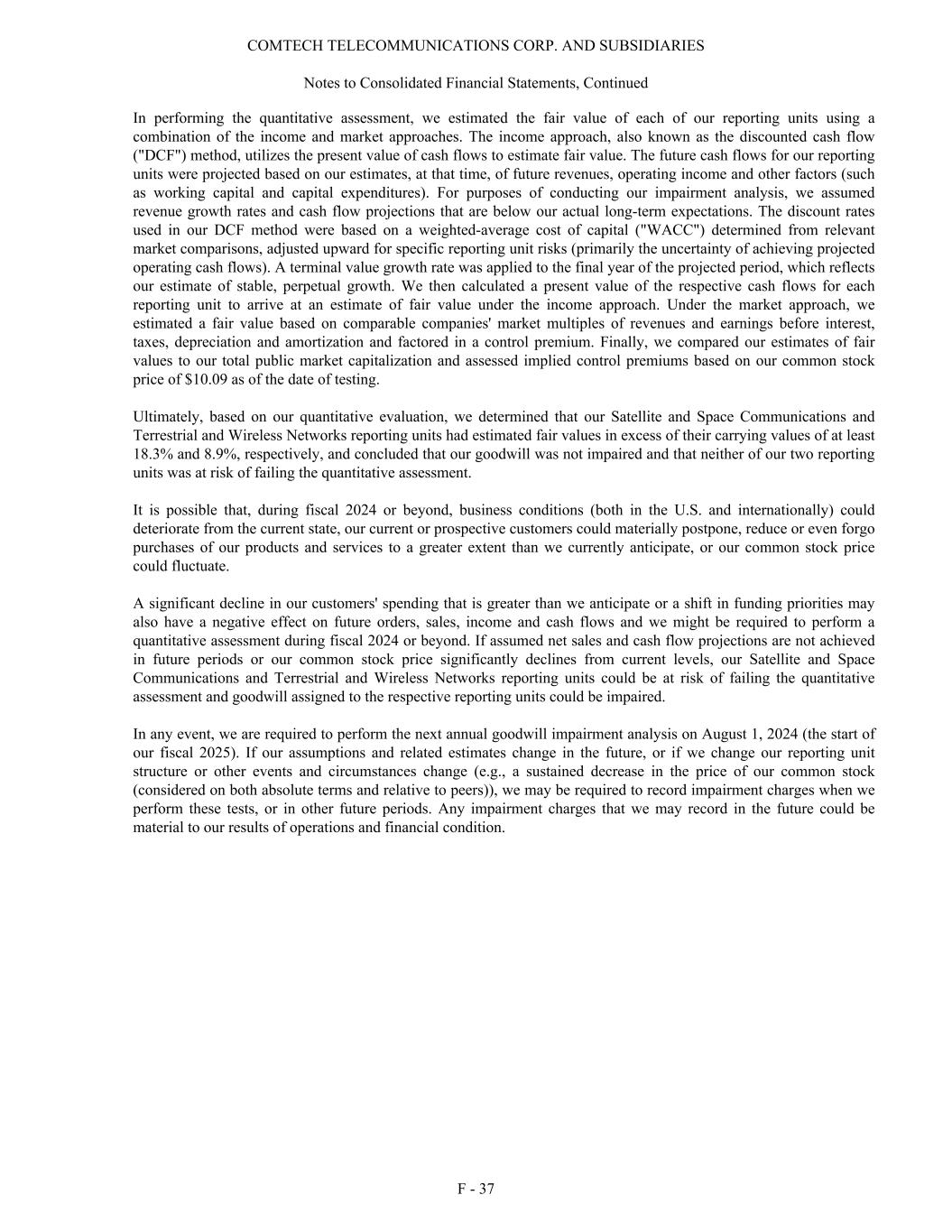
In performing the quantitative assessment, we estimated the fair value of each of our reporting units using a combination of the income and market approaches. The income approach, also known as the discounted cash flow ("DCF") method, utilizes the present value of cash flows to estimate fair value. The future cash flows for our reporting units were projected based on our estimates, at that time, of future revenues, operating income and other factors (such as working capital and capital expenditures). For purposes of conducting our impairment analysis, we assumed revenue growth rates and cash flow projections that are below our actual long-term expectations. The discount rates used in our DCF method were based on a weighted-average cost of capital ("WACC") determined from relevant market comparisons, adjusted upward for specific reporting unit risks (primarily the uncertainty of achieving projected operating cash flows). A terminal value growth rate was applied to the final year of the projected period, which reflects our estimate of stable, perpetual growth. We then calculated a present value of the respective cash flows for each reporting unit to arrive at an estimate of fair value under the income approach. Under the market approach, we estimated a fair value based on comparable companies' market multiples of revenues and earnings before interest, taxes, depreciation and amortization and factored in a control premium. Finally, we compared our estimates of fair values to our total public market capitalization and assessed implied control premiums based on our common stock price of $10.09 as of the date of testing. Ultimately, based on our quantitative evaluation, we determined that our Satellite and Space Communications and Terrestrial and Wireless Networks reporting units had estimated fair values in excess of their carrying values of at least 18.3% and 8.9%, respectively, and concluded that our goodwill was not impaired and that neither of our two reporting units was at risk of failing the quantitative assessment. It is possible that, during fiscal 2024 or beyond, business conditions (both in the U.S. and internationally) could deteriorate from the current state, our current or prospective customers could materially postpone, reduce or even forgo purchases of our products and services to a greater extent than we currently anticipate, or our common stock price could fluctuate. A significant decline in our customers' spending that is greater than we anticipate or a shift in funding priorities may also have a negative effect on future orders, sales, income and cash flows and we might be required to perform a quantitative assessment during fiscal 2024 or beyond. If assumed net sales and cash flow projections are not achieved in future periods or our common stock price significantly declines from current levels, our Satellite and Space Communications and Terrestrial and Wireless Networks reporting units could be at risk of failing the quantitative assessment and goodwill assigned to the respective reporting units could be impaired. In any event, we are required to perform the next annual goodwill impairment analysis on August 1, 2024 (the start of our fiscal 2025). If our assumptions and related estimates change in the future, or if we change our reporting unit structure or other events and circumstances change (e.g., a sustained decrease in the price of our common stock (considered on both absolute terms and relative to peers)), we may be required to record impairment charges when we perform these tests, or in other future periods. Any impairment charges that we may record in the future could be material to our results of operations and financial condition. COMTECH TELECOMMUNICATIONS CORP. AND SUBSIDIARIES Notes to Consolidated Financial Statements, Continued F - 37

(14) Intangible Assets Intangible assets with finite lives as of July 31, 2023 and 2022 are as follows: July 31, 2023 Weighted Average Amortization Period Gross Carrying Amount Accumulated Amortization Net Carrying Amount Customer relationships 20.2 $ 302,058,000 121,786,000 $ 180,272,000 Technologies 14.8 114,949,000 80,672,000 34,277,000 Trademarks and other 16.7 32,926,000 21,568,000 11,358,000 Total $ 449,933,000 224,026,000 $ 225,907,000 July 31, 2022 Weighted Average Amortization Period Gross Carrying Amount Accumulated Amortization Net Carrying Amount Customer relationships 20.2 $ 302,058,000 107,500,000 $ 194,558,000 Technologies 14.8 114,949,000 75,798,000 39,151,000 Trademarks and other 16.7 32,926,000 19,332,000 13,594,000 Total $ 449,933,000 202,630,000 $ 247,303,000 The weighted average amortization period in the above table excludes fully amortized intangible assets. Amortization expense for the fiscal years ended July 31, 2023, 2022 and 2021 was $21,396,000, $21,396,000 and $21,020,000, respectively. The estimated amortization expense consists of the following for the fiscal years ending July 31: 2024 $ 21,154,000 2025 21,039,000 2026 19,888,000 2027 18,534,000 2028 18,534,000 We review net intangible assets with finite lives for impairment when an event occurs indicating the potential for impairment. Based on our last assessment, we believe that the carrying values of our net intangible assets were recoverable as of July 31, 2023. However, if business conditions deteriorate, we may be required to record impairment losses, and or increase the amortization of intangibles in the future. Any impairment charges that we may record in the future could be material to our results of operations and financial condition. (15) Convertible Preferred Stock On October 18, 2021, we entered into a Subscription Agreement (the “Subscription Agreement”) with certain affiliates and related funds of White Hat Capital Partners LP and Magnetar Capital LLC (collectively, the “Investors”), relating to the issuance and sale of up to 125,000 shares of a new series of the Company's Series A Convertible Preferred Stock, par value $0.10 per share (the “Convertible Preferred Stock”), for an aggregate purchase price of up to $125,000,000, or $1,000 per share. On October 19, 2021 (the “Initial Closing Date”), pursuant to the terms of the Subscription Agreement, the Investors purchased an aggregate of 100,000 shares of Convertible Preferred Stock (the “Initial Issuance”) for an aggregate purchase price of $100,000,000. The Investors had a one-time option exercisable at any time on or prior to March 31, 2023 to purchase additional shares of Convertible Preferred Stock for an aggregate purchase price of $25,000,000. This purchase option, commonly referred to as a “Green Shoe” expired unexercised and together with the Initial Issuance, is collectively referred to as the “Issuance.” COMTECH TELECOMMUNICATIONS CORP. AND SUBSIDIARIES Notes to Consolidated Financial Statements, Continued F - 38

The adjusted conversion price for the shares issued in the Initial Issuance is $23.97, subject to certain adjustments set forth in the Certificate of Designations filed with the Secretary of State of the State of Delaware. The Convertible Preferred Stock ranks senior to the shares of our common stock, with respect to the payment of dividends and the distribution of assets upon a liquidation, dissolution or winding up of the Company. The Convertible Preferred Stock initially had a liquidation preference of $1,000 per share with each share entitled to a cumulative dividend (the “Dividend”) at the rate of 6.5% per annum, compounding quarterly, paid-in-kind or paid in cash, at our election. For any quarter in which we elect not to pay the Dividend in cash with respect to a share of Convertible Preferred Stock, such Dividend becomes part of the liquidation preference of such share. In addition, no dividend or other distribution on our common stock in excess of our $0.10 per share per quarter will be declared or paid on the common stock unless, at the time of such declaration and payment, an equivalent dividend or distribution is declared and paid on the Convertible Preferred Stock (the “Participating Dividend”), provided that in the case of any such dividend in the form of cash, in lieu of a cash payment, such Participating Dividend will become part of the liquidation preference of the shares of the Convertible Preferred Stock. Such Participating Dividend results in the Convertible Preferred Stock meeting the definition of a "participating security" for purposes of our earnings per share calculations. As of October 12, 2023, the Convertible Preferred Stock is convertible into shares of common stock at the option of the holders. At any time after October 19, 2024, we have the right to mandate the conversion of the Convertible Preferred Stock, subject to certain restrictions, based on the price of the common stock in the preceding thirty trading days. Holders of the Convertible Preferred Stock are entitled to vote with the holders of the common stock on an as- converted basis, as well as are entitled to a separate class vote with respect to, among other things, amendments to our organizational documents that have an adverse effect on the Convertible Preferred Stock, authorizations or issuances of securities of the Company, the payment of dividends other than dividends on common stock in the ordinary course consistent with past practice on a quarterly basis in an amount not to exceed our current dividend rate of $0.10 per share per quarter, related party transactions, repurchases or redemptions of securities of the Company (other than the repurchase of up to $25,000,000 of shares of common stock), dispositions of businesses or assets, the incurrence of certain indebtedness and certain amendments or extensions of our existing Credit Facility. Holders will have the right to require the Company to repurchase such holder's Convertible Preferred Stock on a date occurring either (a) on or after October 19, 2026 (the “Optional Repurchase Trigger Date”) at a price equal to the liquidation preference or (b) in connection with a conversion of Convertible Preferred Stock, pursuant to which the number of shares of common stock issuable upon such conversion would exceed 19.99% of the issued and outstanding shares of common stock as of October 18, 2021 (such excess shares, "Excess Conversion Shares"), at any time after the date that is 91 days after the maturity date of the Company's existing Credit Facility, at a price per share equal to the number of Excess Conversion Shares multiplied by the Last Reported Sales Price (as defined) of common stock on the applicable conversion date. In addition, each holder will have the right to cause the Company to repurchase its shares of Convertible Preferred Stock in connection with a Change of Control, at a price equal to the liquidation preference. We determined that our obligation to issue the Green Shoe at any time on or prior to March 31, 2023 met the definition of a freestanding financial instrument that should be accounted for as a liability. As such, we established an initial convertible preferred stock purchase option liability of $1,005,000 and reduced the proceeds from the Initial Issuance by such amount. The liability was remeasured to its estimated fair value each reporting period until such instrument expired. Changes in its estimated fair value were recognized as a non-cash charge or benefit and presented on the consolidated statement of operations. COMTECH TELECOMMUNICATIONS CORP. AND SUBSIDIARIES Notes to Consolidated Financial Statements, Continued F - 39
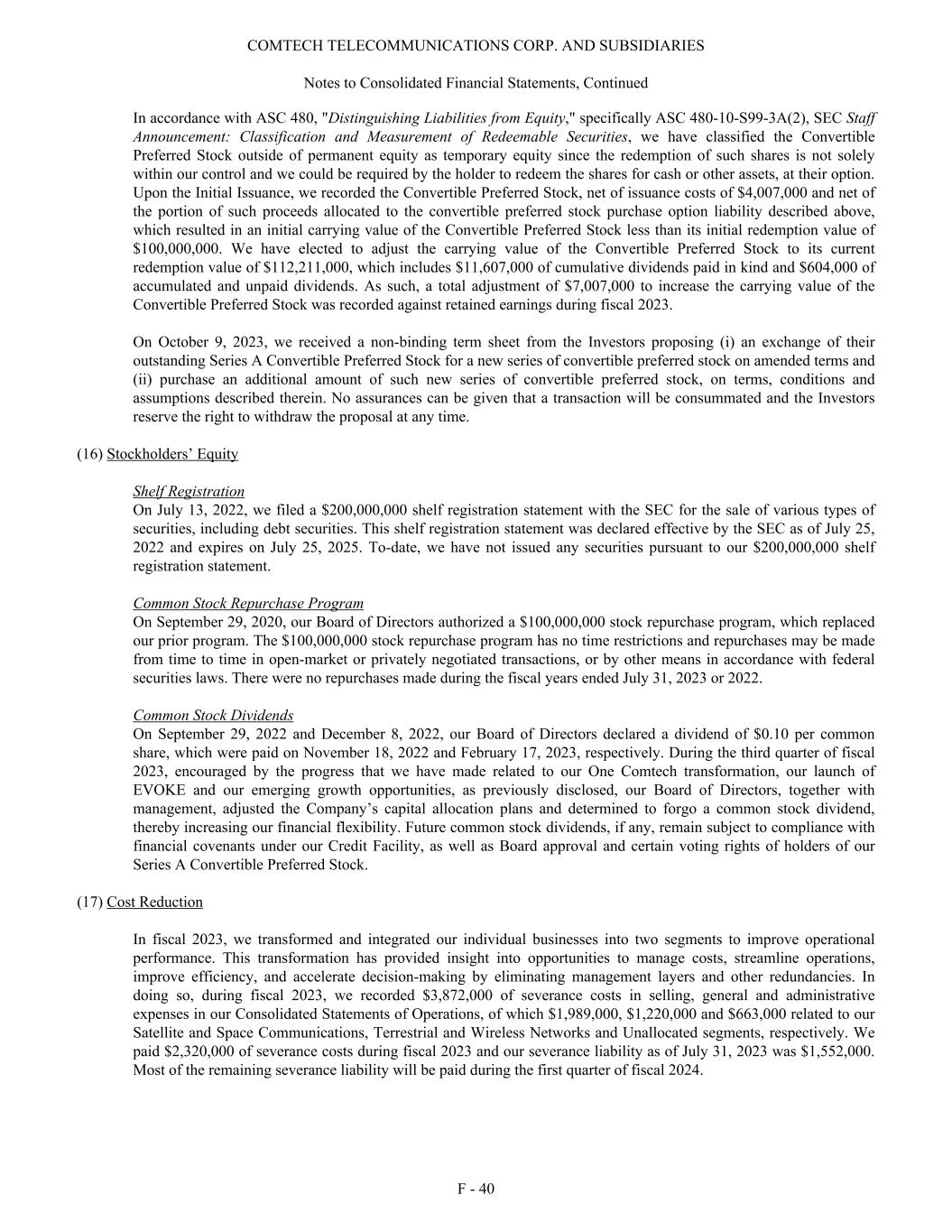
In accordance with ASC 480, "Distinguishing Liabilities from Equity," specifically ASC 480-10-S99-3A(2), SEC Staff Announcement: Classification and Measurement of Redeemable Securities, we have classified the Convertible Preferred Stock outside of permanent equity as temporary equity since the redemption of such shares is not solely within our control and we could be required by the holder to redeem the shares for cash or other assets, at their option. Upon the Initial Issuance, we recorded the Convertible Preferred Stock, net of issuance costs of $4,007,000 and net of the portion of such proceeds allocated to the convertible preferred stock purchase option liability described above, which resulted in an initial carrying value of the Convertible Preferred Stock less than its initial redemption value of $100,000,000. We have elected to adjust the carrying value of the Convertible Preferred Stock to its current redemption value of $112,211,000, which includes $11,607,000 of cumulative dividends paid in kind and $604,000 of accumulated and unpaid dividends. As such, a total adjustment of $7,007,000 to increase the carrying value of the Convertible Preferred Stock was recorded against retained earnings during fiscal 2023. On October 9, 2023, we received a non-binding term sheet from the Investors proposing (i) an exchange of their outstanding Series A Convertible Preferred Stock for a new series of convertible preferred stock on amended terms and (ii) purchase an additional amount of such new series of convertible preferred stock, on terms, conditions and assumptions described therein. No assurances can be given that a transaction will be consummated and the Investors reserve the right to withdraw the proposal at any time. (16) Stockholders’ Equity Shelf Registration On July 13, 2022, we filed a $200,000,000 shelf registration statement with the SEC for the sale of various types of securities, including debt securities. This shelf registration statement was declared effective by the SEC as of July 25, 2022 and expires on July 25, 2025. To-date, we have not issued any securities pursuant to our $200,000,000 shelf registration statement. Common Stock Repurchase Program On September 29, 2020, our Board of Directors authorized a $100,000,000 stock repurchase program, which replaced our prior program. The $100,000,000 stock repurchase program has no time restrictions and repurchases may be made from time to time in open-market or privately negotiated transactions, or by other means in accordance with federal securities laws. There were no repurchases made during the fiscal years ended July 31, 2023 or 2022. Common Stock Dividends On September 29, 2022 and December 8, 2022, our Board of Directors declared a dividend of $0.10 per common share, which were paid on November 18, 2022 and February 17, 2023, respectively. During the third quarter of fiscal 2023, encouraged by the progress that we have made related to our One Comtech transformation, our launch of EVOKE and our emerging growth opportunities, as previously disclosed, our Board of Directors, together with management, adjusted the Company’s capital allocation plans and determined to forgo a common stock dividend, thereby increasing our financial flexibility. Future common stock dividends, if any, remain subject to compliance with financial covenants under our Credit Facility, as well as Board approval and certain voting rights of holders of our Series A Convertible Preferred Stock. (17) Cost Reduction In fiscal 2023, we transformed and integrated our individual businesses into two segments to improve operational performance. This transformation has provided insight into opportunities to manage costs, streamline operations, improve efficiency, and accelerate decision-making by eliminating management layers and other redundancies. In doing so, during fiscal 2023, we recorded $3,872,000 of severance costs in selling, general and administrative expenses in our Consolidated Statements of Operations, of which $1,989,000, $1,220,000 and $663,000 related to our Satellite and Space Communications, Terrestrial and Wireless Networks and Unallocated segments, respectively. We paid $2,320,000 of severance costs during fiscal 2023 and our severance liability as of July 31, 2023 was $1,552,000. Most of the remaining severance liability will be paid during the first quarter of fiscal 2024. COMTECH TELECOMMUNICATIONS CORP. AND SUBSIDIARIES Notes to Consolidated Financial Statements, Continued F - 40

(18) Subsequent Events On October 11, 2023, we entered into a stock sale agreement relating to our solid-state RF microwave high power amplifiers and control components product line, which is included in our Satellite and Space Communications segment. The completion of this divestiture is subject to customary closing conditions. The preliminary sales price for this divestiture is $35,000,000 in cash, plus contingent consideration up to $5,000,000 based on the achievement of a revenue target or the receipt of an anticipated contract award as specified in the stock sale agreement. The sales price is also subject to adjustment based on the closing date net working capital of the divested business. COMTECH TELECOMMUNICATIONS CORP. AND SUBSIDIARIES Notes to Consolidated Financial Statements, Continued F - 41

Schedule II COMTECH TELECOMMUNICATIONS CORP. AND SUBSIDIARIES Valuation and Qualifying Accounts and Reserves Fiscal Years Ended July 31, 2023, 2022 and 2021 Column A Column B Column C Additions Column D Column E Description Balance at beginning of period Charged to cost and expenses Charged to other accounts - describe Transfers (deductions) - describe Balance at end of period Allowance for doubtful accounts receivable: Year ended July 31, 2023 $ 2,337,000 261,000 (A) — (509,000) (B) $ 2,089,000 2022 1,648,000 838,000 (A) — (149,000) (B) 2,337,000 2021 1,769,000 (18,000) (A) 215,000 (C) (318,000) (B) 1,648,000 Inventory reserves: Year ended July 31, 2023 $ 23,121,000 4,871,000 (D) — (3,333,000) (E) $ 24,659,000 2022 20,229,000 4,447,000 (D) — (1,555,000) (E) 23,121,000 2021 19,076,000 4,364,000 (D) — (3,211,000) (E) 20,229,000 Valuation allowance for deferred tax assets: Year ended July 31, 2023 $ 31,227,000 4,617,000 (F) — (1,366,000) (F) $ 34,478,000 2022 28,384,000 2,947,000 (F) — (104,000) (F) 31,227,000 2021 11,471,000 17,750,000 (F) — (837,000) (F) 28,384,000 (A) Provision for doubtful accounts. (B) Write-off of uncollectible receivables. (C) Increase due to our August 1, 2020 adoption of FASB ASU No. 2016-13, on a modified-retrospective basis, which requires companies to utilize an impairment model (current expected credit loss ("CECL”)) for most financial assets measured at amortized cost and certain other financial instruments, which include, but are not limited to trade receivables and contract assets. (D) Provision for excess and obsolete inventory. (E) Write-off of inventory. (F) Change in valuation allowance. See Note (9) - "Income Taxes" for further discussion. S - 1

Annual Report 2023 11 Board of Directors Ken Peterman Chairman of the Board President and Chief Executive Officer (Listed Below Alphabetically) Wendi B. Carpenter Principal and Founder of Gold Star Strategies LLC Judy Chambers Managing Principal and Member of the Board of Meketa Investment Group Bruce T. Crawford Lieutenant General (Retired) Ellen M. Lord Former Under Secretary of Defense for Acquisition and Sustainment Lisa Lesavoy (Retiring) Owner, Lesavoy Financial Perspectives, Inc. Mark R. Quinlan Co-founder and Managing Partner, White Hat Capital Partners Dr. Yacov A. Shamash Professor of Electrical and Computer Engineering at Stony Brook University Lawrence J. Waldman Non-Executive Chairman of the Board CVD Equipment Corporation Corporate Management Ken Peterman President and Chief Executive Officer Maria Hedden Chief Operating Officer Michael A. Bondi Chief Financial Officer Donald E. Walther Chief Legal Officer and Corporate Secretary Jennie Kerr Chief People Officer Nancy Stallone Treasurer and Assistant Corporate Secretary Daniel Gizinski Chief Strategy Officer Nicole Robinson Chief Growth Officer Anirban Chakraborty Chief Technology Officer Independent Registered Public Accountants Deloitte & Touche LLP Jericho, New York 11753 Market for Common Stock Common Stock is traded on the NASDAQ Stock Market LLC under the stock symbol CMTL Registrar and Transfer Agent Equiniti Trust Company, LLC 6201 15th Avenue Brooklyn, New York 11219 Common Stock Price Range High Low Fiscal Year Ended July 31, 2023 First Quarter $13.02 $ 8.99 Second Quarter 15.86 10.27 Third Quarter 16.69 10.18 Fourth Quarter 12.34 8.41 Investor Relations and Shareholder Information Visit us at www.comtech.com or call (631) 962- 7102. A copy of the Form 10-K Annual Report, exhibits and other reports as filed with the Securities and Exchange Commission are available to shareholders. Requests for information should be made by submitting an email to investors@comtech.com or by writing to us at Comtech Telecommunications Corp. Attention: Chief Financial Officer, 68 South Service Road, Suite 230 Melville, NY 11747. Corporate Information

Annual Report 2023 12 68 South Service Road, Suite 230 Melville, New York 11747 (631) 962-7000 | comtech.com